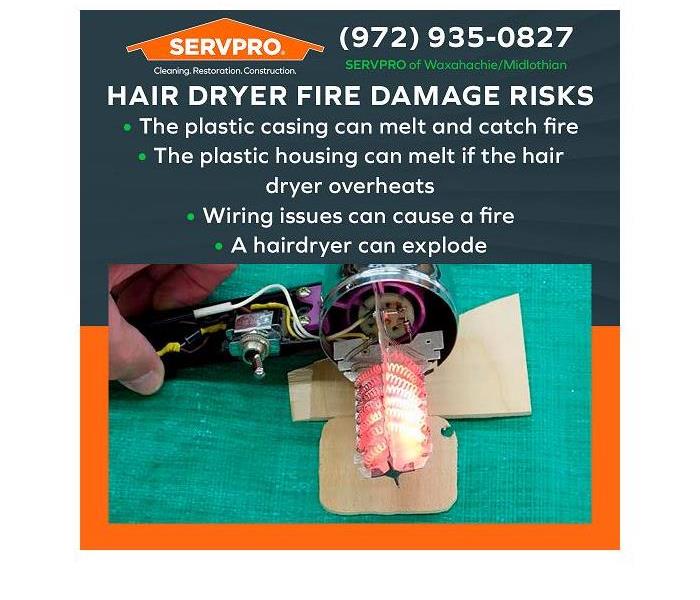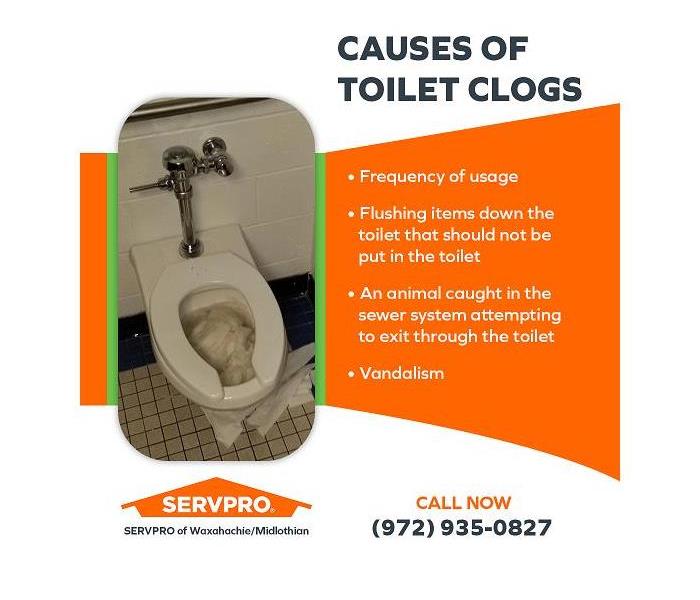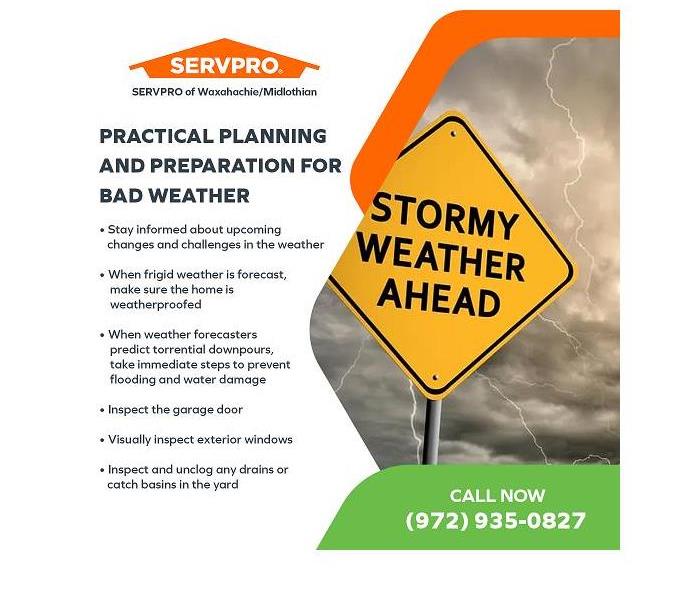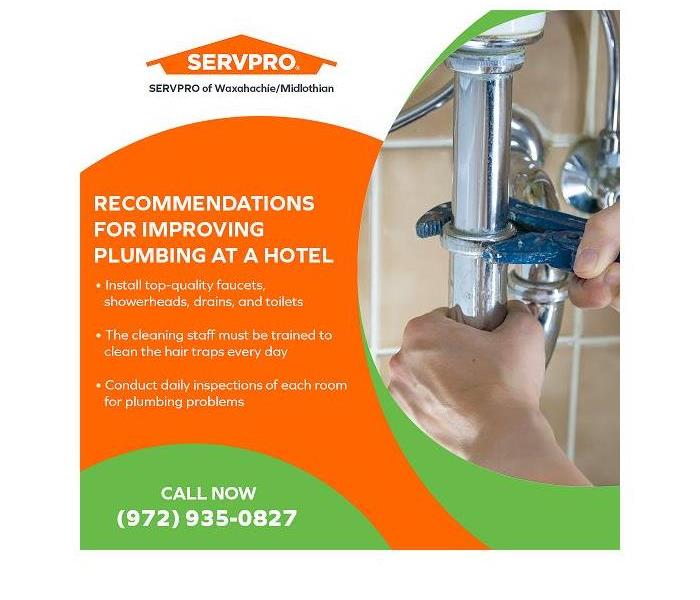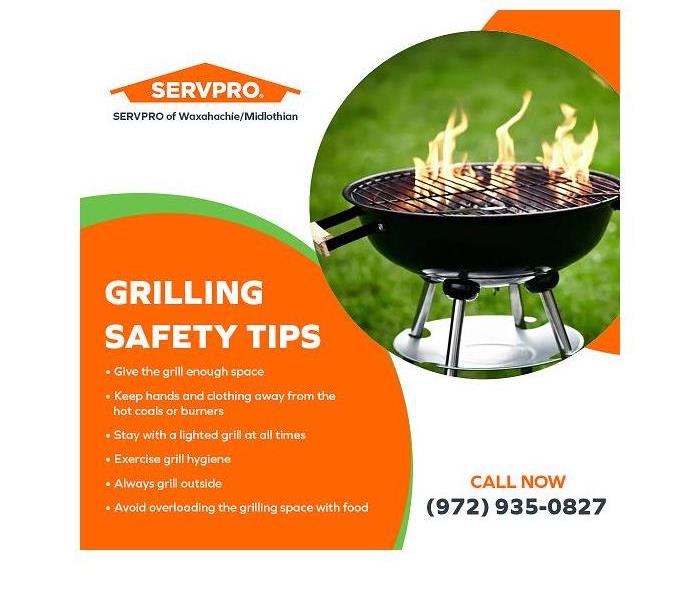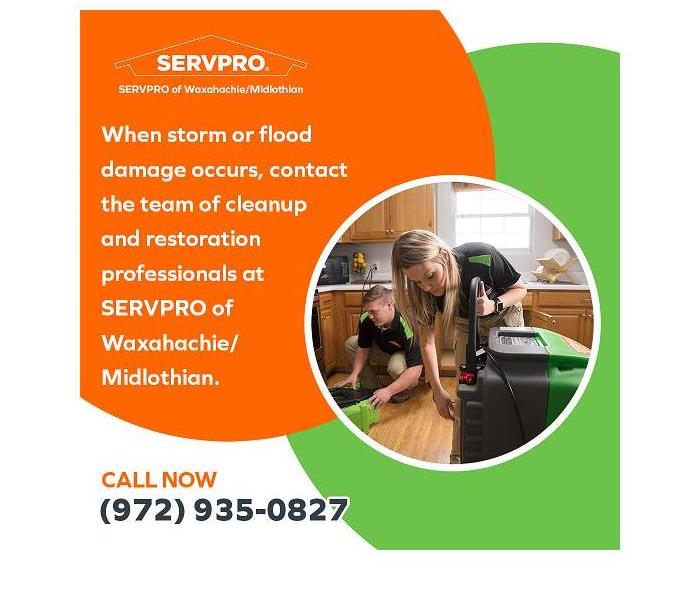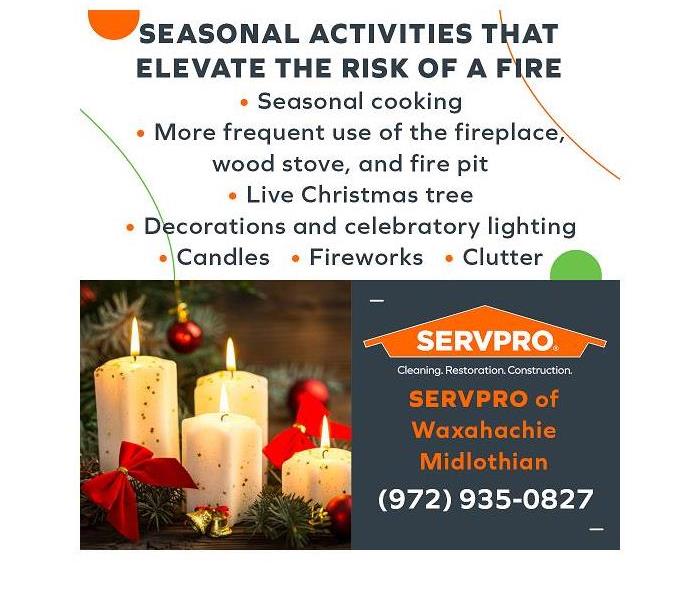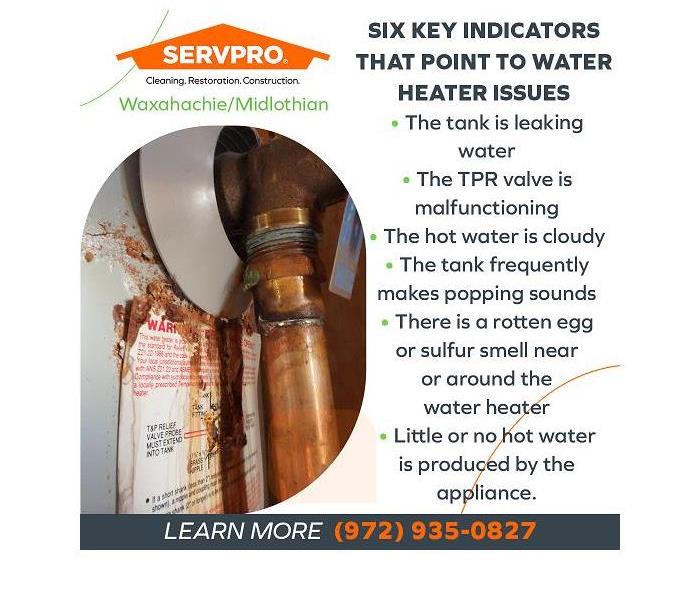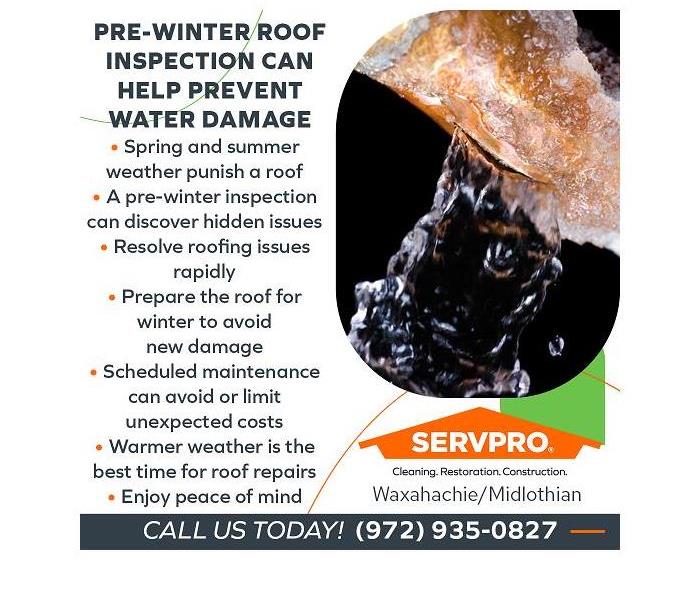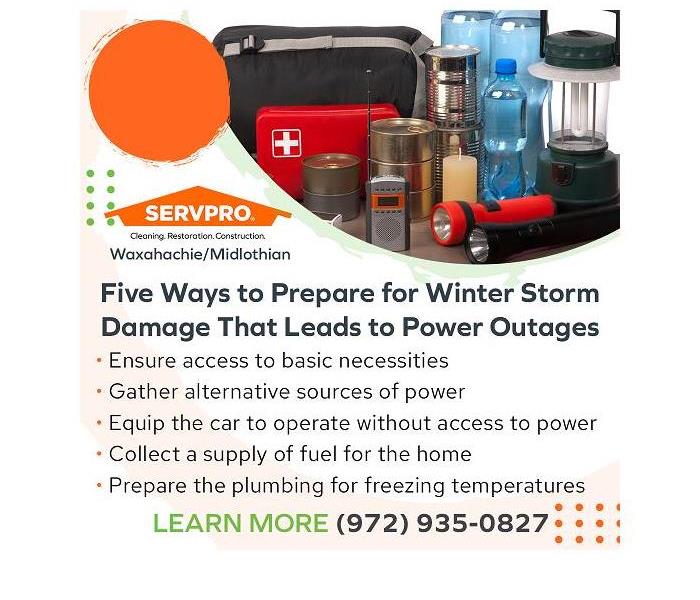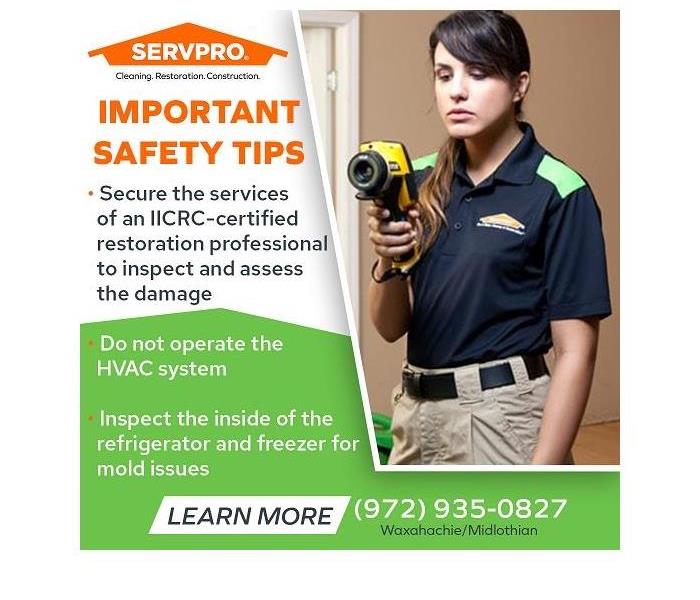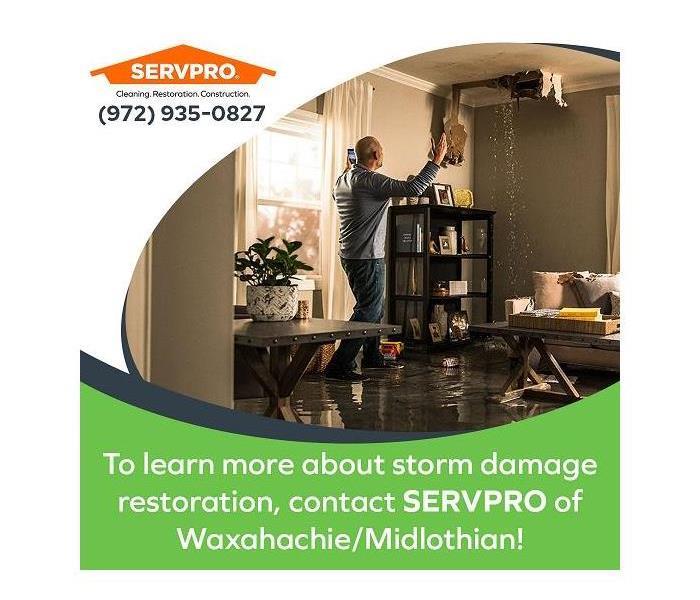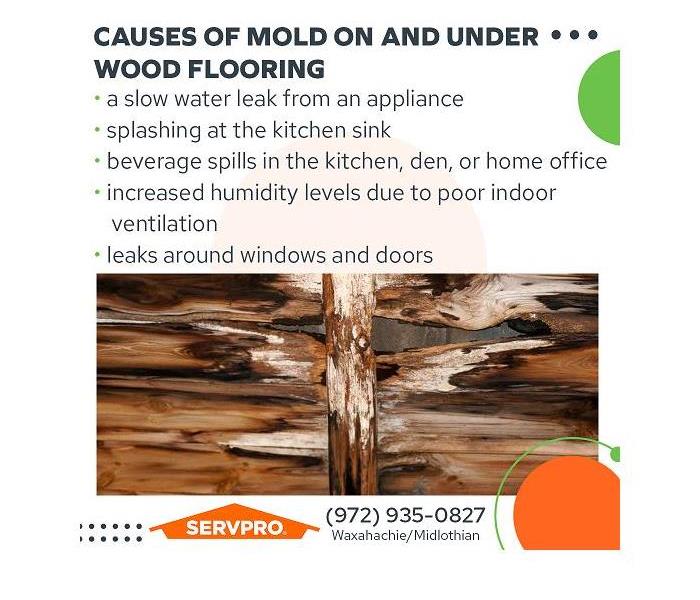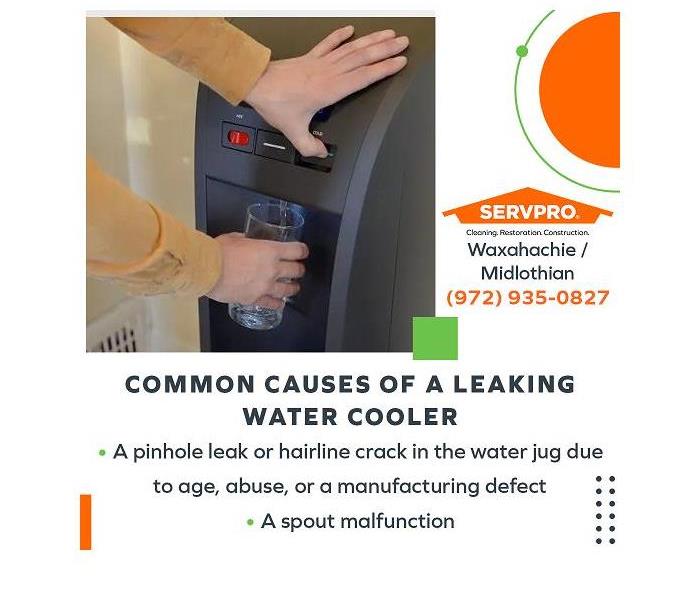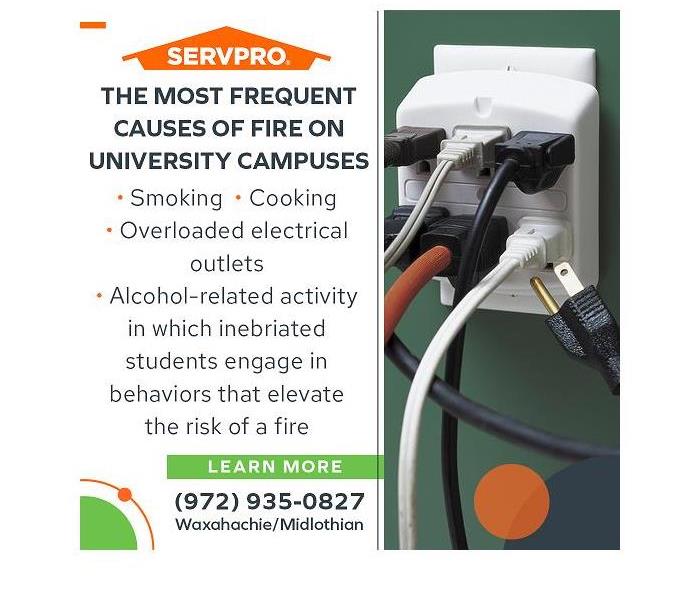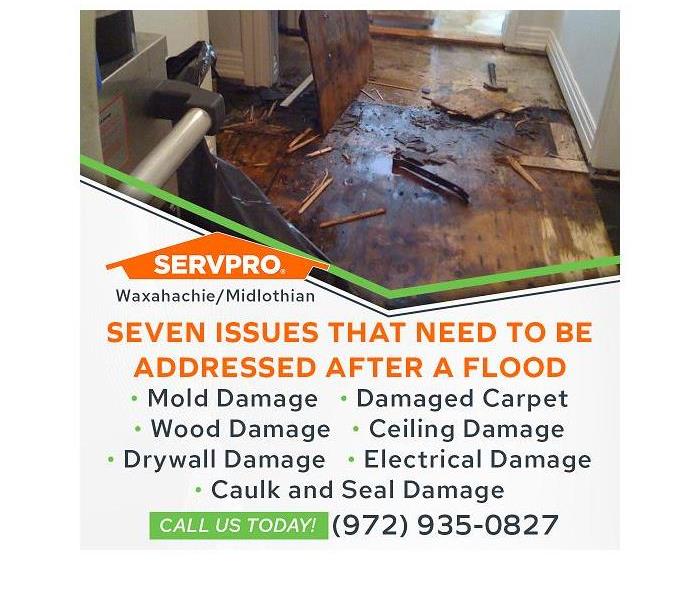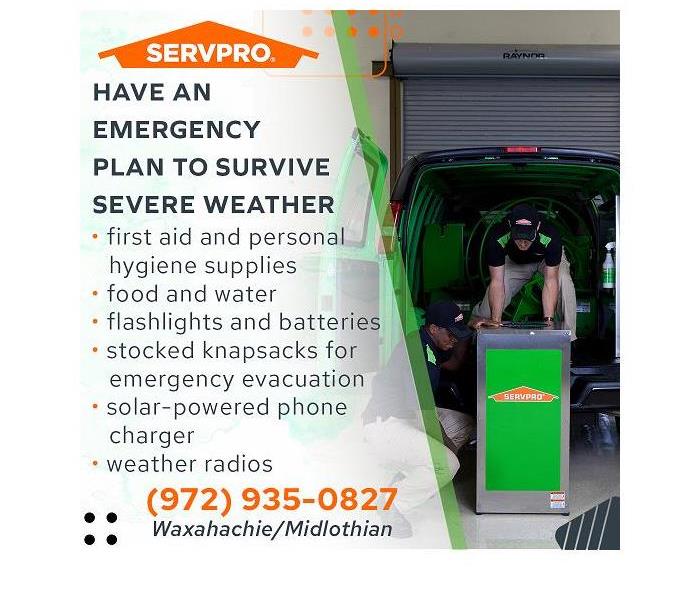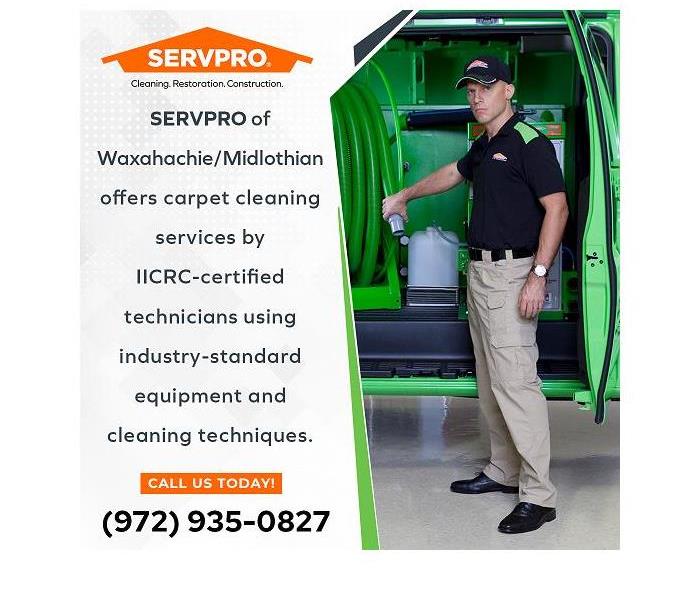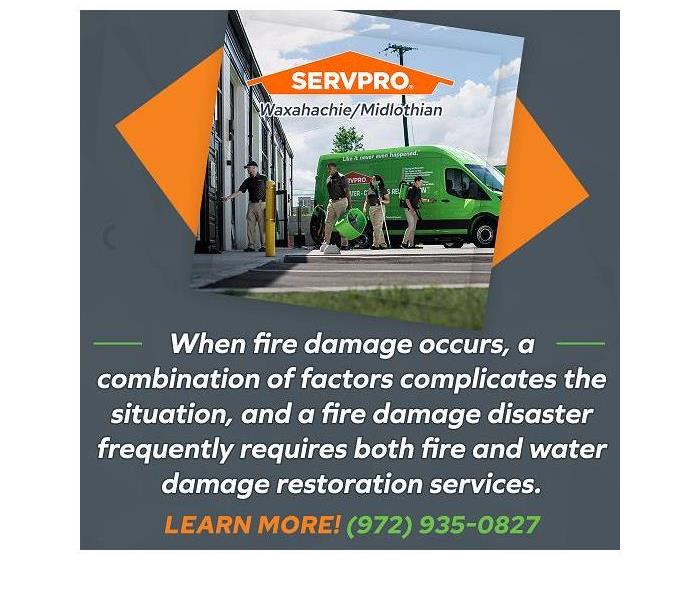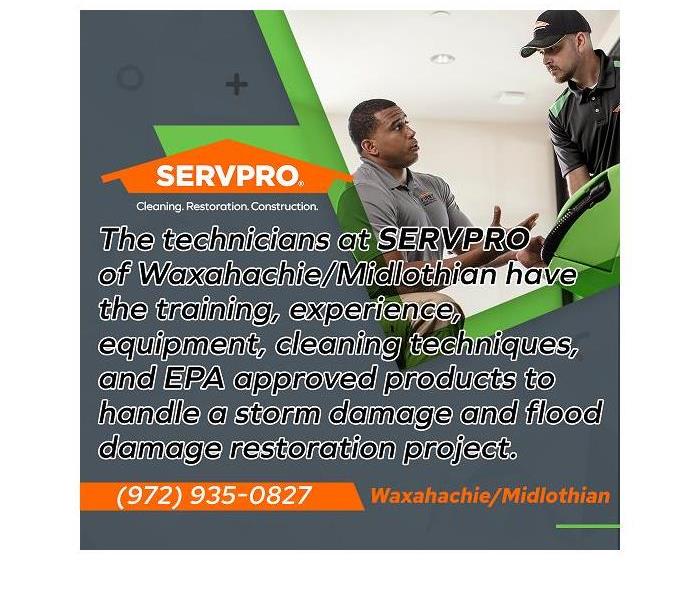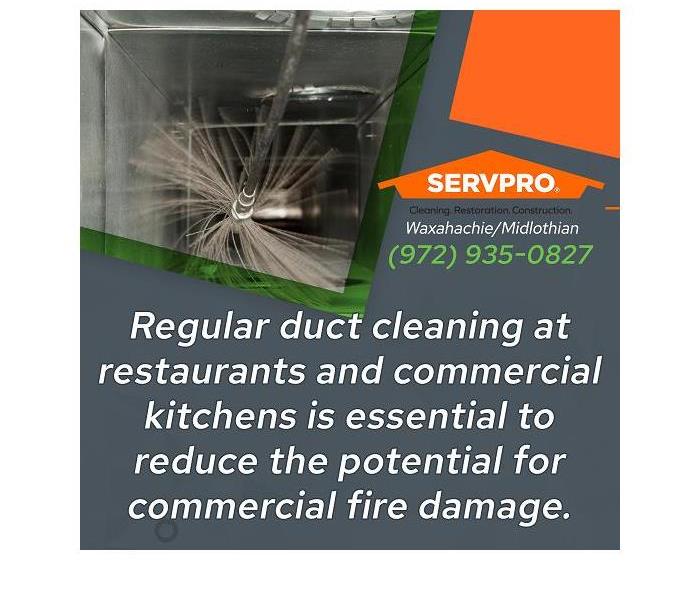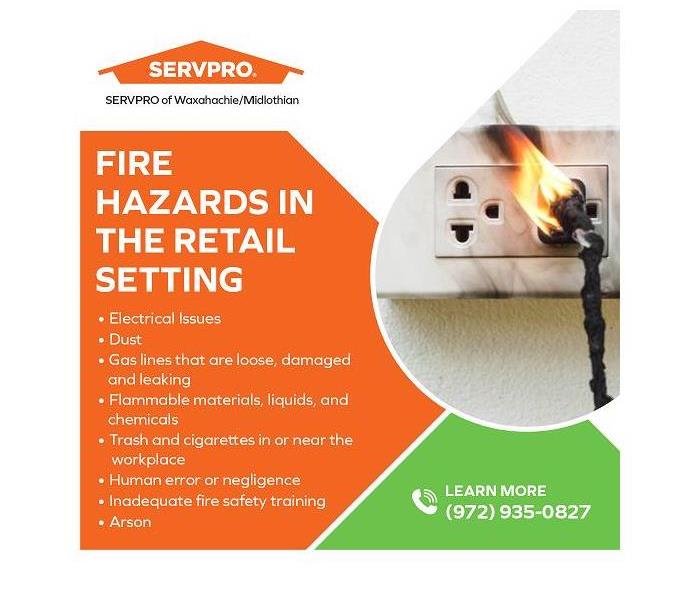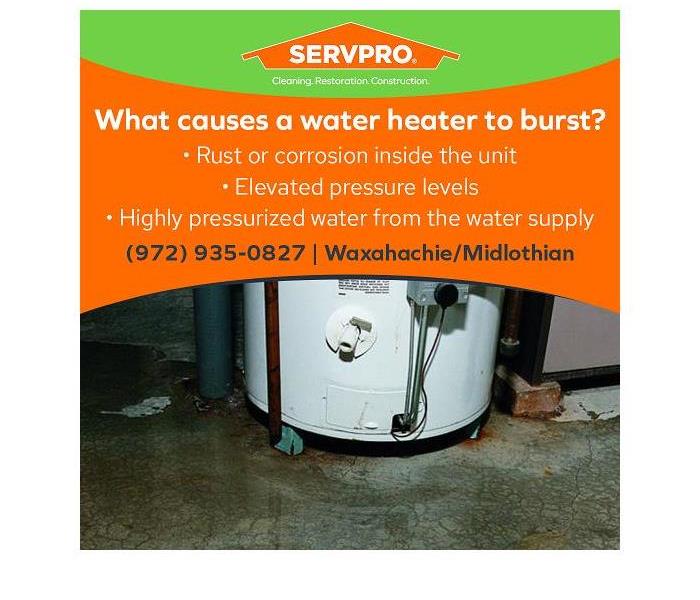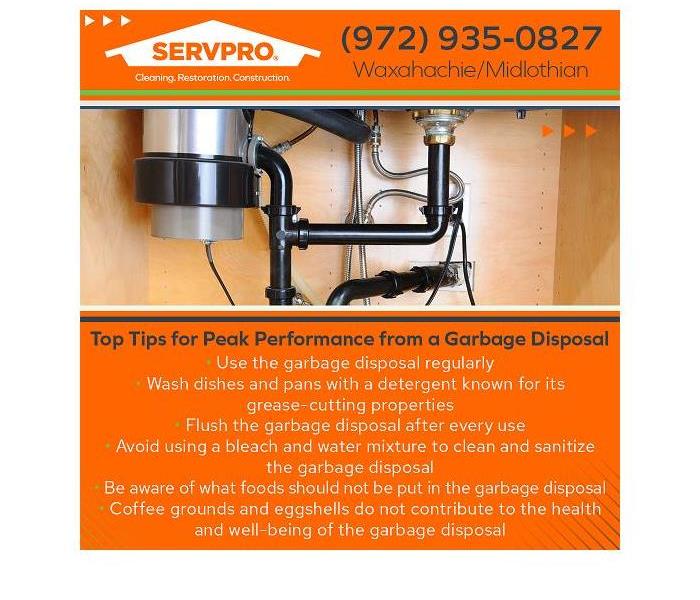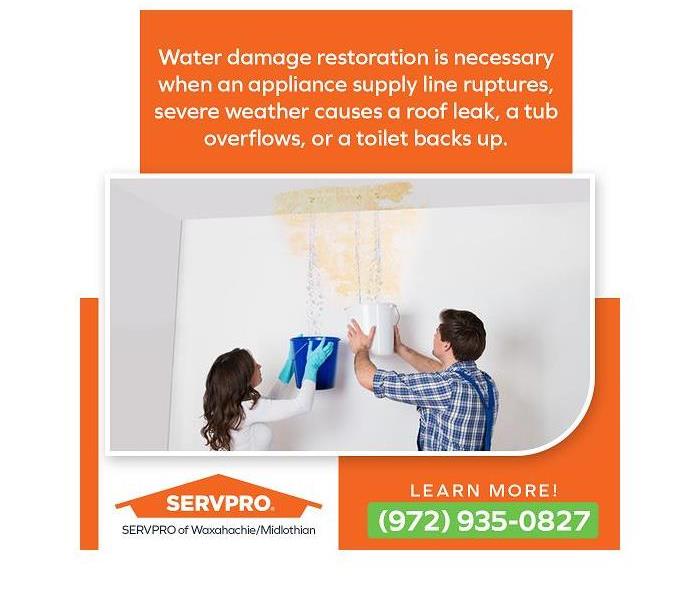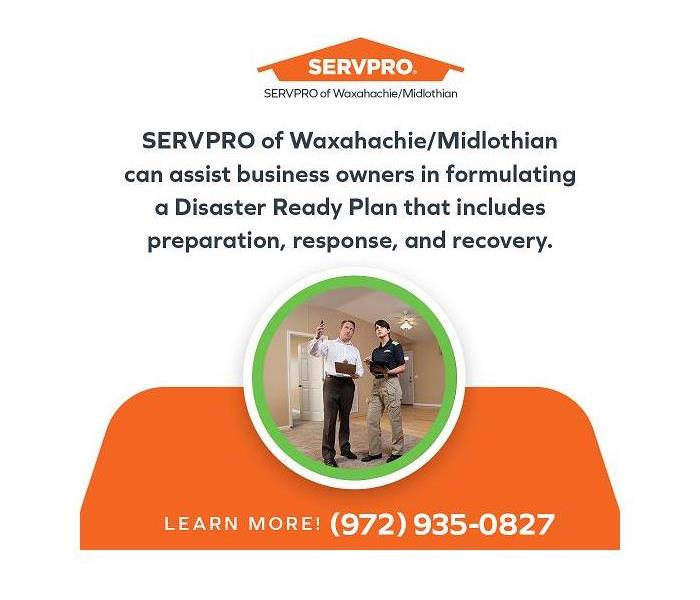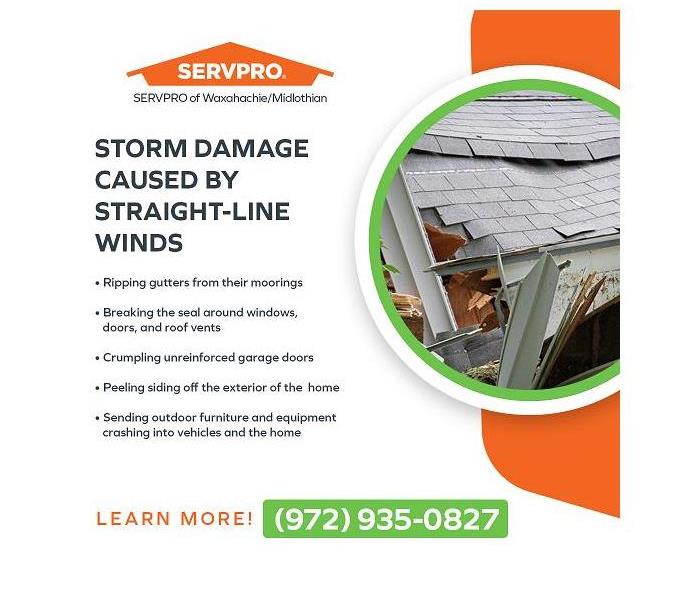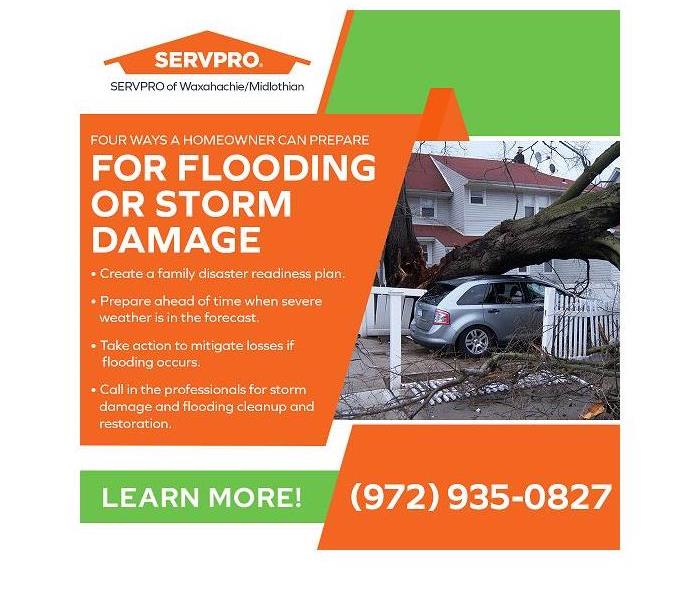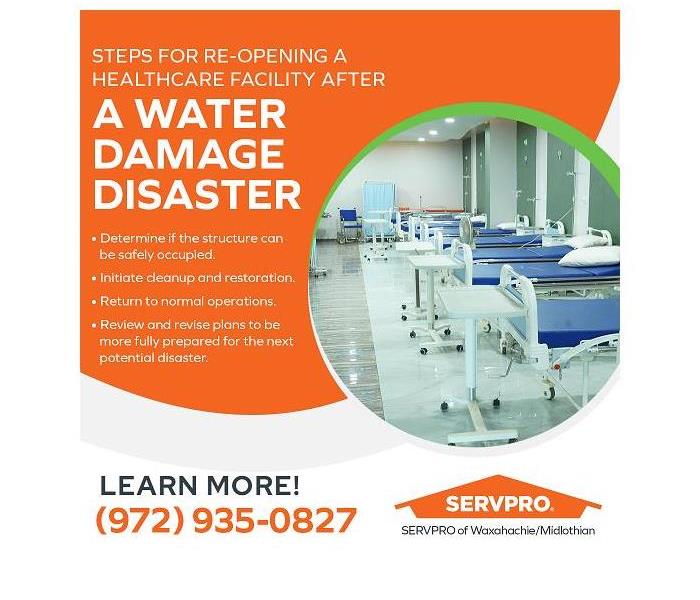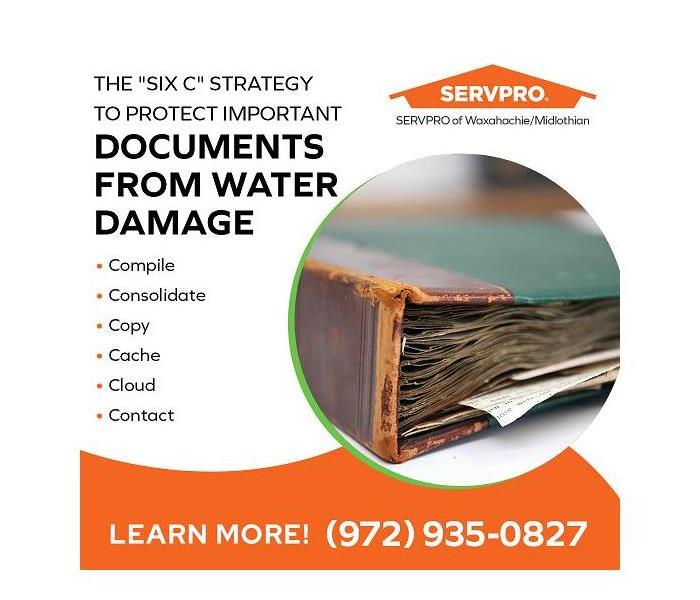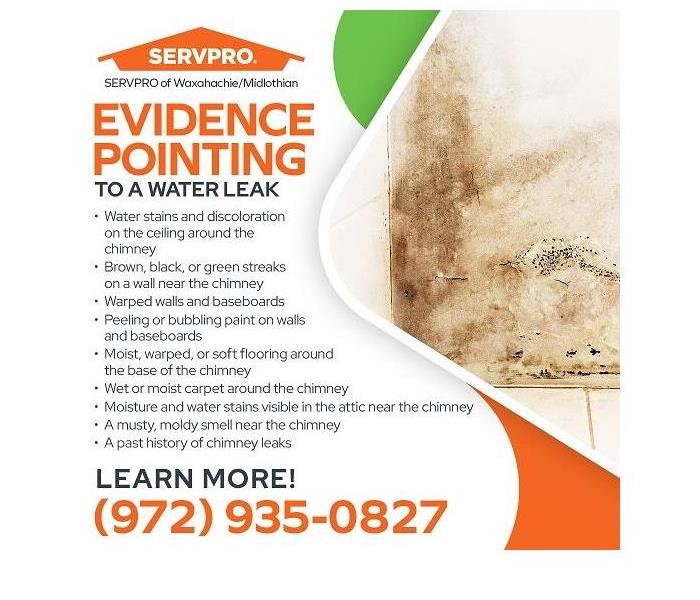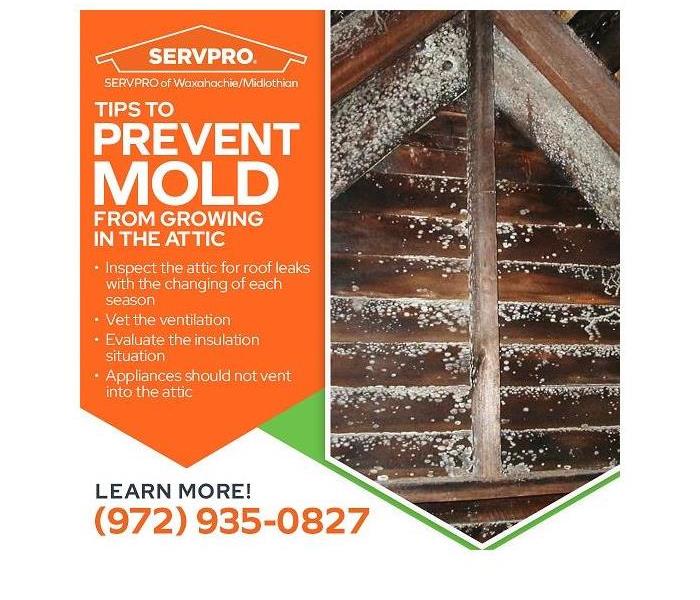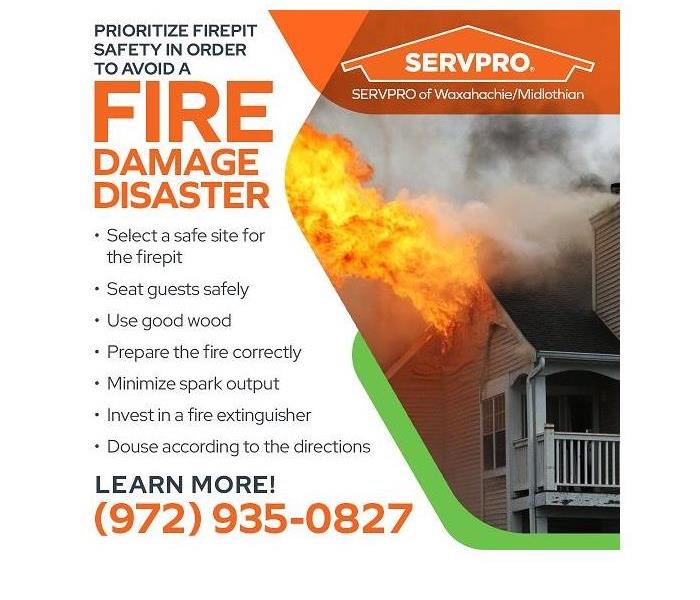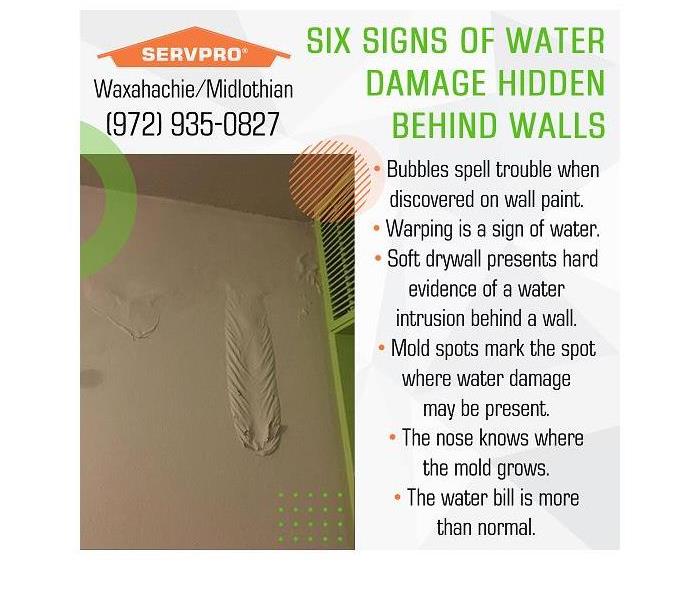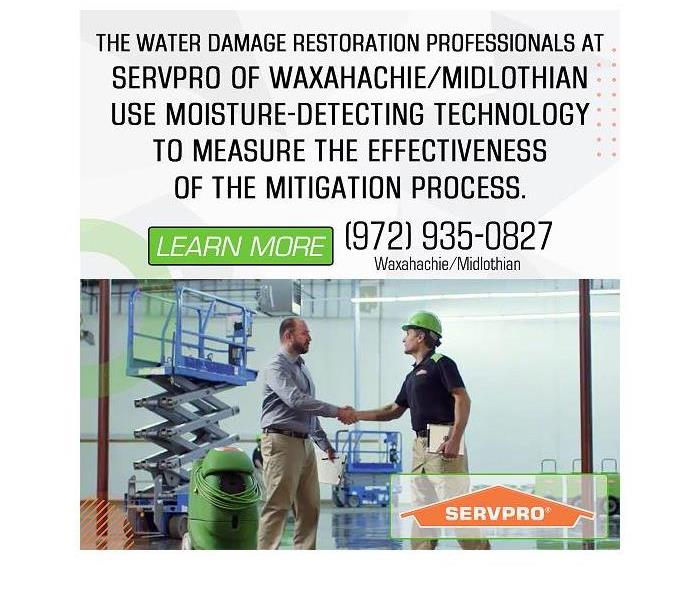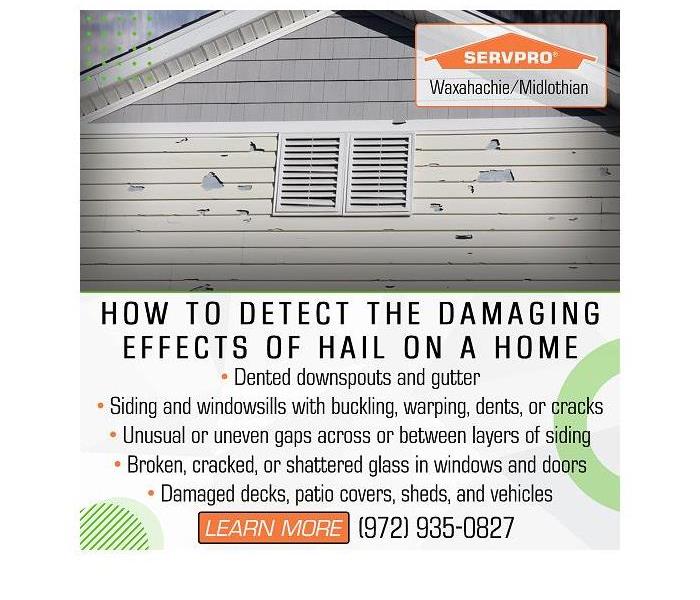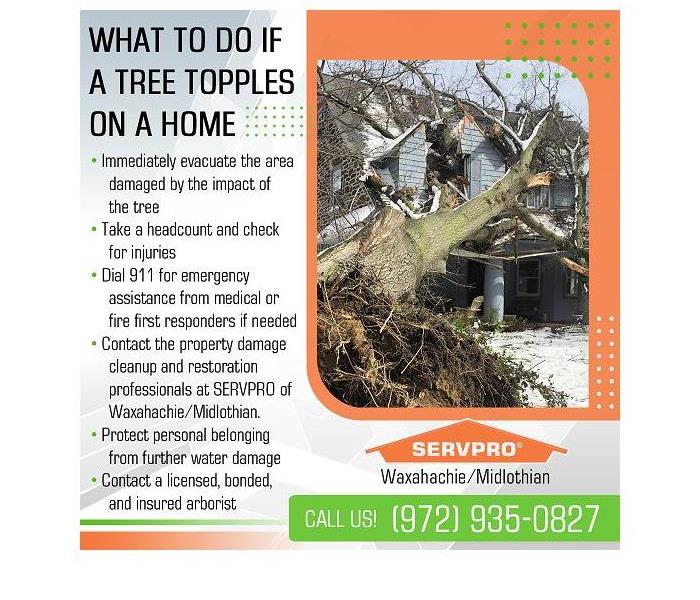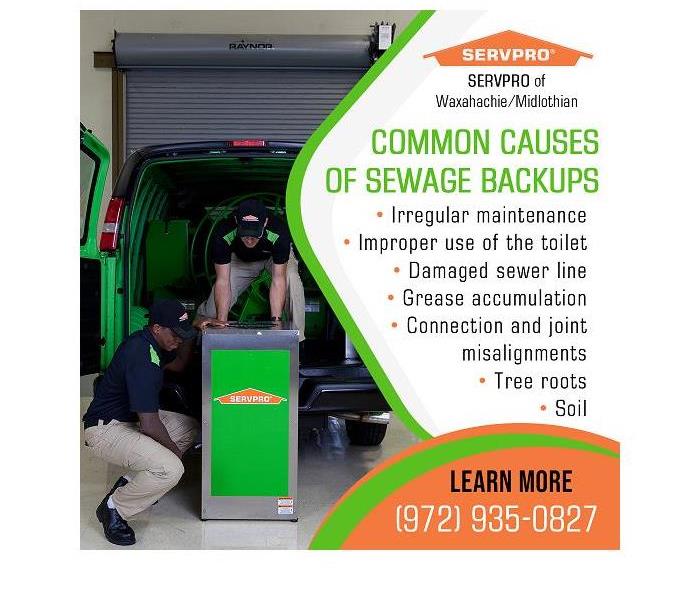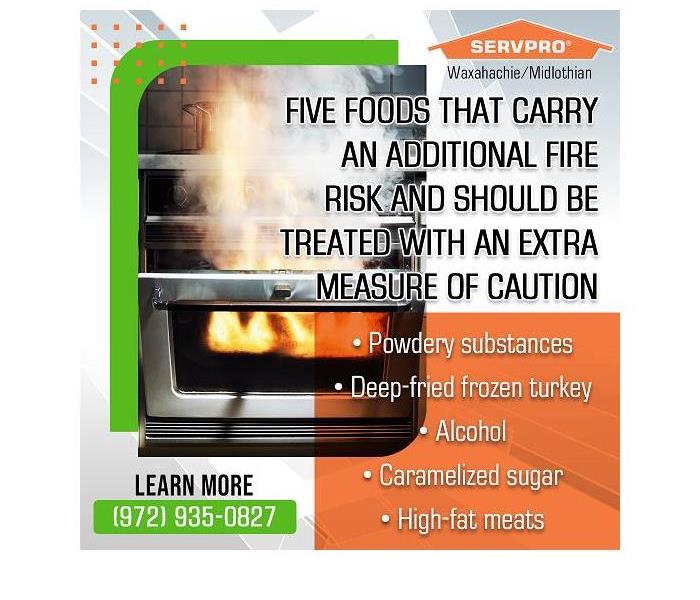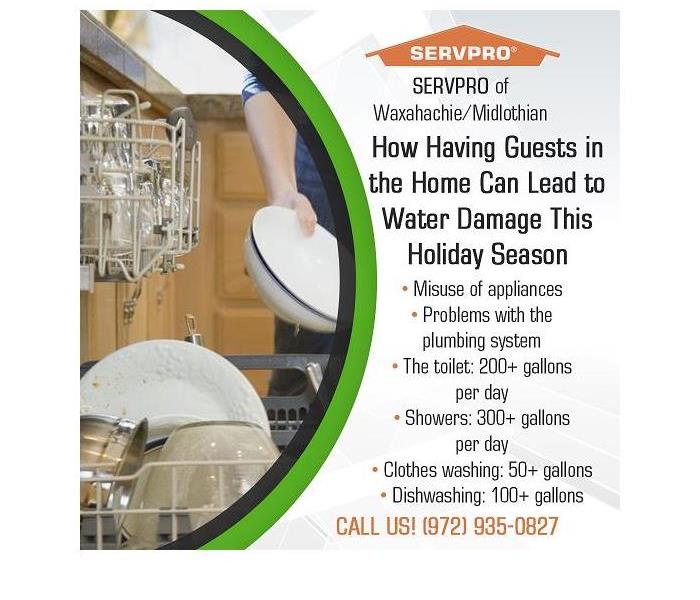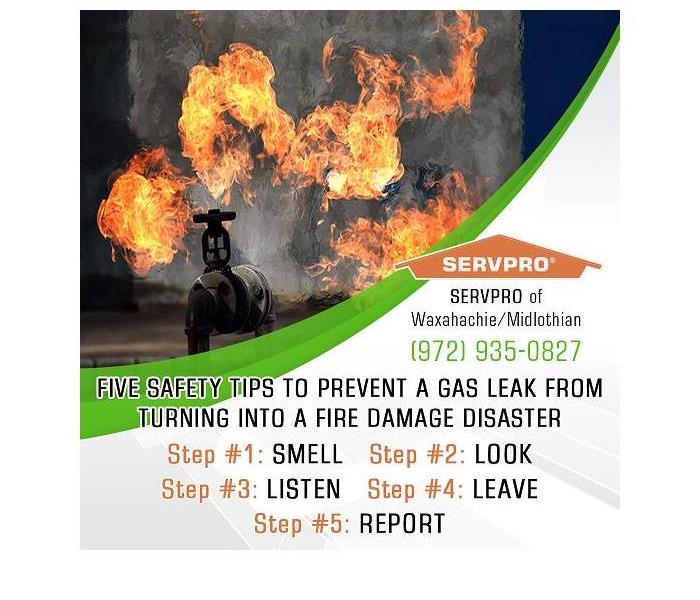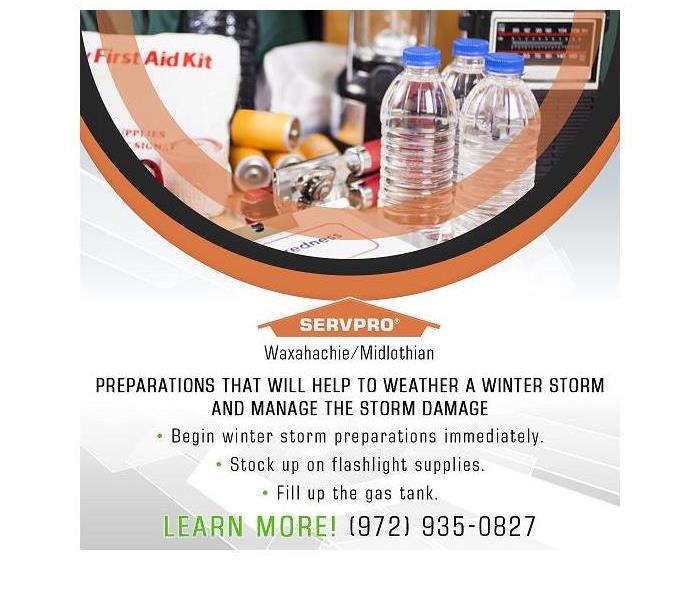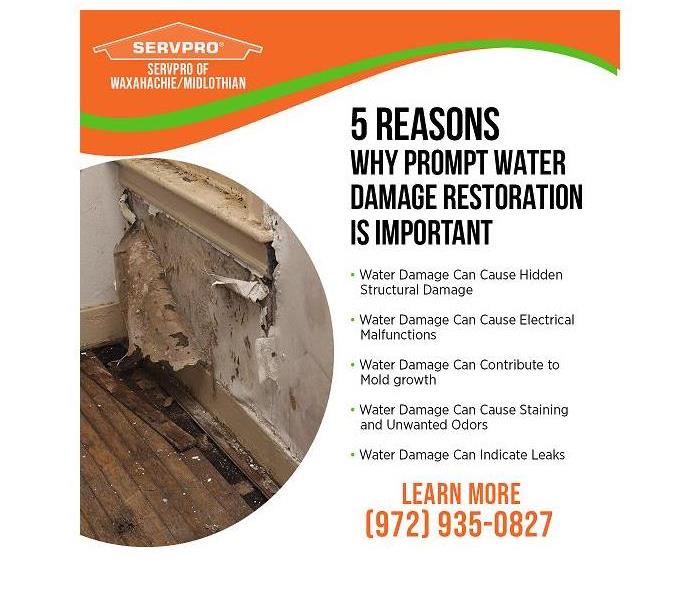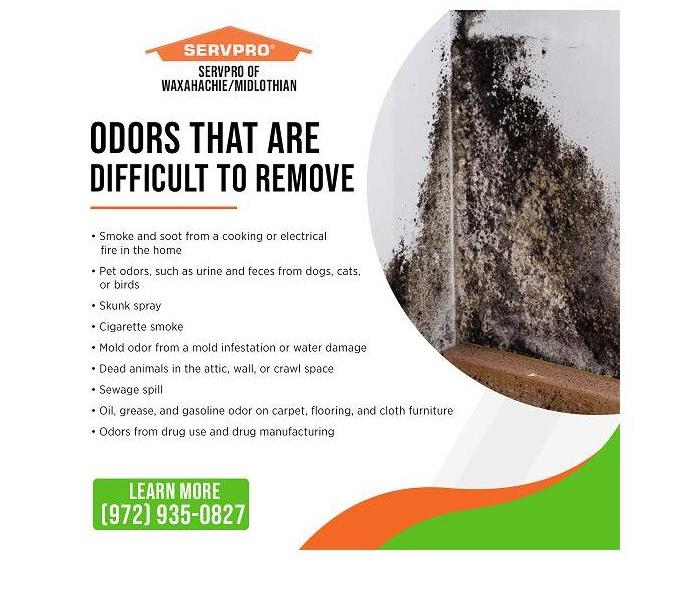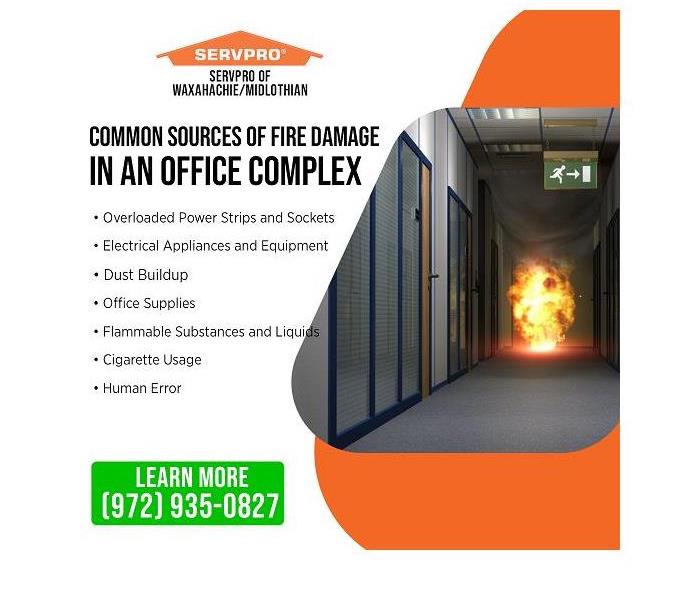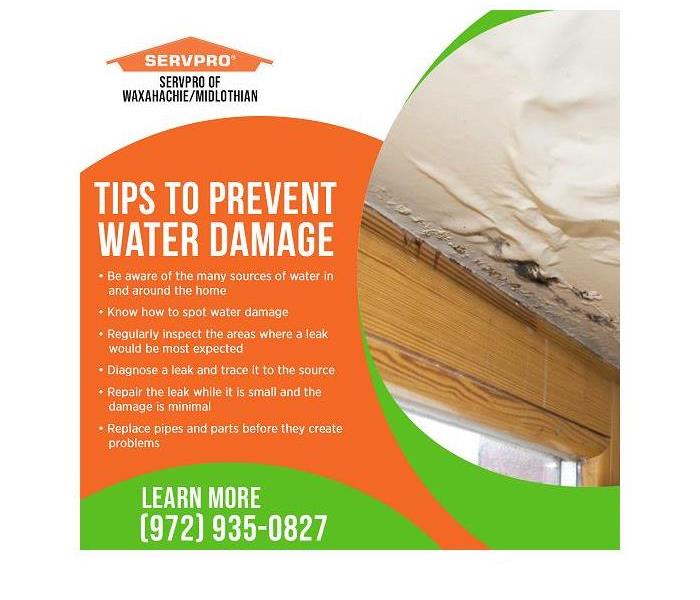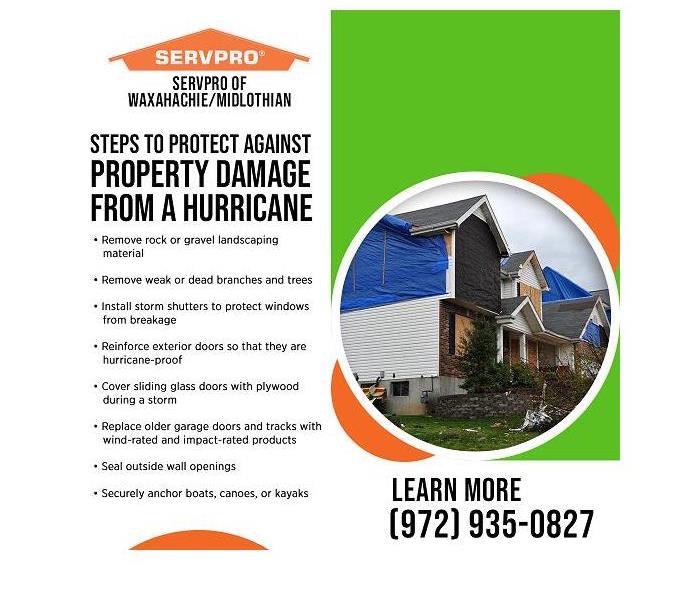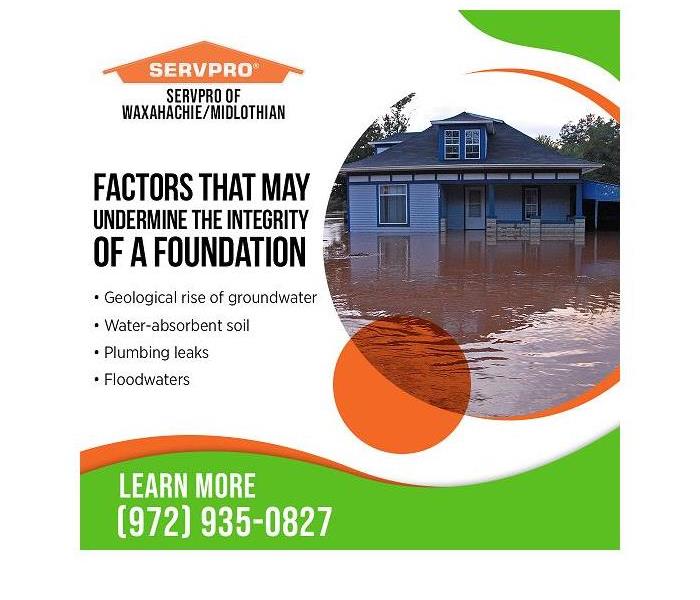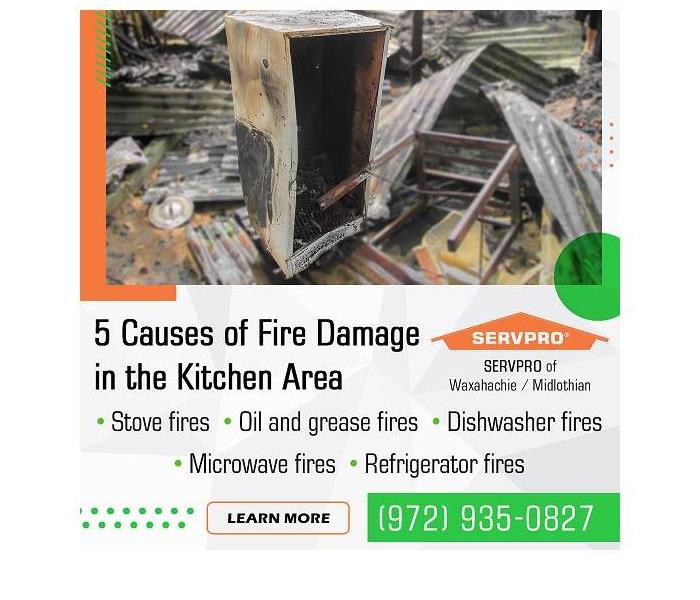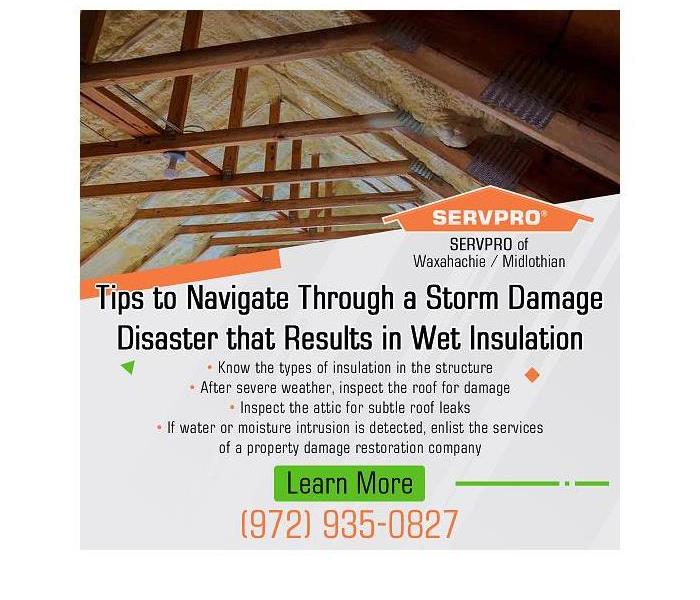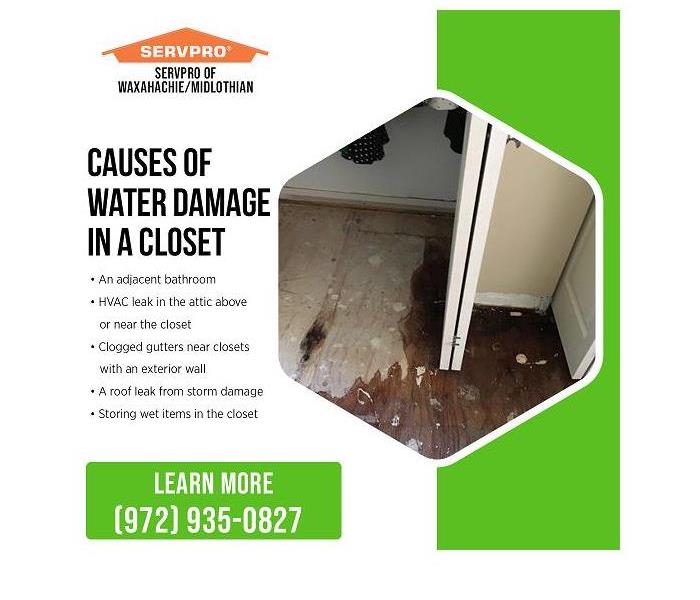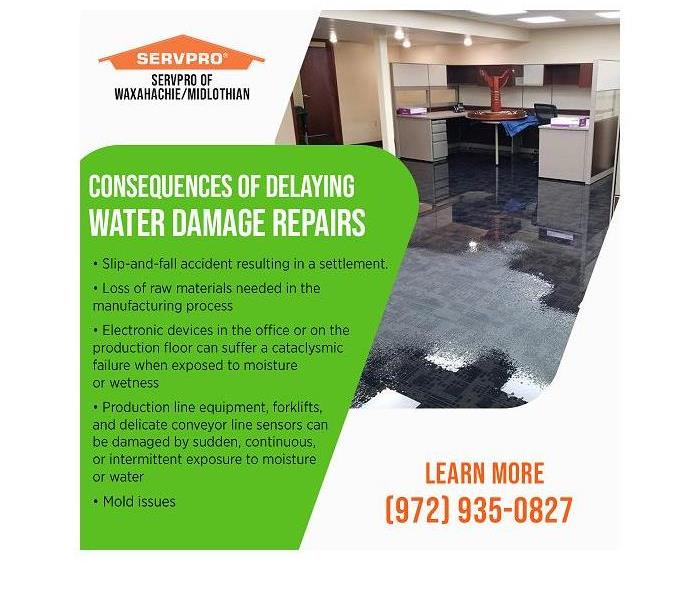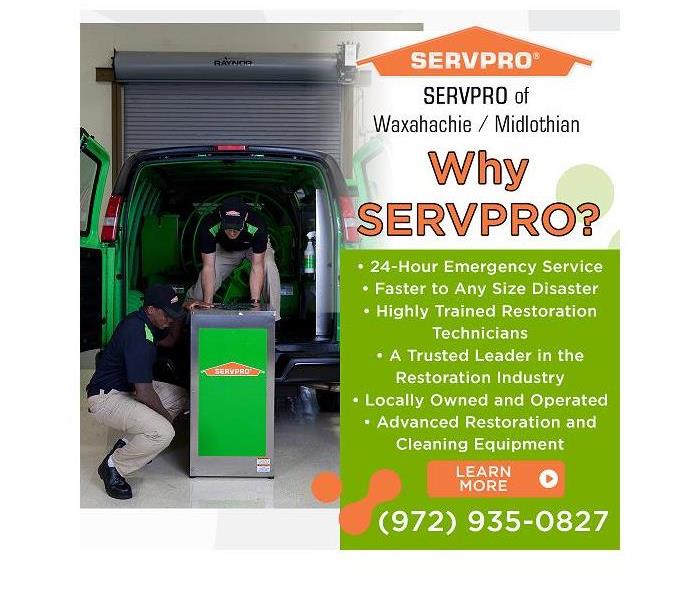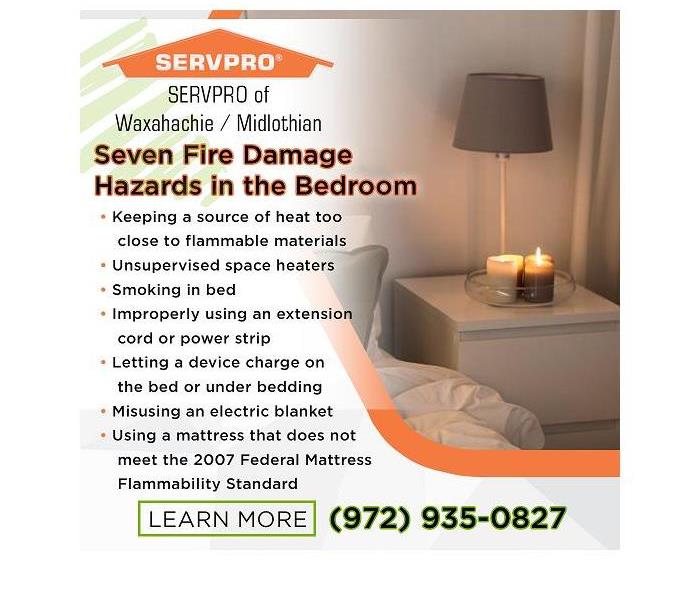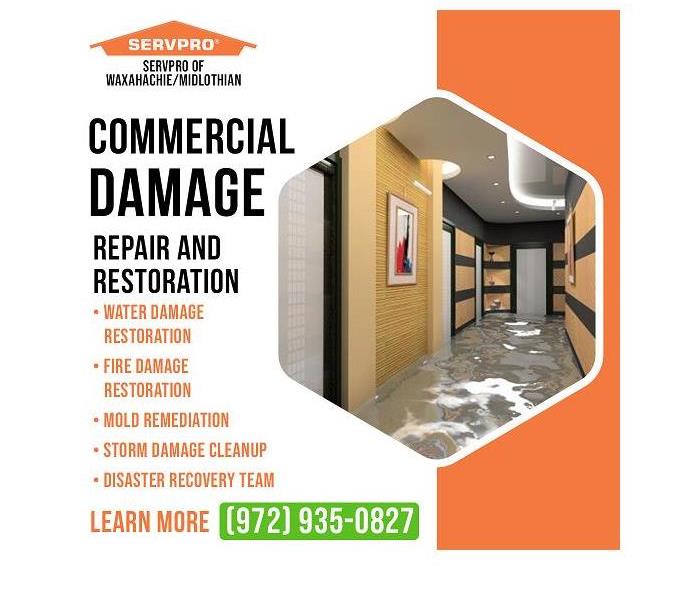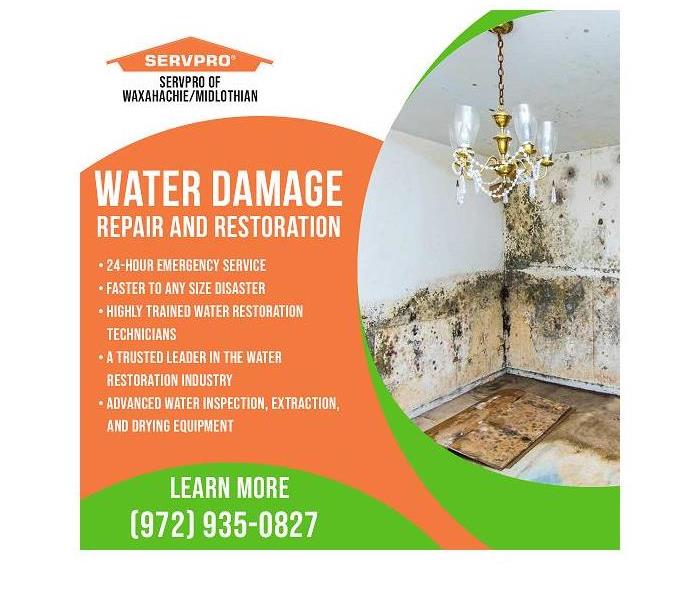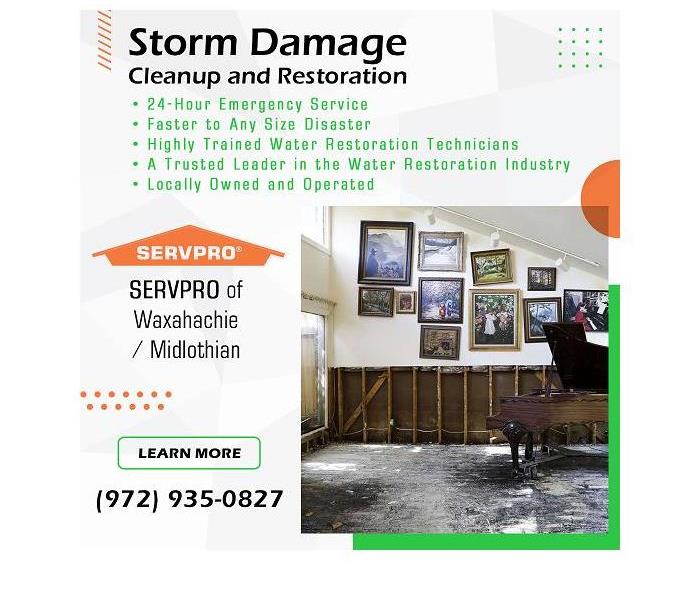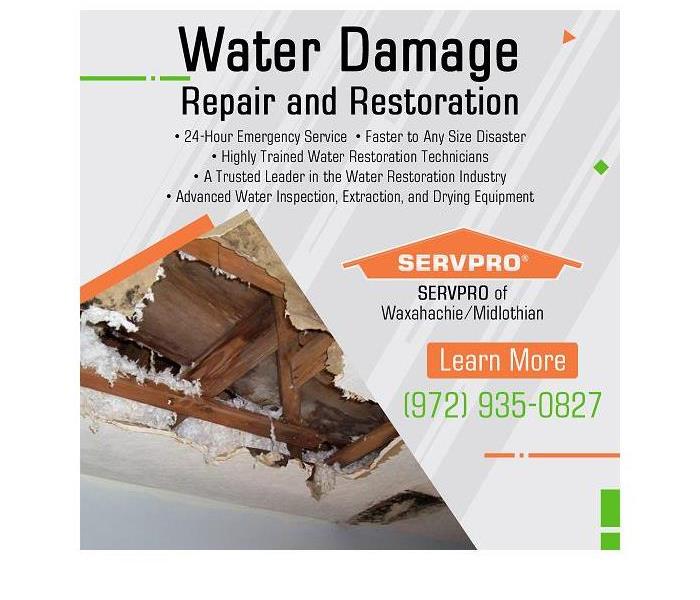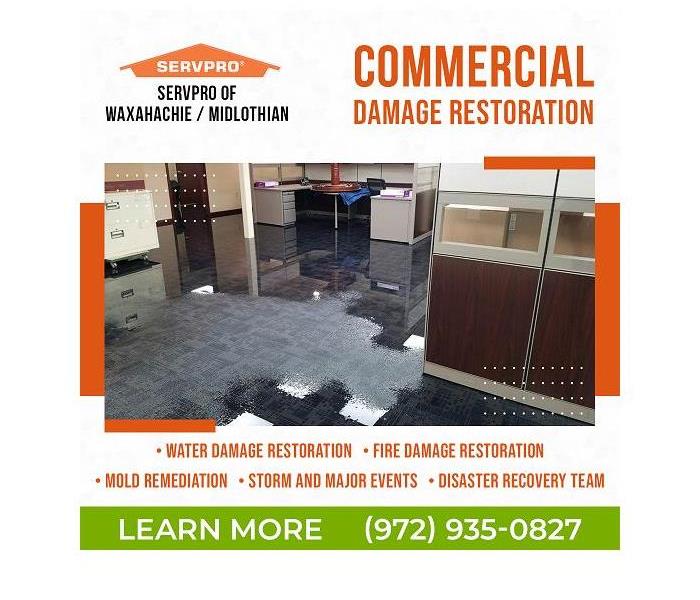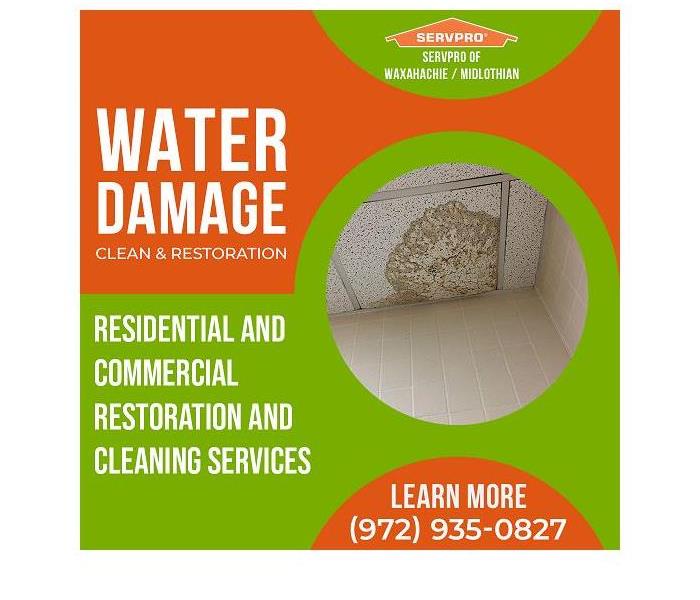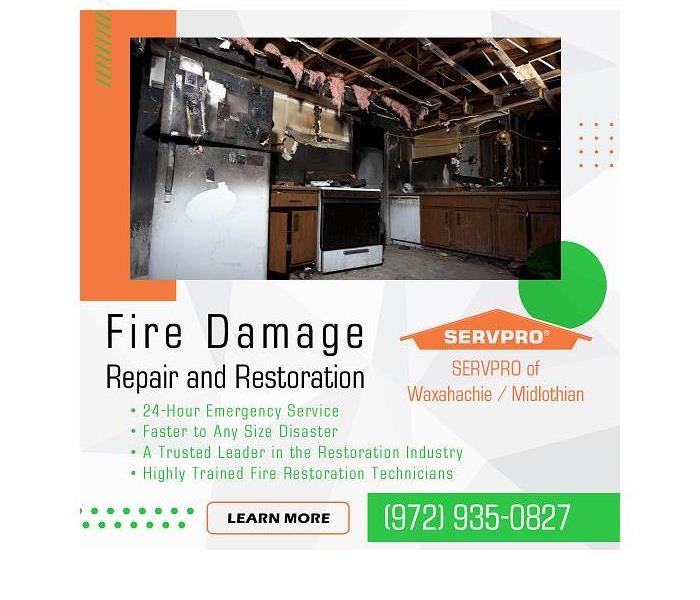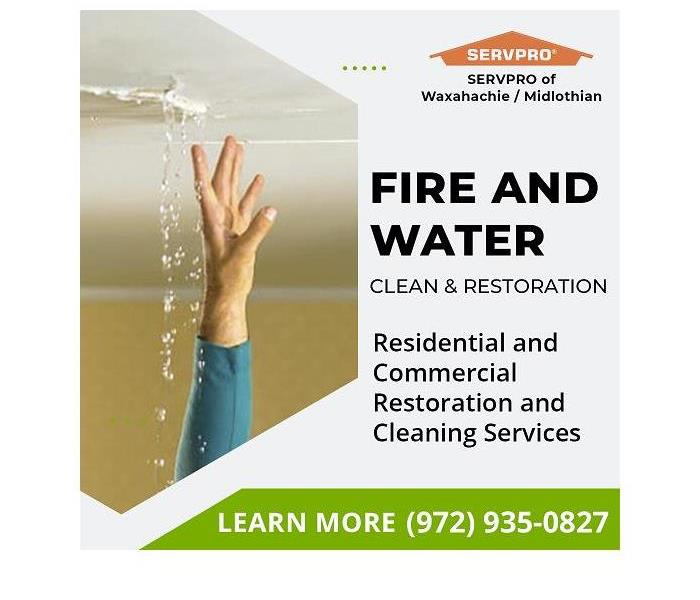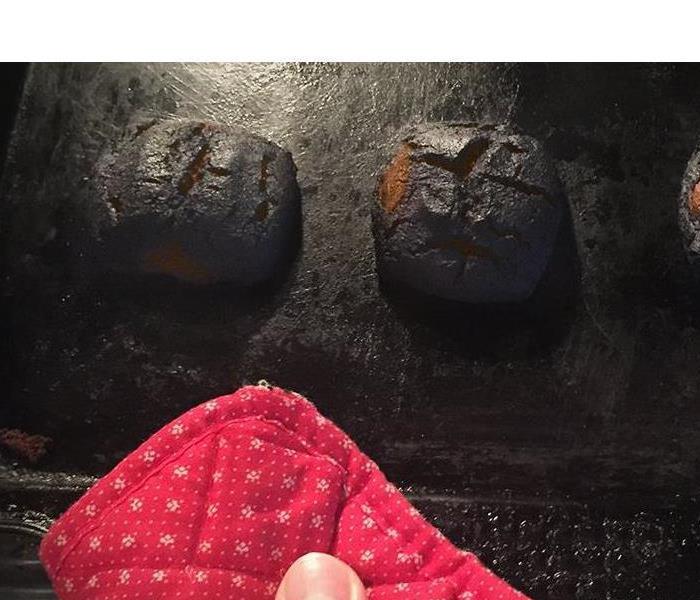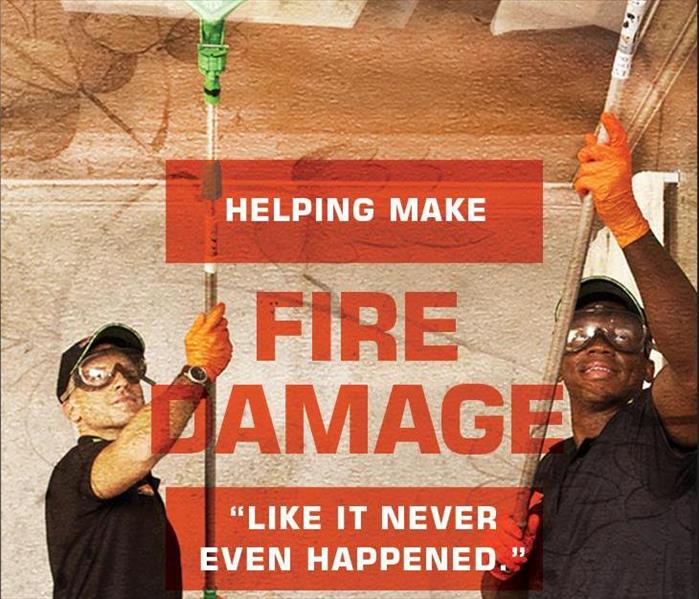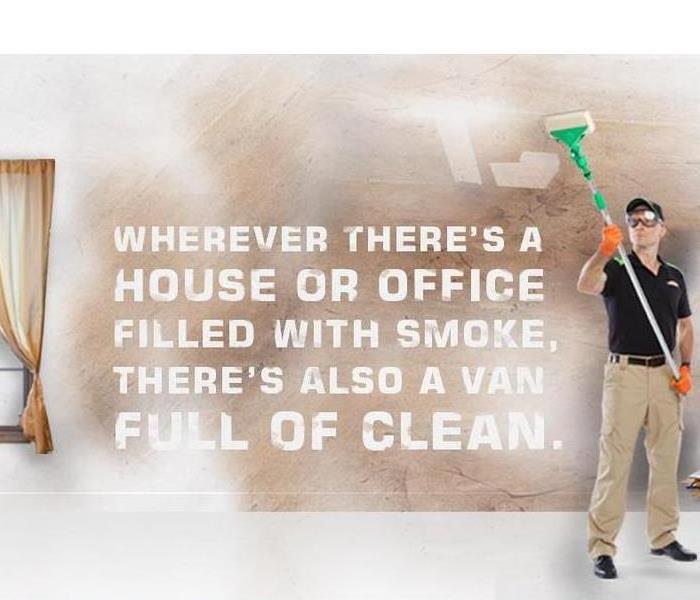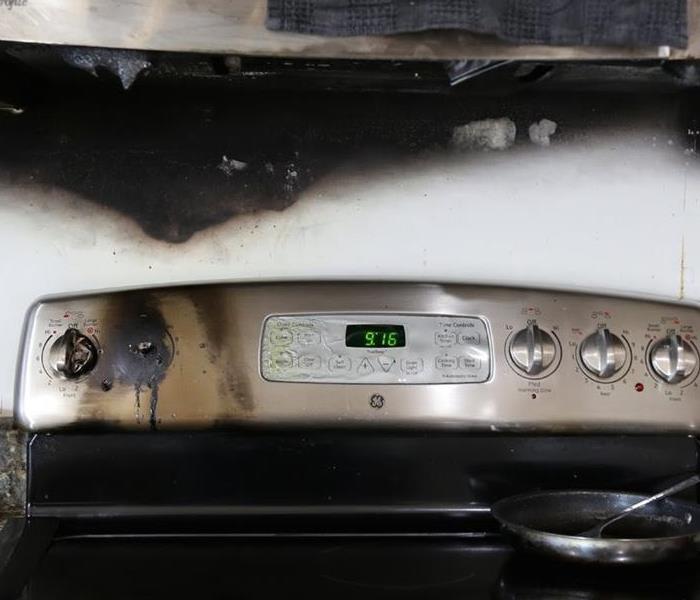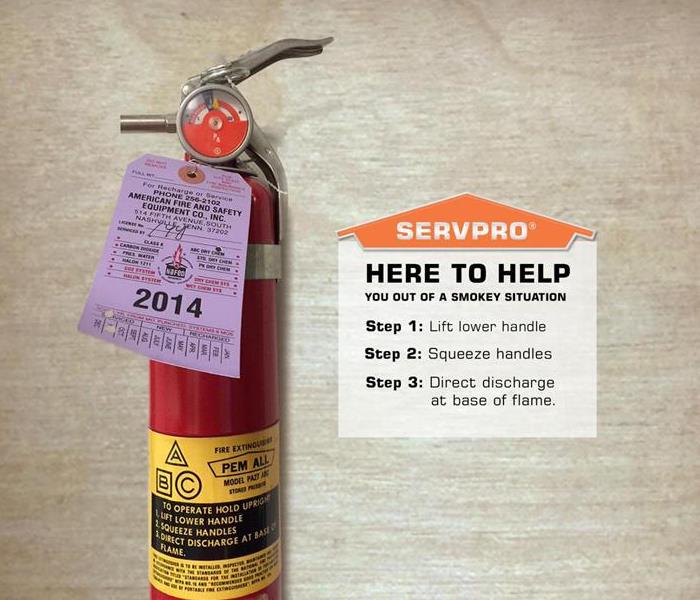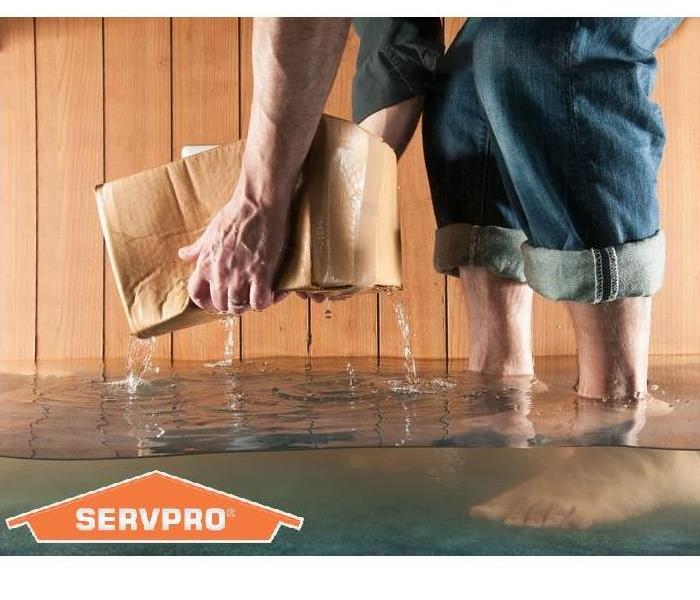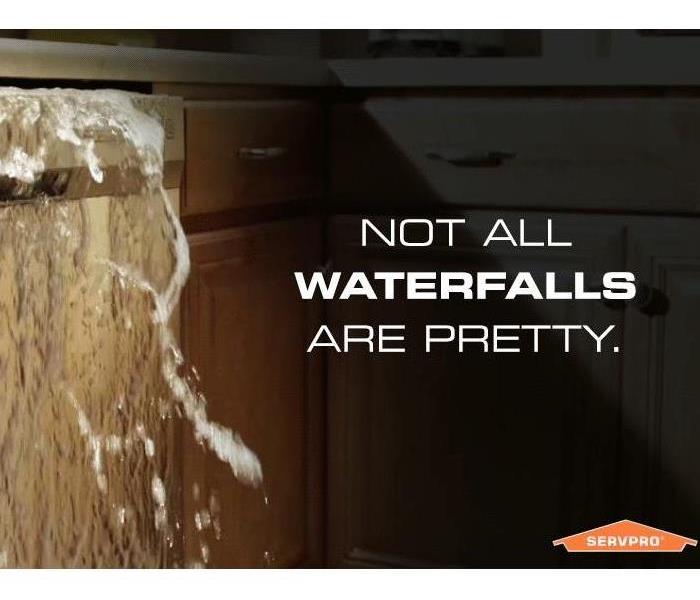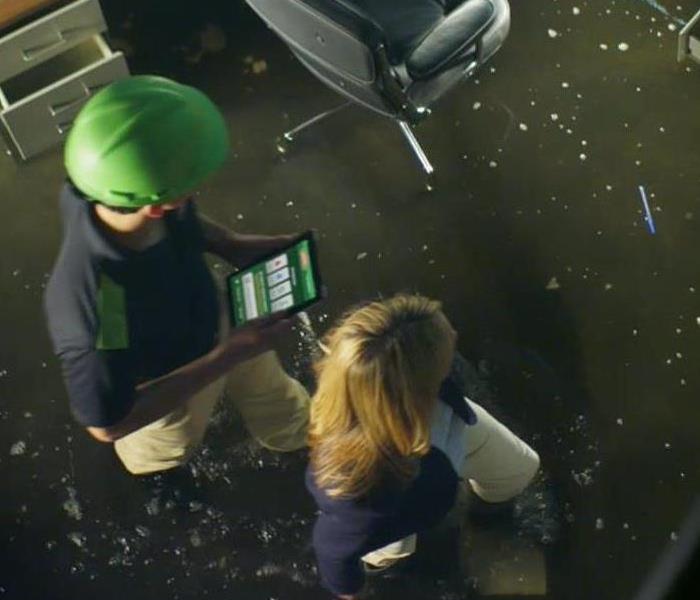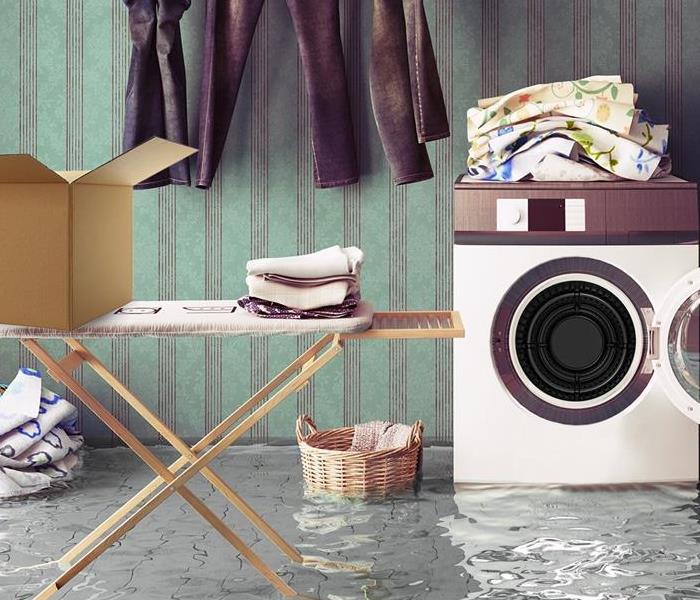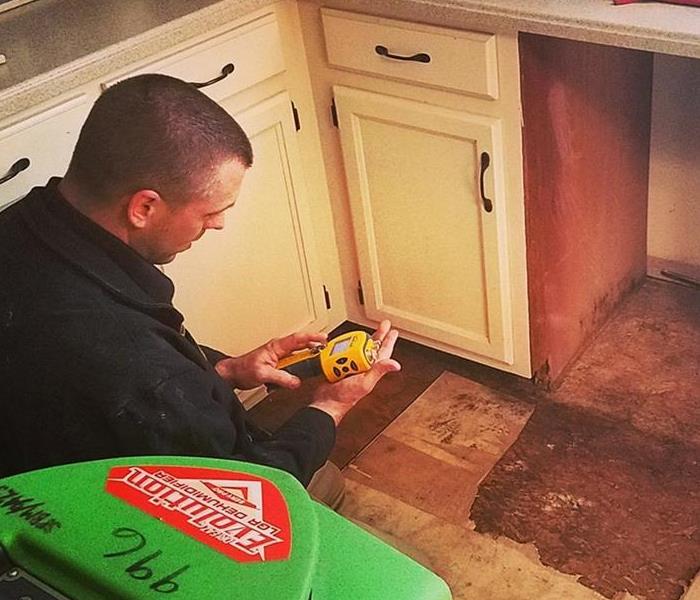Archived Blog Posts
Fire damage restoration and water removal services for property damage caused by a hair dryer fire
3/13/2023 (Permalink)
Blog Summary: SERVPRO of Waxahachie/Midlothian urges homeowners to exercise caution when using a hair dryer.
Water removal is one of the many property damage cleanup and restoration services offered by SERVPRO® of Waxahachie/Midlothian. When a hair dryer or other heat-generating device causes a fire, the scene often involves large amounts of water used to extinguish the flames if the fire department responds to the scene.
Any appliance or device that uses electricity is a potential fire hazard, and if the electrical device or appliance generates heat, the fire risk is elevated. A stove, toaster, air fryer, waffle iron, coffeepot, and hot air popcorn popper are examples of heat-producing appliances that can cause a fire in the kitchen.
Like the kitchen, the bathroom contains several heat-producing devices that can cause a fire or even explode. Many homeowners use small ceramic space heaters or heat lamps to warm their rooms on a cold morning. Unattended space heaters are a common cause of house fires. Curling irons and hair dryers reach very high temperatures and can cause a fire.
The health and beauty experts at Sojourn offer the following advice about using beauty tools that generate very high temperatures: “Most curling irons and flat irons have temperature settings that range from 125 – 425 degrees Fahrenheit. No hair should ever be subjected to heat of 400 degrees or above; unless a licensed professional is doing a special service that requires those temperatures.”
A hairdryer reaches temperatures approaching 140 degrees Fahrenheit. Though not as hot as a curling iron, a handheld hair dryer does get hot enough to catch fire. If conditions are right, the device can explode.
The use of a curling iron or hair dryer should instill a heightened awareness of the danger of electrical shock, superficial burns to the skin, hair damage, fire, and an explosion. Modern hair dryers have an outer plastic casing designed to protect the device from impacts and shield the motor and electronics inside the unit. Under normal operating conditions, the user can also have confidence that heat-producing appliances such as a space heater and heating tools such as a hair dryer can be used safely. The elevated fire risk still demands a higher level of awareness, caution, and safety when using a hair dryer.
The plastic casing can melt and catch fire
The plastic outer casing on a handheld hair dryer is designed to protect the internal components from impacts, water, and debris. The casing also protects the user from moving parts, electrical components, and heating elements inside the device. The plastic covering comes in a variety of attractive colors, shapes, and sizes to accommodate different tastes and needs. The sturdy plastic makes the hair dryer lightweight and easy to use.
The plastic housing can melt if the hair dryer overheats
Continuous use without allowing the tool to cool down, a blockage of the intake vents, or a blockage of the barrel of the device can cause overheating. These extreme temperatures can melt the plastic, and the device could catch fire. Any combustible items or flammable liquids near the haircare tool could also catch fire.
Wiring issues can cause a fire
Another hair dryer fire hazard is related to the wiring inside the tool and the external cord and plug. Damage to the plug or cord poses a fire hazard and the risk of electrical shock and grave personal injury.
Often, curling irons and hair flatteners are used in conjunction with a hair dryer. If the cord or plug of the hair dryer touches either of these two hair styling tools, the insulation can melt, exposing the “hot” wires of the hair dryer. The heating unit for curlers can also damage electrical cords or plugs. Hairstyling requires skill, concentration, and patience. It also requires attention to safety considerations. Yet, the activity is not without risk of fire.
Modern hair dryers have an emergency shutoff button on the cord near the plug. If the hair dryer catches fire, the unit can be safely turned off by pressing the button.
A hairdryer can explode
Human error or manufacturer defects are the primary causes of an explosion. Overheating is often related to the incident. Random explosions have occurred, but they are rare. Human error may involve laying the hair dryer on the counter while the device is still running. The internal motor can overheat very quickly and possibly explode. When the tool is not in use, turn it off. Place the hair dryer on a hard, dry surface away from clothing, towels, facial tissue, and flammable liquids such as alcohol, fingernail polish, and hair spray. Another option is to hang the device where airflow is not restricted and the unit can safely cool.
What to do if a hair dryer causes fire damage
A fire damage disaster often involves a chemical cleanup from a fire extinguisher discharge or a major water damage cleanup if the fire department is dispatched to the scene. SERVPRO of Waxahachie/Midlothian is available 24/7, 365 days a year, including holidays. IICRC-certified technicians arrive in about an hour to clean and restore the damaged home. The team utilizes heavy-duty wet-dry vacuums, powerful dehumidifiers, and rapid-spin fans to remove the water and excess moisture. Advanced cleaning techniques and EPA-approved products disinfect, sanitize, and deodorize the complex disaster scene.
For more information about Midlothian, TX, water removal services, contact SERVPRO of Waxahachie/Midlothian by calling (972) 935-0827 or emailing acarey@SERVPRO10932.com.
The significance of the “Waffle House Index” for disaster preparedness and response
3/13/2023 (Permalink)
Blog Summary: SERVPRO of Waxahachie/Midlothian highlights how the “Waffle House Index” helps disaster relief agencies and communities survive and recover from a natural disaster.
The team at SERVPRO® of Waxahachie/Midlothian provides fire damage, smoke damage, storm damage, and water damage restoration services to homeowners and businesses that have suffered a property damage disaster.
Every day brings new challenges for business owners in the Dallas-Fort Worth region of North Texas. These challenges include the normal business operations of customer service, accounting and payroll, and inventory management and control. Unforeseen risks can unexpectedly arise, disrupting business operations and playing havoc with the revenue cycle. Natural disasters such as flash floods, tropical storms, tornadoes, and the devastating freeze of 2021 can bring daily life and business to a standstill.
Many businesses close their doors only to never open them again. Official estimates are that many small businesses, as many as sixty percent (60%) in some cases, are not able to reopen for business once the disaster is over and the damage is cleaned up. The financial burden is too heavy to shoulder. An emergency readiness plan is essential if a business is to literally “weather the storm.”
Many of the nation’s large “big box” stores and distribution centers have expended extraordinary effort and expense to be prepared for a wide range of worst-case scenarios. At the top of the list is Waffle House, a staple business in Texas. As of 2022, there were 121 Waffle Houses in Texas, making it number seven in the top ten states with the most Waffle House locations. This company has a corporate culture of preparedness so well respected and recognized that it sets the standard for businesses in the United States regarding being prepared, meeting challenges head-on, and continuing to serve its customer base no matter how difficult circumstances might be. Waffle House is so thorough in its preparedness that “The Waffle House Index” is informally utilized by some disaster relief officials as a metric to determine the severity of disasters that strike communities.
The Waffle House response: What the index levels mean
A pillar of the Waffle House’s mission is its fundamental commitment to supporting the disaster-stricken communities where the restaurants are located. There are three levels that indicate the company’s ability to keep its restaurants open and serve the community.
At level “Green,” a restaurant is open for normal business and operating at full capacity. The disruptions, if any, caused by the disaster are manageable.
At level “Yellow,” though the establishment is open for business, only limited service is available to patrons. Status “Yellow” may reflect issues with the power grid. Supplies and food may be running out. Waffle House’s ability to restock the stores may be hindered by bad weather, dangerous conditions, infrastructure disruptions, and supply chain interruption. If Waffle House has restaurants operating at “Yellow” capacity, the disaster must be rather severe.
A level “Red” index is the most serious. Restaurants are closed. Disaster officials can infer from the Waffle House response that the disaster’s impact was catastrophic and possibly widespread. The disaster response will be ramped up to address a large-scale disaster. Personnel from surrounding counties and nearby states may be mobilized to reflect the seriousness indicated by a “Red” index level.
The advantage of an Emergency Ready Plan
Having a plan before a disaster strikes brings a business owner or manager peace of mind. Businesses that are able to execute a strategic disaster response and recovery plan are much more likely to recover quickly and resume normal business operations. Preparation is the key to success.
Reasons to choose the SERVPRO Emergency Ready Plan
Here are seven reasons to work with SERVPRO of Waxahachie/Midlothian to create an Emergency Ready Plan.
- Working in concert with SERVPRO of Waxahachie / Midlothian, the business receives a no-cost assessment of its facility.
- A concise Emergency Ready Profile containing critical information is prepared for the business. Document preparation is efficient and quick. This upfront preparation can save valuable time and avoid advanced secondary damage in the event of a disaster.
- The plan serves as a guide to re-enter the facility when conditions are safe. An immediate action plan minimizes downtime.
- During the process, SERVPRO of Waxahachie/Midlothian is established as the primary disaster cleanup and damage restoration company. When a disaster strikes, one phone call delivers results. A team of IICRC-certified technicians arrives in about an hour, 24/7, 365 days a year, including holidays.
- The plan identifies the decision maker who can authorize work to begin. This efficiency allows technicians to start the mitigation process upon arrival.
- The SERVPRO team will have access to vital details about the facility, such as the location of electrical panels, shut-off valves, and crucial contact information.
- Prior planning takes the hassle out of the insurance claims process. SERVPRO of Waxahachie/Midlothian helps the business navigate the insurance claims process by coordinating the necessary paperwork, making the experience quick and easy.
To learn more about Ovila, TX, water damage restoration services, contact SERVPRO of Waxahachie/Midlothian by phone at (972) 935-0827 or by email at acarey@SERVPRO10932.com.
Water Removal and Cleanup Services for Water Damage Caused by Commercial Plumbing Issues
2/8/2023 (Permalink)
Blog Summary: SERVPRO of Waxahachie/Midlothian sheds light on common plumbing issues at commercial facilities. These plumbing issues can damage customer perception and cut into profits.
SERVPRO® of Waxahachie/Midlothian specializes in water removal, cleanup, and restoration. When raw sewage is involved in a water damage disaster, a thorough cleanup is crucial if the site is to be made sanitary and safe.
Any disruption of a business’s revenue cycle negatively impacts its profitability. Common causes of business interruptions may include:
- A major pandemic with widespread shutdowns, layoffs, and closings
- Disruptions in the international supply chain
- Worker shortages
- Travel restrictions
- Natural disasters such as hurricanes, tornadoes, and the February 2021 arctic blast
- Water damage from natural and man-made causes
Any one of these challenges has the potential to shut down a small business. Recovery often requires a change in the economic climate or other factors beyond the control of the business owner.
Business owners, property owners, and facilities managers in Venus, TX, are vested in keeping their commercial buildings attractive, comfortable, safe, clean, and sanitary. The emphasis is on ‘clean’ and ‘sanitary.’ The recent pandemic has heightened national awareness of the necessity of keeping the office, shop, manufacturing unit, restaurant, retail outlet, church, school, or fitness center as pathogen-free as possible without endangering the health of the occupants with surface and airborne cleaning, disinfecting, and sanitizing chemicals. An area of concern often overlooked in the commercial and professional setting includes plumbing, septic, and sewage issues.
Employees, patrons, patients, and tenants exert tremendous pressure on a commercial plumbing system, and this continuous pressure creates new problems and amplifies any existing plumbing issues. A sewage backup in a professional office building, a school, or a daycare with a large clientele and multiple bathrooms on each floor can escalate into a catastrophe of epic proportions.
Commercial plumbing issues tend to be more expensive to repair and clean up. Multiple bathrooms and multiple floors expand the spillage zone, increasing the cost of cleanup. Work slowdowns or stoppages cut deeply into daily and monthly revenues. In fact, the loss of business may far exceed the actual costs to remedy the situation in the building.
The business owner, facilities supervisor, and property management company must keep a vigilant eye on the buildings under their care. Listed below are some of the most common plumbing issues that arise in commercial facilities.
A clogged toilet
A toilet clog is a common occurrence in the commercial world. Causes of toilet clogs include the following:
- Frequency of usage
- Flushing unnecessary items down the toilet
- An animal (snake, rat, frog, or squirrel) caught in the sewer system attempting to exit through the toilet
- Vandalism
If initial efforts with a plunger fail, contact a licensed, bonded, insured plumber to remove the clog or make any necessary repairs. Proper maintenance and scheduled cleaning will spot problems in their infancy when solutions are quick, easy, and relatively inexpensive. Delays can have the undesired effect of compounding the clog, increasing spillage, and offending the sensibilities of customers and employees.
If the janitorial staff is unable to handle an extensive spillage, bring in a professional property damage cleanup company to remove the contaminated water with heavy-duty wet/dry vacuums, reduce the moisture levels, and clean, disinfect, sanitize, and deodorize the affected areas. In a multi-story building, delays in removing the black water may allow the water to seep through the flooring and contaminate the commercial space under the toilets. Sewage is messy, smelly, and unsafe for everyone in the building. If the HVAC system is contaminated, the entire building may be negatively affected.
Drain clogs
A drain clog may not be as disruptive and annoying as a toilet clog. Items that can stop up the sink include paper towels, grease, oil, chemicals, food, or dirt and grime. If a customer, client, or employee accidentally leaves the water running, a water damage disaster could result. At seven gallons of water per minute, a faucet left running into a clogged sink can spill thousands of gallons of water per day into a commercial facility. If the water damage disaster is on an upper floor in a multi-story building, the entire operation could be shut down for days while the building is undergoing cleanup and restoration.
Do not let a sewage backup from a clogged toilet or an extensive water damage disaster from a water release shut the doors of the business and turn off profits. SERVPRO of Waxahachie/Midlothian can arrive on the scene in about an hour. If the damage is extensive, the SERVPRO franchise family can scale to any size disaster. Available 24/7, 365 days a year, including weekends, the team of IICRC-certified professionals provides a rapid response and quick cleanup to get the wheels of commerce back in motion. The SERVPRO staff can also effectively handle the insurance claims process from end to end.
For more information about Venus, TX, water removal services, contact SERVPRO of Waxahachie/Midlothian by phone at (972) 935-0827 or email at acarey@SERVPRO10932.com.
Prevention Tips to Protect Midlothian, TX, Homes from Water and Flood Damage Caused by Winter Storms
2/8/2023 (Permalink)
Blog Summary: SERVPRO of Waxahachie/Midlothian highlights practical ways Midlothian, TX, residents can prepare for winter weather and avoid water and flood damage.
SERVPRO® of Waxahachie/Midlothian provides water damage and flood restoration services in all seasons and for any situation. Water damage and flood damage may be caused by severe thunderstorms and high winds. The culprit may be frozen pipes from frigid temperatures or flooding from torrential downpours, such as the rainfall that occurred in February 2018.
The Dallas-Fort Worth area is recognized for its tolerably mild winters and sometimes intolerably hot summers. However, frigid temperatures and frozen precipitation in the form of sleet, snow, and freezing rain can bring life to a standstill for days, as was the case in February of 2021. The wind and solar power grid completely collapsed, leaving hundreds of thousands in their cold, dark homes. Nearly 300 people lost their lives.
Many lessons were learned from this weather crisis experience. One of the most important lessons to emerge from this tragic catastrophe is the need for preparation at a level that could sustain a family through an extended period of time with limited or no infrastructure services such as power and water. The failure of the power grid meant no lights, no heat, and no cooking for many families. Many people were without water because their pipes froze and burst. Three of Fort Worth’s water treatment plants went offline due to the widespread power grid collapse. A cascade of catastrophes left the general population of North Texas cold, hungry, in the dark, and in danger for their lives.
Winter weather warnings and advisories
To survive a widespread weather catastrophe, residents need to know how to interpret and respond to the various types of winter weather advisories and warnings issued by the National Weather Service. Residents in the affected areas also need to make preparations for a winter weather worst-case scenario. The vulnerability of the power grid drives home the need to prepare not just for a fifty-year snowstorm but for the collapse of the power grid that could last days and weeks due to weather conditions that may not be all that severe. The key is to be prepared, stay vigilant, and respond correctly to the situation.
- An “advisory” indicates if caution is exercised, these events should not threaten lives.
- A “watch” indicates that hazardous conditions are possible, and residents must stay informed of any changes.
- A “warning” means situations are potentially life-threatening, and residents should take immediate action to ensure their preparedness and survival.
These alerts from the National Weather Service should be taken seriously and acted upon promptly and appropriately. The proper response at the right time will save lives.
Practical planning and preparation for bad weather
Tip: Stay informed about upcoming changes and challenges in the weather. Modern weather forecasting can provide residents with advisories, watches, and warnings so they can be ready when rough weather arrives. Keep two weather radios on hand and loaded with fresh batteries, and keep a supply of batteries dedicated to powering the weather radios.
Tip: When frigid weather is forecast, make sure the home is weatherproofed to prevent water damage. Cover external faucets with insulation, and wrap exposed pipes with insulation. When temperatures plummet, turn on faucets to allow for a steady drip or slow trickle. Open the cabinet doors below the sink to allow the home’s heat to warm the pipes under the sink.
Tip: When weather forecasters predict torrential downpours, as was experienced in 2018, take immediate steps to prevent flooding and water damage. Inspect and clean out gutters. Make sure that downspouts are connected, and extensions direct the water away from the foundation. The grade around the foundation should be 1 inch of slope per foot for at least six to ten feet away from the home. Inspect the sump pump system. Clean out any debris in the sump area. Pour a bucket of water into the sump area to ensure the pump works. Test the backup sump pump as well. Inspect the attic and mark any areas where a leak is suspected. If time permits, have the roof inspected by a licensed roofing contractor. After the wet or snowy weather, reinspect the attic for any evidence of new leaks.
Tip: Inspect the garage door, the first line of defense against flooding in the garage. If needed, replace the weather stripping on the bottom of the door to prevent water from leaking into the garage.
Tip: Visually inspect exterior windows. The windows should be closed. Look for cracked or broken panes that could allow for a water intrusion.
Tip: Inspect and unclog any drains or catch basins in the yard. The fall leaf shed can greatly reduce the flow rate of water into the drain or basin, resulting in a micro flood of catastrophic proportions for that home.
The tips listed above will help prevent water damage and flood damage when temperatures are frigid, and the rain gauge is overflowing from an extended torrential downpour. When a property damage disaster strikes, trust the cleanup and restoration project to the team at SERVPRO of Waxahachie/Midlothian. Since the locally owned company is centrally located in Ellis County, a team of IICRC-certified technicians can arrive on-scene in about thirty minutes, 24/7, 365 days a year, including holidays. The rapid response and quick cleanup and restoration process get life back to normal as soon as possible.
To learn more about flood restoration services, call SERVPRO of Waxahachie/Midlothian at (972) 935-0827 or email at acarey@SERVPRO10932.com.
Water Damage Restoration for Hotels That Sustained Water Damage Due to Plumbing Problems
2/8/2023 (Permalink)
Blog Summary: SERVPRO of Waxahachie/Midlothian serves the hotel industry by providing water damage restoration services when plumbing issues cause water damage.
SERVPRO® of Waxahachie/Midlothian specializes in water damage restoration services when hotel plumbing issues cause a water damage disaster. Trained technicians can also tackle fire damage, smoke damage, and storm damage cleanup and restoration.
Hotel managers and owners in Ovilla, TX, understand the challenges of making each guest’s stay a warm and satisfying experience. Every detail must be perfect. Plumbing is a top priority, including considerations such as the guest’s bathroom, the in-room kitchen, pool, spa, restaurants, bars, landscaping, sprinklers, and fire sprinkler system. The smallest plumbing glitch could quickly turn into a cascade of issues negatively impacting every facet of the customer’s experience. Hotel managers and owners can stay out in front of plumbing issues by taking a proactive approach that anticipates problems, finds solutions, and implements changes before an issue spirals out of control.
Resolve inadequate plumbing
A poorly designed plumbing system is impossible to overcome without a major overhaul. The best maintenance schedule and vigilance in solving isolated problems will not resolve the larger issues stemming from design and installation flaws. Generally, hotels are adequately equipped to manage plumbing needs at basic daily occupancy. Special occasions such as concerts, conferences, or conventions create periods where full occupancy is the norm. Many, if not all, of the guests, share an almost identical schedule for showering in the morning and possibly again in the evening. The plumbing system should be designed to handle maximum capacity day in and day out without fail. If the plumbing design has an insufficient load capacity engineered into the system, a disaster looms every time the guests click on the “no vacancies” sign.
The commercial venue plumbing must accommodate most of the occupants taking a shower and flushing the toilet simultaneously or within a narrow window of maximum usage. The water temperature in every shower should meet the demands of each customer, and the water pressure should be strong and uniform for every room.
Cold, weak showers, coupled with systemic sewage backups, have catastrophic consequences for a local hotel. A multi-floor water damage disaster could result from a burst pipe, and a sewage backup or toilet overflow could affect multiple rooms and multiple floors of the hotel. The disaster could generate a surge of negative reviews, which could wreck profits.
Code compliance for hotels in the area of plumbing is an absolute necessity. If there is any doubt regarding the facility’s compliance with health standards and building codes, conduct internal inspections or hire a third-party contractor to assess the system and provide a report. The findings are a solid step in the right direction. Stay on track with regular inspections: schedule repairs and upgrades.
Even if the hotel and plumbing are dated, adjustments, upgrades, and repairs can be implemented incrementally to accommodate occupancy levels, budgets, and long-term plans for the hotel and the market. Also, installing a more efficient plumbing system can eliminate leaks and conserve water usage, yielding a solid ROI.
Begin with the bathrooms
While some plumbing issues can be resolved behind the scenes because the impact does not affect guest accommodations, plumbing problems in a guest’s bathroom rarely go unnoticed. A sewage backup or toilet overflow creates a negative customer experience.
Consider the following recommendations for improving plumbing at these touch points in the guest’s journey with the hotel:
- Install top-quality faucets, showerheads, drains, and toilets. Drains and toilets should be free-flowing and clog-resistant. Better quality, high-efficiency, low-flow fixtures will not compromise the user’s experience.
- Adding hair traps to drains will eliminate clogged sinks, tubs, and showers. The cleaning staff must be trained to clean the hair traps every day without fail.
- Conduct daily inspections of each room for plumbing problems. Even if guests are planning to enjoy an extended stay, the room receives a daily once-over for plumbing issues when it is being cleaned. The checklist may include the following tasks:
- Check for leaky faucets and showerheads.
- Visually inspect the plumbing under the sink for joint and connection leaks. If possible, touch connections to detect unexplained moisture. Look for stains, warping, peeling paint, and wallpaper bubbling or separating from walls.
- Clean drains and observe drainage rates.
- Observe the water pressure when cleaning sinks, bathtubs, and showers.
- Conduct a sniff test for musty, mildewy smells, which may indicate hidden leaks and mold growth.
Make reporting plumbing issues simple, fast, and easy. Reward the consistent performance of inspection duties.
Water damage restoration for hotels
Locally owned and in business since 2000 and backed by a nationwide system of qualified franchises, SERVPRO of Waxahachie/Midlothian can scale to meet any size disaster. IICRC-certified technicians arrive on-scene in less than an hour to begin the water damage cleanup and restoration process, which is crucial for hotels. Available 24/7, 365 days a year, including holidays, SERVPRO of Waxahachie/Midlothian utilizes the latest equipment, cutting-edge technology, advanced cleaning techniques, and EPA-approved cleaning products.
For more information about water damage restoration in Ovilla, TX, email SERVPRO of Waxahachie/Midlothian at acarey@SERVPRO10932.com or call (972) 935-0827.
How to have a safe winter grilling experience: Twelve mistakes to avoid
1/25/2023 (Permalink)
Blog Summary: SERVPRO® of Waxahachie/Midlothian highlights twelve safety tips for a great grilling experience during the winter months.
The team of fire and water damage restoration professionals at SERVPRO of Waxahachie/Midlothian is sharing twelve winter grilling safety tips for Venus, TX, residents. By following a great recipe and the grilling safety tips listed below, the winter grilling experience can be both delicious and safe.
1. Give the grill enough space
The temptation is to position the grill so that it is in the shade. However, grilling under an awning or under tree branches creates a risk hazard for fire. Embers from a charcoal or wood pellet fire can easily catch nearby objects on fire. Grills, whether gas, charcoal, or electric, must be at least 10 feet away from combustibles such as deck railings, lawn furniture, lawn equipment, and vehicles. Keep the grill at a safe distance (at least ten feet) away from the home, garage, and any outbuildings.
2. Keep hands and clothing away from the hot coals or burners
Avoid cooking in clothing with flowing, baggy sleeves that may hang precariously close to the flames or heat source of the grill. Long-handled grilling utensils help keep the cook safe during the grilling experience.
3. Stay with a lighted grill at all times
The leading cause of home fires is an unattended dish cooking on the stove. An unattended grill poses no less of a hazard. Children playing near the grill also create a potentially unsafe situation. Curious pets, especially dogs, can tip a grill over in their search for the source of the delicious smells wafting through the air. The aroma of a steak on the grill is one of the many positive features of the grilling experience. For the family and neighborhood dogs, these aromas are overwhelming. According to the veterinary care providers at VCA Animal Hospitals, “Dogs devote lots of brain power to interpreting smells. They have more than 100 million sensory receptor sites in the nasal cavity compared to 6 million in people, and the area of the canine brain devoted to analyzing odors is about 40 times larger than the comparable part of the human brain.”
4. Exercise grill hygiene
A clean grill is a safe grill. The likelihood of flare-ups and food poisoning is greatly reduced. Also, the food tastes better when cooked on a clean grill. Make cleaning the grill a part of the cooking regimen. Remove grease and fat buildup from the drip trays and grill grates.
5. Always grill outside
Gas and charcoal grills should never be used indoors, including in the garage with the door open. Risks include carbon monoxide, a deadly colorless and odorless gas produced during combustion. Also, embers from the grill can ignite a house fire, and smoke from cooking meat on the grill can cause extensive smoke damage. Walls, ceilings, furniture, drapes, and other personal belongings can be damaged or destroyed. Do not be surprised if the insurance company is reluctant to cover fire and smoke damage caused by grilling steaks in the garage.
6. Avoid overloading the grilling space with food
Overloading the grill is dangerous, especially if the food items are high in fat content. The dripping fat can cause flare-ups resulting in personal injury. Too much food to manage also leads to waste. The fire hazard is eliminated by cooking in small, manageable batches.
7. Utilize an accurate meat thermometer.
Meats must reach a food-safe cooking temperature to kill bacteria and to ensure the meat is prepared as desired.
8. Lift the lid before igniting a gas grill
A closed lid traps gas fumes that can ignite in a fireball. The solution is to ignite the grill with the lid open. If the flame should go out, turn all burner knobs to the “off” position and turn the gas off at the tank. Wait five minutes before attempting to relight the grill.
9. Completely shut down the grill when food preparation is completed
Turn all knobs to the “off” position and close the valve to the propane supply. Close the air vents on a charcoal grill. The lack of air will eventually cause the coals to go out. When the coals are cool, dispose of them in a metal container.
10. Do not fire up the grill until the means to put it out are in place
Have an ample supply of baking soda to put out a grease fire. Have a fire extinguisher, a bucket of sand, or a garden hose ready in case of other types of fires. Never spray or splash water on a grease fire.
11. Use only approved charcoal lighter fluid to start a charcoal grill
Typical lighter fluid is highly flammable and flares up when ignited, while charcoal lighter fluid is designed to ignite and spread slowly. The burn rate is much slower than lighter fluid, but the risk of fire hazard is greatly reduced. Excessive use of lighter fluid can add a chemical taste to the food.
12. Perform routine maintenance on all types of grills at least twice a year
Clean the grill thoroughly, if needed, before the inspection. Apply soapy water to the propane hose. Once the lines are opened, look for bubbles on the hose and the valve connections. Make the necessary repairs or replacements to make the system safe.
In case of a fire or water damage disaster, contact the cleanup and restoration professionals at SERVPRO of Waxahachie/Midlothian. Crews are available 24/7, 365 days a year, including holidays. A team arrives on the scene in about an hour or so. The rapid response and quick cleanup get life back to normal as soon as possible.
For more information about Venus, TX, water damage restoration services, contact SERVPRO of Waxahachie/Midlothian at (972) 935-0827 or acarey@SERVPRO10932.com.
The dangers of a water-damaged water heater and how to recover when a water heater floods the home
1/25/2023 (Permalink)
Blog Summary: SERVPRO® of Waxahachie/Midlothian recommends homeowners replace flood-damaged water heaters. The water removal services of a certified, experienced damage restoration company are indispensable for the cleanup and restoration process.
As a leader in the restoration industry, SERVPRO of Waxahachie/Midlothian helps homeowners understand how flooding can damage a water heater and how to secure the water removal and damage restoration services needed to recover from the disaster.
The water heater and flood damage
When a water heater is damaged in a flood, the homeowners will wonder if the appliance can be salvaged. If it cannot be salvaged, the water heater should be removed, discarded, and replaced with a new one. A wrong course of action in this situation could lead to serious consequences, including electrical shock, a fire, or another water damage disaster caused by the faulty water heater.
Experts from the Air-Conditioning, Heating and Refrigeration Institute (AHRI) recommend that a flood-damaged water heater be replaced, not repaired. A flooded home or basement exposes a water heater to partial or complete submersion in water, causing catastrophic failure of the water heater. In the event of a flood, homeowners must exercise caution. Safety, not salvaging the water heater, is the top priority. Any electrical device, no matter how large or small, should receive careful attention before being used. This attention includes inspection, drying, cleaning, repairs, and cautious testing by a licensed and experienced technician.
To prevent any personal injury, damage to the electrical system of the house, or potential fire, avoid using any appliances receiving any water damage. This principle applies to all water heaters: gas, electric, and oil.
The valves and controls on a gas unit are vulnerable to corrosion damage, and the thermostats and controls in an electric water heater will also suffer from corrosion. The metal skin of the water heater is not entirely waterproof. The insulation surrounding the tank will be water-logged with contaminated flood water and will prove challenging to dry out and nearly impossible to disinfect.
Installation of a new water heater
Entrust the inspection and replacement of flood-damage appliances such as the water heater to qualified professionals. The homeowner can save money long-term by replacing the old water heater with a new high-efficiency model.
Make sure the Temperature and Pressure (TPR) valve is replaced along with the water heater; if the TPR valve is exposed to flood water, the risk of malfunction increases. A failed TPR can have catastrophic consequences for a home and its occupants.
For gas-fired water heaters, ensure that the gas line has not been crimped, mashed, or cut during the flood. The line should be purged to remove moisture, water, or dirt. For best results and to ensure the safety of the home’s residents, have a licensed, bonded, and insured professional handle all aspects of the new installation, including purging or replacing the gas line.
How to deal with the flood damage in the rest of the home
When flooding from a flash flood, a burst pipe, or storm damage occurs, secure the services of a professional property damage cleanup and restoration company to handle the job. Rapid response and quick cleanup can help return life to normal while reducing the risk of advanced secondary damage from prolonged exposure to water and moisture. Powerful pumps and wet/dry vacuums can rapidly remove any excess water from the home or basement. High-capacity dehumidifiers quickly and efficiently dry out the remaining moisture, which, if left unchecked, can cause a mold infestation.
SERVPRO of Waxahachie/Midlothian, a locally owned and operated company, has experienced, trained, and IICRC-certified technicians who utilize cutting-edge moisture-detecting technology and advanced cleaning techniques. The EPA-approved cleaning products are safe for pets and humans. The detailed and well-documented estimate provides vital information needed for the insurance claims process, which SERVPRO of Waxahachie/Midlothian can handle from beginning to end. Flood waters are often contaminated with toxic chemicals and pathogens from raw sewage. The SERVPRO technicians take every precaution to ensure their safety and the safety of the occupants of the home.
The best time to find a qualified property damage cleanup and restoration company is before a fire, smoke, or water damage disaster. Nobody wants to be calling around for a restoration company at 11:00 pm on the weekend while sewage is backing up in the shower, bathtub, and sinks. By pre-qualifying with SERVPRO of Waxahachie/Midlothian, the homeowner only has to make one call in the event of a disaster. A crew will be on the scene in about an hour or two to begin the cleanup and restoration process.
For more information about Midlothian, TX, water removal services, call SERVPRO of Waxahachie/Midlothian at (972) 935-0827 or email acarey@SERVPRO10932.com.
Caring for pets after storm damage and during the flood damage restoration processes
1/25/2023 (Permalink)
Blog Summary: SERVPRO® of Waxahachie/Midlothian offers homeowners tips on ensuring that pets are cared for in a storm damage disaster or flash flood.
SERVPRO of Waxahachie/Midlothian is committed to helping homeowners recover from storm damage by providing reliable, rapid flood restoration services. Often when a storm or flash flood is the cause of the damage, many homes and businesses are affected. Many of these homes also include furry cats and dogs.
According to census data, residents in the Dallas-Fort Worth area are avid pet lovers. “About half of all households in the Dallas-Fort Worth-Arlington metro area own a pet, according to recently-released data from the U.S. Census. Forty-one percent (41%) have at least one dog, and 17% have at least one cat.”
Americans spend $99 billion on pets and pet products each year. Pets are special and deserve careful attention before, during, and after a storm damage disaster. The family emergency-ready plan should also consider the needs of any family pets. Listed below are some tips to facilitate the creation of this pet emergency preparedness plan.
#1. Take steps to ensure pets are identifiable at all times and in any situation
Pets seem to have a sense of impending danger. During the chaos, the family dog or cat may flee the home in terror. The pet may wander for miles seeking relief from sensory overload and searching for a calm, quiet refuge.
Keep a collar and ID tags on the family dog, cat, and other four-legged pets. When pets and family members become separated, a microchip is a simple, inexpensive means to ensure pets are always identifiable. A collar and identification tag can be lost. A microchip is an onboard form of digital identification that requires only a swipe with a microchip reader to glean the pet’s information (name, owner’s contact information, etc.) embedded on the chip. The pet owner should keep their address, phone number, and other chip information current.
#2. Locate pet-friendly emergency shelters
Before disaster strikes, identify emergency shelters and safe escape routes to these shelters. If homeowners and their family members have pets, search for shelters that accommodate animals. Due to the public health hazards posed by animals, many shelters cannot allow pets. Create a list of kennels or animal shelters that can safely house pets until the danger has passed. Identify hotels that allow pets. If none of these options are available, identify a trusted friend or relative who lives outside the affected area and ask them to take care of the pets during the disaster cleanup and restoration process.
#3. Customize an emergency kit with supplies for each pet
Remember to include the needs of family pets when assembling an emergency supply kit. Designate one of the family members to grab the pet emergency kit and take care of the pets during the disaster. The emergency preparedness kit for the pets should include the following items:
- Food and water for at least several days
- Spare ID tags, leashes, or harnesses
- Pet carriers
- Garbage bags for clean up
- First aid items that are safe for pets, along with any medications
- Vital pet data, such as vaccination records and photographs for identification
- Pet toys
- Kitty litter
#4. Contact the ASPCA to obtain a rescue alert sticker
Attach the rescue alert stickers on or near the front door to inform rescue workers that pets may be inside the home. The pet owner may also want to include other information, such as the number and types of pets, the veterinarian’s contact information, and personal contact information. If threatening weather conditions are approaching, affix the sticker in a highly visible location near the front door. If an evacuation should be necessary, note this information on the sticker when leaving the premises.
Pets are beloved family members and need special attention during any event that disrupts the household's daily routine. Be mindful that pets may not always respond positively to first responders, rescue workers, or cleanup and restoration crews.
When storm or flood damage occurs, contact the team of cleanup and restoration professionals at SERVPRO of Waxahachie/Midlothian. Available 24/7, 365 days a year, including holidays, technicians can be on-scene in about an hour. The rapid response and quick cleanup help prevent advanced secondary damage such as mold infestation.
For more information about flood restoration services in Ovilla, TX, contact SERVPRO of Waxahachie/Midlothian by phone at (972) 935-0827. The office can also be reached by emailing acarey@SERVPRO10932.com.
A real fire hazard that can lead to a fire damage disaster
1/11/2023 (Permalink)
Blog Summary: SERVPRO® of Waxahachie/Midlothian explains how a cleanup for the New Year can help avoid fire damage.
SERVPRO of Waxahachie/Midlothian highlights the connection between seasonal hazards and restoration services after a fire damage disaster. Fire prevention during the holidays involves identifying the seasonal activities that elevate the risk of a fire and smoke damage disaster. Seasonal activities increase the risk of a fire and the likelihood of other types of property damage. Here are some examples:
- Seasonal cooking (fire)
- More frequent use of the fireplace, wood stove, and fire pit (fire)
- Live Christmas tree (fire)
- Decorations and celebratory lighting (fire)
- Candles (fire)
- Fireworks (fire)
- More visitors and overnight guests (water damage, sewage backup)
- Clutter (fire damage)
That clutter increasing the fire risk is not surprising, and the holidays seem to generate even more clutter. The National Institutes of Health outlines the fire safety dangers stemming from the clutter in the home. “Specifically, the fire safety dangers to be aware of when having too much stuff in the workplace and the home includes:
- Increased risk of fire due to the accumulation of combustibles such as papers, clothing, and rubbish.
- Increased fire severity due to an abnormal amount of fuel that will overtax existing automatic sprinkler systems.
- Blocked escape from fire due to the exits, hallways, windows, and doors being obstructed by clutter.
- Extreme risk to fire-emergency response personnel.
- Risk of injury or death due to being trapped under falling items.”
The consequences of clutter
Clutter is a real problem with real consequences. It can have emotional effects, such as causing stress and anxiety. Clutter can also lead to physical injury when attempting to escape a house fire. Piles of magazines and newspapers, mounds of clothing, and teetering towers of hoarded electronics can impede a timely escape when seconds mean the difference between life and death. A clutter cleanout reduces the fire risk and improves how a person feels while also reducing the risk of injury associated with navigating through a maze of mess to escape a fire.
Tips for tackling the clutter
The scope of the clutter cleanup can be overwhelming. Plan to succeed by making a plan and sticking to it. Below are some helpful tips.
Tip #1: Inspect the home and assess the risk level.
Take a look around the home. Identify the main clusters of clutter. Rate the extent of the problem:
- Spotty: A pile here and a pile there but limited to a room or area
- Systemic: Here and there, but not limited to one room or area
- Severe: Piles of clutter in every room
- Out of control: Piles of clothing, magazines, newspapers, and recyclables (plastic and glass containers) in every room, with hallways, doorways, and steps often impassible
Tip #2: Designate the room or area where the journey will begin.
Victories often are the result of small successes. Choose a room or area that can be cleaned up in a reasonable amount of time. The open space will be an incentive to keep cleaning.
Tip #3: Schedule a block or blocks of time during the holidays to begin the cleaning process. Set aside adequate time in the schedule to tackle the pile, room, or area successfully. Tenaciously protect the time scheduled for the cleanout.
Tip #4: Enlist the services of family members to help with the cleanup. Send them reminders by social media a few days in advance with a reminder the day of the event.
Tip #5: Make the necessary preparations before the cleanup.
Make a list of items that will be needed for the cleanup. The list may include the following items:
- Heavy-duty plastic contractor bags (Avoid a back injury or muscle strain by not overfilling the bags.)
- PPG: nitrile gloves, eye protection, an N-95 mask or respirator, thick-soled shoes, an LED headlamp, etc.
- Cleaning products such as wipes, all-purpose cleaners, disinfectants, deodorizers
- Equipment: Broom, dustpan, rags
- Hand truck or dolly to transport loaded bags, heavy electronics, and furniture to a vehicle, trailer, garbage can, or dumpster
Tip #6: When the day arrives, go clean up.
Find a steady pace, and do not get frustrated. Focus on the tasks at hand, and do not forget to celebrate the completion of each major task!
Tip #7: Pile with a purpose.
Assign three piles with the following designations: throw away, give away, or keep. Qualifications for the rubbish or recycle bin pile include items that are damaged, broken, no longer needed, or have not been worn in a year or more. Newspapers, magazines, plastic bottles, and glass jars go in this pile. When donating or selling items, remember that one person’s trash is another person’s treasure. Let go of old objects and enjoy the freedom and open spaces.
An item goes in the keeper pile if it
- is used regularly
- has a dedicated storage space
- does not contribute to clutter in the home
Clutter in the home, garage, or basement can hinder mobility or present a serious fire hazard during the holiday season. Should fire damage occur, the homeowner can turn to the team of fire damage cleanup professionals at SERVPRO of Waxahachie/Midlothian to remediate the fire and smoke damage.
For more information about seasonal hazards and restoration services in Venus, TX, and nearby areas, contact SERVPRO of Waxahachie/Midlothian by calling (972) 935-0827 or by emailing acarey@SERVPRO10932.com.
Why SERVPRO of Waxahachie/Midlothian is the restoration company to call when a water heater bursts
1/11/2023 (Permalink)
Blog Summary: SERVPRO® of Waxahachie/Midlothian highlights six signs that a water heater is having problems that could lead to the rupture of the unit and water damage.
The fire and water damage restoration experts at SERVPRO of Waxahachie/Midlothian have experience dealing with many different property damage situations. In the event of a burst water heater, Midlothian, TX, homeowners can turn to SERVPRO of Waxahachie/Midlothian to provide water damage restoration and cleanup services. To help homeowners avoid the disruption, inconvenience, and expense of having to deal with a burst water heater, SERVPRO of Waxahachie/Midlothian highlights key indicators there may be a problem with the water heater.
Six key indicators that point to water heater issues
1. The tank is leaking water
One of the primary indicators that a water heater is in distress is water leaking from the unit. Identifying the leak will require a visual inspection if the appliance is seated in a pan with an evacuation pipe. Leaks usually start small and increase over time. Upon discovering a leak, shut off the appliance’s power and water supply. Immediately contact a reputable plumber to install a new water heater. For any water damage cleanup and restoration needs, contact a reliable and trusted property damage restoration company. Delays in removing any standing water and drying out affected areas could lead to mold infestation.
2. The TPR valve is malfunctioning
The TPR valve prevents the water heater from exploding by releasing excessive pressure. The buildup of rust and corrosion may cause high temperatures and increase pressure. A malfunction in the TPR valve may cause the water heater to explode. The homeowner should test the valve about once a year. Schedule a plumber to conduct the test and inspect the unit if needed.
3. The hot water is cloudy
The water heater may be in distress if the water is cloudy and has a metallic taste and odor. Mineral deposits may be the issue, which can impede the unit's normal function. An orange or red tint to the water signals that the tank and pipes are rusting. If the problem persists, contact a plumber for a diagnosis and remedy.
4. The tank frequently makes popping sounds
Hard water and the buildup of mineral deposits cause the appliance to produce cracking, rumbling, and popping sounds. Request that a plumber inspects the situation. Flushing the unit may resolve the issue.
5. There is a rotten egg or sulfur smell near or around the water heater
A gas-powered water heater may emit a rotten egg or sulfur odor, which indicates a gas leak in the line feeding the unit. In this case, shut off the gas line immediately. Contact a plumber to schedule an inspection and repairs.
6. The appliance produces little or no hot water
The buildup of mineral deposits or the failure of an element may explain why the water heater is not performing well. A plumber can diagnose the failure of a component and replace it. Annual flushing will take care of sediment buildup. The installation of a water conditioning system can remedy hard water issues. If left unresolved, these issues could result in a catastrophic failure of the unit and a major water damage disaster.
Who to call if the water heater bursts and causes water damage
SERVPRO of Waxahachie/Midlothian has been serving the area since 2000. They are locally owned and backed by a nationwide system of qualified franchises. Being centrally located in Ellis County means they are within a thirty-minute drive or less of any location in the community. The team specializes in residential, commercial, and large-scale disaster cleanup and restoration.
One of the many satisfied customers of the water damage restoration company provided the following positive review: “Cody and his crew were amazing! They came to our home in the middle of the night when our water heater burst. They immediately contained the issue, extracted the water, and set up fans to begin the drying process. They checked with me daily to ensure things were drying as expected and kept me informed throughout the process. I cannot recommend SERVPRO enough. Thanks to their quick response and thorough work, they’ve earned a customer for life.”
Contact SERVPRO of Waxahachie/Midlothian for more information about fire and water damage restoration services. The office can be reached by email at acarey@SERVPRO10932.com or by phone at (972) 935-0827.
Seven Benefits of a roof inspection to minimize water intrusion and water damage this winter
1/11/2023 (Permalink)
Blog Summary: SERVPRO® of Waxahachie/Midlothian explains how roof damage can lead to water damage. A pre-winter roof inspection can help minimize water damage in the winter.
SERVPRO of Waxahachie/Midlothian is available 24/7, 365 days a year, to provide water damage restoration from a roof leak. Fall turns to winter almost unnoticed in North Texas and the Ovilla area. A lull after Labor Day merges into the hustle and bustle of the Thanksgiving and Christmas holidays which usher in the New Year. The days are full of events, and the evenings provide little rest from the season’s activities. However, before the harsh winter weather arrives, make time for a post-summer roof inspection by a reputable, licensed, bonded, and insured roofing contractor. Listed below are ten compelling reasons to schedule a roof inspection before winter.
1. Spring and summer weather punish a roof
During the stormy months of spring and summer, high winds, large hail, and heavy rainfall take their toll on the roof. These storms can go unnoticed if the occupants are at work or school. A few limbs and twigs in the yard, shingles scattered here and there, and lawn furniture and garbage cans scattered across the lawn may be the only obvious indicators of a damaging storm. However, when water starts leaking from the roof, the homeowner quickly realizes the effects a storm had on the roof and the home.
2. A pre-winter inspection can discover hidden issues
Some roof issues are not readily visible from the ground and go unnoticed by the untrained eye. An experienced roofing contractor recognizes the effects of weather, aging, hail damage, debris impact, mold, and vegetation growth. Using a ladder or a drone, a professional can uncover issues that would otherwise be overlooked.
3. Resolve roofing issues rapidly
A pre-winter inspection can identify and resolve minor issues before they escalate into something bigger, such as a roof replacement, water damage in the attic, or a mold infestation.
4. Prepare the roof for winter to avoid new damage
A thorough inspection can alert the homeowner to actions that need to be taken to prevent new damage from occurring during the winter months. A key element of roof winterization involves replacing or repairing loose, damaged, or missing shingles. Proactive intervention can extend the roof's life and mitigate the development of new problems.
5. Scheduled maintenance can avoid or limit unexpected costs
Routine seasonal maintenance is far less expensive than repairs for advanced roof damage or installing a new roof. A proactive approach helps homeowners keep money in their pockets.
6. Warmer weather is the best time for roof repairs
The optimal weather for roof installation or repairs is a clear day with temperatures around 45 to 50 degrees Fahrenheit. A typical autumn day is the best condition for roof work. In cooler temperatures, shingles become brittle and are a challenge to install or repair. To improve efficiency, reduce cost, and limit potential problems arising from a cold installation or repair, have a roofing contractor repair any damage while the temperatures are warmer.
For example, shingles seal best before winter. To provide moisture-resistant, airtight protection, shingles need to be adequately sealed. The harsh winter conditions can impede the shingles from forming a sufficient seal. Cold, wintry blasts are less likely to damage shingles that have been sealed correctly.
7. Enjoy peace of mind
A pre-winter roof inspection can eliminate any worry or concern that might interfere with the holiday celebrations. When the forecast is for windy winter weather, the knowledge that the roof has received a clean bill of health can allow the homeowner to rest easy, confident the roof will weather the storm.
When scheduling an inspection with a roofer, take a few minutes to pre-qualify SERVPRO of Waxahachie/Midlothian as a dedicated property damage cleanup and restoration provider. By pre-qualifying with SERVPRO, the homeowner eliminates the anxiety and stress that accompanies a frantic search for a restoration provider when water is pouring through the roof. The team at SERVPRO is available 24/7, 365 days a year, including Thanksgiving and Christmas. Crews arrive on the scene in about an hour to assess the damage, prepare an estimate, and begin the water damage cleanup and restoration process.
For more information about Midlothian, TX, water damage restoration services, call SERVPRO of Waxahachie/Midlothian at (972) 935-0827 or email acarey@SERVPRO10932.com.
Five Ways to Prepare for Winter Storm Damage That Leads to Power Outages
11/8/2022 (Permalink)
Blog Summary: SERVPRO® of Waxahachie/Midlothian outlines five ways to prepare for winter storm power outages that could potentially lead to water damage and fire damage.
A winter storm can cause power outages that lead to a myriad of difficulties, including potential fire and water damage. By applying the information in the tips listed below, local homeowners can take steps to prepare before the storm hits so that they put themselves in a better position to recover after the storm passes.
Ensure access to basic necessities
Homes that are not connected to a municipal water supply will not be able to continue to provide water in a power outage. Well pumps do not operate without electricity, so homeowners who use well water will need to have an adequate supply of bottled water on hand. If the forecast gives enough warning, the homeowner can also fill up the washing machine and bathtub to provide extra water sources for bathing, cleaning dishes, or using the toilet.
A stock of nonperishable food items is also essential, especially in the case of an extended outage that leaves a household unable to cook or keep food fresh. Nonperishable foods include:
- nuts
- seeds
- dried fruit
- peanut butter or nut butters
- canned fruits, vegetables, and meat
- chips and crackers
- granola bars and energy bars
- civilian or military surplus ration packs
- freeze-dried meals
Purchase a manual can opener, as well as a backup.
Gather alternative sources of power
Stock up on a wide variety of batteries, from AAA batteries to D batteries to button cell batteries, depending on the needs of the home. Check to see which batteries are used in smoke detectors, medical equipment, flashlights, radios, clocks, and other essential appliances, and purchase plenty of spare batteries in the correct sizes and types. Add extra flashlights and battery-powered radios to the shopping list since these tools are indispensable in the event of power loss.
Equip the car to operate without access to power
When the meteorologist predicts severe winter storms in the forecast, make sure to fill up the gas tank before the power goes out. Gas pumps require electricity to operate, so if the fuel gauge on the car or truck reads at or near empty, it will remain empty until power is restored to the affected area.
Also, keep car chargers on hand to charge phones and devices so that the members of the household can access breaking news, outage updates, and relevant local information. Check to make sure that the car charger is compatible with the devices that will need to be charged.
Collect a supply of fuel for the home
BobVila.com, an online home and garden resource, offers the following recommendation: “Consider how you will stay warm if the power goes out. Even a gas-powered furnace requires electricity to run the fan that sends warm air through the vents. If you have a gas fireplace, consider installing a battery backup for the starter if it doesn’t already have one. If you have a wood stove, stock up on firewood. Do not use a propane heater inside the home unless it is one specifically designed for indoor use; carbon monoxide can build up and create a deadly hazard.”
Some homeowners may have access to a grill that they can use to cook meals. However, grills should never be used inside the home, and neither should candles. When cooking without power, abide by the same fire safety precautions that apply to cooking with power, such as the following safety tips:
- Do not leave the cooking area unattended.
- Remove flammable objects and substances, such as paper towels, dishcloths, wooden utensils, and lighter fluid, from the cooking area.
- Never use water to extinguish a grease fire.
When burning wood to provide heating and cooking, remember that fire damage is a potential risk, so fire safety precautions are essential. Typically, smoke alarms are battery-operated, but if fresh batteries have not been installed recently, replace the batteries to ensure that the unit will be functional in the event of a fire. Also, consider purchasing a fire extinguisher and learning how to use it properly.
Prepare the plumbing for freezing temperatures
An extended power outage is bad enough, but if the home’s water pipes are not well insulated, more trouble could arise when the power comes back on and the temperatures warm up. Frozen pipes can burst and crack, leading to a water damage disaster when the ice melts and water starts to drip or spew from the plumbing. To prepare the water pipes for a winter storm that will cause temperatures to drop to freezing, turn off the main water valve and allow all the faucets to drain until the pipes have been emptied.
Who to call when winter storms lead to property damage
In the event that fire damage or water damage occurs due to the conditions caused by a winter storm power outage, the local community can turn to SERVPRO® of Waxahachie/Midlothian to rapidly provide damage restoration services. The team is available 24/7/365, and the water damage restoration company can draw on the resources of the wider SERVPRO franchise to provide a clean-up and restoration solution for large loss incidents.
For more information about fire and water damage restoration in Red Oak, TX, call the office at (972) 935-0827 or email SERVPRO of Waxahachie/Midlothian at acarey@SERVPRO10932.com.
How Rodents Can Cause Electrical Fires and Fire Damage in Midlothian, TX, Homes
11/8/2022 (Permalink)
Blog Summary: SERVPRO® of Waxahachie/Midlothian warns the local community about the connection between electrical fires and the presence of rodents in the home.
Fire damage may often result in the need for water removal and water damage restoration. In Midlothian, TX, homes, fire can result from a variety of causes, and one of these causes is the failure of or damage to the home’s electrical components. A sometimes overlooked contributor to electrical fires in the home is rodents. The experts at PestWorld.org, the official consumer education website of the National Pest Management Association (NPMA), estimate that “rodents are responsible for 20 percent to 25 percent of all fires of unknown causes because of their propensity for chewing electrical wiring and gas lines.”
Rodents often gnaw on housing materials, such as wiring, insulation, and pipes, because these pests need to be constantly filing down their teeth. If a rodent’s teeth grow too long, the animal will be unable to eat. Once rats or mice chew through the protective plastic insulation covering the electrical wires, the metal is exposed, and sparks from a shorted circuit or heat from the live wire could ignite a fire if the homeowner does not discover the damaged wiring in time. Rodent nests and debris caused by rodent activity can become the fuel that touches off a destructive house fire.
The rodent roundup: What are Texas’ most infamous rodents?
While Texas is home to many different types of rodents, four pests are the most notable: the eastern deer mouse, the house mouse, the brown rat, and the roof rat.
Eastern deer mice (Peromyscus maniculatus)
These native Texas rodents can be found throughout Lone Star State, especially in rural areas. Their white and brown coloration resembles that of a deer, hence the name ‘deer mice.’ Eastern deer mice are nocturnal and can reach a size of around three to four inches long, not including the mouse’s tail. When they enter homes, they often do so in order to build a nest.
House mice (Mus musculus)
Although house mice are not native to Texas, they are present throughout the entire state. Like eastern deer mice, they are nocturnal, but they are also active during the daytime. Adults can grow to three to four inches, excluding the tail. House mice are prolific breeders, so eradicating them from a house they have infested can be a challenging task. By the time the pest control company or exterminator has remediated the infestation, the home may have sustained extensive damage.
Brown rats (Rattus norvegicus)
The brown rat, also known as the common rat, the Norway rat, the street rat, or the sewer rat, is one of Texas’ largest pests, reaching an adult body length of seven to nine inches. The species is not native to the area, but they are present in most of Texas, although they are more commonly seen in the north of the state. Brown rats reproduce at a rapid rate.
Roof rats (Rattus rattus)
Alternatively known as the black rat or the house rat, the roof rat is a skilled climber and can make its way to the roof, the rafters, or the attic. Roof rats like to stay in populated areas and can gnaw through a variety of household materials such as wood, drywall, aluminum siding, and electrical wiring. In terms of size, they can grow to a length of six to eight inches, not including the length of the tail. According to PestWorld.org, “Roof rats only live up to one year but have the ability to produce as many as 40 new offspring during their lifetime.”
The two calls homeowners need to make
When a rodent infestation is suspected or detected, the homeowner will need to call in the services of a professional pest control company or wildlife exclusion company that can safely resolve the problem. In addition to dealing with the current rodent problem, a wildlife exclusion service will identify and seal up rodent access points so that the pests do not return to the home.
The second call is to a fire damage restoration company. In the event that rodents have caused fire damage to the home, the services of a restoration company will be essential to remediate the damage and return life to a sense of normalcy. However, it is recommended that homeowners prequalify a full-service damage restoration company before a disaster strikes in order to minimize stress and provide a clear plan of action in case of property damage.
Contact SERVPRO® of Waxahachie/Midlothian to learn more about fire damage restoration, water damage restoration, and water removal services in Midlothian, TX. The office can be reached by email at acarey@SERVPRO10932.com or by phone at (972) 935-0827.
Helping Businesses in the Automotive Repair Industry Navigate Coverage for Water and Flood Damage
11/8/2022 (Permalink)
Blog Summary: SERVPRO® of Waxahachie/Midlothian outlines strategies for securing insurance coverage that sufficiently safeguards an auto body shop.
The commercial water damage restoration professionals at SERVPRO of Waxahachie/Midlothian understand the pressures that water and flood damage can put on a business, including auto body shops. Damaged equipment, lost time, and lost profits can take a toll on an automotive repair business, potentially causing it to close down. When water damage occurs, comprehensive insurance coverage can make the difference between a rapid recovery or a sudden shuttering of operations.
Determining the business’s flood zone
Water damage caused by storm-related flooding is not covered in the same way as water damage from a burst pipe. If the auto body shop is located in a flood zone or in an area that commonly experiences water damage from floodwaters, the owner will need to acquire a separate flood insurance policy to ensure that the business is protected against the costs of flood damage restoration. The National Flood Insurance Program (NFIP) “provides flood insurance to property owners, renters, and businesses, and having this coverage helps them recover faster when floodwaters recede.”
Insuring equipment for an automotive repair business
When adding endorsements to an insurance policy, consider the following items for which coverage could be advantageous:
Company vehicles and customer vehicles
Multiple forms of vehicle insurance will likely be needed for an auto body shop. The first type of insurance is for vehicles owned and used by the company. A comprehensive commercial auto insurance policy will provide broad coverage that includes protection from events other than automobile collisions. The second type of insurance, called garage keeper’s liability insurance, protects customers’ vehicles that are kept on-site for tune-ups or repairs.
Industry-specific machinery and tools
The policy limit is the cap on what insurance will cover when it comes to damaged property and equipment. If it is anticipated that the cost of machinery used in the auto body shop is higher than the policy limit, the business owner should consider increasing coverage or obtaining separate deductibles for each individual piece of equipment. Sufficient coverage will enable the auto repair business to replace its essential machinery and tools, such as hydraulic vehicle lifts, air compressors, engine hoists, floor jacks, transmission jacks, oil caddies, battery chargers, brake lathes, strut compressors, air conditioning recovery machines, and hydraulic presses.
Electronics and electrical systems
Water is highly destructive when it comes into contact with electronics, and computers, security cameras, shop lights, and other equipment are vulnerable to being destroyed by flood damage. In addition to replacing damaged electronics, insurance may also pay to rewire water-damaged areas of the facility.
Other situations to consider
Building code requirements
Often, a water damage disaster involves structural damage that requires reconstruction services in addition to water damage cleanup and restoration services. However, when reconstruction is needed, complexities arise. A Texas insurance claim attorney explains, “Once a structure has been damaged, the law requires that new construction will have to conform to current building codes. If your location was built over a decade ago, increased costs may include widening doorways or rewiring circuits—costs that are not covered under standard policies. Ordinance and law coverage can provide the payment you need for plumbing upgrades, increased costs of construction, and the expense of meeting new building regulations.”
In severe cases of water damage, the rebuilding process could take an extended period of time: weeks or even months. If the auto body shop has to temporarily shut down while repairs are made, the owner loses much-needed income. Business interruption insurance helps mitigate that loss. According to insurance provider Nationwide, “business interruption insurance helps you pay bills, replace the lost income, and cover payroll when a covered event forces your business to close temporarily.”
Catastrophic property damage
Unfortunately, some water or flood damage events are so severe that the most cost-effective response to the disaster is for the auto body shop to close down permanently. However, if the business owner invested in total loss coverage, compensation would cover the value of the unsalvageable building and equipment, enabling the owner to have a fresh start.
Choosing a restoration company that handles the insurance claims process
At SERVPRO of Waxahachie/Midlothian, the team works with the client’s insurance company and helps manage the paperwork in order to provide a stress-free insurance claims process. SERVPRO staff ensures that the insurance company is informed about which items are salvageable and which items will need to be replaced. Also, technicians deliver a detailed estimate that is thoroughly documented and includes both images and video. This estimate prevents surprises and is a valuable asset in the claims process.
To learn more about commercial flood damage restoration, call SERVPRO® of Waxahachie/Midlothian at (972) 935-0827. The office can also be reached by email at acarey@SERVPRO10932.com.
What to Do When Appliances Have Been Affected by a Water Damage Disaster
10/10/2022 (Permalink)
Blog Summary: SERVPRO of Waxahachie/Midlothian advises homeowners on how to deal with appliances suffering from water damage safely.
SERVPRO® of Waxahachie/Midlothian understands the headaches that water damage can cause. Water damage is not only disruptive and inconvenient, but it can also be dangerous when electrical appliances are involved. Most homes have multiple electrical devices in every room. When these devices are exposed to high levels of moisture or become submersed in water, the risk hazard of shock, electrocution, or fire is elevated.
Below are just a few of the electrical hazards in certain rooms of the home:
- Bathroom: hair dryer, radio, electric clippers, curling iron, fan, portable lamps, cosmetic mirrors
- Kitchen: coffeemakers, blender, food processor, juicer, air fryer, toaster, microwave oven, television
- Laundry room: iron, washer, dryer, floor fan, vacuum cleaner, and freezer
- Home office: computers, monitors, laptop, printers, paper shredder, electric pencil sharpener, fans, recharging station for electronics
How to deal with water-damaged appliances
When entering the home, avoid using any appliances (electric or gas) without first taking necessary safety precautions. The homeowner’s first reaction after a water damage disaster or weather-related flooding may be to venture into the home and assess the extent of the damage. Avoid this impulse. The contents of the house may have shifted, damaging gas lines, electrical wiring, and outlets. The risk is very high. High water may have ripped gas-operated appliances (oven, water heater) from the supply lines. A rotten-egg smell is a strong indication that natural gas is leaking into the home. If a gas leak is detected, immediately evacuate the structure and call 911. Keep everyone a safe distance from the house until the danger is averted.
Moisture and water can quickly render appliances and the HVAC system useless and dangerous. In the case of electrical appliances, the severity of the situation depends on several factors:
- Extent of exposure
- Length of exposure
- Contamination levels from sewage or mold
Important safety tips to keep everyone safe
The safety steps listed below can help families and pets navigate a water damage disaster safely.
#1. Secure the services of an IICRC-certified restoration professional to inspect and assess the damage.
Contact a qualified, reputable property damage cleanup and restoration specialist to inspect and assess the situation. Make sure the company is competent to handle appliances and electronics that have been subjected to moisture and water. Wait for the team to arrive. SERVPRO of Waxahachie/Midlothian has the fastest response times in the industry. With water-damaged electronics and appliances, minutes make a difference.
The operation of an appliance such as a dishwasher, washing machine, or computer after a few hours of air-drying can destroy the appliance, shock anyone touching the device, or cause a fire. Never enter a home with standing water, especially if the structure still has power. If someone nearby is using a generator to power a home, the power lines could be “hot” with backflow from the generator. The appliance may appear to be thoroughly dried out, but internal components can trap moisture, hindering or preventing fast evaporation of the water and humidity. Testing the appliance can prove to be an “electrifying” experience. Do not operate an electrical appliance until a qualified technician has approved the device or appliance for use.
#2. Do not operate the HVAC system.
It is tempting to operate the HVAC system when humidity levels in the home are high, and the temperature is sweltering. HVAC components inside the house may be water-logged, and ductwork may be flooded or separated. After only a day or two, mold becomes a concern. Activation of the HVAC system can spread mold spores throughout the entire home in a matter of minutes. Once a certified HVAC technician has inspected and approved the system, it can be used to cool the house and lower humidity levels.
#3. Inspect the inside of the refrigerator and freezer for mold issues.
If the refrigerator continuously operates throughout the water damage event, water in the moisture in the insulation dries out slowly. The warm, moist environment is perfect for fast mold growth. Insulation in a refrigerator is located higher up in the unit than insulation in a chest freezer. If the water level was no more than an inch or so deep, insulation in the refrigerator and the freezer should be fine. The compressor and condenser are sealed and, therefore, resistant to water damage.
If the water dispenser and ice maker are hooked up to the waterline and the water has been offline, or under a water alert, it is advisable to change the water filter to the refrigerator. Throw out any ice in the bins for at least two cycles to ensure the ice is safe. Wash and sanitize the container, and flush the water dispenser for several minutes.
SERVPRO of Waxahachie/Midlothian has been serving the area since 2000. The damage restoration company is locally owned and backed by a nationwide system of qualified franchises. Being centrally located in Ellis County means technicians are within a thirty-minute drive or less of any location in the community. The team of water restoration experts specializes in residential, commercial, and large-scale disaster cleanup and restoration.
For more information about Red Oak, TX, water damage restoration, contact the office by phone at (972) 935-0827 or email at acarey@SERVPRO10932.com.
How Maintenance Can Keep a Stove Operating Efficiently While Preventing Possible Fire Damage
10/10/2022 (Permalink)
Blog Summary: SERVPRO of Waxahachie/Midlothian offers stove care tips for peak operating efficiency of the appliance and fire damage prevention.
SERVPRO® of Waxahachie/Midlothian offers tips to help homeowners keep their stoves working at peak efficiency and prevent a fire damage disaster. With regular maintenance and cleaning, Midlothian, TX, homeowners can keep the stove working efficiently and safely. Proper maintenance and early intervention when repairs are needed can also extend the life of the appliance.
COVID-19, remote work, supply chain issues, and high food prices have re-invigorated dining in. The use of the stove has skyrocketed, and this constant, daily usage will take a toll on the stove. A regular routine of maintenance and cleaning will keep the appliance performing at peak levels while extending its lifespan and minimizing the potential for fire damage.
Four basic stove care tips
Tip #1: Maintenance starts on day one.
Maintenance begins the day the appliance is installed. If maintenance has been neglected on a stove already in use, today is a great day to start providing the appliance with the attention and care it needs to operate efficiently and safely for many years to come.
Tip #2: Monthly maintenance makes sense for most situations.
Usage has a bearing on the frequency of the maintenance and cleaning plan. Be proactive. Monthly maintenance is advised. Greater frequency may be needed during holidays and special events when usage is very high.
Tip #3: Read the owner’s manual.
A stove is a major investment with a lifetime of rewards. Take time to read the owner’s manual and highlight key sections, contact information, and warranty information. If a digital version is available, download it for safekeeping. Store the hard copy in a file cabinet with other appliance and device manuals.
By knowing and following the owner’s manual, the homeowner can avoid actions that damage the appliance or nullify the warranty. Proper maintenance will be outlined in the manual. Is it safe to use cleaning solutions on the inside of a self-cleaning oven? The owner’s manual has the answer. Only use cleaning solutions approved in the owner’s manual for usage on the inside of self-cleaning ovens.
Tip #4: Follow safety precautions while cleaning the oven.
Some of these safety precautions include:
- The oven should be cool to the touch while performing cleaning and maintenance.
- Follow the manufacturer’s instructions when using cleaners on the unit.
- Be sure to unplug the appliance when performing electrical repairs.
Five simple safety tips
A stove is a powerful appliance. A small coil can reach temperatures exceeding 1100 degrees Fahrenheit, while a large coil can exceed 1600 degrees Fahrenheit. When used safely, a stove can bring nutritional benefits and culinary enjoyment. Listed below are five important safety tips.
- Install a safety bracket to keep the unit from tipping over.
- Turn pot handles to the back or side to prevent accidental spillage from clothing snagging on the handles or young children reaching up to grab a shiny handle.
- When opening lids, protect the hands, arms, face, and eyes from steam release.
- Keep dishes being cooked contained in their safe space. When pots boil over, and when greasy foods and oil splatter, the risk of personal injury and fire rises. The mess is also difficult to clean up.
- Have a fire extinguisher and a supply of baking soda at the ready in case a pan erupts into flames. Never use water to extinguish flames in a frying pan; the results could be explosive when the water hits the hot grease.
Bonus tip: One of the leading causes of fire damage is unattended cooking fires. When cooking on the stove, stay with the dishes while they are cooking on the stove. Turn off the burners and cover the pans before leaving the kitchen.
Cleaning care tips
A clean stove is a safer stove. As mentioned earlier, use cleaners that are safe for the appliance and humans. Avoid using harsh abrasives on glass top stoves. In contrast, a stainless-steel stovetop responds well to a strong degreaser. For an eco-friendly cleanser, mix equal parts of baking soda, salt, and water to create a mildly abrasive paste. Apply the paste with a soft cloth and rub vigorously to remove the grime.
Avoid using water on knobs and dials. Instead, use a damp cloth to clean the areas around the knobs. Remove the parts and wash them separately. Excessive moisture can damage the electrical circuits in a stove.
Spills, grease, and food can build up and catch fire. Clean around the burners to remove residue that can smolder, setting off smoke alarms. The oven hood, including the fan, needs to be cleaned regularly.
In kitchens where the oven is often used, the inside of the appliance may need more frequent cleanings. Spills, splashes, and drips should be cleaned up without delay to prevent smoke damage or fire. Avoid the use of detergent or soaps on the inside of the oven. Follow the manufacturer’s instructions for proper cleaning solutions and techniques. Remove the racks before running the self-cleaning feature. Avoid allowing grime to build up. Wash racks with hot soapy water in the sink or a tub of water. Include the stove hood in the cleaning process.
Make rapid repairs and replacements
A delay in repairing a stove can cause an electrical fire or result in an injury during the cooking process when a pan tilts and spills on a burner. Replace worn or broken parts such as the stove and oven elements. A faulty door hinge, a broken oven window, a damaged door gasket, a bent, and uneven element, or a broken dial can be disastrous. Most parts can be purchased online from the manufacturer or an after-market provider.
A cooking fire, along with the process used to extinguish the flame, can cause extensive fire, water, and smoke damage. The water and fire damage cleanup and restoration team at SERVPRO of Waxahachie/Midlothian is IICRC-certified, has years of experience, and is available 24/7, 365 days a year. Contact SERVPRO of Waxahachie/Midlothian to learn more about fire damage restoration in Midlothian, TX. The office can be reached by calling (972) 935-0827 or by emailing acarey@SERVPRO10932.com.
What Midlothian, TX, Residents Need to Know About Wind Speeds and Storm Damage
10/10/2022 (Permalink)
Blog Summary: SERVPRO of Waxahachie/Midlothian highlights the power of high winds to cause serious storm damage in the Waxahachie and Midlothian, TX communities.
SERVPRO® of Waxahachie/Midlothian highlights the power of high winds to cause serious storm damage in Midlothian, TX, and surrounding communities. Storm damage may be caused by many different factors. Excessive rain is generally thought of as the most common cause of storm damage. The rain may be heavy for a short period of time, and a stalled thunderstorm can spill as much precipitation on an area as a tropical storm or hurricane. Flash flooding can be devastating, especially in areas that are not covered by the FEMA flood insurance program.
Lightning may cause a house fire after a direct strike. One bolt of lightning can take out an entire power grid, putting tens of thousands of people in the dark without water, electricity, or air conditioning.
Wind can also cause severe storm damage. In fact, high winds can damage the roof, gutters, siding, and glass windows and doors of a structure, exposing the home to severe water damage. A brief blast of wind can roll up shingles, underlayment, and OSB board like a piece of carpet. The roof repair might only cost a few thousand dollars, but the water damage could cost tens of thousands of dollars to repair. By fully understanding the power of the wind to cause storm damage, the homeowner will be better able to adequately prepare for, respond to, and recover from a wind-related storm damage disaster.
Wind threat: High to extreme
When the wind threat is high to extreme, windspeeds reach or exceed 90 to 110 mph. At these speeds, the wind poses an extreme danger to life and property. Gusts over 110 mph are catastrophic. Well-constructed homes suffer severe damage to the roof and walls. These winds peel away the roof, exposing the home to severe flooding, and some homes could be a total loss after sustaining this level of damage.
Factories and warehouses will sustain roof and wall damage. Water damage to equipment, inventory, and electronics could be extensive. High-rise buildings sway. Windows are shattered, and airborne debris becomes destructive missiles that increase the damage. Personal injury and loss of life are inevitable for anyone caught in this storm. The infrastructure is crippled. Power, water, phones, and natural gas are disrupted. Trees will lose limbs or be uprooted. Damage to crops and livestock is severe.
According to a local news source, “The strongest winds in D-FW’s history are typically associated with storms. According to the National Weather Service, the highest wind gust on record for Dallas County is 115 mph at Addison Airport on June 12, 1996.”
Windspeeds have been clocked at 115 mph in the North Dallas area. High winds pose an existential threat to life, limb, and property and should be taken seriously.
Wind threat: Moderate
Windspeeds of 60mph to 90mph are more frequent than the higher windspeeds mentioned above. The damage effects of these strong winds are serious. A tropical storm or fading hurricane may produce these wind forces. Homes will suffer roof failure, wall damage, and broken windowpanes. The winds are strong enough to down powerlines and break some power poles. Estimates to replace a broken power pole range from 8 to 18 man-hours.
Well-constructed homes will incur some damage to shingles, siding, gutters, and windows. A storm with wind speeds of 60 to 90 mph will damage many homes with roof damage that is severe enough to allow for major water intrusions if the rainfall is heavy. Do not be lulled into a sense of security when the weather report calls for moderately high winds. If conditions are right, a total roof failure could occur.
Wind threat: Elevated
This wind threat level includes windspeeds from 39-60 mph. These wind speeds are not uncommon, but the homeowner should not ignore them. Some measure of damage is likely, though it will be limited in severity. A few homes may sustain minor damage to roof shingles and siding. Some water intrusion may occur in the attack. If rain persists, the water damage could be extensive. Isolated power outages, some down trees, and a few downed power lines may need some attention. Unsecured items on the lawn, such as garbage cans, swings, lawn furniture, the trampoline, and the unsecured grill, may succumb to the winds. Some diseased trees or tree limbs may break and fall onto the roof. A six-inch limb impacting the roof after a 10-foot fall can cause severe damage at the point of impact. The damaged roof can allow hundreds of gallons of water to flow into the home until the limb or tree is removed, and the roof is tarped.
When storm damage occurs, trust SERVPRO of Waxahachie/Midlothian to clean up the mess and restore the damaged areas. The team of restoration experts specializes in residential, commercial, and large-scale disaster cleanup and restoration and is available 24/7, 365 days a year, including on holidays.
To learn more about storm damage restoration, contact SERVPRO of Waxahachie/Midlothian by phone at (972) 935-0827 or email at acarey@SERVPRO10932.com.
Tips for Addressing Mold Growth on Hardwood Floors and Securing Mold Remediation Services
9/8/2022 (Permalink)
Blog Summary: SERVPRO of Waxahachie/Midlothian Restoration Company highlights ways to effectively stop the growth of mold on hardwood floors.
The IICRC-certified property damage restoration technicians at SERVPRO® of Waxahachie/Midlothian have the training and experience to handle property damage disasters of any size and type, including mold on hardwood floors. Equipped with state-of-the-art technology, EPA-approved products, and advanced cleaning techniques, technicians are able to tackle the toughest challenges.
Dealing with mold on wood floors
Hardwood flooring, one of the most versatile and durable flooring products available in the market, still requires appropriate care and maintenance as prescribed by the manufacturer to ensure long-lasting beauty and service. After years of service and exposure to spills, moisture, and humidity, wood floors may likely experience some mold growth. When issues are suspected, Red Oak, TX, homeowners must take quick action to identify and remove mold growth under wood flooring and preserve the floor’s beauty.
Causes of mold on and under wood flooring
Mold needs darkness, warmth, organic matter, and especially moisture to grow. Moldy flooring may have many causes in a home, including:
- a slow water leak from an appliance
- splashing at the kitchen sink
- beverage spills in the kitchen, den, or home office
- increased humidity levels due to poor indoor ventilation
- leaks around windows and doors
The excess wetness and moisture can seep through cracks and crevices under the floor, providing the wet, dark, food-rich environment mold needs to grow. Mold on the surface of wood flooring may go undetected due to concealment under furniture or in the shadows of the room. Mold under the flooring is impossible to see unless the floor is partially dismantled for inspection. If undetected or neglected, mold on and under the flooring can damage both the flooring and the substrate.
How to identify mold growth on and under wooden floors
When inspecting for mold growth on and under wood flooring, pay attention to the following signs:
- Musty and mildewy odors
Mold growth has been taking place long before the spores are visible to the unaided eye. Often, the nose will detect the smell of mold before the eyes see the telltale black, green, or bronze mold stains.
- Standing water and moisture buildup on the surface of the flooring
Puddles of water, beads of moisture, or a thin film of condensation on the flooring, especially if left undetected or neglected for hours or days, should be a signal to the homeowner to look for mold growth in those areas.
- Water damage
Water stains, warped flooring, and spongy flooring should alert the homeowner to the likely presence of mold in the affected areas. A more aggressive approach to mold detection may involve removing portions of the flooring to inspect for mold in areas with any signs of water damage. Inspection at this level may require the services of a professional floor installer to remove the flooring and then replace it once the inspection and any remediation have been completed.
How to remove mold under wood flooring
Limited surface mold can be handled by the homeowner. More extensive mold infestation calls for advanced mold-killing technology, PPG, special cleaning techniques, and products designed to effectively remove and kill the mold. These factors demonstrate the wisdom of having professionals take care of remediating a mold infestation in and under hardwood flooring.
It is important to determine the extent of a mold infestation. The experienced professional is best qualified to make this assessment. In many instances, the identification of the source of the moisture requires experience and skills only professionals have acquired over the years. The goal is to remediate the mold and resolve the moisture issues that promote mold growth.
The professionals at SERVPRO of Waxahachie/Midlothian inspect and assess the situation. They provide a detailed, well-documented estimate of the remediation. Any insurance claims can be handled by the staff from the beginning of the project to the end. When the job is completed, the home is clean and safe for humans and pets. The remediation project can also include efforts to avoid the recurrence of a mold infestation. The SERVPRO team can take care of any structural damage, including demolition, removal, repairs, and rebuilds. The mold remediation professionals strive to accomplish long-term solutions.
For more information about Red Oak, TX, mold removal services, email SERVPRO of Waxahachie/Midlothian at acarey@SERVPRO10932.com or call the office at (972) 935-0827.
Six Steps to Repair a Water Cooler Leak and Deal with the Water Damage in the Office Environment
9/8/2022 (Permalink)
Blog Summary: SERVPRO of Waxahachie/Midlothian highlights ways to diagnose and repair a water cooler leak at the office.
SERVPRO® of Waxahachie/Midlothian can handle any size commercial water damage disaster, whether the water damage is a 5-gallon water leak at the water cooler or a 5,000-gallon water leak from a water fountain over a long holiday weekend.
The company water cooler serves many positive purposes. The filtered water it provides makes for a great pot of coffee for the management team after several hours of strategizing. Discussions around the water cooler foster comradery and build company morale. The unit is also good at what it was designed to do: dispense cool, refreshing water to thirsty employees and visitors.
If the water cooler is out of commission or springs a leak, the results are not only inconvenient but can also be disastrous. A water cooler can accommodate a five- or ten-gallon water bottle. Should the unit spring a leak, water damage is limited to whatever amount of water remains in the bottle and spills onto the floor.
Reducing the risk of a water fountain water damage disaster
On the other hand, a water fountain connected to a water line has the potential to continuously release one-half gallon of water per minute as long as the water is on. Over a typical weekend, as much as 2,000 gallons can spill onto the floor. If the facility is multi-story and the leaking water fountain is on an upper floor, the water damage could be catastrophic.
Two thousand gallons is much more than the four gallons from the water bottle on the water cooler. The water leak from the water cooler may not need anything more than a mop and bucket to remediate. The water fountain spill may require heavy-duty pumps, wet-dry vacuums, rapid-spin fans, and commercial dehumidifiers to remediate. Installing a water leak detection device on a water fountain provides an effective way to prevent a severe water damage disaster in a commercial setting.
Diagnosing a water cooler leak
Usually, a water cooler is leaking due to a crack or hole in the bottle. Also, pressure changes may be the reason for the water release. Here are some simple steps to identify the source of the leak and repair the device.
Common causes of a leaking water cooler
Some of the common causes of a leaking water cooler may include:
- A pinhole leak or hairline crack in the water jug due to age, abuse, or a manufacturing defect
Typically, the cooler unit is not the problem.
- A spout malfunction
The spout mechanism may be damaged from stress or from an impact. A valve in the spout mechanism may be failing due to age or wear.
Steps to repair the leak
Once the leak is diagnosed, here are some steps to take to repair the device.
- Locate the physical owner’s manual or download a version from the web. This manual may contain a parts list. If not, a parts list can be obtained from the manufacturer, probably from the same website from which the owner’s manual was obtained.
- Tools needed for the repairs include a screwdriver, pliers, wrenches, and a flashlight.
- Have a towel or two available if the water inside the unit spills out.
How to repair a leaking water cooler in six steps
Step #1: Shut off the water supply.
This step may involve making sure the faucet or spigot is snugly turned off or shutting off the water if the cooler is connected to a permanent supply line. The unit may have an inline shutoff valve which makes this step very simple.
Step #2: Mark the water level.
Mark the water level on the bottle with a piece of tape or a non-permanent marker. The speed of the water loss may help reveal the cause of the leak. A very slow leak may involve a defective or damaged seal, and a fast leak will leave a trail to its origin. In any case, put down towels to absorb any water and thus, prevent unnecessary water damage.
Step #3: Carefully remove the bottle and monitor its contents.
Remove the bottle from the cooler. Place it in a large sink or take it outside. The goal is to prohibit any further water damage. If the water level in the bottle drops, the leak is in the bottle. If the water cooler unit continues to release water with the bottle having been removed, the leak is in the internal components of the device. Place a cup or pan under the spigot to catch any dripping water. The goal is to prevent water damage and avoid any slip-and-fall hazards.
Step #4: Check the reservoir for a clog.
If the reservoir is clogged, water can back up and spill onto the floor, causing water damage and a slip-and-fall hazard.
Step #5: Check the spout and spigot for leaks.
If a crack or leak is discovered, then replace or repair the part.
Step #6: Replace the unit if it is beyond repair.
Sometimes the damage may be so severe that the best recourse is to simply replace the entire unit rather than risk a water damage disaster.
SERVPRO of Waxahachie/Midlothian can handle any size disaster, from a leaky water cooler and ten gallons of water on the office floor to several thousand gallons from a leaking water fountain over several floors. Crews are available 24/7, 365 days a year, including holidays.
For more information about Midlothian, TX, commercial water damage restoration and mold mitigation, contact SERVPRO of Waxahachie/Midlothian by phone at (972) 935-0827 or by email at acarey@SERVPRO10932.com.
Causes and Effects of a Fire on a University Campus and the Importance of Rapid Fire Damage Restoration
9/8/2022 (Permalink)
Blog Summary: SERVPRO of Waxahachie/Midlothian explains how university and college campuses in Midlothian, TX, can address a fire damage disaster.
SERVPRO® of Waxahachie/Midlothian provides fire damage cleanup and restoration for college campuses in the Midlothian, TX, area. In many ways, a college or university campus is like a small, tight-knit community with a population ranging from just a few thousand to over 100,000 students, faculty, and staff. The comfortable, cozy accommodations are a home for the co-eds to experience life, learn skills needed for a successful professional or technical career, and earn a prized degree from the academic institution of their choice. However, an unanticipated fire can shatter this idyllic educational environment in a matter of minutes. A fire at a university can have consequences that reach into every facet of campus life, depending on the location and extent of the property damage.
The majority of fires on university campuses occur in dormitories. The most frequent causes of fire are listed as follows:
- Smoking
- Cooking
- Overloaded electrical outlets
- Alcohol-related activity in which inebriated students engage in behaviors that elevate the risk of a fire
Fire safety in the home is much less complex than fire safety in a housing facility with hundreds of rooms, multiple stories, and limited exits. Lack of familiarity with fire survival and escape protocols can lead to dangerous or fatal consequences. A dorm room fire can quickly spread from one room to another, causing extensive damage to the facility and the loss of students’ personal belongings. Fire and smoke damage can render large sections of a dormitory or high-rise student apartment complex uninhabitable for days, weeks, or even months. Smoke damage and water damage from fire suppression sprinklers and the fire department’s efforts to extinguish the blaze may cause damage far in excess of the actual damage from the flames.
The dormitory may be determined to be uninhabitable until the damage cleanup and restoration process has been completed and the building has been inspected and declared safe. In the meantime, alternate living accommodations must be obtained for the student population displaced by the fire. The services of area hotels may be enlisted to meet these housing needs. If the restoration process is extensive or delayed, the cost of alternative housing could be massive.
A fire in a classroom setting may damage equipment, curriculum, and student projects, so a substitute classroom must be located. If a course requires special equipment, as in the case of a chemistry or biology class, the challenges may be insurmountable in the short term. A virtual classroom works for lectures, but hands-on activities like animal dissections and dangerous chemical experiments do not work in a virtual setting. Postponement may be the only option until the restoration project is completed.
Campus dining halls are not immune to fires and fire damage. However, the fact that personnel and staff are well-trained in fire prevention and mitigation means that the fires that do occur are usually extinguished quickly with little to no interruption of services.
Fires occurring in administrative offices are often quickly suppressed by fire sprinklers or employees who have fire prevention training. Quick, decisive action with a fire extinguisher or fire blanket may prevent the activation of the fire sprinkler system, preventing or greatly reducing water damage associated with the activation of the system. A negative consequence of fire damage in an administrative building may involve the damage or destruction of vital documents, computers, copy machines, or other electronics. Cloud storage capabilities, remote work from home or another location on campus may make the disruption and relocation a minimal and temporary inconvenience.
Disruptions on a college campus can be disastrous, especially disruptions from a fire. Listed below are reasons to pre-qualify SERVPRO of Waxahachie as the dedicated property damage cleanup and restoration service provider for the entire university or college.
- Availability 24/7, 365 days a year, including holidays
The SERVPRO team of well-equipped, experienced, and IICRC-certified technicians are always available on weekends, holidays, and game days which is important since the population of the university may increase by as much as 100,000 if the football stadium is at capacity.
- Rapid response and quick cleanup
The one call the university decision-maker places to SERVPRO of Waxahachie yields a rapid response. Crews arrive on the scene in about an hour to inspect and assess the damage and begin the cleanup and restoration project.
- A detailed and well-documented estimate
A highly trained technician inspects and assesses the damage, creating a detailed estimate that includes images and videos. The estimate eliminates surprises and is very helpful in the insurance claims process, which SERVPRO can handle from beginning to end.
- Ability to scale
The concentration of SERVPRO service providers in the DFW metro area means that SERVPRO is an excellent choice for a dorm room fire or a dormitory fire involving extensive damage on multiple floors or the entire facility. No other property damage company can provide a large-loss response on a par with the SERVPRO franchise family. Whether the situation calls for two crews or twenty crews, the response is still rapid and the cleanup and restoration quick.
- Experience facing challenging situations
SERVPRO of Waxahachie/Midlothian and the larger SERVPRO franchise family have a proven track record of success working on large-loss cleanup and restoration projects. This success with large-scale disasters breeds excellence.
For more information about fire damage restoration in Midlothian, TX, contact the office by phone at (972) 935-0827 or email at acarey@SERVPRO10932.com.
Seven Secondary Water Damage Issues That Can Arise after Fire Damage
8/11/2022 (Permalink)
Blog Summary: SERVPRO of Waxahachie/Midlothian offers tips on dealing with advanced secondary water damage after a fire.
SERVPRO of Waxahachie/Midlothian specializes in water damage repair after water intrusion from a ruptured supply line, severe weather, or efforts from the fire department to extinguish a blaze by pumping thousands of gallons of water into a burning home or business. Secondary water damage presents serious issues that must be addressed. Failure to identify and resolve these issues can leave Red Oak, TX, homes unsafe and unfit for the family to live in.
After a Fire Has Been Extinguished
When the fire department arrives on the scene, the goal is to extinguish the fire as quickly as possible. A standard fire hose can deposit hundreds of gallons of water per minute into a burning home. The pumping pressure is between 800psi and 2000psi, which sprays water out of the nozzle at 70 miles per hour. Large amounts of water pumped under high pressure into the home will cause serious water damage issues that must be addressed immediately to prevent advanced secondary water damage.
Restoration after the Fire
Never enter a fire-damaged structure until the fire department declares that the site is safe. The utmost caution is advised. Portions of the floor and ceiling may be unstable, and wet or moist flooring increases the risk of a slip, trip, or fall injury. Surfaces and the air may be contaminated with VOCs, which can cause health effects. Even if the power is still on or the sun is shining, the interior of the home will be blackened by smoke and soot, making it difficult to navigate through the debris. Narrow hallways and stairs can be treacherous. Once the damage is inspected and assessed, a detailed and well-documented list of damages, repairs, and replacements must be compiled.
Hidden Water
Large quantities of water streaming into a home, as is the case with water from a fire hose, will soak everything in sight and much of the structure that is not readily visible such as behind walls, in ceilings, in the HVAC ductwork, and in the crawl space. If hidden water and moisture are not addressed, advanced secondary water damage can have a significant impact on the overall cost of cleanup and restoration.
Seven Issues That Need to Be Addressed after a Flood
These issues are common to structures experiencing a blaze extinguished by the fire department using high-pressure hoses to quickly deliver water to the flames. A small fire confined to a particular room such as the kitchen still requires much water to be thoroughly extinguished. A fire damage disaster, whether large or small, that also involves water intrusion is best left to trained, experienced, and well-equipped professionals. The scale of the disaster and the contaminants from the fire, smoke, and soot create a hazardous environment unsuitable for a DIY cleanup and restoration project.
1. Mold Damage
Mold thrives in a warm, moist, dark environment with lots of organic matter for food. A fire-damaged, water-soaked home is highly susceptible to mold infestation. Rapid removal of excess water and thorough drying are essential. Cleanup using EPA-approved cleaners follows the drying process. After the cleanup and restoration process is completed, regular inspections are necessary to spot and treat mold growth before an infestation occurs.
2. Damaged Carpet
Carpets retain moisture and toxins after a fire. If the floor covering is not quickly and properly dried and cleaned, pathogens in the wet carpet will make it unsalvageable.
3. Wood Damage
Wood is porous and readily soaks up water and moisture. Floor covering, substrate, studs, cabinets, doors, and furniture are prone to water damage. Efforts to dry out wood and wood products should receive immediate attention. Dehumidifiers and rapid spin fans effectively mitigate the damage, and moisture-detecting technology can confirm when the drying process has been successful.
4. Ceiling Damage
Water-damaged ceilings are risk hazards and should receive immediate attention. Areas that appear to be about to collapse should be secured or removed before anyone is injured or further damage is caused in the home should the ceiling collapse.
5. Drywall Damage
Drywall and sheetrock will bear the brunt of the water and fire damage. Severely damaged areas can be cut out and replaced. Drywall and sheetrock repair requires special tools and skills. Here is where a full-service cleanup and restoration team can help.
6. Caulk and Seal Damage
Standing water will weaken seals around appliances, toilets, and bathtubs. Cracked or loose seals can result in leaks both at the time of the fire and later down the road. Replace damaged seals and re-caulk where needed to prevent leaks after the cleanup and restoration.
7. Electrical Damage
Electronics, appliances, and the wiring behind the walls and in the electrical panel may have received extensive damage and pose a separate fire risk. Electronics, TVs, and some appliances can be dried and repaired. However, due to the fragile nature of the components, the drying and cleanup must be accomplished very quickly.
SERVPRO of Waxahachie/Midlothian is a full-service property damage cleanup and restoration company. They can manage the project from end to end, including all phases of restoration and replacement. The process starts when the team arrives on the scene to inspect and assess the damage. A detailed and well-documented estimate is prepared for the homeowner. The capable staff can handle the insurance claims process from start to finish.
For more details about fire and water damage restoration, contact SERVPRO of Waxahachie/Midlothian by calling (972) 935-0827 or emailing acarey@SERVPRO10932.com
Tornadoes and Flash Flooding: A Double-Barreled Storm Damage Threat
8/11/2022 (Permalink)
Blog Summary: SERVPRO of Waxahachie/Midlothian helps homeowners and businesses prepare for, survive, and recover from a tornado and a flash flood property damage event.
When a weather system spawns heavy thunderstorms, tornadoes, and flash flooding, the team at SERVPRO of Waxahachie/Midlothian is ready to provide flood and storm damage restoration services 24/7, 365 days a year, including on holidays and during severe weather. The team quickly and safely restores the damaged structure, enabling the homeowner or business owner to return to normal life without delay.
In tandem, tornadoes and flash flooding create a double-barreled threat of storm damage. According to Physics Today, “Tornadoes and flash floods pose substantial threats by themselves, but when they strike simultaneously, the danger is compounded. Another concern for overlapping tornado and flash-flood events (TORFFs) is that the procedures recommended for dealing with each hazard are contradictory: Tornado safety practice advises taking shelter in the lowest central room of a building, and flood safety protocol recommends moving to higher ground. Those conflicting instructions can increase confusion over what to do.”
This confusion is illustrated during an incident that happened during a tornado in Oklahoma in 2013. Prior to the lethal tornado, the storm system also caused flash flooding, which proved to be even more lethal than the tornado. The investigation conducted after the tandem disasters uncovered that many people did not comprehend the significant threat from flash flooding, even though ample warnings were issued by authorities. One survivor reported she remained in her shelter until the flood water left her no alternative but to flee the shelter, hoping the tornado threat had passed.
The Challenges to Meteorologists
A TORFF event (tornado and flash flood occurring simultaneously) also challenges meteorologists tasked with identifying the warning signs that point to a TORFF. The challenge arises from the fact that the early warning signs for a tornado differ significantly from the warning signs of flash flooding.
Tornadoes are spawned by fast-moving storm cells, but flash flooding is usually caused by a slow-moving storm cell. Forecasters must closely monitor weather conditions, watching for the overlapping of characteristics that can produce both flash flooding and tornadoes in the same weather event.
Safety during a TORFF Event Depends on Several Factors
Real-time knowledge of changing weather conditions accompanied by an appropriate and timely response to the alerts posted by weather forecasters can save lives and avoid personal injury.
Weather forecasters must:
- Closely monitor weather conditions and identify the early warning signs of both tornadoes and flash flooding
- Accurately predict both the path and development of a storm cell which has the potential for both tornadoes and flash flooding
- Promptly communicate the appropriate alerts to the affected communities
- Swiftly notify communities of any changes in predictions and alerts
Communities potentially impacted by the impending weather must:
- Pay close attention to weather forecasts
- Swiftly respond to alerts issued by the National Weather Service for their areas
- Remain aware of and instantly respond to changing weather conditions
Practical Tips for Weathering Severe Weather
Listed below are some practical tips to help Midlothian, TX residents survive severe weather involving heavy rain, tornadoes, flash floods, power outages, and storm damage to a home or business.
Always Be Prepared for Any Size or Type of Disaster
Have an emergency plan that includes but is not limited to:
- first aid and personal hygiene supplies
- food and water
- flashlights and batteries
- stocked knapsacks for emergency evacuation
- phone charger (solar-powered)
- weather radios
Businesses Can Execute an Emergency Response Plan
SERVPRO offers an Emergency READY Plan at no cost. The plan minimizes business interruption in the event of a disaster and guides the business owner or manager through an assessment of the facility that generates a concise profile of critical information needed in the event of a property damage disaster. Also, the plan outlines a clear, fast path to recovery. It establishes the local SERVPRO as the dedicated disaster mitigation and restoration provider. Facility details, including shut-off valve locations, priority areas, and essential contact information, are identified and archived. The plan also helps streamline the insurance claims process. With an emergency plan in place, a business only needs to make one call to secure professional property damage cleanup and restoration services when a disaster strikes.
For more information about storm and flood damage restoration, call SERVPRO of Waxahachie/Midlothian at (972) 935-0827. The office can also be reached by emailing acarey@SERVPRO10932.com
How SERVPRO of Waxahachie/Midlothian Provides Property Damage and Cleaning Solutions for Carpet Odors
8/11/2022 (Permalink)
Blog Summary: The team at SERVPRO of Waxahachie/Midlothian provides deodorization solutions for carpets in Midlothian, TX, homes.
The water damage repair specialists at SERVPRO of Waxahachie/Midlothian highlight common causes of carpet odors and what to do about these unpleasant smells. The question must be asked, “What is causing the carpet to smell?” Do not be lulled into thinking that just because food and drink spills and puppy “accidents” are immediately cleaned up that the carpet will not smell. There are other causes of carpet odors that homeowners might not be aware of.
A Leading Cause of Carpet Odor: Moisture
Is there a musty, mildewy smell in the home? It could be the water and moisture in the carpet. Common sources of wet and moist carpeting include:
- naturally occurring humidity in the air from moisture-laden weather patterns such as a tropical storm or the remnants of a hurricane
- moisture from multiple showers and baths for the family each morning or evening
- excess water dripping from indoor plants, rain-soaked pets, or kids coming into the home from playing in the pool or under the sprinklers
- leaks around windows, doors, and the chimney
- leaks from window AC units or the condensate pan of the HVAC system
- flooding during a stalled thunderstorm or weather system
- a spilled beverage
The carpet and padding will thirstily soak up the moisture. If the moisture and wetness in the carpet are not immediately dried out, mold, mildew, and a host of pathogens can grow in the carpet, causing it to have a musty, mildew smell.
The smell may go unnoticed after a few minutes in the home because the residents’ sense of smell will become accustomed to the odor and disregard it. The smells may only be noticed after the homeowner returns home from a vacation. The musty odor is a key indicator of a mold issue in the carpet. Other clues or warning signs of mold and mildew in the carpet may include frequent dampness and discoloration.
Mold, mildew, and other pathogens will begin to grow in damp carpeting in a day or two. Mold, if left untreated, will eventually discolor the carpet. Look for black, green, or white splotches that are not part of the carpet’s color pattern.
Solutions to Carpet Odors
- Inspect the home for leaks and resolve any issues that are discovered, such as roof leaks, chimney leaks, clogged gutters, missing or damaged siding, leaky windows and doors, leaky faucets, sewage drain pipe leaks, leaky showers and tubs, and leaky toilets.
- Repair or replace structural damage, such as rotted wood, warped or buckling flooring, swollen baseboards, and unsalvageable carpet and padding.
- Install a moisture barrier in the crawl space. Install a heavy-duty dehumidifier and a sump pump if needed. The level of difficulty for this solution is generally well above a DIY project. Equipment selection and installation require experience in plumbing, wiring, and possibly foundation repair.
- Set boundaries for eating and drinking in carpeted areas of the home. When a spillage occurs, clean it up immediately.
- Clean up pet accidents as soon as they occur. Sanitize and deodorize the area, as well.
- Make sure exhaust fans in the bathrooms and over the stove are working. Older fans may need replacing. Install new fans that are strong enough to handle the moisture levels in the bathrooms and kitchen.
- Inspect the dryer to ensure the hot, moist air is vented outside the home. A leak in the dryer vent can dramatically increase moisture levels in the house.
- Install a whole-house dehumidifier or purchase a room dehumidifier and run it during periods of high humidity in the weather or when cooking, bathing, and showering are driving up the humidity levels in the home.
- Finally, once water leaks have been resolved and moisture levels are under control, have the carpet cleaned, disinfected, and deodorized by a professional carpet cleaning company with a solid reputation and proven results. After examining the carpet, the technician may recommend the carpet be replaced in order to achieve satisfactory results.
Other Causes of Carpet Odors
Carpets give off odors for reasons other than moisture and mold. Repeated food spillage, recurring pet accidents, smoke from cigarettes of a fire, and aging carpet material cause the carpet to smell. A quick cleanup can take care of most food particles. A reputable carpet-cleaning professional can take care of pet urine and feces. Carpets smothered in smoke from cigarettes or a fire can be effectively cleaned and deodorized. However, the interior of the home, including walls, doors, cabinets, bare floors, and ceilings, must be cleaned as well, or the house will still smell. Aging carpet and padding need to be replaced since mold could be growing underneath the carpet and padding.
SERVPRO of Waxahachie/Midlothian has been serving the area since 2000. They offer a wide range of property damage cleanup and restoration services, including water damage cleanup and professional carpet cleaning services by IICRC-certified technicians using industry-standard equipment and cleaning techniques.
To learn more information about SERVPRO of Waxahachie/Midlothian’s deodorization, mold remediation, and water damage restoration services, contact the office by phone at (972) 935-0827 or email acarey@SERVPRO10932.com
Five Ways Water Damage Affects a Fire-Damaged Home
7/16/2022 (Permalink)
Blog Summary: SERVPRO of Waxahachie/Midlothian highlights several reasons why a housefire requires both fire damage restoration and water damage restoration after the flames have been extinguished and the fire department has come and gone.
When fire damage occurs, a combination of factors complicates the situation, and a fire damage disaster frequently requires both fire and water damage restoration services. A house fire is a traumatic experience, and the devastation is often heart-wrenching. Fire, smoke, ash, soot, and water touch everything in the home. Where the visible signs of the disaster are not evident, the smell of charred wood, melted plastic, and burnt fabric permeates the house. The situation calls for the services of property damage restoration professionals who are trained, certified, experienced, well-equipped, and protected. Because a fire damage disaster is so complex and hazardous, cleanup for fire-damaged homes in Red Oak, TX, must be thorough.
A grasp of the complex factors comprising a fire damage disaster must not lightly dismiss or inadvertently overlook the significance of water damage in a fire damage disaster. Fire damage restoration and water damage restoration are inseparably linked. The water may have been introduced by a fire sprinkler system or by high-pressure hoses on the pumper truck. Either way, the water damage will be extensive, escalating the risk hazards and complicating the cleanup and restoration process. On occasion, the water damage from extinguishing the fire exceeds the actual fire damage.
How Water Impacts a Fire Damage Disaster
The amount of water used to extinguish the fire and the application method have a bearing on the extent and type of water damage. A fire hose can stream hundreds of gallons of water per minute into a burning structure. A home should receive a comprehensive inspection for both fire and water damage. Most of the water damage will be in the vicinity of the fire, but the water, like the fire, will have an impact on the entire structure. Some of the water damage will be from direct contact with the water. The moisture, water vapor, and steam from the fire and water mixing will present challenges different from a less complex water damage situation, such as puddled water on the floors and in the crawl space.
Drywall
Drywall is porous and soaks up water. As a result, cleanup and drying may not be sufficient. The drywall may need to be cut out and replaced. Cleaning and restoration professionals can discern what drywall can be dried and salvaged and what must be replaced.
Flooring
Floors are vulnerable to serious damage from water if water removal, drying, and dehumidification are not immediately implemented. Delays can lead to swelling and warping, making the floor beyond recovery. Carpeting and rugs are the most vulnerable to damage from soot, smoke, and water. A combination of extensive water damage, toxins from the fire, and delays in water damage cleanup means the carpet will have to be removed and replaced. Baseboards and floorboards should be examined for swelling and warping. A delay in water removal can lead to the ruin of baseboards that swell to the point that salvaging them is impossible.
Ceilings
If the roof is pierced to allow firefighters to extinguish flames in the attic, then the ceiling will receive extensive water damage. A sagging ceiling may be on the verge of collapsing, which puts occupants in the residence at risk for personal injury. Water spots, signs that water is trapped above the ceiling, may be difficult to identify if the ceiling is discolored with smoke and soot. Qualified fire and water damage cleanup and restoration professionals will be able to spot danger signs on the ceiling.
Personal Belongings
Water in a home damaged by fire will be highly contaminated by smoke and soot. Certain personal belongings are porous and will soak up contaminated water. These items include books, documents, fabric, cushions, and pillows.
Mold
A fire damage disaster that involves water is prone to a mold infestation. Within about 24 to 48 hours, mold can gain a foothold and make a bad situation worse. A rapid response and quick cleanup process that uses the latest equipment, advanced moisture-detecting technology, and EPA-approved cleaning products is crucial to prevent a mold infestation.
A fire damage disaster that also involves water damage is a complex and contaminated disaster scene requiring knowledge, experience, special equipment, cutting-edge moisture detecting technology, and advanced cleaning techniques. Fire leaves behind smoke and soot residue, and everyone working in the environment must be safety-conscious and wear personal protective gear. The professionals at SERVPRO of Waxahachie thoroughly and safely clean and restore any size of fire damage disaster.
To learn more details about water and fire damage cleanup, contact SERVPRO of Waxahachie/Midlothian. The office can be reached by calling (972) 935-0827 or by emailing acarey@SERVPRO10932.com
How Does “Act of God” Flood Damage Affect Insurance Coverage?
7/16/2022 (Permalink)
Blog Summary: SERVPRO of Waxahachie/Midlothian helps customers understand the term “act of God” and how the “act of God” classification could affect flood damage recovery.
The technicians at SERVPRO of Waxahachie/Midlothian have the training, experience, equipment, cleaning techniques, and EPA-approved products to handle a storm damage and flood damage restoration project. Locally owned and operated, the team of IICRC-certified professionals can arrive on the scene in about an hour to inspect and assess the damage. An estimate with detailed documentation needed for the insurance claims process is provided to the customer. The cleanup and restoration process begins immediately because any delays allow for advanced secondary damage. A rapid response enables many items, such as carpeting and rugs, to be salvaged rather than discarded. Removing the water and dehumidifying the damaged areas deal with mold before it can gain a foothold. Technicians clean, disinfect, sanitize, and deodorize the flood-damaged home.
A Confusing Insurance Term
In the insurance industry, the term “act of god” can be a source of confusion and frustration for current policyholders and homeowners seeking adequate storm damage and flood damage insurance. The odd term generates a flood of inquiries to insurance agents and insurance claim attorneys because of the confusion surrounding the concept. People ask questions such as:
- What are the factors surrounding a flood that result in the disaster being treated differently than other natural disasters?
- Why is not every natural disaster referred to as an “act of God?”
- Why are some events “acts of God” while others are not?
A formal, legal definition of “act of God” is as follows: “…an overwhelming event caused exclusively by natural forces whose effects could not possibly be prevented (e.g., flood, earthquake, tornado). In modern jurisdictions, ‘act of God’ is often broadened by statute to include all natural phenomena whose effects could not be prevented by the exercise of reasonable care and foresight.”
Within the insurance industry, an “act of God” involves several factors:
- The event is unpreventable and destructive.
- Natural causes alone account for the event.
Within these parameters, many floods, other severe weather events, and natural disasters may technically be regarded as an “act of God.”
Insurance Coverage and “Acts of God”
Not every unpreventable and destructive event qualifies as an “act of God.” Every “act of God” may not be covered by every insurance policy. Some caveats and exceptions apply. “Act of God” coverage offered by a specific insurance company depends on what is outlined in detail in a specific insurance policy. The solution to avoid any confusion is to read the policy carefully. Look for the exact phrase “act of God.” Seek to fully understand how the term “act of God” is used in the policy. Upon gaining a comfortable understanding of what is contained in the policy, consult the agent issuing the policy to ensure that a proper understanding has been achieved. Do not be overwhelmed by the legal terminology. A competent agent can bring clarity to the situation.
Events Often Not Covered in Standard Policies
Standard home insurance or business insurance policies do not cover flooding. When seeking to obtain a suitable home policy or a business policy, be sure to ask two crucial questions:
- Is flooding covered under this policy?
- If some types of flooding are covered under the policy, which types of flood damage are and are not covered by the policy?
Be able to accurately identify any and every exclusion in the policy. A misstep in this area could cost a homeowner or business tens of thousands of dollars in losses. By understanding exclusions in a general policy, the homeowner or business owner can add riders to the policy to ensure proper coverage. A homeowner residing in an area with a history of flooding may need to purchase flood insurance separately through the National Flood Insurance Program.
When Is a Flood Not an “Act of God?”
By definition, an “act of God” is an unpredictable event. If a flood has occurred near the home or business or if the structure has been damaged by a flood in the past, flooding may not be considered an “act of God” under the policy. If a flood occurs, it is not technically an “act of God” since there was a prior history of flooding. For example, if the structure is located near a river or in a valley that has suffered a flood in the past, a flood event may not be technically identified as an “act of God.” Do not be one of those homeowners or businesses who is shocked to learn that the flood damage disaster was not covered by the existing policy. Consult with an insurance agent or an attorney for clarification.
SERVPRO of Waxahachie/Midlothian has been serving the local area since 2000. Being centrally located in Ellis County means they are within a thirty-minute drive or less of any location in the community. The team of restoration experts specializes in residential, commercial, and large-scale disaster cleanup and restoration.
For more information about flood and storm damage cleanup, contact the office by phone at (972) 935-0827 or email at acarey@SERVPRO10932.com
How Frequently Should Midlothian, TX, Restaurants Have Their Ducts Cleaned to Avoid Fire Damage?
7/16/2022 (Permalink)
Blog Summary: SERVPRO of Waxahachie/Midlothian offers insight on scheduling inspections and cleaning of exhaust systems in restaurants and other commercial cooking operations such as senior centers, churches, day camps, and schools.
SERVPRO of Waxahachie/Midlothian explains how frequently restaurants should have their exhaust system and ducts cleaned to prevent fire damage. Regular duct cleaning at restaurants and commercial kitchens is essential to reduce the potential for commercial fire damage.
In the restaurant and food services industry, clean ducts are crucial for preventing fire damage. Every commercial kitchen should maintain clean ducts whether usage is high or low. Dirty, greasy ducts are a fire hazard. As time passes, even commercial kitchens that are used infrequently need attention.
Duct cleaning frequency is a vital component of a fire prevention strategy in a restaurant or commercial kitchen. Important questions that Midlothian, TX, restaurant owners or commercial kitchen managers should address are:
- How often should ducts be inspected?
- How often should the ducts be cleaned?
- Who should inspect and clean the ducts?
Inspection Frequency
Activities in commercial kitchens create fire hazards. Open flames and hot burners are numerous. Flammable liquids used in the cooking process raise the risk hazard of fire, and combustible materials such as the food being cooked, paper and cloth napkins, rags, and clothing are everywhere. If the fire and heat in the kitchen ever become uncontrolled, serious structural damage and personal injury to the staff and customers can result.
Inspections are the key to a safe kitchen. Frequent inspections monitor a situation that only worsens over time. Key indicators will signal the need to schedule a cleaning. Vigilance is the key ingredient to a safe kitchen. How frequently should the exhaust system be inspected? The answer is largely determined by the volume of cooking that takes place in the commercial cooking operation. The higher the cooking volume, the more frequently the system should be inspected. Higher usage yields greater grease and grime buildup. When inspections reveal that the conditions in the exhaust system need attention, a cleaning can be scheduled. Not every inspection will call for a cleaning. Cooking frequency may be reduced. The menu may have changed or shifted emphasis, resulting in decreased preparation of grease-producing foods. Inspections are still instrumental in determining when an exhaust system should be cleaned.
Cleaning Frequency
Restaurants and other commercial cooking operations that are active around the clock will require more frequent inspections and cleaning. Both inspections and cleaning should be conducted on a quarterly basis in cooking operations that are around the clock. As soon as an inspector determines that cleaning is needed, prompt action should be taken to make the exhaust system safe from fire hazards and compliant with any applicable regulatory code.
Commercial and institutional cooking operations that sustain a moderate cooking volume, such as only one meal a day, would require less frequent inspections and cleaning. Inspections and cleaning need only take place two or three times a year. The nature of the food being prepared may have a bearing on the cleaning schedule. A breakfast-only restaurant or a lunch-only short order diner with a heavy menu of fried and grilled items would need extra inspections and cleaning to remove the heavy grease buildup.
Light duty cooking operations that are only open seasonally should have the exhaust system cleaned annually. A commercial kitchen at a church may fall into this category. Food prep may consist of a weekly fellowship meal or an occasional breakfast, fish fry, or wild game dinner. Grease and grime buildup may not have reached the critical point of creating a fire hazard, but cleanliness and odor do become a factor when grease becomes rancid and begins to smell.
An inspection and cleaning schedule that reflects cooking volume, type of cooking equipment, and the typical menu can be determined by thoroughly cleaning a duct and then returning in thirty days to measure the accumulated grease. When in doubt, clean it out! Cleaner is always safer, especially when lowering the risk of fire damage is a factor in the inspection and cleaning equation.
Why Call SERVPRO When a Fire Damage Disaster Strikes
Locally owned and operated, SERVPRO of Waxahachie/Midlothian has been serving the area since 2000. Available 24/7, 365 days a year, the team of fire damage cleanup and damage restoration professionals provide a rapid response and a quick cleanup to get fire-damaged businesses up and running as soon as possible.
To learn more about Midlothian, TX, commercial fire damage restoration, contact the SERVPRO of Waxahachie/Midlothian office by email at acarey@SERVPRO10932.com or by phone at (972) 935-0827.
Water Sensors: A Prevention Strategy to Avoid Extensive Water Damage in the Home
6/9/2022 (Permalink)
Blog Summary: SERVPRO of Waxahachie / Midlothian explains how integrating water sensors into a home water damage prevention strategy can help avoid a major water damage disaster.
The certified property damage restoration professionals at SERVPRO of Waxahachie / Midlothian highlight the benefits of integrating water sensors into a water damage prevention strategy for the home. As is the case with most risk hazards such as water damage, prevention of a property damage disaster is far less costly in terms of time, money, and inconvenience than an actual fire, smoke, flood, or water damage disaster.
If an intervention does not occur quickly after a pipe breaks or a supply line ruptures, the flooding can cause extensive damage to a home. If the homeowner is away on vacation or on an extended business trip, the leak may go undetected for days or even weeks. Each day, nearly ten thousand gallons of water will flow out of the burst water line. The consequences are potentially catastrophic.
After 24-48 hours, mold begins to grow on the walls, cabinets, and upholstery. Water-soaked personal belongings become unsalvageable after only a short time. Advanced secondary damage includes warped flooring, swollen baseboards, contaminated carpet, blistered paint and finishing on wood products, and ruined electronics. Water and moisture negatively impact every surface in the home. Modern, affordable technology can prevent this water damage disaster scenario from becoming a sad, traumatic reality.
By instantly alerting the homeowner to a water leak, the smart technology in water-sensor systems can avert a potential major water damage disaster, avoiding the need for expensive, disruptive, and time-consuming property damage cleanup and restoration.
Water damage is a frequent and expensive cause of loss in the home. Forty percent of homes suffer some form of water damage. Property management analysts offer the following water damage statistics: “The average home insurance claim for water damage is $11,098. Ninety-eight percent of basements experience some sort of water damage. 14.6 million U.S. homes are at risk of flooding….Nationwide, household water damage costs up to $20 billion annually.”
Cutting-edge smart home technology assists the consumer in managing personal risks. Water sensors serve to mitigate water damage. By doing so, this amazing technology empowers the homeowner to avoid suffering the loss of personal belongings. When water sensor technology works, homeowners are freed from the inconvenience and headache of managing the cleanup, restoration, and repairs needed to recover from a water damage disaster.
Water Sensors and How They Work
As the name implies, a water sensor detects the presence of water or moisture. When Wi-Fi is enabled, the sensor can send a notification to the homeowner’s smartphone warning that a water release is in progress. Alternate recipients can be designed to receive and act upon the text message if the homeowners are unavailable to respond or are out of town.
More sophisticated water-sensor systems are capable of being programmed to turn off the water to the house. This auto-shutoff feature provides a shield against a major water damage disaster where the sensors are in place. Consult with a qualified plumbing professional before installing the sensor-activated water shut-off devices.
The Best Locations for Water Sensors
Place sensors in areas near appliances or devices that have water connections, such as:
- Washing machine
- Water heater
- Dishwasher
- Supply line to the automatic ice maker
- Toilets
- Supply lines to faucets
- Fish tanks
- Indoor spas or hot tubs
Regular inspections and scheduled maintenance of connections, valves, and supply lines are effective preventive measures to avoid a water damage disaster in the home.
More Helpful Tips about Water Sensors
Tip #1: Product options and availability are extensive.
Most big box home improvement stores carry a variety of water sensors and their control modules. The online marketplace for water sensor technology offers a variety of choices and can be confusing for the typical DIY homeowner.
Tip #2: Research options before making a purchase.
Define the needs and determine budget limitations. Identify the options that meet the specific needs within the prescribed budget.
Tip #3: Options are varied.
Not all water sensors are equal. The simplest and most economical devices work only once and then must be replaced. More expensive units are engineered to provide multiple alerts and extended use.
Tip #4: Consult with a professional for product selection, placement, and installation.
DIY-savvy homeowners may want to select, place, and install water leak sensors by themselves. However, the homeowner or property manager who is not comfortable installing the water sensor devices should hire an experienced, licensed professional to install the sensors and set up the notification app if the system uses Wi-Fi.
When homeowners need water damage cleanup in the aftermath of a property damage disaster, the professionals at SERVPRO of Waxahachie/Midlothian are ready to spring into action. They have served the area for over twenty years, providing round-the-clock service 365 days a year, including holidays. Because the SERVPRO franchise is centrally located in Ellis County, the team can respond quickly, usually within an hour or less. The restoration experts specialize in residential, commercial, and large-scale disaster cleanup and restoration.
For more information about SERVPRO of Waxahachie/Midlothian’s water damage restoration services in Red Oak, TX and surrounding areas, contact the office at (972) 935-0827 or email acarey@SERVPRO10932.com
What Are Some Common Commercial Fire Damage Hazards in Retail Stores?
6/9/2022 (Permalink)
Blog Summary: SERVPRO of Waxahachie / Midlothian advises employers and employees to be aware of common fire risks in retail stores.
SERVPRO of Waxahachie / Midlothian understands the unique complexities associated with commercial water damage restoration. The size of the damaged structure, the potential risk hazards of volatile substances and water-reactive chemicals, and the need to resume normal business operations as quickly as possible require that the property damage restoration company have trained and experienced technicians, powerful equipment, cutting edge technologies, and the most advanced cleaning techniques to move the project along at a rapid pace.
Both small store-front retailers and national multi-site big-box retail stores are vulnerable to fire safety hazards. During daily business operations, the exercise of caution with obvious fire risks is easy. The unexpected fire hazards, however, present real danger. Many of these “hidden” fire hazards are in plain sight, especially in stores that offer a wide sales selection.
Risk Management of Potential Retail Fire Hazards
Potential fire hazards abound in a retail setting. Identification of the risks and the exercise of adequate risk management are crucial for the safety of employees, customers, inventory, and the structure. Two of the most common fire hazards are electrical issues and excessive dust.
Fire Hazard: Electrical Issues
Electrical fires are a leading cause of fire damage in a retail setting. Electrical hazards include damaged plugs, defective outlets, overloaded circuits, and loose wiring. A marked increase in the use of electronic devices, computers, appliances, and extension cords can overload an outlet, and the resulting heat can ignite nearby combustible materials.
Risk Management: Electrical Hazards
- Schedule and track a daily inspection of plugs, sockets, outlets, and extension cords. The MOD (“manager on duty”) can facilitate the activity. The business’ task management platform can be a useful tool to schedule, track, and archive any issues with images and video.
- Keep dust and debris to a minimum on the sales floor, in the back room, and in the warehouse.
- Inspect the electronics and appliance departments for overloaded circuits, faulty wiring, and damaged extension cords. Constant activity and heavy foot traffic make a retail floor space a dynamic area. Situations change from moment to moment. A piece of heavy equipment can damage an extension cord or outlet without the damage being noticed until a smoke alarm alerts the sales force and customers to a fire.
- Pay special attention to the use of extension cords. Extension cords are only a temporary solution. Install new receptacles to meet permanent needs. Never plug one or more power strips into a power strip. Daisy-chained power strips are extreme hazards and are prohibited.
- Resolve lighting issues such as burned-out bulbs and malfunctioning light fixtures. Switch to LED bulbs to reduce the likelihood of fire and to save energy.
- Have an electrical engineer periodically inspect the entire electrical system, from the panel box to the receptacle and what is plugged into it. Resolve any issues immediately.
- Unplug non-essential equipment and machinery when not in use or at the end of the day unless otherwise necessary.
- Keep the break room safe by implementing a fire safety plan for any cooking appliances in the kitchen area. Make sure appliances are turned off at the end of the day. Keep food wrappers, pizza boxes, paper napkins, and other flammables away from stove burners, hot plates, toasters, waffle irons, and other heat sources.
So much attention needs to be allotted to electrical fire hazards because the leading causes of fire in retail stores were caused by cooking, electric malfunctions, and heating.
Fire Hazard: Dust in Retail Stores
Dust is plentiful in the retail environment and is also a serious fire threat. Sources of dust include the HVAC system, corrugated boxes, merchandise, foot traffic, and nearby grading and construction generate dust that can ignite with only a spark and spread rapidly through a facility. Many retail outlets feature exposed ceilings, and exposed rafters and steel girders are dust magnets. If the dust ignites, the fire can travel along the steel girders at breakneck speeds, consuming the building in minutes.
Risk Management: Dust Hazards
To minimize the risk of a dust fire, keep the facility as dust-free as possible.
- Implement a daily departmental dusting policy.
- Clean exposed girders, ducting, conduit, and ceiling fans on a monthly or quarterly basis. A team of well-trained and thoroughly equipped employees might be able to handle this task. Consult with corporate management or the insurance company before having employees assume out-of-coverage risks that could expose the business to millions of dollars in accident claims payouts.
- Install heavy-duty extraction fans in areas where dust is excessive. These high-dust areas might need monthly cleaning.
Other Fire Hazards in the Retail Setting That Should Not Be Overlooked
Other fire hazards in a retail business setting that need attention and close management include:
- Gas lines that are loose, damaged and leaking
- Flammable materials, liquids, and chemicals
- Trash and cigarettes in or near the workplace
- Human error or negligence
- Inadequate fire safety training
- Arson
With all these hazards in the retail environment, a business should pre-qualify a property damage restoration company so that when a fire, smoke, or water damage disaster strikes, one call yields fast results. SERVPRO of Waxahachie / Midlothian is available to provide emergency services 24 hours a day, 365 days a year, including holidays. Rapid action reduces downtime and lost revenue.
Contact SERVPRO of Waxahachie/Midlothian for more details about commercial fire damage restoration and commercial water damage cleanup. The team can be reached by calling (972) 935-0827 or emailing acarey@SERVPRO10932.com
Carpet Cleaning for Midlothian, TX, Homes Where Pets Are Present
6/9/2022 (Permalink)
Blog Summary: The technicians at SERVPRO of Waxahachie/Midlothian have the training, equipment, and experience to deliver a wide range of carpet cleaning and deodorization solutions for carpeting and upholstery that have been affected by pet stains.
The team of cleaning and damage restoration experts at SERVPRO of Waxahachie/Midlothian understands that spills and stains on carpeting can add stress to a homeowner’s already busy life. When these stains come from a beloved family pet, the situation can become even more frustrating. Fortunately, pet owners can help pets and carpets coexist by considering pet-friendly options in the carpet selection process and by implementing best practices and maintenance strategies that help carpeting withstand wear.
Should Pet Owners Choose Solid Floors or Carpet?
People with pets may assume that they have to sacrifice the comforts of carpeting for the enjoyment of having pets. However, smooth flooring may not automatically be the best choice for homes where pets are present. According to the American Kennel Club, “There actually are some advantages to carpet when it comes to dogs. Unlike hard-surface floors, dogs won’t slip and slide on it, especially puppies that have not yet found their grown-up balance. Unlike hardwood, laminate, vinyl, or tile, carpets won’t accumulate scratches and scuff marks, so there’s no more worrying about damage from pets’ paws and claws. Carpeting is also noise-muffling, which is especially nice in upstairs rooms or apartments. You can choose the color and style you want, and your dog will appreciate having a soft, warm place to snooze.”
Carpet Choice Considerations
When choosing a carpet for a home or apartment, pet owners will want to look for several factors that make certain carpeting options better than others. Listed below are three key qualities of a pet-friendly carpet.
- Spill-resistant: Medium to large-sized pets can easily knock drinks and liquids onto the carpeting. Dogs and cats, in particular, experience short bursts of extreme energy known as frenetic random activity periods. While these high-energy instances of running are normal pet behavior, a hyperactive cat or dog can suddenly overturn a drink or food item left on an end table or countertop.
- Stain-resistant: From an accident on the carpet to a spilled glass of grape juice to a romp outside in a mud puddle, stain-causing situations are an inevitability in a household with pets.
- Wear-resistant: This feature is especially important in households with multiple indoor pets.
Also, make sure that the carpet retailer offers a solid warranty in the event that the carpet is seriously damaged. After the homeowner has decided on the carpet to be installed, he or she will want to have the carpeting cleaned regularly, such as on an annual basis, by a professional cleaning service.
Tips for Keeping the Carpet in Good Shape When Pets Are Present in the Home
Several practices can help pet owners preserve the life of their carpets.
- Use a neutral, pet-safe cleaner to clean up any incidents of incontinence. A product with a neutral pH helps offset the acidic nature of urine.
- When outdoor pets come inside, wipe off the pet’s paws and coat before allowing them to walk through the house. Cleaning off dirt and mud helps prevent the grime from transferring from the pet to the carpet.
- Address spills immediately. The longer a spill stays on the carpeting, the greater the chance that it will leave a stain. Spills should be blotted rather than wiped since wiping can expand the area affected by the spill, making the stain worse.
Who to Call When Pet Stains Become a Problem
When pet stains do occur, homeowners will find that a full-service company is an asset. Rather than having to vet multiple companies, pet owners can take confidence that the chosen company will provide carpet cleaning as well as any ancillary services that are needed.
The highly-trained technicians at SERVPRO of Waxahachie/Midlothian have experience with a variety of carpet cleaning methods and will implement the right solution for the client’s carpet cleaning needs. In addition, the team can also provide upholstery cleaning, deodorization, and mold removal services.
Customers who secure the company’s carpet cleaning services find that SERVPRO of Waxahachie / Midlothian delivers consistent, excellent work. One pet owner writes in an online review, “With five dogs and four adults living in our house, you can only imagine what the carpets look like even with daily vacuuming. We contacted SERVPRO Waxahachie to clean our carpets, and their crew did an excellent job. From their professional demeanor to their concern for our property, they were top-notch. They took the time to check for any pet spots and made the high-traffic areas look great. Very thorough work. We will absolutely use y’all again! Thanks for a job very well done!”
Another review describes the carpet cleaning and odor removal services that made life with pets more tolerable. The review reads, “I had no idea how dirty my carpets really were until SERVPRO Waxahachie was finished! The technician arrived on time, explained what the process was, and got to work. Tons of deep spot cleaning were needed due to our fur babies, which he totally took care of. Plus, he deodorized the master bedroom - no more stinky dog funk. My carpets now look and smell fantastic. Highly recommend this company.”
Contact SERVPRO of Waxahachie / Midlothian to learn more about the company’s carpet cleaning, odor removal, and property damage restoration services. The office can be reached by phone at (972) 935-0827 or by emailing acarey@SERVPRO10932.com
Common Causes of Water Heater Ruptures and How to Recover from the Resulting Water Damage
5/23/2022 (Permalink)
Blog Summary: The team at SERVPRO of Waxahachie/Midlothian is trained and equipped to remediate water damage caused by a burst water heater.
Water damage from a burst water heater is a property damage disaster that must be remediated promptly so that life in the home can return to normal. Water heaters are essential for many everyday activities, including washing the dishes, taking hot showers, and washing a load of clothes. When a water heater bursts, the area is filled with water, and the residents of the home are filled with worry and stress.
A leading insurance news and data resource reports, “Water heaters have an average lifespan of 10–20 years, but that can be significantly reduced without proper routine maintenance—substantially increasing the risk of failure. According to an IBHS study, 69% of all water heater failures result from a slow leak or a sudden burst. A residential water heater holds 20 to 80 gallons of water, which can cause significant water damage to the property upon failure. On average, residential water heaters cost only $1,500 to replace, but a leaking or burst water heater typically tacks on over $3,000 in additional property damage, not including any additional living expenses that may be incurred.”
What causes a water heater to burst and cause water damage?
Rust or corrosion inside the unit
Wear inside the water heater is the most common cause of water heater leakage. Regular maintenance, such as replacing the anode rod, flushing the tank, or installing a water softener, can help lengthen the lifespan of the appliance. Also, inspect periodically for rust. If issues are spotted in the early stages, the homeowner can act quickly to prevent a leak from turning into a rupture.
Two main strategies are used to ensure that pressure levels inside a water heater remain at safe levels. Water heater expansion tanks regulate thermal expansion, allowing surplus water to be evacuated and the pressure to be lowered. Also, relief valves are used to release pressure, as well as lower the temperature in the unit. If the expansion tank or the relief valve fails or if the homeowner has not obtained an expansion tank, the elevated pressure could cause the water heater to burst.
Highly pressurized water from the water supply
Regulators decrease water pressure so that water can be safely used in the home. However, a regulator could accidentally be set at a level that allows water into the water heater at a higher pressure than the safe range, between 40 PSI and 60 PSI. When this occurs, the tank is in danger of leakage and, potentially, rupture. In addition, regulator failure can cause a water damage disaster.
Who to call after water damage from a burst water heater
The first call the homeowner makes should be to a plumber who can provide emergency services. The second call should be to a full-service damage restoration company that can respond quickly and rapidly remediate the damage caused by the flooding.
For over two decades, SERVPRO of Waxahachie/Midlothian has been serving the property damage and cleaning needs of the local community. Technicians are trained through the HeroReady Training Program, which teaches the latest damage restoration techniques and safety standards. In addition, the company is certified by the Institute of Inspection, Cleaning, and Restoration Certification.
SERVPRO of Waxahachie/Midlothian responds to property damage disasters 24 hours a day, 7 days a week, and 365 days a year. Should the scope of the damage require it, the team can call upon the resources of a nationwide system of qualified and certified SERVPRO franchises.
One client recounts his experience with receiving water damage restoration services after the water heater burst in his home. According to his online review, “Cody and his crew were amazing! They came to our home in the middle of the night when our water heater burst. They immediately contained the issue, extracted the water, and set up fans to begin the drying process. They checked with me daily to ensure things were drying as expected and kept me informed throughout the process. I cannot recommend SERVPRO enough. Thanks to their quick response and thorough work, they’ve earned a customer for life.”
For more details about water damage restoration in Red Oak, TX, email the SERVPRO of Waxahachie/Midlothian office at acarey@SERVPRO10932.com. The team of damage remediation and cleaning professionals can also be contacted by phone at (972) 935-0827.
Fire Prevention Strategies for Midlothian, TX, Senior Care Centers
5/23/2022 (Permalink)
Blog Summary: SERVPRO of Waxahachie/Midlothian explains five tips that help prevent fire damage in senior living centers in the Midlothian areas.
The prevention of fire damage in an assisted living center is vitally important for the safety of residents and staff. The team at SERVPRO of Waxahachie/Midlothian lives and works in the local community. When neighbors, including residents in an assisted living center, suffer fire damage, the SERVPRO professionals can quickly restore the damaged property.
Statistics That Illustrate the Need for Fire Damage Prevention
America has a growing “graying” population. There are nearly 50 million seniors over the age of 65, according to the US Census Bureau. The National Center for Assisted Living provides the following insight on assisted living centers in the United States: “There are approximately 28,900 assisted living communities with nearly 1 million licensed beds in the United States today.”
A typical resident in an assisted living facility could be an 87-year-old woman needing assistance with two or three activities of daily living, such as medication management, bathing, and dressing.
Texas has over 1,300 assisted living communities with almost 49,000 residents. The average size center serves 29 people. A breakdown of services provided by these centers offers a glimpse into the daily lives of the residents and the caregivers who faithfully meet these needs:
- 46% are over the age of 85
- 58% need help with bathing
- 66% need help with walking
- 46% need help with dressing
- 30% need help with bed transfer
These insights illustrate the special care assisted living facilities provide for residents who are not able to take care of themselves. Reliable fire prevention is a top priority since many residents have mobility and memory issues that limit their ability to respond to a fire emergency without assistance.
Fire Protection and Prevention Strategies for Assisted Living Facilities
Life in an assisted living center affords residents a wide range of independence. Assistance levels may be nominal or intensive, depending on the desires and needs of the residents. Fire prevention is a priority. Below are six core strategies to ensure fire safety in a healthcare facility.
1. Exercise due diligence in monitoring the kitchen while food is being prepared.
Cooking equipment is the top cause of fires in healthcare facilities. The peak hours for fire damage are 8:00 AM and 4:00 PM, the peak hours for food prep. Thankfully, most kitchen fires are confined to the appliance and the kitchen.
- Keep appliances, grease traps, grills, and grill ducts clean.
- Store flammables away from cooking equipment.
- Regularly inspect electrical cords for damage.
- Maintain fire extinguishers.
- Train and drill staff in the fire safety plan.
2. Perform routine inspections of electrical outlets and wiring.
Unlike cooking fires which typically do not spread beyond an appliance or the kitchen, electrical fires are pervasive. Twenty percent of fires that spread beyond the point of origin were caused by circuit overloads or faulty wiring. As much as possible, avoid using extension cords.
3. Smoking and oxygen are an explosive combination.
Seniors often use oxygen tanks for various health conditions. Oxygen tanks should never come in contact with fire or sparks, such as from a lit cigarette. If the campus is not smoke-free, staff should smoke outside in a designated area at a safe distance from the facility.
4. Implement regular fire safety training.
Healthcare facilities have layers of policies and regulations covering every conceivable contingency. A lack of staff awareness is often the origin of a citation or an actual fire event.
5. Create a fire response action plan.
Senior care centers must develop and distribute a fire safety plan. The plan details action steps in the event of a fire. Knowledge and drilling will help workers to remain calm and follow the proper procedures in the event of a fire.
SERVPRO of Waxahachie/Midlothian can be a trusted partner in the development of an Emergency Readiness Plan that includes pre-qualifying a dedicated damage restoration provider in the event of a fire or other property damage disaster. A rapid fire damage cleanup process is crucial considering the unique needs of the residents and the limited options should a fire damage disaster require the facility to be vacated during the cleanup and restoration process.
To learn more about Midlothian, TX, fire damage restoration, contact SERVPRO of Waxahachie/Midlothian by calling the office at (972) 935-0827 or by emailing acarey@SERVPRO10932.com
How a Leaking Garbage Disposal Can Create a Water Damage Risk and What to Do About It
5/23/2022 (Permalink)
Blog Summary: SERVPRO of Waxahachie/Midlothian offers tips on how to keep a garbage disposal unit operating at peak performance. The water damage cleanup and restoration professionals also highlight the hazards of a leaking garbage disposal.
A leaking garbage disposal may go unnoticed for weeks or months and require professional water damage restoration services. Even if a leak is detected, the source may be difficult to identify. Advanced secondary damage from the leak may include warped shelving, rotted flooring, a pest infestation, mildew, and mold. Cleanliness is essential in the kitchen where food preparation takes place. A leaking garbage disposal can make the environment unhealthy and cause extensive property damage.
Homeowners in Midlothian, TX, can trust the SERVPRO of Waxahachie/Midlothian team to remediate water damage and any mold damage resulting from a garbage disposal leak. The cleanup and restoration specialists have the training, equipment, advanced cleaning techniques, and EPA-approved products to disinfect, sanitize, and deodorize the affected area.
Top Tips for Peak Performance from a Garbage Disposal
Proper usage and maintenance as directed in the owner’s manual are the best way to obtain the maximum benefit from a garbage disposal or any appliance. This principle applies to other household appliances, vehicles, power tools, and lawn care equipment. Best performance is achieved when the device is used for the purpose for which it was designed.
#1. Use the garbage disposal regularly.
Several times a week, flush the garbage disposal by turning on the hot water and running the appliance. This process will remove residual food inside the unit. If left unchecked, these food particles can harden, and this buildup can produce noxious odors and pesky clogs.
#2. Wash dishes and pans with a detergent known for its grease-cutting properties.
The detergent will not only get pots and pans squeaky clean, but it will also degrease the garbage disposal, improving performance and increasing the longevity of the appliance. Grease plays host to bacteria that cause odors in drainpipes.
#3. Flush the garbage disposal after every use.
After grinding up food wastes from a meal or from cleaning out the refrigerator, flush the system. With the appliance in operation, run water into the sink to ensure that all the ground food has been eliminated. Occasionally put peels from lemons and oranges into the garbage disposal. The peel will work to clear excess waste in the unit and eliminate any foul odors emanating from the sink drain. Natural acidity aids in the suppression of odor-causing bacterial growth.
#4. Avoid using a bleach and water mixture to clean and sanitize the garbage disposal.
Bleach will harden grease trapped in the unit or the drain, making the situation worse. The caustic nature of bleach will also damage the components of the appliance, shortening its lifespan.
#5. Be aware of what foods should not be put in the garbage disposal.
Not all foods are suitable to be ground up in the garbage disposal. For instance, banana peels are too stringy and can cause clogs. Also, potato peelings and cooked pasta are very starchy and will form a paste that can lead to clogs.
#6. Coffee grounds and eggshells do not contribute to the health and well-being of the garbage disposal.
Coffee grounds or eggshells are ground into very fine particles that adhere to sludge in the pipe. Coffee grounds and eggshells (along with potato peelings, banana peels, and cooked pasta) are best disposed of in the garbage can and not the garbage disposal.
How to Diagnose a Garbage Disposal Leak
The garbage disposal is a dynamic appliance. The electric motor generates one-half to three-quarters horsepower, and the impellers (blades) rotate between 1700 rpm and 2800 rpm. The higher the grinding speed, or “revolutions per minute,” the more efficient the appliance is in processing the food waste into a liquid slurry that can readily flow through the pipes and into the septic tank or public sewer system without clogging. Higher speed systems may be more expensive up front, but the reduction in the likelihood of a clog is a worthy trade-off.
Any appliance that uses water is bound to leak if a malfunction occurs in a valve, supply line, or gasket. Since the garbage disposal is located so close to the sink and the dishwasher, determining the source of the leak may require the trained eye and skill of a professional plumber or experienced handyman.
Common Causes of Leakage
Below are some common causes of garbage disposal leaks.
#1. The seal between the garbage disposal and the sink is damaged.
Corroded connection points can damage the seal, leading to a leak. The appliance can also leak if the unit is hit hard enough to loosen the seal. This problem can usually be corrected by resealing using plumber’s putty.
#2. A loose drain line connection is allowing water to leak from the unit.
The solution may be as simple as tightening the connection or resealing the connections.
#3. A leak from the bottom of the appliance is indicative of a worn-out internal seal.
Garbage disposal units typically last about seven years. However, a bottom seal leak is a catastrophic failure, and the best course of action is to purchase and install a new unit.
SERVPRO of Waxahachie/Midlothian is available 24/7, 365 days a year, to respond to a fire, smoke, or water damage disaster. For more information about water damage restoration in Midlothian, TX, contact SERVPRO of Waxahachie/Midlothian by phone at (972) 935-0827. Email the office at acarey@SERVPRO10932.com
Steps for Preventing Water Damage and Mold Damage Due to the Misuse of a Pressure Washer
4/12/2022 (Permalink)
Blog Summary: SERVPRO of Waxahachie / Midlothian offers tips to help homeowners avoid water damage and mold damage when using a power washer to clean their homes.
Water damage restoration is necessary when an appliance supply line ruptures, severe weather causes a roof leak, a tub overflows, or a toilet backs up. However, homeowners may not realize that power washing a home could also lead to water damage and extensive mold damage. A property damage disaster can strike at any time and often without warning, including from the improper use of a power washer. The team at SERVPRO of Waxahachie / Midlothian is sharing the tips listed below on how to avoid water damage and a mold infestation resulting from incorrect pressure washing.
A power washer is an amazingly effective and efficient cleaning machine to get rid of stubborn dirt and grime, including mold and mildew. As the name implies, a power washer uses a powerful stream of water to wash the grime off a surface. The big-box consumer model can exceed 2500 psi, while a commercial model can top 4000 psi. Professionals distinguish between power washing and pressure washing, but both methods utilize a powerful stream of water and sometimes a detergent. Power washing, however, uses hot water.
The Perils of Power Washing
In the hands of an untrained and inexperienced homeowner or handyman, a power washer or pressure washer can cause serious property damage and personal injury. Property damage may include:
- pitting concrete, mortar, stucco, and asphalt
- dislodging bricks and mortar
- defacing concrete yard ornaments, birdbaths, and statuary
- peeling paint
- gouging and splintering wooden fences, decks, facia, and soffits
- denting and dislodging gutters
- cracking, denting, or loosening vinyl siding
- pitting and cracking wood siding
- blasting away the caulking and seals around windows, doors, and vents
- cracking and breaking windows
- shredding window screens
Unsafe operation of a power washer or pressure washer can also result in minor to severe physical injuries.
In the hands of an inexperienced homeowner, a power washer can cause severe property damage that can lead to unwanted water damage and mold damage. Here are some specific tips to stay safe, protect the surfaces being cleaned, and avoid water damage and mold damage.
- Always use the correct water pressure for the surface being cleaned. If there is concern about surface damage, opt for a lower water pressure setting. High water pressure can create cracks in vinyl siding, allowing water to seep behind the siding during the washing process and later during rainy weather.
- Maintain proper nozzle distance and stream width to protect the surface that is being cleaned. Lower pressure and a wider stream can prevent pitting, gouging, splitting, cracking, stripping paint, or tearing up the upper layer of older concrete. Damaging the seal between mortar and brick can allow water to seep behind the brick, causing wood rot and mold issues.
- Keep the wand under control at all times. A wayward wand can dislodge mortar, destroy siding, break windows, and rip out caulking and seals around windows and doors. A leak around a window can be difficult to spot until peeling paint, warped sheetrock, warped baseboards, and the distinct smell of mold and mildew become obvious.
- Apply environmentally-safe cleaning agents to the dirty surface, and let the chemicals do the hard work of breaking loose and dissolving the dirt, grime, oxidation, stains, mold, and mildew. Follow up with a modest pressure level and a wider stream for more efficient coverage. Repeat the process on stubborn areas. For the inexperienced homeowner, a blend of water and detergent sprayed on the surface to be cleaned and then rinsed with a garden hose with a hose-end sprayer may be the best course of action to prevent structural damage to windows, doors, siding, soffits, gutters, and bricks.
- Be aware that using a power washer on replacement windows and doors may render product warranties null and void.
- Use proper safety gear when power washing. Eyewear, gloves, a face shield, a long-sleeve shirt or jacket, and ear protection are essential. Bleach and other strong detergents can have adverse effects on the skin and eyes.
- Be careful when climbing a ladder, spraying near electrical outlets and panel boxes, or working near overhead power lines.
- Hire a licensed, bonded, and insured professional to clean tough jobs. Deep grime, delicate surfaces, and high heights require the right equipment, cleaning products, training, and skill only a professional can provide.
- If water damage or mold damage occurs as a result of a power washing job gone wrong, contact a property damage restoration company with the equipment, training, certifications, and expertise to locate the origin of the water intrusion, identify any mold issues, and clean up and restore the damaged areas. Water damage around windows and doors, behind siding, and inside walls will likely involve mold issues.
The professionals at SERVPRO of Waxahachie / Midlothian have the latest water removal and drying equipment. Cutting-edge moisture detecting technology is vital when covert, or hidden, water damage is involved. The SERVPRO team can also take care of any mold issues that might have arisen from the water intrusion. Demolition, reconstruction, and full-service damage restoration are what the SERVPRO team does best.
SERVPRO of Waxahachie/Midlothian is available 24/7, 365 days a year, including holidays. A crew will arrive on the scene in about an hour. For more information about the company’s water damage cleanup services in Red Oak, TX, and surrounding areas, contact SERVPRO of Waxahachie/Midlothian by phone at (972) 935-0827 or by email at acarey@SERVPRO10932.com.
Should a Business Attempt a DIY Property Damage Cleanup Project?
4/12/2022 (Permalink)
Blog Summary: SERVPRO of Waxahachie/Midlothian highlights the dangers and inefficiency of a DIY property damage cleanup project in a commercial environment.
When a business suffers water damage that necessitates water removal, physical property is not the only thing affected. Normal business operations are disrupted or cease altogether. Retail sales are dramatically curtailed, and product flow churns to a halt as assembly lines grow silent. The provision of onsite client services is interrupted indefinitely. Revenue slows to a trickle while overhead explodes. Profits plunge while expenses skyrocket. Rapid water cleanup is a priority in order to restore normal business operations, resume provision of client services, regain sales momentum and return to a positive cash flow. Success hinges on a swift cleanup and recovery.
What to Do During and After the Water Damage Disaster
When a property damage disaster occurs at a Midlothian, TX, business, immediate steps must be taken. In the event of a fire, chemical spill, or personal injury, first responders should be immediately notified of the need for emergency services.
Step #1: Implement the formal Disaster Ready Plan if one is in place.
A comprehensive disaster readiness plan encompasses preparation, training, response, and recovery. Separate from but linked to the Disaster Ready Plan is the business continuity plan, which focuses on the continuance of a business in the context of catastrophic devastation. Catastrophes could include total loss of a facility, destruction of the means of production, massive data breach or data loss, supply chain collapse, or loss of a key person or persons.
Step #2: Stabilize the situation.
This step includes extinguishing a fire or shutting off the water, electricity, and natural gas. If necessary, roof damage should be tarped.
Step #3: Ensure the safety of the occupants.
Human life always takes priority over the facility, equipment, and product. If the situation is not stabilized, circumstances can escalate to a point where personal safety becomes a factor.
Step #4: Protect the structure and its contents.
During and after the disaster, employees will take the appropriate action to protect vital equipment, important documents, electronics, inventory, raw materials, and any toxic chemicals. Tarp or relocate anything of value to a safe location, and engage emergency backup systems, including data backup. Relocate hazardous materials to safety.
Step #5: Begin the cleanup and restoration process.
A rapid and thorough restoration project is essential for the success of the business. Business owners and senior management have two options. Employees can be enlisted to handle the task, or a property damage restoration company can be contracted to handle the cleanup and restoration.
Compelling Reasons to Choose a Restoration Professional
Two compelling reasons argue against utilizing payroll personnel to handle the cleanup and restoration: liability and inefficiency. When employees are tasked with duties outside the scope of their job description, the employer is exposed to liabilities that can have a greater financial impact than the property damage disaster.
Important Consideration: Liability
Employees may sustain physical injuries or trauma that leads to a loss time accident, a workers compensation claim, or litigation. These dangers include:
- Back, joint, or muscle injuries from heavy lifting or overexertion
- Slip-and-fall injuries
- Health effects arising from over exposure to heat
- Lacerations or puncture wounds
- Health issues or injuries arising from exposure to harmful particulate matter and toxins resulting from a fire or chemical spill
- Health concerns arising from exposure to raw sewage
- Stress and anxiety from working in a high-stress and dangerous environment
As a side note, employers may face legal pushback from unions and trade associations when employees engage in work activities beyond the range of their job description.
Important Consideration: Efficiency
Resumption of normal business operations is critical for a small business to survive a property damage disaster that interrupts the revenue cycle. Delays can be extremely costly for any business since time, the creation of goods and the delivery of services yield revenue.
Hardworking employees who lack knowledge, training, experience, the proper equipment, techniques, and cleaning products cannot possibly perform cleanup and restoration with the efficiency and thoroughness of a skilled, competent, well-equipped, and highly coordinated team of property damage restoration professionals.
The Benefits of Professional Cleaning and Restoration Services
SERVPRO of Waxahachie/Midlothian will assist business owners in formulating a Disaster Ready Plan that includes preparation, response, and recovery. The SERVPRO team provides a rapid response within an hour, 24/7, 365 days a year, including holidays. The team inspects and assesses the damage, and a detailed, documented estimate is provided to the client. In the meantime, mitigation and stabilization efforts are underway. The skilled, well-equipped, and highly coordinated crew work quickly to clean up and restore the disaster damage. Crews are equipped with the proper personal protective gear (PPG) and follow strict safety guidelines to protect themselves, others, and the property of the client. SERVPRO of Waxahachie/Midlothian is licensed, bonded, and insured.
The team at SERVPRO of Waxahachie/Midlothian can be reached by email at acarey@SERVPRO10932.com or by phone at (972) 935-0827.
How Straight-Line Winds Can Cause Devastating Storm Damage
4/12/2022 (Permalink)
Blog Summary: SERVPRO of Waxahachie / Midlothian alerts homeowners to the dangers of straight-line winds and offers advice on how to recover from an encounter with these powerful weather events.
Most people associate severe weather and storm damage with heavy thunderstorms, flash floods, hurricanes, and tornadoes. These weather events can cause devastating property damage and inflict serious personal injury. However, another weather event, straight-line winds, is a common cause of storm damage. Straight-line winds are often mistaken for other types of windstorms, particularly tornadoes, and do not receive the attention they deserve. Knowledge of what straight-line winds are, the conditions under which they form, and the damage they can do to structures will help homeowners protect their homes and themselves from straight-line winds.
The National Weather Service defines straight-line winds as “thunderstorm winds that have no rotation, i.e. as a tornado.” The experts at the National Oceanic and Atmospheric Administration highlight the signature characteristics of straight-line winds: “Straight-line winds are often responsible for most of the wind damage associated with a thunderstorm. These winds are often confused with tornadoes because of similar damage and wind speeds. However, the strong gusty winds associated with straight-line winds are unlike the rotating winds of a tornado. If you were to survey the damage pattern left by straight-line winds, you would see debris such as uprooted trees laid out in nearly parallel rows.”
NOAA weather experts distinguish another type of straight-line winds: down-bursts. “Down-bursts are one example of damaging straight-line winds. A down-burst is a small area of rapidly descending rain and rain-cooled air beneath a thunderstorm. Wind speeds in some of the stronger down-bursts can reach 100 to 150 miles per hour which is similar to that of a strong tornado. The winds produced from a down-burst often travel in one direction, and the worst damage is usually on the forward side of the down-burst.”
A Closer Look at the Dynamics of Straight-Line Winds
Condensation in the form of precipitation causes cooler, dryer air to form inside a thunderstorm. As more moisture condenses, more cool air is produced. Straight-line winds develop when the cooler air is forced downward by powerful dynamics inside the storm as set off by the differences in the weight, temperature, and density of the warm air and the cooler, dryer air. When the cooler air collides with the round, it spreads out horizontally. These fast-moving straight-line wind gusts may reach speeds of over 100 mph. The downward movement of the cooler air is sometimes referred to as a downburst.
Why Straight-Line Winds Are Often Confused with a Tornado
People often confuse straight-line winds with a tornado. The intense winds generated by both the straight-line winds and a tornado produce a loud roaring noise. Both weather events have similar storm damage consequences. The damage pattern of a tornado is twisted and circular due to the rotation of the funnel. In contrast, straight-line winds leave a damage pattern of debris that is straight or strewn about in a fan-like shape.
Storm Damage Caused by Straight-Line Winds
Tornadic winds create havoc and destruction but are soon passed. Straight-line winds may not reach tornadic intensity but may last twenty minutes or more. Sustained winds of 58 mph to 165 mph can cause severe property damage.
Roof damage may include damaged or dislodged shingles. The strong, sustained wind can roll up shingles, underlayment, and sheathing like a bedroll, exposing the attic to severe water damage. Other property damage effects include:
- Ripping gutters from their moorings
- Breaking the seal around windows, doors, and roof vents
- Crumpling unreinforced garage doors
- Peeling siding off the exterior of the home
- Sending outdoor furniture and equipment crashing into vehicles and the home
A home may erupt leaks in the roof, around windows and doors, and in the garage. Ceilings may collapse. Walls and floors may buckle and warp. Excess water may flood the HVAC air ducts. The moisture and warm weather foster mold growth.
Cleanup and Restoration
When straight-line winds damage a home, a quick response and a rapid cleanup and restoration are crucial to prevent advanced secondary damage such as mold infestation, warped and buckling walls and floors, and wood rot. The team at SERVPRO of Waxahachie / Midlothian is dedicated to helping customers whose homes have been damaged by severe weather and suffered a serious water intrusion. The SERVPRO professionals utilize the best and most efficient equipment to remove any bulk water, and commercial-grade dehumidifiers and rapid-spin fans reduce the humidity to acceptable levels. Once the water is removed and the structure is stabilized for safety purposes, the storm damage restoration process can proceed. The customer is provided with a detailed estimate documented with images and video, and SERVPRO can manage the insurance claims process from beginning to end.
To learn more about SERVPRO of Waxahachie / Midlothian’s flood damage restoration services, email acarey@SERVPRO10932.com or call (972) 935-0827.
Why Homeowners Need to Have the Proper Flood Insurance before Severe Weather Strikes
3/7/2022 (Permalink)
Blog Summary: SERVPRO of Waxahachie/Midlothian urges homeowners and business owners to have adequate flood insurance before a storm damage disaster occurs.
The cost of flood damage restoration without homeowners insurance or adequate flood insurance can be financially devastating. Structural damage to the roof and the resulting water damage can cost tens of thousands of dollars to repair. Most typical homeowners policies cover this type of storm damage. However, flood damage from a localized flash flood or a micro flood may be exempt from a homeowners policy, and the homeowner may not have been required to have FEMA flood insurance. The time to find out which coverage is needed is before, not after, a disaster.
In advance of the Atlantic hurricane season, homeowners and businesses are urged to review their insurance coverage situation. Efforts to recover from a flood with no or inadequate insurance coverage can be expensive.
The cause of storm damage may be related to wind or water. In either case, the homeowner with insufficient coverage will realize that recovery is difficult, painful, and may not be financially feasible. Some property owners are lulled into thinking adequate coverage is too expensive and not essential. How often does a “hundred-year flood” occur? Once is enough to cause devastation.
Localized Flooding: A Growing Problem
A rise in temperatures and humidity levels in the atmosphere produce intense storms. When these storm cells stall or linger over a community, massive amounts of water are dumped onto roads, parking lots, and neighborhoods that lack the drainage infrastructure to manage the torrential rains. The increased frequency of these isolated yet powerful storm cells is causing flooding in small neighborhoods, large planned residential communities, and municipalities that previously were unaffected.
Most homeowners have a typical homeowners insurance policy. However, the standard policy usually has a hurricane deductible and does not cover flooding. These two features can be financially catastrophic when flooding is the cause of the property damage.
An insurance policy covering flooding is a separate policy and can be obtained through the National Flood Insurance Program. Some private carriers offer flood coverage. Lenders typically do not require flood insurance unless the property is located in a specially designated flood zone.
Help for the Uninsured
Some assistance from government programs might be available for uninsured homeowners who have suffered flood-related damage. FEMA grants and Small Business Administration loans might be available to some homeowners. However, this aid is not guaranteed. The funds, if available, will likely not be sufficient to repair all the damages. The weather event must be declared a disaster area for both FEMA and the SBA to get involved. Homeowners can apply for SBA loans approaching $200,000 but only on the primary residence. Repayment of the loan is in addition to the mortgage payment, which continues even though the structure may be uninhabitable. A bank or other private lending institution may offer a home equity or construction loan for the rebuild.
Four Ways a Homeowner Can Prepare for Flooding or Storm Damage
Here are a few practical tips to help homeowners prepare for and respond to severe weather conditions that might result in flood damage and storm damage.
1. Create a family disaster readiness plan.
This plan includes:
- Basic first aid supplies, medications, and vital prescriptions
- Basic survival food and equipment such as flashlights, batteries, weather band radios, walkie talkies, matches, candles, water filters, and water
- Critical data in hand and on the cloud
- Pre-qualification of a reputable property damage restoration company specializing in storm damage, flood restoration, water damage, fire and smoke damage, and mold remediation
2. Prepare ahead of time when severe weather is in the forecast.
Place lawn furniture, toys, garbage cans, and any gardening equipment in a secure location. Close the garage door.
3. Take action to mitigate losses if flooding occurs.
Safety must never be compromised. Relocate furniture, artwork, electronic equipment, computers, and other valuables to a second floor or to a location in the home that is less likely to be inundated by rising waters.
4. Call in the professionals for storm damage and flood cleanup and restoration.
Delays allow for advanced secondary damage to take place. Swollen baseboards, warping in floors and drywall, and mold infestation can be avoided when bulk water is quickly removed. Dehumidification and applied structural drying can prevent further damage and speed up the timeline to recovery.
SERVPRO of Waxahachie/Midlothian has been serving the area since 2000. Being centrally located in Ellis County means they are within a thirty-minute drive or less of any location in the community. This rapid response is crucial in a property damage disaster involving a water intrusion from flooding, storm damage, or a burst supply pipe.
To learn more information about storm damage cleanup in Red Oak, TX, contact the office of SERVPRO of Waxahachie/Midlothian by phone at (972) 935-0827 or by email at acarey@SERVPRO10932.com
The Importance of Water Damage Restoration Services for the Healthcare Industry
3/7/2022 (Permalink)
Blog Summary: SERVPRO of Waxahachie/Midlothian offers water removal and property damage restoration when healthcare facilities suffer a water damage disaster.
SERVPRO of Waxahachie/Midlothian understands the stress, anxiety, and frustration that administrators, doctors, nurses, and support staff experience when water damage necessitates water removal in a specialized commercial setting such as a hospital, nursing home, or other healthcare facilities. Storm damage to the roof can allow massive amounts of water to leak into the facility disrupting patient care, interrupting surgical procedures, and endangering the lives of staff and patients. With the passing of each minute, the scope and complexity of the disaster escalate to include more than bulk water removal and dehumidification.
Steps for Re-Opening a Healthcare Facility after a Water Damage Disaster
In a crisis or large-scale natural disaster, residents of the Midlothian, TX, community look to the local hospitals for emergency services, healthcare, and shelter. Sometimes severe weather, flooding, or other disasters interrupt the facility’s ability to provide services. This disaster may disrupt the provision of services for days or weeks. The initial removal of bulk water may not resolve all issues related to the water damage. Hospitals and other healthcare facilities may still need to address mold or mildew caused by leaks or flooding. These steps will help facility managers work through the challenges of reopening a healthcare facility following a major water damage incident.
Step #1: Determine if the structure can be safely occupied.
Severe weather such as a tornado, violent thunderstorm, or the remnants of a hurricane can undermine the structural integrity of the facility. The building must be evaluated for risk hazards prior to re-entry, and the assessment will seek to determine whether the structure is safe for occupancy.
Step #2: Initiate cleanup and restoration.
This step begins with the removal of bulk water, dehumidification, and applied structural drying. The immediate removal of any standing water will avoid secondary damage. Once areas are safe for traffic, technicians can clean, disinfect, and deodorize water-damaged items, floors, walls, and equipment. Repairs can begin. Potential contamination issues from mold, mildew, sewage backups, medical wastes, and chemical spills must also be identified and remediated.
Step #3: Return to normal operations.
The resumption of normal operations requires that the facility receive a final, thorough cleaning, sanitizing, and disinfecting to create a safe environment for staff and patients. Supplies must be restocked, and damaged or destroyed equipment must be repaired or replaced.
Step #4: Review and revise plans to be more fully prepared for the next potential disaster.
A property damage disaster is traumatic for everyone involved. A disaster in a hospital or healthcare facility highlights several needs:
- The need to have a customized Disaster Ready Plan that includes regular training and drills.
- The need to pre-qualify a property damage cleanup and restoration company.
The team of professionals must be competent to safely handle a disaster scene that involves a complex matrix of hazards, including contaminated water, medical wastes, chemical spills, and other biohazards. This company must be able to scale without delay to meet the full scope of the damage disaster. Emergency board-up and tarping, secure offsite storage facilities, electronics restoration, and document restoration must be components of the property damage restoration solution.
- The need to learn from the experience.
In the stressful chaos of a natural disaster, mistakes, missteps, and mishaps are inevitable. These flaws may not necessarily result from human error but may be the result of incredible human efforts to save lives, salvage precious medical supplies, or prevent vital life-saving equipment from being damaged or destroyed. Much can be lost when a flood, tornado, fire, or other disaster strikes a hospital or healthcare facility, but much can be learned that improves the next response.
SERVPRO of Waxahachie/Midlothian is dedicated to providing property damage restoration services to homeowners, businesses, hospitals, and other healthcare facilities. The highly trained, certified, and experienced technicians are available and ready to roll 24/7, 365 days a year, including holidays. SERVPRO can scale to meet the challenges of any size or type of disaster. The latest equipment, advanced technology, and industry-standard cleaning techniques and products give SERVPRO technicians a decided advantage when working in the challenging environment of a hospital or healthcare facility hit by a property damage disaster.
For more information about water damage cleanup, contact SERVPRO of Waxahachie/Midlothian by phone at (972) 935-0827 or by email at acarey@SERVPRO10932.com
Six Tips for Preventing Water Damage to Important Documents
3/7/2022 (Permalink)
Blog Summary: SERVPRO of Waxahachie/Midlothian offers strategies for preserving documents from water damage. In the event that water damage does occur, homeowners can turn to SERVPRO of Waxahachie/Midlothian for document restoration services.
SERVPRO of Waxahachie/Midlothian understands the importance of quickly beginning the water damage restoration process. That is why the team goes to extraordinary lengths to rapidly respond to a water damage disaster in an hour or less.
In the first few minutes of a serious water intrusion at a Midlothian, TX, home, water quickly spreads throughout the property, saturating everything in its path. Photographs, books, documents, and other paper items begin to exhibit signs of damage. After an hour of exposure to water and moisture, dyes and inks from cloth and paper goods spread and stain. In the first day or two, there is a musty smell. Within as little as 48 hours, mold and mildew start to grow on wet or moist items, especially documents and other paper products. Mold spores thrive on wood, cardboard, and paper. A musty odor appears. To prevent smudging, smearing, staining, deterioration, and mold growth, the homeowner must protect paper products from exposure to water and moisture. If exposed to water, photos, documents, and other paper goods must be carefully dried and cleaned with special equipment, techniques, and cleaning products.
Proactive Tips to Protect Important Documents from Water Damage
When a disaster strikes, the residents of the home often have little time to do more than safely escape. In those few available moments, taking the time to gather valuable possessions and important documents may mean the difference between life and death. However, proactive measures can be taken to protect the essential documents that will be crucial to repairing and rebuilding both lives and property in the wake of a disaster.
The “Six C” Strategy: Compile, Consolidate, Copy, Cache, Cloud, and Contact
- Compile
Compile an organized, itemized list of vital documents. Utilize technology to efficiently process the information. The sheer volume of documents may be overwhelming, but do not cut corners. Thoughtfully organize important documents into logical categories, such as:
These documents identify members of the family and any other occupants in the home. They include legal IDs for work, school, and driving; hunting and fishing licenses; official birth certificates; marriage licenses; divorce certificates; military identification; proof of pet ownership; and passports.
- Financial and legal documents
This category can include a wide variety of documents, including credit and debit cards, mortgage and lease agreements, utility bills, vehicle loans, insurance policies, tax statements, etc.
- Health and medical documents
Health and medical information can vary widely from person to person, depending on the situation. The document compilation needs to include contact information for doctors, prescriptions, health insurance, and disabilities documentation.
- Consolidate
Consolidate all physical documents in a central, accessible location so that the documents can be easily and quickly accessed if a tornado, flood, fire, or other disaster occurs. One storage option is a filing cabinet, lockbox, or safe that can be easily transported or carried out of the structure. If possible, the container should be both waterproof and fireproof. Essential documents can also be stored offsite in a safe deposit box at a bank. Make sure the key or keys to these secure containers and the safe deposit box make their way out of the home before it is damaged or destroyed.
- Copy
Make backup paper copies of documents in case digital versions are lost, corrupted, damaged, or destroyed.
- Cache
Keep the collection, or cache, of copies in a safe, secure place away from the originals and master copies. An offsite location that is quickly and easily accessible by car is advisable.
- Cloud
Create electronic versions of each document. A secure online cloud storage service is recommended, but a CD or portable digital storage device will also suffice. Documents can be captured digitally with a scanner. Electronic files stored in the cloud are impervious to fire, water, and smoke damage. However, take necessary IT precautions and protect digital storage devices from damage or theft. Keep passwords secure. Consider two-factor authentication for the highest level of digital safety.
- Contact
Contact SERVPRO of Waxahachie/Midlothian for property damage cleanup and restoration services in the event of a natural disaster, flood, fire and smoke damage, or water intrusion from a burst pipe or sewage backup. SERVPRO offers state-of-the-art document cleaning and restoration. Their cutting-edge methods include document freeze-drying and gamma irradiation technology for sterilizing. The certified technicians are experienced in document drying, cleaning, and disinfecting water damaged documents. The team offers re-jacketing and deodorization when needed. Sensitive documents are kept under 24/7 surveillance managed by a HIPPA certified technician.
Locally owned and operated, SERVPRO of Waxahachie/Midlothian has served the area since 2000. The team of restoration experts specializes in residential, commercial, and large-scale disaster cleanup and restoration.
For more information about document drying services and water damage cleanup, contact SERVPRO of Waxahachie/Midlothian by calling (972) 935-0827 or by emailing acarey@SERVPRO10932.com
Spotting and Diagnosing Water Intrusion From a Chimney Leak
2/11/2022 (Permalink)
Blog Summary: SERVPRO of Waxahachie/Midlothian explains how to identify a leaking chimney and offers tips on how to deal with the water damage.
When water damage from a leaking chimney is discovered, homeowners can turn to SERVPRO of Waxahachie/Midlothian for water damage restoration. Technicians have the equipment, knowledge, and skills needed to restore walls, ceilings, and floors suffering from water damage caused by a chimney leak. If secondary damage includes a mold infestation, the SERVPRO team can also provide mold remediation services to clients in Red Oak, TX, and the surrounding area.
How to Spot Chimney Leaks
A relaxing evening by a warm, cozy fire in the fireplace is one of winter’s most enjoyable pleasures. Homeowners need to be aware that the fireplace and chimney system can appear to be functioning properly while the chimney is actually leaking and causing water damage. Moisture can penetrate chimney systems through a variety of entry points, and the chimney system, the roof, and the interior of the home can suffer a water damage disaster. Some water damage is evident in the early stages of the leak; signs include brown or bronze water stains on ceilings and walls close to the chimney. Other signs are hidden and difficult to spot. Unfortunately, many homeowners do not recognize even the obvious signs as evidence of a moisture leak. By educating themselves about what a chimney leak looks like, homeowners can intercept the water intrusion before it becomes more severe.
Evidence Pointing to a Water Leak
A water intrusion from a leaking chimney will usually first appear during or after severe weather involving heavy rainfall and high winds. Long periods of high humidity and a steady drizzle or downpour can also result in a chimney leak. The following signs indicate a leak is present:
- Water stains and discoloration on the ceiling around the chimney
- Brown, black, or green streaks on a wall near the chimney
- Warped walls and baseboards
- Peeling or bubbling paint on walls and baseboards
- Moist, warped, or soft flooring around the base of the chimney
- Wet or moist carpet around the chimney
- Moisture and water stains visible in the attic near the chimney
- A musty, moldy smell near the chimney
- A past history of chimney leaks
Potential Sources of the Leak
The source of a chimney leak is often challenging to pinpoint. The water intrusion may run along support beams or rafters for several feet before finally dripping onto the ceiling or running down a wall. A homeowner or property manager can avoid thousands of dollars on water damage restoration and structural repairs by conducting periodic inspections of the chimney. Here are some signs that a chimney might be leaking and causing water damage.
Defective mortar
Mortar joints must be watertight. If the mortar is missing or has deep fissures or cracks, moisture can make its way into the home. During cold weather, the water in these fissures can freeze, and the expansion enlarges the fissures, causing the moisture issue to worsen. If deteriorating mortar is caught early, a procedure called “tuckpointing” can be implemented. Tuckpointing involves removing deteriorated mortar and replacing it with fresh mortar; as a result, the chimney looks refreshed, and the water intrusion issue is resolved.
Damaged or improperly installed flashing
Often, chimney leaks are caused by faulty flashing. Flashing serves to create a watertight seal where the chimney and roof connect. Installation requires a high level of skill and expertise. Sometimes damage to the flashing is visible. Gaps between the flashing and the chimney bricks should not be visible but should be filled with caulking or another sealant.
Damaged or missing chimney cap
The chimney cap is installed over the flue to prevent rain, snow, and sleet from falling directly into the chimney. If the cap is damaged or missing, a water intrusion can result.
Cracked mud cap
The chimney crown or the mud cap is a mortared area on the top of the chimney designed to keep water from seeping between the flue and the chimney exterior. The mortar deteriorates rapidly under temperature extremes. If not detected early, cracks in the mud cap can lead to water damage in the home.
For more information about water damage cleanup in Red Oak, TX, contact the office by phone at (972) 935-0827. The team of restoration and cleaning professionals can also be reached by email at acarey@SERVPRO10932.com
Remediating a Mold Infestation in an Attic That Has Suffered Water Damage
2/11/2022 (Permalink)
Blog Summary: SERVPRO of Waxahachie/Midlothian highlights causes of mold growth in the attic and explains how the restoration team remediates the infestation.
Much-needed water damage restoration in the attic can be delayed because the attic is often neglected or ignored by the homeowner. The reasons are understandable. The attic is a part of the home that generally does not get much traffic. The annual retrieval of Christmas decorations or the placement of a box for storage is about the only time the attic receives a visit. For many Midlothian, TX, homeowners, the attic is inaccessible. The ladder may be shaky and structurally unsound, making the ascent dangerous. Once in the attic, the homeowner risks falling through the ceiling if the lighting is inadequate or the flooring is unstable or has gaps. The potential for a trip-and-fall is high.
The attic may be neglected or ignored because the environment is uninviting or harmful. Depending on the season, the attic can be very cold or stiflingly hot. Even a short visit to the attic during the summer months can stress the body, increasing the risk of a heat stroke. Dust can cause health effects.
To avoid having to venture into the attic for inspections and repairs, hire a reputable roofing contractor or attic specialist to inspect the roof and attic at least once a year. In the event of severe weather where there is evidence of roof damage, such as missing shingles or water stains on the ceiling, an inspection is especially recommended.
What Mold Needs to Thrive
Mold spores are everywhere. Problems arise when an infestation breaks out. Mold thrives in an environment where light is sparse and darkness is normal. Closets, crawl spaces, and attics are prime locations for mold growth. Mold thrives in warm temperatures but can still grow when and where temperatures are cool. Lastly, mold loves moisture, which can accumulate in the attic, creating perfect conditions for mold growth.
Common Causes of Water Intrusion in the Attic
From time to time, even well-installed roofs will develop a leak. Severe weather may damage or dislodge shingles. A falling limb may puncture the roof, the caulking around the vents may degrade over time, or the chimney may spring a leak. Sometimes squirrels and chipmunks chew their way into the attic, leaving a hole that also allows other pests, as well as water, to enter the attic.
Ventilation may not be sufficient to remove moisture and condensation from the attic. Vents clogged with debris do not allow the attic to breathe. Not all soffit vents are equal. Some soffit vents are installed for cosmetic purposes, but the vent hole is not cut out. Occasionally, the builder fails to install the proper number of soffit vents. Workers may inadvertently cover the soffit vents with insulation, severely restricting airflow in the attic. Attic air stagnates, and moisture builds up.
Appliances or exhaust fans may vent hot, moist air into the attic. The condensate pan on an HVAC system may rust or crack, allowing moisture to collect in the attic. If the drain system clogs, the condensate pan can overflow and flood the attic.
These more common causes of excessive attic moisture can be remedied, reducing mold growth in the attic. However, any mold left unchecked can grow into an infestation, leading to structural damage. These tips aim at avoiding mold infestation in the attic.
Tips to Prevent Mold From Growing in the Attic
Tip #1: Inspect the attic for roof leaks with the changing of each season.
Discoloration in the insulation and on the wood beams and flooring may indicate a water leak. Pay special attention to areas where two roofs meet at an angle. Plumbing stacks are also prone to water leaks.
Tip #2: Vet the ventilation.
Moisture levels in the attic will become elevated if ventilation is insufficient. During the winter months, warm air rises and makes its way into the attic, where the moisture condenses on cold surfaces. Adequate ventilation will allow this moisture to escape before it does any damage. Check to make sure none of the vents are covered with insulation or debris.
Tip #3: Evaluate the insulation situation.
In winter, the attic temperature should be at or near the outside temperature. Adequate insulation in the attic flooring can minimize air transfer between the living area and the attic. HVAC ductwork in the attic should also be properly insulated. Heat escaping into the attic can result in condensation.
Tip #4: Appliances should not vent into the attic.
Inspect the bathroom, dryer, and kitchen vents to ensure they vent to the home’s exterior. Reroute any vents that dump warm, moist air into the attic. This effort may require the services of a professional roofer or general contractor.
The SERVPRO technicians utilize state-of-the-art equipment, advanced moisture detection technology, and the latest cleaning techniques and strategies to mitigate a mold infestation. The EPA-approved cleaning products are safe for humans and pets. Mold removal requires technical expertise and carefully-followed safety protocols to protect both the technicians and the occupants of the structure. When the job is complete, the homeowner can be confident that the home is clean and safe.
Contact SERVPRO of Waxahachie/Midlothian to learn more about Midlothian, TX, water damage cleanup. The office can be reached by phone at (972) 935-0827 or by emailing acarey@SERVPRO10932.com
Fire Pit Safety: A Key Element of Fire Damage Prevention in Midlothian, TX
2/11/2022 (Permalink)
Blog Summary: SERVPRO of Waxahachie/Midlothian highlights how prioritizing fire pit safety can prevent fire damage to homes and structures in Ellis County.
A fire damage disaster can bring an abrupt end to a friendly gathering around the backyard firepit. However, with appropriate safety measures in place, the event does not have to end in disaster. SERVPRO of Waxahachie/Midlothian explains how simple fire pit safety practices can help homeowners prevent fire damage. When fire damage, smoke damage, or water damage occurs, SERVPRO is the local cleanup and restoration company that can quickly restore the damaged property.
Before firing up the fire pit, brush up on fire pit safety practices. By learning and consistently applying simple, practical steps, people can keep the home safe and avoid the need for fire damage cleanup.
The firepit pro or novice newcomer planning to add a firepit should review fire pit safety practices. The time investment is especially crucial for the first-time firepit enthusiast. Get the maximum enjoyment from the firepit while keeping family and friends safe.
Select a safe site for the fire pit.
Choosing the right location for the firepit is foundational to fire pit safety. Ideally, the firepit should be on level ground and ten to twenty feet away from buildings, structures, and plants. Never place a firepit below an overhang or in an area that is partly enclosed. Also, avoid overhanging tree limbs and branches since they can ignite quickly if exposed to sparks. Once the location has been selected, border the firepit with brick, sand, crushed stone, or other materials that are not combustible.
Seat guests safely.
Chairs should not be placed too close to the fire. The homeowner can ensure that seats remain at a safe distance from the pit by using heavy chairs or fixed seating. Whenever a fire pit is in use, keep a close eye on children and do not allow them to get too close to the blaze.
Use good wood.
Wood that has been seasoned for a minimum of six months is the only fuel that should be used in a wood-burning fire pit. Choose hardwoods over softwoods since softwoods often give off more sparks. Do not burn plywood, particleboard, MDF, or similar types of composite boards since these materials can produce toxic fumes.
Prepare the fire correctly.
HGTV provides the following advice: “For wood-burning fire pits, cut logs so their length is less than three-quarters the diameter of the pit. Never use lighter fluid or gasoline to start a fire in a fire pit….Avoid lighting a fire in windy conditions.”
Minimize spark output.
Sparks can turn a well-controlled campfire into an unbridled inferno. Consider purchasing a firepit with a screen that prevents sparks from escaping. Also, keep a hose and a pail of sand nearby to immediately extinguish stray sparks. When using a hose to eliminate flare-ups, use the nozzle’s spray function rather than a concentrated stream, which can scatter sparks. Fire gloves and fire blankets are other valuable tools for gaining control of a fire.
Invest in a fire extinguisher.
A fully charged fire extinguisher can be a lifesaver. Look for a dry-chemical extinguisher with a Class B and Class C or multipurpose rating. Homeowners need to educate themselves on the proper use of the device and should understand the fire extinguisher’s effective range, which is typically 6 to 10 feet. If the firepit uses gas, shut off the gas before extinguishing the flames.
Douse according to the directions.
At the end of the evening, douse the fire properly. Many manufactured fire pits come with instructions for extinguishing the blaze. Remember, water can crack ceramic fire pits and some metal ones, so follow the instructions closely.
Since 2000, SERVPRO of Waxahachie/Midlothian has been serving the local area, and the damage restoration company is centrally located in Ellis County. The restoration experts specialize in residential, commercial, and large-scale disaster cleanup and restoration.
Customer service is a priority at SERVPRO of Waxahachie/Midlothian, and the team strives to reduce stress and provide rapid results. One satisfied client writes, “Thank you so much for all your hard work during a difficult situation! Quick response and always professional. The build back company even commented that the work was really well done.”
To learn more about SERVPRO of Waxahachie/Midlothian’s fire damage restoration services, email the office at acarey@SERVPRO10932.com. The team can also be contacted by phone at (972) 935-0827
How the Homeowner Can Address Water Damage From Leaks Hidden Behind Walls
1/10/2022 (Permalink)
Blog Summary: SERVPRO of Waxahachie/Midlothian highlights six signs of water damage hiding behind a wall and what homeowners can do to remedy the situation.
The water damage restoration professionals at SERVPRO of Waxahachie/Midlothian are experts at locating water damage hidden behind walls. Technicians are trained to identify the signs of water damage, and they utilize moisture-detecting technology to ensure the drying process is thorough. Best of all, the SERVPRO team is available 24/7, 365 days a year, and can respond within an hour to mitigate the water leak and begin the cleanup and restoration process.
Water damage is a common occurrence in the home. One in ten homes in the US has a water leak that wastes ninety gallons of water per day. Some of that wasted water ends up going down the drain from a leaky faucet or toilet. Other types of leaks cause structural deterioration of framing, flooring, and the foundation of a home. Water leaks can promote mold growth which, in turn, may cause health effects if left untreated. Finding and fixing water leaks is a top priority for the homeowner. Sometimes these leaks are difficult to identify because the evidence of the leak remains hidden.
Water damage hiding behind walls is hard to spot. By the time the damage is obvious to the typical homeowner, the water damage is extensive and often expensive to repair. The key is to spot the signs of water damage very early. Here are clues to alert homeowners to water damage in walls.
Six Signs of Water Damage Hidden Behind Walls
Excessive water moisture can hide behind a wall for quite a while before the problem becomes noticeable. By spotting the problem early, stopping the leak promptly, and solving the water damage issues quickly, the homeowner can save time and money.
1. Bubbles spell trouble when discovered on wall paint.
Bubbling in or around patches of peeling paint is a clear indication of a moisture problem with or behind the wall. The bubbles may result from moisture buildup under the paint where the moisture stretches the paint, causing bubbles. It takes a while for the bubbles to develop, which means the water problem may be more extensive than it appears.
2. Warping is a sign of water.
Warping around door casings and on walls is a telltale sign of water damage. When sheetrock absorbs water from behind the wall, warping occurs. Persistent moisture intrusion will cause severe structural damage to framings, casings, baseboards, and flooring.
3. Soft drywall presents hard evidence of a water intrusion behind a wall.
Softened drywall is an often-overlooked indicator of more serious problems. Moisture and water trapped behind a wall cause the unexposed portion of the drywall to grow soft and spongy or mushy. Upon discovering a soft spot or wet area in the drywall, apply gentle pressure to test if the drywall gives. If the area depresses, unseen water between the walls may be the culprit.
4. Mold spots mark the spot where water damage may be present.
Mold spores can spring up very quickly when water is in abundant supply. A constant supply of water or moisture provides an environment where mold can thrive. The splash of colors can include black, green, brown, bronze, and blue. Condensation or dark water stains may appear along with the moldy blotches. This combination may signal that the water damage is more severe than suspected and needs immediate attention from a water damage and mold mitigation professional.
5. The nose knows where the mold grows.
A musty odor should alert the homeowner to the presence of mold, mildew, and moisture. The distinctive smell shows the nose what the eyes cannot see – mold and moisture. Use the nose to expose the affected wall. Inspect the wall, baseboards, and flooring for evidence of water damage. It may not be possible to locate the exact location of the hidden water. The signs indicate the presence of a problem. Professional skill, moisture-detecting technology, and air-quality testing may be necessary to identify the exact location and extent of the damage.
6. The water bill is more than normal.
The water bill provides information about water usage that can alert the homeowner to a water leak. If the meter reading is elevated without a corresponding spike in water usage, there may be a water leak somewhere in the house.
How to Handle Hidden Water Damage in Walls
Once water damage is discovered, take immediate action to resolve the leak, remove the water, and restore the water damage. Delay can allow the damage to spread. Procrastination on the part of the homeowner in resolving the issue may affect coverage under the homeowner’s policy. The cleanup and restoration process requires special water removal and drying equipment, especially if the moisture is behind walls.
The water damage restoration professionals at SERVPRO of Waxahachie/Midlothian use moisture-detecting technology to measure the effectiveness of the mitigation process. They also use proven cleaning techniques and EPA-approved cleaners. The team at SERVPRO can handle the entire project, from the cleanup to restoration and repair, including managing the insurance claim process.
To learn more about Midlothian, TX, water removal, contact SERVPRO of Waxahachie/Midlothian by phone at (972) 935-0827. The office can also be contacted by email at acarey@SERVPRO10932.com
Helping Condominium Owners Identify Maintenance Concerns That Could Lead to Property Damage
1/10/2022 (Permalink)
Blog Summary: SERVPRO of Waxahachie/Midlothian outlines essential maintenance questions condominium owners should ask to prevent property damage.
Water damage repair can be very costly, time-consuming, and disruptive. The implementation of prevention measures is worth the time and effort for the condo owner.
The owner of a condominium needs to be aware of the condition of the building and any vulnerabilities that could eventually result in costly repairs, such as water damage repairs, which can be thousands of dollars. The lack of proper maintenance could also undermine structural integrity.
By obtaining answers to strategic questions, the owner and the residents achieve a clearer understanding of the overall condition of the property. Owners can plan and prepare for future building maintenance needs. These questions can also be directed to the maintenance staff and structural engineers overseeing the structure.
Routine Maintenance and Building Inspections
Regular maintenance and scheduled facility inspections are the foundation of any effort to sustain a comfortable, safe living experience in the building. These questions seek to assess the performance quality of maintenance and inspection protocols.
1. What is the routine, scheduled building maintenance, and inspection plan?
The plan should include structural integrity, electrical safety, and plumbing concerns. The maintenance and inspection should be intentional and intensive. Timing is crucial. Each seasonal change should trigger inspections and building maintenance appropriate to the challenges of the season, be it heat, cold, drought, or prolonged periods of rain. A forecast of any potentially dangerous severe weather such as a tropical storm, hurricane, or severe cold snap calls for preparation, heightened awareness of structural vulnerabilities, an evaluation of safety measures, and a review of commercial water damage restoration options.
2. What are the vulnerable areas of the building?
The identification of key vulnerabilities can inform and improve the inspection and maintenance plan. Some potential structural features include exterior walls, windows, roofs, doors, balconies, and landscaping. This list is illustrative and not comprehensive.
3. What steps should be taken if a water leak and water damage are discovered during the performance of routine maintenance or scheduled inspections?
- Identify the source of the water intrusion and its travel path in the building.
- Make mitigation and restoration a priority.
- Secure the services of a licensed and insured water damage restoration company to extract the water, carry out applied structural drying techniques to bring moisture content to accepted minimal levels, and restore or replace components damaged by the water leak.
- Consider hiring a structural engineer to inspect and assess the situation if signs of further damage or aging are apparent or suspected. Condo owners should be aware that extended exposure to water and moisture can damage the interior living space and compromise the structural integrity of the building. Advanced secondary water damage includes rusting and the decomposition of critical support features such as rebar in reinforced concrete.
4. What should property owners look for when qualifying a restoration company to handle the water damage repair project?
- Search for a reputable, well-established, licensed, and bonded professional with a federal tax identification number and a permanent business address.
- Contact references that specifically include other commercial buildings in the region.
- Contact the local Better Business Bureau for any complaints filed against the property damage restoration company.
- Verify that the company has a certificate of insurance and that liability and workers’ compensation insurance are current.
- Be apprised of material warranties available from the manufacturer and installation warranties provided by the restoration company or other contractors.
5. Does the water damage repair estimate seem reasonable?
If time and circumstances permit, obtain several competitive bids for services to help evaluate the market.
6. Should condominium owners be compelled to go with the lowest bid?
All bids should pass through a stringent review process. Compare the scope of work for each bid. The lowest bid may not encompass all the work needed for the restoration.
SERVPRO of Waxahachie/Midlothian has been serving the area since 2000 and specializes in residential, commercial, and large-scale disaster cleanup and restoration. The damage restoration company is locally owned and backed by a nationwide system of qualified franchises. Technicians are within a thirty-minute drive or less of any location in the community.
For more information about commercial water damage restoration in Red Oak, TX, email SERVPRO of Waxahachie/Midlothian at acarey@SERVPRO10932.com. The office can also be reached by phone at (972) 935-0827.
The Negative Impact Hailstorms Can Have on Midlothian, TX, Homes
1/10/2022 (Permalink)
Blog Summary: SERVPRO of Waxahachie/Midlothian explains the impact of hail damage and storm damage on houses in Midlothian, TX, and surrounding areas.
Each year, thousands of hailstorms impact homes, vehicles, businesses, and farm crops, piling up billions of dollars in property damage. The Insurance Information Institute reported the following statistics: “Hail-related insured losses between 2000 and 2019 averaged between $8 billion to $14 billion a year, according to Aon. There were 4,611 major hail storms in 2020, according to the NOAA’s Severe Storms database. State Farm paid out over $3.1 billion in hail claims in 2020, according to an April 2020 analysis by the insurer. Texas was the state with the most hail claims paid for auto and home insurance, with $474.6 million in losses, followed by Illinois ($394.2 million), Minnesota ($259.2 million) and Missouri ($236.9).”
During some years, as much as 70% of storm damage insurance claims stem from hail damage. Hailstones can impact a home with the destructive force of a small rock. Force impact is determined by the size and descent velocity. As mentioned above, damage from hail is one of the most prevalent reasons for homeowners’ claims. Estimates are that each year one in 35 homes report a claim.
Contact points susceptible to hail damage
Any exposed area is vulnerable to damage from hailstones. Hailstorms can dent, crack, or pierce shingles, wood shakes, asphalt roofs, gutters, aluminum siding, and vinyl siding. Vinyl siding is engineered with the flexibility to withstand high winds and relatively large hailstones. However, some hailstones are so large and travel so fast that the impact cracks the vinyl siding. In 2017, there were over 10.7 million insurance claims for hail damage in the United States.
Tips on what to do when hard-hitting hail starts to fall
Listed below are several tips on how to prepare for damaging wind and hail.
- Practice regular maintenance and routine inspections. Immediately repair minor defects that make the roof more vulnerable to further roof damage when the next severe hailstorm strikes.
- Consider installing an impact-resistant roofing solution during initial construction or when the roof needs replacement.
- Proper tree care and maintenance can prevent limbs or trees from falling on the home during a severe hailstorm.
- When severe weather threatens, restrain or store lawn furniture, toys, garbage cans, and yard equipment to avoid impact damage from wind-driven debris during harsh winds.
How to detect the damaging effects of hail on a home
After severe weather involving hail, homeowners need to assess any damage to their home and determine whether filing a claim is warranted. Conduct the inspection only when conditions become safe, and the lighting is adequate. Check for the following signs of damage to the home:
- Dented downspouts and gutter
- Siding and window sills with buckling, warping, dents, or cracks
- Unusual or uneven gaps across or between layers of siding
- Broken, cracked, or shattered glass in windows and doors
- Damaged decks, patio covers, sheds, and vehicles
If damage is discovered in any of these areas, the likelihood of extensive roof damage is very high. Contact a licensed professional roofing contractor to inspect the roof. The damage may not be evident to the untrained eye.
What to do if a hailstorm causes water damage
A water intrusion from a roof that has been pierced by a limb or fallen tree can allow hundreds of gallons to pour into a home. A broken window or door can result in significant water damage. Homeowners need to be aware that dents in the siding may allow water penetration. Hail can cause tiny dimples or divots in the roofing. These depressions may be small piercings that allow moisture and water to seep under the shingles. The water intrusion can cause wood rot in the sheathing, framing, and attic support beams. Water intrusion in the attic insulation can promote mold growth.
When a severe hailstorm has caused a water damage disaster, avoid advanced secondary damage by entrusting the flood damage restoration project to the professionals at SERVPRO of Waxahachie/Midlothian. The team of knowledgeable, experienced, and certified water damage mitigation and restoration technicians have the equipment to extract the water, dry the structure, and remediate any mold issues that may have arisen. Repairs, tear-outs, and rebuilds can be managed by SERVPRO. The company streamlines the process, reduces confusion, increases efficiencies, and reduces costs. The SERVPRO staff can handle the insurance claims from beginning to end, eliminating headaches for the customer.
Contact SERVPRO of Waxahachie/Midlothian by email at acarey@SERVPRO10932.com to learn more about flood damage restoration services in Midlothian, TX. The office can also be reached by phone at (972) 935-0827.
The Internet of Things: A Cutting-Edge Strategy for Preventing Water Damage in Midlothian, TX
12/17/2021 (Permalink)
Blog Summary: SERVPRO of Waxahachie / Midlothian, a full-service property damage restoration company, explains how technological solutions can help homeowners detect and prevent leaks.
The water damage restoration professionals at SERVPRO of Waxahachie / Midlothian understand that water damage to Midlothian, TX, homes can have many different causes, from weather-related water intrusion to cracked plumbing. Water damage that originates from inside the home can often be the most frustrating since there may be little to no warning signs. Homeowners may also be discouraged by the feeling that they could have acted to stop the damage before it spiraled into an expensive disruption.
What Is the Cost of Non-Weather Water Damage?
The Insurance Information Institute reports, “A Best’s Review article reports that the average homeowner’s water damage claim is now over $6,700. Large losses (over $500,000) have doubled in number over the past three years. Non-weather water damage is now costing insurers (and their policyholders) billions in losses every year. This is happening for several reasons. Our housing stock is aging, as is our infrastructure. More houses are being built and they’re getting bigger – many houses now have extra bathrooms and second-floor laundry rooms, which means more piping.”
The good news — and in some ways, the bad news — is that many non-weather water damage incidents could have been prevented if the homeowner had implemented regular inspection of the plumbing system and maintenance of home appliance water lines. However, inspection and maintenance take time, time that not all homeowners have. Best’s Review notes, “Less than half of the homeowners say they periodically check appliance hoses or conduct water heater maintenance, and only 19% have installed a water shut-off device, according to Chubb’s 2018 Homeowners’ Water Risk Survey.”
Homeowners would do well to seek out leak detection solutions that minimize the amount of time needed for their piping and appliance upkeep routine. As the Insurance Information Institute explains, “That’s where the internet of things (IoT) comes in.”
How Does the Internet of Things Make Leak Detection Easier and More Effective?
Technology has solved and continues to solve many of life’s difficulties, both large and small. When technological solutions are applied to the problem of leaking pipes and appliances, homeowners may find that leak detection and prevention is not so difficult after all.
IBM defines the internet of things as “the concept of connecting any device (so long as it has an on/off switch) to the Internet and to other connected devices. The IoT is a giant network of connected things and people – all of which collect and share data about the way they are used and about the environment around them.”
According to the Insurance Information Institute, “Smart devices and connected sensors installed on piping can detect leaks before they occur or before they cause too much damage. They’re basically smoke detectors, but for water. And they work. Best’s Review noted that installing IoT devices can reduce water losses by up to 93 percent. The Review quoted an IoT company CEO who claimed that leak detection devices could save insurers and their customers $10 billion every year.”
Best’s Review interviewed an insurance executive who provided the following recommendation for IoT device installation: “When those devices are used, it’s also important to ensure that enough devices are in place. A 4,000-square foot home, for instance, should have at least 10 or more sensors to be adequately protected. Also, the installation of smart thermostats can be programmed to keep homes at a steady temperature year-round…”
Why Water Damage Restoration Is Still an Essential Service in Today’s Technological Age
Despite the best advances in leak detection technology and weather forecasting practices, homeowners will still face internally and externally caused water damage at some point in their homeowners journey. However, property owners can put themselves at an advantage by prequalifying a water damage restoration company. By asking the right questions beforehand, the homeowner can have full confidence in the restoration company that he or she has selected. This confidence relieves stress and anxiety when a water damage disaster strikes. A full-service property damage restoration company will be able to remediate water damage and storm damage, address secondary damage such as mold growth, and provide repair and reconstruction services.
To learn more about water damage restoration in Midlothian, TX, contact SERVPRO of Waxahachie / Midlothian by email at acarey@SERVPRO10932.com or by phone at (972) 935-0827.
How SERVPRO of Waxahachie/Midlothian Serves the Local Community during the Holidays
12/17/2021 (Permalink)
Blog Summary: SERVPRO of Waxahachie/Midlothian explains the importance of a 24/7/365 response to property damage, especially during the holiday season.
Property damage seldom occurs at a convenient time, and one of the most inconvenient moments for a disaster to strike is during the holiday season. In many homes, the holidays are a busy time full of preparation and celebration, and property damage can put a sudden halt to festive activities.
Why Property Damage during the Holidays Is Especially Stressful
Water damage, fire damage, and storm damage are anxiety-inducing events at any time of the year. When property damage occurs during the holidays, several factors make the situation even more difficult to deal with and work through.
#1: The stress of having to deal with property damage when the family is together
Some family members may have flown in from out of town, and more time spent dealing with the damage restoration project means less time spent with family members who are only able to visit once or twice a year.
#2: The extra expense of property damage
The family has already spent money to buy gifts for each other, as well as friends and extended family, so adding unexpected costs from a restoration project can strain a tight budget. If the property damage occurs before presents have been purchased, the family may have to make the difficult decision to buy fewer gifts or postpone gift-giving altogether.
#3: The emotional distress of losing cherished family keepsakes to water or fire damage
The holidays can be a time where friends and family gather to enjoy each other’s company, but it can also be bittersweet when family members have passed on. Imagine celebrating the first Christmas without Grandpa, and water intrusion from a burst pipe damages cherished family photos of him. Also, property damage can ruin special decorations that have been placed on the mantle or hung on the Christmas tree each year. A homemade ornament crafted by a young child may be one of many keepsakes that fall victim to a flooded home.
#4: The disappointment of damaged Christmas presents
People often put a great deal of thought into choosing the perfect gift that will light up the face of a parent, spouse, or child on Christmas Day. When carefully selected presents are ruined mere days before Christmas, stress abounds.
#5: The fear of loss during a time that is supposed to be festive
The holidays are supposed to be the “most wonderful time of the year.” However, a house fire or flooded home can generate distress and worry, dampening the spirit of celebration and joy.
#6: The uncertainty of wondering how soon help will be on the way
The holidays are one of the few times of the year when much of the workforce is given time off to spend with family and friends. The victims of property damage may worry that local damage restoration companies will be on vacation and will not be able to provide services for several days.
How SERVPRO Helps Reduce Stress from Holiday Property Damage
SERVPRO of Waxahachie/Midlothian takes pride in offering 24/7/365 emergency service to homeowners and business owners who find themselves dealing with a property damage disaster. Even on holidays, technicians are on call and ready to respond to people in need in Red Oak, TX, and the surrounding communities.
The professionalism exhibited by every member of the team is calming and reassuring to the panicked and emotionally-drained homeowner. Compassionate experts guide property owners through every step of the restoration and cleaning process and will even take care of dealing with the insurance company.
Homeowners can expect an immediate response from SERVPRO of Waxahachie/Midlothian. The property damage restoration experts understand the importance of speed in the remediation and cleaning process. By beginning the project quickly, technicians minimize secondary damage and reduce the overall cost to restore the home to its preloss condition.
Families affected by water, fire, or storm damage do not have to let the holidays be consumed with stress and worry. For homeowners dealing with a property damage disaster over the holidays, the biggest Christmas miracle may be delivered by the team of restoration specialists at SERVPRO of Waxahachie/Midlothian.
To learn more about SERVPRO of Waxahachie/Midlothian’s emergency damage restoration services, contact the Red Oak, TX, damage restoration company by email at acarey@SERVPRO10932.com. The team can also be reached by phone at (972) 935-0827.
Six Tips for Christmas Tree Fire Prevention and How to Recover If Fire Damage Occurs
12/17/2021 (Permalink)
Blog Summary: SERVPRO of Waxahachie/Midlothian provides homeowners with a guide for preventing and recovering from fire damage caused by a Christmas tree fire.
SERVPRO of Waxahachie/Midlothian knows how traumatic a fire damage disaster can be during the holiday season. The unexpected and unwanted disaster interrupts busy schedules, guests coming and going, and time together with family. The team of service professionals at SERVPRO of Waxahachie/Midlothian offers this guide to preventing and recovering from a Christmas tree fire. The goal is to make sure that everyone has a Merry Christmas and a Happy New Year!
Facts About Christmas Tree Fires
According to the NIST National Fire Research Laboratory, “Every year in the U.S., fire departments respond to an estimated 210 home fires involving Christmas trees. Even though Christmas tree fires are infrequent, when they occur, they can be dangerous and costly. These fires cause an annual average of 6 civilian deaths, 16 civilian injuries, and $16.2 million in property damage.”
Thankfully, Christmas tree fires have been steadily declining in frequency from an all-time high of nearly 850 incidents in 1980. However, Christmas tree fires are still too common, especially in light of the fact that these types of fires are preventable.
Approximately one in four Christmas tree fires results from electrical issues or from the tree being placed too close to a heat source such as a radiator, fireplace, or candles. About half of all Christmas decoration fires are caused by the decorations being placed in close proximity to a fireplace or other heat source.
A Guide to Preventing Christmas Tree Fires
By following these simple prevention tips, homeowners can prevent most Christmas tree fires.
- Inspect all Christmas tree lights before hanging them on the tree. Strands with frayed, chewed, or cracked cords should be discarded. Loose or broken bulbs should be replaced with bulbs of the same wattage.
- Be careful not to exceed the manufacturer’s recommended maximum number of light strands that can be connected. Limit traditional incandescent Christmas lights to two strands. LED Christmas lights use much less energy which increases the number of light strands that can be connected. The best practice is to follow the instructions that come with the lights.
- Practice extension cord safety. Feel extension cords to ensure they are not warm or hot. Avoid running extension cords under the tree skirt or area rugs.
- Always unplug lights before leaving home or going to bed.
- Take good care of the Christmas tree. Select the freshest tree possible. The needles should be firmly attached to the branches. Sap on the trunk is an indication of freshness. Immediately water the tree. Keep it well-watered for as long as it is in use.
- Significantly reduce the likelihood of fire by keeping the Christmas tree and Christmas decorations a safe distance from heat sources. An artificial tree is much safer than a real Christmas tree.
What to Do in Case of a House Fire During the Holidays
Fire and smoke damage during the holidays is traumatic and disruptive. In the aftermath of a house fire, contact a reputable and well-established fire, smoke, and water damage restoration company to handle the cleanup and repair process.
Homeowners and businesses are encouraged to pre-qualify a property damage restoration company before a disaster strikes. An established relationship with SERVPRO of Waxahachie/Midlothian offers many benefits.
- When a disaster strikes, only one call is needed to dispatch a restoration company to the disaster scene.
- The property owner is confident that the restoration company is competent because it has been thoroughly vetted.
- The cleanup and restoration process can begin more quickly because the service provider already has vital information about the location.
A client of SERVPRO of Waxahachie/Midlothian posted the following review of the damage restoration company’s services: “Exceptional customer service, professional employees and timely service. Highly recommend this company.”
Since 2000, SERVPRO of Waxahachie/Midlothian has been serving the area, and the company is locally owned. In addition, the damage restoration company is backed by a nationwide system of qualified franchisees. Being centrally located in Ellis County means that SERVPRO of Waxahachie/Midlothian can offer a rapid response time since technicians are within a thirty-minute drive or less of any location in the community. The team of restoration experts specializes in residential, commercial, and large-scale disaster cleanup and restoration.
For more details about fire damage restoration in Midlothian, TX, contact SERVPRO of Waxahachie/Midlothian by email at acarey@SERVPRO10932.com. The office can also be reached by calling (972) 935-0827.
What to Do When Storms Cause Trees to Fall and Inflict Property Damage on the Home
11/24/2021 (Permalink)
Blog Summary: SERVPRO of Waxahachie/Midlothian offers tips on how homeowners can safely deal with a fallen tree and storm damage in Red Oak, TX.
Severe weather can strike at any time, causing homeowners and businesses to need flood damage restoration in Red Oak, TX. The team at SERVPRO of Waxahachie/Midlothian urges residents to be prepared. One area of preparation often overlooked by homeowners and businesses is the treescape.
Trees are an asset to any landscape. They provide shade from the hot Texas sun while adding beauty and value to the home. According to an article at HGTV, “Towering trees on your property provide more than beauty — they increase the value of your home. Several recent nationwide surveys show that mature trees in a well-landscaped yard can increase the value of a house by 7 percent to 19 percent.”
Like any asset, trees must be maintained to preserve their value. Diseased portions of the tree must be pruned, and dead limbs need to be removed. Occasionally, an entire tree or cluster of trees must be removed to preserve healthy trees and protect people, pets, and personal property from being harmed by falling limbs or trees.
In some instances, the untrained eye can spot dead or diseased limbs. A stiff breeze or mild thunderstorm will bring down debris that, when examined, is obviously diseased, dead, or rotted. Sometimes, a tree’s health issues are hidden under a lush cover of grass or thick bed of mulch. Without warning, the tree may topple when the circumstances overpower the ability of the root structure to hold the tree in place. A sudden, strong gust of wind, a thunderstorm, tornado, or hurricane can destabilize the tree, causing it to fall in the yard or on the house. A mature hardwood tree with a trunk width of 26 inches may weigh in at four or five tons. A tree this size can cause significant damage if it falls on a roof.
What to do when a tree falls in the yard
#1. Stay safe. Ensure that everyone is unharmed.
#2. Assess the situation carefully but cautiously. The fallen tree may have downed power lines or damaged other trees, which may fall over or lose limbs and branches without warning.
#3. Call in the appropriate professionals to restore utilities and remove or prune fallen or damaged trees.
What to do if a tree topples on a home
When a tree falls on a home, the disruption can be stressful, inconvenient, and costly. Personal safety is always of utmost importance. Here are some steps to follow in the event of storm damage caused by a tree that has fallen on a home.
- Immediately evacuate the area damaged by the impact of the tree.
In a two- or more story dwelling, move to the main or ground floor as quickly and safely as possible.
- Take a headcount and check for injuries.
The chaos can be stressful and disorienting. After regrouping, re-evaluate the situation for hazards. If needed, relocate to a safer place in the home.
- Dial 911 for emergency assistance from medical or fire first responders if needed.
Physical injuries or shock may require emergency medical services. If the power is still on, damage caused by the tree could increase the risk of fire. In this case, the fire department and the utility company should be notified.
- Contact the property damage cleanup and restoration professionals at SERVPRO of Waxahachie/Midlothian.
A crew can be on the scene in about half an hour to assess the situation and install emergency tarping to prevent further water intrusion. The abatement of the water intrusion can greatly reduce the amount of water damage inside the home, reducing the time and expense of the storm damage restoration project. The team will inspect and assess the damaged area and present a detailed estimate with documentation, including images and video. The SERVPRO staff can manage the cleanup and restoration from beginning to end, including handling the insurance claims process.
- Protect personal belongings from further water damage while waiting for the SERVPRO team to arrive.
If conditions inside the home are safe, move furniture and personal belongings to safe, dry areas. Items that cannot be moved should be covered with a tarp or plastic sheeting. Secure any valuables such as jewelry, art, firearms, electronic devices, and important documents.
- Contact a licensed, bonded, and insured arborist.
The company should be experienced in removing trees that have fallen onto a structure. Tree removal is complex and requires expertise, the right equipment, and appropriate safety measures to prevent further damage to the home.
The team of technicians at SERVPRO of Waxahachie/Midlothian are available 24/7, 365 days a year, and are within a thirty-minute drive or less of any home or business in Red Oak, TX, and surrounding areas. For more information about the storm damage restoration company, email SERVPRO of Waxahachie/Midlothian at acarey@SERVPRO10932.com. Staff can also be reached by phone at (972) 935-0827.
What Factors Contribute to a Sewage Backup at a Commercial Facility?
11/24/2021 (Permalink)
Blog Summary: SERVPRO of Waxahachie/Midlothian provides sewage cleanup services to businesses in Midlothian, Red Oak, and surrounding communities.
Water damage is a challenging situation for a business to deal with, but once sewage is added to the equation, problems multiply. The introduction of hazardous material onto the scene means that a DIY cleanup is dangerous and must be left to damage remediation professionals. A sewage backup can be an inconvenient and costly setback. In some cases, the business even has to close until the sewage spill is thoroughly cleaned. As a result, a rapid response and the rapid completion of the remediation project are essential.
An understanding of common causes of sewage backups equips Midlothian, TX, business owners and their employees to prevent a backup before it occurs. When people know what to look out for, they can resolve the issues before a more serious problem develops.
Like any system, the plumbing system needs regularly scheduled maintenance to continue to function at peak efficiency. Have a plumbing professional conduct an annual inspection of the plumbing to minimize the risk of a sewage backup.
- Improper use of the toilet
Flushing items that were not designed to be disposed of in the toilet can have serious ramifications on the sewage system. Paper towels, wipes, or facial tissue do not break down like toilet paper and can clog the sewage system, causing a backup.
Signs of a cracked sewer line include slow drains, the unpleasant odor of sewage, uncharacteristically green patches of grass in the lawn, wall cracks, and recurring clogs and backups. The best course of action in the case of a broken sewage pipe is to enlist the services of a plumbing professional to inspect the situation and repair the damage.
If grease, oil, and fat are constantly being introduced into the plumbing, the substances will coagulate. According to sewer line repair experts, “The EPA estimates that at least 10,350-36,000 sanitary sewer overflows occur per year in the USA, with approximately 47% of the backups being grease-related.” For an establishment, such as a restaurant, that deals with grease on a regular basis, a grease trap may be a cost-effective investment.
- Connection and joint misalignments
Misaligned pipes create a bottleneck that will ultimately cause a backup. Alignment issues allow sewage to leak out of the pipe while dirt leaks into the pipe, potentially creating a sinkhole.
Mature tree roots can exert incredible force on a sewer line. The root tendrils can infiltrate a hairline crack in a pipe that widens as the tree grows, causing sewage to spill out of the sewer line. Species of trees whose root systems pose a risk to pipes include oak, willow, maple, sycamore, birch, fig, aspen, and elm.
The settlement of soil near a place of business can stress the sewage system. Heavy rains can wash away soil, leading to pipe failure.
A sewage backup is an emergency situation and must be resolved as soon as possible to protect the health and safety of employees and customers. Delay on the part of the business owner to secure the services of damage restoration specialists can result in advanced secondary damage, loss of time, and loss of ROI. Trust a team of technicians who have the training, experience, and equipment to safely and quickly remediate sewage damage. When business owners enlist the services of a licensed, insured, and certified restoration company, such as SERVPRO of Waxahachie/Midlothian, they ensure that the facility will be able to promptly return to normal business operations.
An online review of SERVPRO of Waxahachie/Midlothian highlights the company’s dedication to serving the water damage restoration, sewage cleanup, and other damage restoration and cleaning needs of local communities. The reviewer writes, “SERVPRO of Waxahachie Midlothian is a long-time veteran in the disaster recovery industry. Their team provides quality service and a fair price. Regardless of size or location, they are ready for whatever, whenever, and wherever it happens! You will be well served when you call on SERVPRO of Waxahachie / Midlothian when you need help fast. They are standing by and always here to help!”
For more details about Midlothian, TX, sewage cleanup and water damage restoration services, contact the SERVPRO of Waxahachie / Midlothian office by calling (972) 935-0827. Staff can also be reached by email at acarey@SERVPRO10932.com
Five Foods That Can Cause Fire Damage in Midlothian, TX, Homes
11/24/2021 (Permalink)
Blog Summary: SERVPRO of Waxahachie/Midlothian highlights potentially flammable foods that can lead to a kitchen fire.
As professionals in the fire damage restoration industry, the technicians at SERVPRO of Waxahachie/Midlothian are well aware of the dangers of cooking. The National Fire Protection Association (NFPA) reports, “Cooking equipment is the leading cause of home fires and fire injuries, causing 49% of home fires that resulted in 21% of the home fire deaths and 44% of the injuries.”
Many fire damage disasters in the kitchen are caused by leaving food unattended. However, even an attentive cook can accidentally cause fire damage by cooking with flammable foods. Listed below are five foods that carry an additional fire risk and should be treated with an extra measure of caution.
#1: Powdery substances
Non-dairy creamer, flour, corn starch, powdered sugar, and similar products are highly flammable. Firefighter Insider explains, “The finely ground powder can easily disperse in the air and when it does, it has a very high oxygen to surface area ratio, and it can catch fire in the presence of a naked flame or even with a spark. If there is enough powder present, it could even explode….Powders are flammable because the particles in them have a very small volume and a comparatively large surface area. This surface area is completely exposed to oxygen in the air and thus, it’s very easy for them to catch fire when dispersed in the air. More surface area means higher oxygen to fuel ratio and this means it is more likely to ignite...”
#2: Deep-fried frozen turkey
A notoriously dangerous dish, deep-fried turkey is infamous for causing fires and explosions, especially during the holiday season when turkey is most popular. In fact, the NFPA cautions home cooks that Thanksgiving Day sees three times more cooking-related fires than any other day of the year.
The fire hazard stems from the following two factors:
- The combination of oil and water: Since oil and water molecules repel each other, ice from a frozen turkey and oil from a deep fryer create the potential for an inferno.
- The airborne compounds released at the smoke point of cooking oil: The smoke point, also called the burning point, refers to the temperature at which oil starts to produce smoke, as well as airborne compounds that are highly flammable. Different types of cooking oils reach their smoke points at different temperatures, so cooks should research the smoke point of the oil they have chosen for deep frying. Black smoke coming from the oil in a deep fryer is a warning sign that the oil is nearing its smoke point. Lower the temperature of the fryer immediately.
#3: Alcohol
From sherry to beer, alcohol is a powerful way to elevate the flavor profile of a dish. However, alcohol is also a powerful fire accelerant. Alcohol-infused recipes, such as chicken marsala or beer-battered fish, are delicious and enjoyable to cook, but the chef should be careful not to leave the bottle or can of alcohol too close to the stovetop. Also, be prepared to extinguish any flare ups, which can result from recipes that include alcohol. Be especially cautious when making dishes designed to be lit on fire like shrimp flambé, bananas foster, and cherries jubilee. The combination of alcohol and fire could be disastrous.
#4: Caramelized sugar
One of the hazards of recipes that call for caramelized sugar is the potential for burning the sugar. Properly melting sugar without burning it can be a challenging task, and home cooks need to know how to safely deal with a flaming pan.
#5: High-fat meats
Meats with a high fat content, such as bacon, ribs, lamb chops, and ground beef, release grease when cooked. If this grease escapes the pan, it can badly burn the chef, or it can flare up if exposed to an open flame.
To prevent a grease fire, use a pan that has enough depth to contain all the grease. When cooking bacon, pour the old grease out of the pan before starting a new batch of meat. This oil should be stored in a bowl or jar that is kept away from the stove and other cooking implements.
When a relaxing evening of trying new recipes turns into a stressful kitchen fire, the crestfallen chef may be confused and unsure how to proceed. In the event of fire damage, the local community knows to call the team at SERVPRO of Waxahachie/Midlothian to remediate both fire damage and any secondary damage. The technicians provide a quick response, use state-of-the-art equipment and techniques, and thoroughly complete the restoration process.
To learn more about fire damage restoration services in Midlothian, TX, contact SERVPRO of Waxahachie/Midlothian by email at acarey@SERVPRO10932.com. Staff can also be reached by phone at (972) 935-0827.
Why Prequalify a Water Damage Restoration Company in the Lead-up to the Holidays
10/26/2021 (Permalink)
Blog Summary: Extra holiday guests can overburden a home’s appliances and plumbing system, resulting in a water damage disaster. SERVPRO of Waxahachie/Midlothian urges homeowners to prequalify a damage restoration company before the busy holiday season arrives.
SERVPRO of Waxahachie/Midlothian is dedicated to providing 24/7 fire damage, smoke damage, and water damage restoration services, even during the holiday season. To make sure that the upcoming holidays remain festive, homeowners would do well to familiarize themselves with some common causes of water damage associated with the holidays and having guests in the home.
Misuse of appliances
Often, guests visiting during the holidays genuinely want to help out around the house by loading the dishwasher or helping with the laundry. However, user confusion or error can sometimes result in appliances — such as the dishwasher, washing machine, ice maker, or water filter — causing a water damage disaster. Avoid water damage by explaining how these appliances operate. Note any technical nuances such as a locking handle on the dishwasher that sometimes fails, allowing water to flood the kitchen floor.
Problems with the plumbing system
A water damage disaster caused by a sewage backup or a leaking drain pipe can be a messy, embarrassing experience. Here is a realistic estimate of the stress placed on the plumbing system based on four family members and six guests in the home. The numbers add up to plumbing trouble.
The toilet: 200+ gallons per day
Each person in the household will flush the toilet six to ten times. According to the Environmental Protection Agency, modern toilets use 1.6 gallons of water or less in compliance with federal regulations. The number of flushes per person is probably 50% higher because many people flush twice to ensure the pipes do not clog. Ten people flushing the toilet throughout the day adds up to well over 100 flushes or nearly 200 gallons over the course of a day.
Showers: 300+ gallons per day
The average American uses about 17 gallons of water per shower. Ten people in the home will take an estimated 15 showers since some family members or guests may take two showers a day. The average bath uses around 35 to 50 gallons of water.
Clothes washing: 50+ gallons
A modern ENERGY STAR-rated washing machine uses 14 gallons per load, but a standard washer uses 20 gallons. Three loads of clothes a day equal about fifty gallons of water usage.
Dishwashing: 100+ gallons
The dishwasher will run constantly throughout the day. The great news is that the appliance only needs three gallons of water per full load. Four loads equal twelve gallons of water. However, food preparation requires constant manual washing. A load of dishes, pots, pans, and utensils washed manually consumes 27 gallons of water. With all the pots and pans needed for guests, that amount is probably closer to forty gallons per day. At the end of the day, another 100 gallons of water flows through the plumbing system.
Six hundred gallons per day is a very conservative estimate of how many gallons will flow through the plumbing system each day.
An unpleasant surprise
Cooking, cleaning, washing, bathing, and flushing are no problem when everything is flowing smoothly. When disaster strikes, however, homeowners can end up with a basement that has been flooded with hundreds of gallons of soapy water and raw sewage.
Choose a water damage restoration company before disaster strikes during the holidays. A sewage backup or other water damage incident requires the special equipment, expertise, and skill of water damage restoration professionals. Water removal needs to begin immediately. Delays allow for secondary damage, such as mold growth, to occur.
SERVPRO of Waxahachie/Midlothian can respond in an hour, even during holidays. The team will even provide services on Thanksgiving and Christmas.
Once technicians have inspected the damage, customers receive an estimate with documentation. The experienced and certified team uses powerful vacuums to remove the water, and industrial-grade dehumidifiers and rapid-spin fans remove the remaining moisture. Wearing personal protective gear (PPG), technicians will remove damaged debris. If pack-out services are needed, they will relocate items to a safe site for cleaning and restoration. In addition, SERVPRO of Waxahachie/Midlothian staff handles the insurance claim process from start to finish.
Hiring SERVPRO of Waxahachie/Midlothian for a property damage restoration may make it possible to continue the holiday celebration with minimal disruption and stress. When family and friends have traveled hundreds of miles to be present for a family gathering, being able to continue the holiday celebrations despite a water damage disaster is worth celebrating.
To learn more about 24/7/365 water damage restoration in Midlothian, TX, contact the office by phone at (972) 935-0827 or email acarey@SERVPRO10932.com
Five Safety Tips to Prevent a Gas Leak From Turning Into a Fire Damage Disaster
10/26/2021 (Permalink)
Headline: The Importance of Gas Leak Fire Safety to Prevent Devastating Fire Damage
Blog Headline: Five Safety Tips to Prevent a Gas Leak From Turning Into a Fire Damage Disaster
Summary: SERVPRO of Waxahachie/Midlothian shares safety strategies for people to follow when dealing with a gas leak.
Blog Summary: SERVPRO of Waxahachie/Midlothian advises property owners to follow five safety practices when faced with a natural gas leak. These practices will help keep everyone safe and prevent a devastating natural gas fire.
SERVPRO of Waxahachie/Midlothian is prepared for any size and type of disaster, including a fire damage disaster resulting from a natural gas leak. A fire involving natural gas is potentially explosive in nature and can cause substantial property damage in seconds. Homeowners need to be able to identify a natural gas leak emergency and how to respond quickly and safely to save lives and property. Here are five easy steps to stay safe and prevent a fire during a natural gas leak emergency.
Step #1: SMELL
Is there a rotten egg or sulfur smell? In its original state, natural gas is odorless and colorless. Natural gas companies add a harmless chemical called mercaptan to the gas, giving it a noxious, rotten egg smell. The sulfur-like odor alerts the nose so that the homeowner knows of the gas leak even if the leak is minuscule and pressure in the line is low. Typically, the pressure in the natural gas line in a structure is about 1/4 psi. This pressure level may seem low. However, if left unchecked, a small leak can destroy a home or business if ignition occurs. Natural gas is a cost-effective, plentiful, and safe form of energy, but usage requires attention on the part of the property owner.
Exposure to a natural gas leak may lead to serious health effects. Anyone, especially children and the elderly, exposed to a gas leak and experiencing symptoms should seek immediate attention from a health care provider. Pets may react to exposure to natural gas and show signs of health effects as well.
Step #2: LOOK
Once alerted to a possible rupture or leak in the natural gas pipe, look for damaged piping inside the residence or business. Piping can be damaged during construction, demolition, remodeling, or while installing a new gas appliance such as a stove, clothes dryer, or HVAC unit with natural gas heating.
If the inside inspection fails to turn up any clues, then look outside. Are there any signs the ground has been disturbed from the street connection to the meter at the structure? Boring, drilling, trenching, and grading can damage a natural gas line or other underground utilities. Planting or transplanting trees or shrubs can also damage utilities, including the gas line. Large shrubs and trees may require as much as a 48-inch hole for planting, and a hole of this depth is deep enough to damage or sever utilities.
A word of caution: most municipalities require underground utilities to be located and marked by approved providers before any blasting, boring, drilling, trenching, or digging begins on a property. Failure to comply can lead to stiff penalties. The repair of any damaged utilities is the responsibility of the property owner or the entity contracted by the property owner. Service interruption to neighbors, businesses, institutions, or other commercial or governmental agencies may result in litigation against the party damaging the utility. Property owners are advised to hire companies that are bonded, insured, and licensed.
The SERVPRO of Waxahachie/Midlothian professionals are trained, certified, and experienced in fire damage restoration and other types of property damage restoration. When a restoration project requires demolition, remodels, and rebuilds, the technicians and subcontractors follow safety protocols and carefully adhere to building codes and regulations. SERVPRO of Waxahachie/Midlothian is bonded, insured, and licensed to perform damage restoration services for homes, businesses, institutions, and other commercial entities.
Step #3: LISTEN
Once alerted to a possible leak by the presence of the rotten egg smell, listen for a blowing or hissing noise. As mentioned above, the psi of gas lines inside the home is small. However, the gas flow is strong enough to make an audible noise.
Step #4: LEAVE
If a natural gas leak is suspected, leave the structure immediately. Pay close attention to the critically important safety practices listed below:
- Do not place or receive a cell phone or landline call inside the structure.
- Do not use matches to light a candle or lamp.
- Do not turn off light switches.
- Do not open an automated garage door.
- Do not attempt to identify the exact location of the leak.
- Do not take the time to shut off the gas valves or meter.
- LEAVE THE BUILDING.
Step #5: REPORT
The top priority is to safely evacuate the structure. Once everyone has exited the building and is at a safe distance, call 9-1-1 and report the gas leak to the proper authorities. Then call the emergency telephone number of the natural gas provider to the structure. There is no charge or cost to a customer to respond to a suspected gas leak.
To ensure safety, install smoke alarms, natural gas detectors, and CO2 detectors in the home or business. Personal safety and peace of mind are worth the expense and battery maintenance. Consult the local fire department for advice on selecting any of these devices.
When faced with a fire, smoke, and water damage disaster, call in the pros at SERVPRO of Waxahachie /Midlothian. A natural gas fire can cause severe damage in a split second. The SERVPRO technicians are trained, certified, and experienced in cleaning up a fire and smoke damage disaster. They have the equipment, training, safety gear, and cleaning techniques and solutions to quickly and safely restore the damaged area.
For more information about fire damage restoration services in Red Oak, TX, contact the office by phone at (972) 935-0827. SERVPRO of Waxahachie /Midlothian can also be reached by email at acarey@SERVPRO10932.com.
Three Tips to Help Ellis County Homeowners Prepare for Power Outages Caused by Winter Storms
10/26/2021 (Permalink)
Blog Summary: SERVPRO of Waxahachie/Midlothian offers lifesaving tips to help homeowners be prepared for power outages and storm damage resulting from winter storms.
SERVPRO of Waxahachie/Midlothian provides water damage and storm damage restoration 24/7, 365 days a year, including holidays. An experienced, trained, and certified crew can be on the scene in about half an hour when a disaster strikes. Winter storm disasters can strike unexpectedly, as was the case in February of 2021. The record-setting cold blast disrupted life, causing stress and worry for many North Texas residents. The team at SERVPRO of Waxahachie/Midlothian lives and works in this community and experienced the hardship and inconvenience with their neighbors. When neighbors suffered a property damage disaster related to the cold snap, the dedicated SERVPRO team rose to meet the challenges.
Electricity is vitally essential for nearly every home activity, from cleaning to cooking to communication. Most people do not fully realize their dependence on electricity until an outage occurs and the many amenities powered by electricity are suddenly unavailable.
The 2021 cold wave that blasted much of the United States illustrates the need for winter storm preparedness. By far, Texas suffered the worst from the effects of the cold wave. On February 16, the Dallas-Fort Worth International Airport noted a record low temperature of −2 °F (−19 °C), the coldest temperatures in North Texas in over 70 years.
The failure to sufficiently winterize power equipment in preparation for the possibility of extended periods of cold weather left the electrical infrastructure vulnerable. The unusually cold temperatures caused widespread power outages affecting hundreds of thousands of North Texas residents. Seventy percent of ERCOT customers lost power. For some residents, power was out for over two weeks. The power grid failure interrupted the flow of water and natural gas. Many residents struggled to stay warm, locate bottled water, and obtain food.
An article in the Texas Tribune cited a study conducted by the Hobby School of Public Affairs at the University of Houston. The study sought to accurately assess the impact of the winter storm on the affected population. According to the study, “The storm also endangered Texans in the ERCOT service area indirectly as they struggled to stay warm. Despite the risk of carbon monoxide poisoning, a quarter of those who lost power from the main grid used their gas ovens or stove cooktops to stay warm, and 8% turned on a grill or smoker indoors. Nine percent of those who left their homes while trying to escape the cold stayed in their cars.” As many as 4.5 million Texans were left without power at the height of the outage.
While weather conditions are beyond human control, preparation for a winter storm power outage, storm damage, or water damage is not. Every homeowner or business owner can make preparations that will help to weather a winter storm and manage the storm damage.
Tip #1: Begin winter storm preparations immediately.
A power outage at any time of the year is inconvenient and can have serious consequences. A winter power outage can be hazardous, especially when temperatures are at or below 0 °F and the home has no alternative heat source, such as a fireplace, ventless gas heater, or wood stove. Snow, sleet, or ice can hinder or prevent safe travel, making last-minute preparations impossible. Clogged highways, long lines, empty shelves, and hot tempers further complicate last-minute preparations. Insulating exposed pipes and exterior faucets is a task that should be at the top of the list.
Tip #2: Stock up on flashlight supplies.
Replenish the supply of batteries and flashlights. The stockpile of batteries is constantly being depleted and needs to be regularly replenished. A top brand alkaline battery has a shelf life of from five to ten years. Make sure the stockpile includes batteries for flashlights, emergency radios, smoke detectors, and clocks. Keep rechargeable batteries fully charged.
Make the transition to LED flashlights. An LED flashlight powered by 3 AAA batteries will last from 18-24 hours, many times longer than the traditional flashlight. The LED device is smaller, lighter, and burns brighter longer. While checking the battery supply and flashlights, inspect the emergency radio and consider purchasing a backup radio. Information and light in the darkness of a winter storm power outage can prove to be a lifesaver.
Tip #3: Fill up the gas tank.
When the power outage occurred in February of 2021, one in twelve residents affected by the power outage sought refuge in their car to stay warm. If weather reports predict hazardous weather conditions, fill up all the family vehicles.
SERVPRO of Waxahachie/Midlothian has been serving the area since 2000. The company is locally owned and backed by a nationwide system of qualified franchises. Because SERVPRO of Waxahachie/Midlothian is centrally located in Ellis County, the team is within a thirty-minute drive or less of any location in the community. The restoration experts specialize in residential, commercial, and large-scale disaster cleanup and restoration.
For more information about Midlothian, TX, storm damage restoration services, contact the office by phone at (972) 935-0827 or email acarey@SERVPRO10932.com
What Happens if Water Damage Restoration is Ignored?
9/1/2021 (Permalink)
Blog Summary: The experts at SERVPRO of Waxahachie / Midlothian, a leading water damage restoration company, detail five reasons why the water removal process should never be delayed or ignored.
If a home or business suffers water damage, time is of the essence. While some water damage might seem insignificant at first, delaying or ignoring the water damage restoration process can have costly consequences.
The professionals at SERVPRO of Waxahachie / Midlothian, a leading water damage restoration company, recommend beginning the water removal process as soon as possible and offer five good reasons to do so.
5 Reasons Why Prompt Water Damage Restoration is Important
#1 Water Damage Can Cause Hidden Structural Damage
Water damage isn’t always out in the open where home and business owners can easily see it. Sometimes, the damage is hidden beneath flooring or inside drywall. Wooden beams and drywall that are left wet will warp, rot, and eventually break apart, potentially causing thousands in additional repair labor.
An experienced water damage restoration company can locate and address this structural damage before it causes additional issues. These professionals have tools to detect and remove water from non-visible areas.
#2 Water Damage Can Cause Electrical Malfunctions
Moisture from rainstorms, flooding, and leaks can contribute to electrical malfunctions. Electrical components like sockets, fuses and circuits can be damaged, leading to severe and potentially dangerous situations for everyone in the building. Removing any moisture promptly can reduce the chances of electrical damage and potentially even fires.
#3 Water Damage Can Contribute to Mold Growth
The moisture from ignored water damage can contribute to the growth of mold in as little as 24 to 48 hours. Mold can cause health effects for anyone, but especially children, elderly folks, and those that have respiratory issues. Home and business owners can rely on water damage restoration services to find and remediate the mold situation to bring peace of mind.
#4 Water Damage Can Cause Staining and Unwanted Odors
When water damage is ignored rather than dealt with immediately, it can cause stains and odors. While these issues might not be dangerous, they can make a space feel unwelcoming at the least or be an indicator of potential mold, as previously mentioned.
Water damage restoration involves the use of specialized tools to remove stains. Most restoration companies also include deodorization with their services to help remove the unwanted odors caused by water damage.
#5 Water Damage Can Indicate Leaks
Leaks are among the most common causes of water damage. Water pipe leaks can begin small and nearly unnoticeable. However, these leaks can increase substantially over time. Addressing water damage will require finding these small leaks and repairing them, which, in turn, prevents them from escalating to bigger problems.
Even if a known leak is present, there's always a possibility of additional damage in the line that a plumber may not spot. Water damage restoration specialists have the skills to notice patterns that suggest multiple leaks.
About SERVPRO of Waxahachie / Midlothian
The professional and experienced team at SERVPRO of Waxahachie / Midlothian provides prompt, 24-hour water damage restoration services across Ellis County, TX. They also offer storm damage restoration, fire restoration, and mold remediation. Call (972) 935-0827 or follow SERVPRO of Waxahachie / Midlothian on Facebook to learn more.
Contact Information:
SERVPRO of Waxahachie / Midlothian
3650 S Hwy 287
Waxahachie, TX 75165
acarey@SERVPRO10932.com
Why Choose SERVPRO of Waxahachie / Midlothian for Odor Control Services?
9/1/2021 (Permalink)
Blog Summary: SERVPRO of Waxahachie / Midlothian provides odor mitigation services performed by highly-trained and certified Odor Control Technicians. These services attack the odor at its source to restore a fresh, clean, and odor-free environment.
The team of certified fire damage restoration, water damage restoration, and cleaning professionals at SERVPRO of Waxahachie / Midlothian witness all types of property damage disasters on a daily basis. Water and fire damage often causes obvious devastation to a property, and the urgency of the situation is clearly visible. However, in the case of foul odors in a home or business, the underlying cause is not always apparent, and as a result, the issue might not be dealt with promptly. The best-case scenario for dealing with an odor issue is to call in an odor removal and cleaning company to remediate the unpleasant smell.
Odors: Good and Bad
According to a recent poll, some of the best smells in the world include fresh air, vanilla, coffee, barbecue, melted chocolate, bacon, freshly cut grass, a campfire, and popcorn. Freshly baked bread and cookies received an honorable mention.
On the other hand, some of the most offensive odors included human waste, decomposing animal carcass, skunk spray, household garbage, raw sewage, pet urine, and cigarette smoke.
Odors that are difficult to remove include:
- smoke and soot from a cooking or electrical fire in the home
- pet odors, such as urine and feces from dogs, cats, or birds
- skunk spray
- cigarette smoke
- mold odor from a mold infestation or water damage
- dead animals in the attic, wall, or crawl space
- sewage spill
- oil, grease, and gasoline odor on carpet, flooring, and cloth furniture
- odors from drug use and drug manufacturing
Several factors are involved in odor removal, including the chemical composition of the odor-causing substance, the surface on which the substance is located, and how long the substance has been allowed to stay on the surface.
Why Choose SERVPRO for Odor Control Services?
The need for odor remediation is universal. At some point in time, every home, every business, and every vehicle will need industrial-strength, professional-grade odor remediation. Annually, property loss due to odor issues is in the millions of dollars. SERVPRO technicians know how to salvage and restore personal belongings that would otherwise be discarded.
Odor Control Technicians undergo rigorous training to attain certification from the Institute of Inspection Cleaning and Restoration Certification (IICRC). The IICRC writes about the training program, “The Odor Control Technician (OCT) certification covers olfaction and odor, odor sources, detection process, theory of odor control, equipment, chemical options, and applications. Upon completing the certification, students will know how to address odors caused by biological sources such as decomposition, urine contamination, mold, combustion sources such as fire and smoke damage, and chemical sources such as fuel oil spills or volatile organic chemicals.”
IICRC Odor Control Certification is comprehensive in scope. It covers the science of smell and the chemistry of odors, and technicians are introduced to the causes and sources of odors. SERVPRO trainees receive industry-leading training in odor detection technology. The technicians emerge from the classes skilled in the most advanced techniques to mitigate odors of all sorts and sources in a property damage disaster.
Training seminars highlight specialized topics such as:
- How to locate the origin of odors
- How to manage light, moderate and heavy odors
- How to effectively remove odors caused by smoke from various types of fires
- How to remove pet odors
- Odor theory
- Odor mitigation trade secrets
Mitigating noxious smells is complex and requires an understanding of the science of odors. Expertise in cleaning techniques, knowledge of the proper use of equipment and technology, and the correct application of sanitizing and deodorizing solutions make the SERVPRO team an excellent choice for odor removal services to remedy bad odors in the home or business.
Since 2000, SERVPRO of Waxahachie/Midlothian has been serving the local area with cleaning and restoration services for property damage disasters, including water damage, fire and smoke damage, mold infestation, and storm damage. When there is an odor issue or a property damage disaster, the victims of the disaster are a part of the community and may even be a neighbor or family member of one of the technicians who responds to the service call. Centrally located in Ellis County, SERVPRO of Waxahachie / Midlothian is within a thirty-minute drive or less of any home or business in the community. The team of restoration experts specializes in residential, commercial, and large-scale disaster cleanup and restoration.
To learn more about odor removal services, as well as fire and water damage restoration in Red Oak, TX, contact SERVPRO of Waxahachie / Midlothian by phone at (972) 935-0827 or email acarey@SERVPRO10932.com.
What Are Some Common Workplace Fire Hazards in an Office Building?
9/1/2021 (Permalink)
Blog Summary: SERVPRO of Waxahachie/Midlothian highlights factors that can lead to a fire damage disaster in an office building.
Commercial fire damage is a concern for office complexes in Midlothian, TX. Business owners and property managers want to make sure that their facilities do not fall victim to the devastating effects of a fire.
According to a report from the National Fire Protection Association (NFPA), “During the five-year period of 2007-2011, NFPA estimates that U.S. fire departments responded to an average of 3,340 fires in office properties per year. These fires caused an annual average of four civilian deaths, 44 civilian fire injuries, and $112 million in direct property damage. The vast majority of the fires in this category were in business offices.”
The report, entitled “U.S. Structure Fires in Office Properties,” went on to offer the following observations: “Fewer fires occur in this occupancy on the weekends since they are less likely to be fully populated. The peak times of day for these fires were between noon and 2:00 p.m. Less than one-third of the fires (31%) occurred between 7 p.m. and 7 a.m., but these fires accounted for 67% of the direct property damage. Similarly, 19% of fires occurred on weekends, but these incidents caused 31% of the associated property loss.”
A foundational aspect of fire safety is identifying potential fire hazards in a facility. Listed below are common sources of fire damage in an office complex.
Overloaded Power Strips and Sockets
When a power strip or electrical socket is overloaded, it can overheat and cause a fire. Use only one plug per electrical socket. Frontier Fire, a fire protection company, provides the following advice: “...you shouldn’t use more than 13amps or 3000 watts per power socket.” Also, beware of worn or malfunctioning extension cords.
Electrical Appliances and Equipment
Regularly check electrical devices for damage and wear. When these devices are not in operation, make sure they are turned off and unplugged. Do not let clutter accumulate near electrical equipment and keep paper and other combustible materials away from electrical devices.
Dust Buildup
Dust buildup can be an easily overlooked fire hazard. Clean up dust regularly, including in crevices and places that are out of sight. Be sure to keep dust away from devices that heat up as they are used, such as computers or microwaves.
Frontier Fire notes, “If there isn’t proper ventilation in your building and a fire occurs, the dust and debris can cause an explosion. That’s why you should always keep your office building clean. It’s also a good idea to invest in extraction fans, which can help clear the dust out of the air.”
Office Supplies
Materials like paper, plastic, and cardboard burn easily and enable fires to quickly ignite and spread. Keeping the workspace clean is a simple but effective fire prevention strategy. A corporate culture of tidiness and organization also ensures that the facility is easy to navigate and that exits are not blocked by clutter.
Flammable Substances and Liquids
A flammable liquid, a stack of copy paper, and a single spark can be a deadly combination. Flammable substances should be kept away from potential ignition sources. Store these substances in a cabinet or closet that is dry, ventilated, and securely locked. If a combustible liquid is spilled, the spill should be thoroughly cleaned up without delay.
Cigarette Usage
Careless smoking practices are a significant fire hazard, and an improperly extinguished cigarette can quickly ignite flammable materials. The office complex should set aside a designated smoking area located at a safe distance from the building and equipped with receptacles and ashtrays that smokers can safely deposit their cigarettes into.
Human Error
Human error and negligence on the part of the office building’s occupants are a real concern, especially when it comes to food preparation. The NFPA report mentioned above notes that over one in four office fires resulted from cooking equipment, and “over one-fifth (22%) of the reported fires in office properties began in the kitchen or cooking area…” The risks of human error can be combated by educating office personnel about the importance of paying attention to fire hazards and acting in a safe and responsible manner.
How to Deal with Commercial Fire Damage
From a preventative standpoint, business owners can make sure that proper safety strategies are implemented, including smoke alarms, sprinkler systems, and fire escape equipment. The property manager may also want to secure the services of a fire protection company to analyze the building’s current fire safety protocols and systems and to inspect the premises for any potential fire hazards. Also, knowledge of fire safety tips, as well as the building’s evacuation plan, are indispensable for the office building’s occupants.
Once fire damage has occurred in the workplace, business owners do not want to find themselves caught in a situation where they have to choose a damage restoration company in the immediate aftermath of a fire damage disaster. The best approach is to prequalify a commercial fire damage restoration company before disaster strikes so that the business owner only has to make one call to the prequalified company in the event of fire damage.
For more details and information about Red Oak, TX, fire damage restoration services, contact SERVPRO of Waxahachie / Midlothian by email at acarey@SERVPRO10932.com. The office can also be reached by phone at (972) 935-0827.
What to Do When a Water Damage Disaster Strikes in the Home
8/18/2021 (Permalink)
Blog Summary: SERVPRO of Waxahachie / Midlothian offers tips on how to prevent water damage. In case of water damage, these steps explain how the restoration process works.
The team of knowledgeable, experienced professionals at SERVPRO of Waxahachie / Midlothian understands the critical need for water damage restoration when a ruptured water line sends water streaming throughout a home. Time is the greatest challenge the homeowner faces when dealing with water damage. The longer water is permitted to saturate floorcoverings, baseboards, walls, ceilings, upholstery, clothing, furniture, electronics, important documents, insulation, and ductwork, the larger the scope of the water damage disaster becomes. In the end, the restoration process will take longer to complete and will be more expensive. Listed below are some tips to help the typical homeowner meet the challenges of a water damage disaster.
Expect the Expected
Every six seconds, a home or apartment experiences a water damage emergency. Fourteen thousand times a day, a pipe bursts, a roof leaks, an appliance floods the kitchen or laundry room, the toilet overflows, or some other weather-related or non-weather-related water damage disaster occurs. It adds up to $13 billion per year. For the homeowners in the North Dallas area who have basements, ninety-eight percent of basements will suffer some type of water damage incident. Anticipate the inevitable. These suggestions are geared to help the typical homeowner cope with the reality that a water damage emergency is inevitable.
- Be aware of the many sources of water in and around the home.
Water is already found throughout the home, but it is usually contained in a pipe, supply line, or toilet. Water can intrude into the house through windows, doors, or the roof. Water can seep into the basement or crawl space.
- Know how to spot water damage.
Look for brown, dark green, bronze, or yellow spots or stains on walls and ceilings. Scan walls for blistered paint, peeling wallpaper or warping drywall. Conduct a sniff test for a moldy, earthy odor. Feel for moisture around fittings and under plumbing connections for unexplained dampness or moist spots.
- Regularly inspect the areas where a leak would be most expected.
The three rooms most prone to suffer water damage are the kitchen, the bathrooms, and the laundry room. The three appliances most likely to cause a flood are the washing machine, the dishwasher, and the garbage disposal. The ice maker earns an honorable mention.
- Diagnose a leak and trace it to the source.
Attic and ceiling leaks can be difficult to identify since water may travel a great distance before pooling. Water intrusions that penetrate the foundation to flood a basement or crawl space may require the expertise of a professional. Likewise, a plumber may need to be called in to trace a sewage leak to its source.
- Repair the leak while it is small and the damage is minimal.
If caught early, the leak repair and damage restoration are manageable DIY projects for the homeowner.
- Replace pipes and parts before they create problems.
Anticipate the worst. Replace supply lines before they burst. A ruptured washing machine supply line can spew as much as seven or more gallons of water per minute onto the laundry room floor. The dishwasher can create similar water damage havoc in the kitchen. The unseen ice maker supply line can discharge from three to five gallons per minute when it ruptures. These water line connections have a limited lifetime. Replacement of the lines in compliance with the manufacturer’s recommendations can prevent a major water damage disaster.
Water Damage Response
A rapid response to a water damage disaster results in the water intrusion being quickly identified and stopped. The solution may be as simple as shutting off a valve or as dangerous as tarping a damaged roof. A shorter response time results in less primary and secondary damage to the house.
Step 1 - Emergency contact
Upon calling SERVPRO of Waxahachie / Midlothian, a highly skilled SERVPRO representative guides the homeowner through the crisis and may ask several questions to help the response team determine the equipment and resources needed for the situation.
Step 2 - Inspection and water damage assessment
A certified technician inspects the site to determine the scope of the water damage. The homeowner is presented with an estimate complete with documentation, images, and video.
Step 3 - Water removal and water extraction
Powerful pumps and vacuum units immediately begin removing the majority of the water to help prevent secondary water damage and mold growth.
Step 4 - Drying and dehumidification
Advanced air movers and dehumidifiers dry the home or business.
Step 5 - Cleaning, sanitizing, and deodorizing
Restorable items are treated using advanced cleaning techniques and EPA-approved cleaning, sanitizing, and deodorizing products. SERVPRO technicians are adept at cleaning water-damaged contents.
Step 6 - Restoration
The restoration of a home or business to its pre-water damage condition may involve minor repairs or major reconstruction.
SERVPRO of Waxahachie / Midlothian has been serving the local area since 2000. They are locally owned and backed by a nationwide system of qualified franchises. The team is available 24/7/365 to respond to property damage emergencies. SERVPRO of Waxahachie / Midlothian can manage all phases of the water damage remediation process, including handling insurance claims.
For more information about water damage restoration in Midlothian, TX, contact the office by phone at (972) 935-0827 or email acarey@SERVPRO10932.com
How Red Oak, TX, Homeowners Can Take Steps to Prevent Property Damage From Hurricane-Force Winds
8/18/2021 (Permalink)
Blog Summary: SERVPRO of Waxahachie / Midlothian explains how to protect Red Oak, TX, homes from storm and water damage during hurricane season.
Water damage and storm damage in Red Oak, TX, and the surrounding area are sources of stress for homeowners. The professionals at SERVPRO of Waxahachie / Midlothian regularly witness the impact of a property damage disaster on homeowners and their families. Technicians are ready 24/7 to respond rapidly and provide cleanup and restoration services in the aftermath of a tropical storm, hurricane, or other form of severe weather.
North Texas is no stranger to hurricanes, tropical storms, and other regional weather events. Local residents are often reminded by urgent weather alerts that the threat of severe weather requires property owners to take measures to protect their homes from storm damage during hurricane season.
What do weather alerts mean?
The National Weather Service defines the three types of tropical disturbances as follows:
- A tropical depression has maximum sustained surface winds of up to 38 miles per hour. At 25 mph to 31 mph, a strong breeze causes large branches to sway continuously. Near gale winds are rated at 32 to 38 mph. At this point, entire trees are in motion, and walking against winds with this sustained velocity is uncomfortable.
- A tropical storm has maximum sustained surface winds from 39 mph to 74 mph. The term “tropical storm” can lead property owners to underestimate the power of this tropical disturbance. At 39 mph to 46 mph, gale-force wind litters the ground with broken twigs and small branches. Walking is impeded and can be dangerous for people who have difficulties with balance. Strong gale winds at velocities ranging from 47 to 54 mph cause structural damage. Roofing tiles are blown off, and light residential flag poles and TV antennas may sustain damage. The ground is littered with many small twigs and broken branches. At 55 to 63 mph, whole gale winds cause substantial structural damage to roofs. Small trees may be toppled and uprooted. Storm force winds at 64 to 75 mph cause widespread damage. Larger trees are toppled, potentially damaging homes, sheds, and vehicles. Personal injury can be caused by flying debris, falling limbs, and hail traveling at high velocity.
- A hurricane has maximum sustained surface winds of 74 miles an hour and above. Hurricane-force winds cause severe and extensive property damage and put lives in danger. Entire roofs can separate from a structure and cause severe collateral damage to other homes, vehicles, and buildings. Windows shatter from debris impact and the sheer force of the wind against the panes. Trees are snapped off at the trunk or are entirely uprooted. RVs and small mobile homes are overturned and destroyed. Moving vehicles can be forced off of the roadway.
How to prepare for hurricane season
The key to being prepared for hurricane season is to take one step at a time. Otherwise, the effort may grind to a halt under the weight of everything that needs to be accomplished to prevent property damage. Begin by making the landscape hurricane-proof.
At velocities of 75 mph and above, hurricane-force winds can make dangerous missiles out of landscaping materials. Once launched by the fierce winds, these “missiles” can shatter windows and doors. The bulk of the property damage from hurricanes is caused by rain entering the structure through broken doors, windows, and openings in the roof. Upgrading the home to protect against hurricane damage is expensive, but it can be accomplished in affordable stages.
Steps to protect against property damage from a hurricane
- Remove rock or gravel landscaping material. Airborne gravel and rocks can not only break windows, penetrate siding, and damage doors, but they can also damage vehicles. Instead, use bark mulch which is lighter and less likely to cause as much damage.
- Hire a certified, bonded, and insured arborist to remove weak or dead branches and trees and to maintain the overall treescape. In addition to improving safety, well-manicured trees can also add as much as twenty percent to the overall value of a home and should be treated as an investment.
- Install storm shutters to protect windows from breakage. Plywood panels cut to fit each window can be installed in advance of an oncoming storm or hurricane.
- Reinforce exterior doors so that they are hurricane-proof. Doors should have three hinges and a deadbolt lock that is at least one inch in length.
- Cover sliding glass doors with plywood during a storm.
- Replace older garage doors and tracks with wind-rated and impact-rated products to protect the contents of the garage from water damage and to prevent massive structural damage to the roof from wind pressure.
- Seal outside wall openings such as outdoor electrical outlets, vents, garden hose bibs, and other openings for pipes and cables. A high-quality urethane-based caulk is best to prevent water penetration.
- Securely anchor boats, canoes, or kayaks so that they do not become dangerous projectiles. Review the boat insurance policy for the terms and conditions of coverage. Transporting the boat to another location may be the best solution.
Since 2000, SERVPRO of Waxahachie / Midlothian has been serving the community, and the company is locally owned. Centrally located in Ellis County and backed by a nationwide system of qualified franchises, the water damage restoration company specializes in residential, commercial, and large-scale disaster cleanup and restoration.
For more information about storm damage restoration in Red Oak, TX, contact SERVPRO of Waxahachie / Midlothian by phone at (972) 935-0827 or email acarey@SERVPRO10932.com
The Connection Between Water Damage and Foundation Damage
8/18/2021 (Permalink)
Blog Summary: SERVPRO of Waxahachie / Midlothian helps homeowners avoid foundation damage from a water intrusion.
SERVPRO of Waxahachie / Midlothian urges homeowners to be aware that water damage can compromise the foundation of a home. Homeowners are advised to periodically inspect the perimeter of the house for signs of water intrusion around the foundation, in the basement, and in the crawl space. The structural integrity of the foundation potentially impacts the entire home. As a water or moisture intrusion deteriorates the foundation, more severe water damage can occur. What was a moldy, musty smell last week could escalate into a flooded crawl space, damaged ductwork, a flooded basement, and a mold infestation.
In the aftermath of a sudden water damage disaster, life is filled with stress and worry. The damage restoration technicians at SERVPRO of Waxahachie / Midlothian live and work in the Midlothian, TX, community. When a neighbor’s home suffers water damage, the SERVPRO professionals quickly restore the damaged property.
Foundation water damage is usually the result of processes at work over time. Sometimes a single event such as a flood can cause catastrophic failure. Sturdy, durable concrete foundations may remain structurally sound for a century or more and may not need any repairs or modifications. Several factors may undermine the integrity of a foundation. The composition of the soil and bedrock under the foundation, local weather patterns, and the quality of the maintenance are variables affecting foundation water damage.
How natural groundwater can damage a foundation
Whether seasonal or year-long, the geological rise of groundwater exerts continuous upward pressure on a foundation. The natural groundwater may eventually permeate the foundation concrete. The pressure can create foundation cracks that allow seepage into the basement or crawl space. The dynamics of pressure and the presence of moisture will eventually compromise the structural integrity of the foundation.
How water-absorbent soil can damage a foundation
Soil types that efficiently drain water and dry rapidly pose little or no threat to a building’s foundation. On the other hand, clay soils retain moisture during rainy seasons and expand. The water-logged clay soil exerts lateral pressure against foundation walls. The rhythmic expanding and contracting of the ground can cause fractures in the foundation. If left unchecked, the damage to the foundation may result in a home shifting off of its foundation. This “heaving” causes severe structural issues that may lead to a massive water intrusion and severe water damage.
How plumbing leaks can damage a foundation and cause water damage
A ruptured or leaky water or sewage line within or below the foundation accelerates structural deterioration, including fissures, cracks, and fractures. The foundation damage caused by a plumbing leak resembles damage caused by the natural rising of the water table from time to time. A constant intrusion of water from a chronic plumbing leak leads to a rapid progression of damage.
How floodwaters can damage the foundation
Localized floods caused by severe thunderstorms and overtaxed drainage systems can cause serious damage to the foundation of a home or business. Water flowing at ten miles per hour generates a force equivalent to winds in excess of 250 miles per hour. Floodwater can dislodge a house from its foundation in minutes. Floodwaters are rapidly absorbed into the ground around and underneath the foundation, so the foundation is quickly undermined. Pilings shift and break. If the stress from the water continues, the foundation can shift, leading to the collapse of the structure.
It is never welcome news to hear that a home’s most fundamental structure may be compromised in any way. However, the homeowner must know the facts about the situation and take corrective actions as soon as possible to prevent the situation from worsening.
Dealing with water damage to the foundation
First, decrease the moisture content of the soil around the foundation. Make sure gutters are clear and free-flowing. Downspouts should be connected and carry the water at least six to ten feet or more away from the foundation. Landscape grading should slope away from the foundation at one inch per foot for at least six to ten feet. Water should be prevented from pooling near the foundation. The installation of an underground exterior drain tile may be needed in severe cases of high soil moisture content.
Second, make the basement waterproof. If the foundation has already sustained damage, such as cracks in the wall or floor, proactive steps may need to be taken to seal the cracks. In some situations, an exterior waterproofing membrane may be needed.
Third, remove any water that makes its way near the foundation or inside the basement or crawl space. A sump pump system with a backup feature can effectively prevent rising groundwater from further damaging the foundation.
When water damage does happen in the basement or crawl space, take immediate action to remove the water. Flooring, furniture, upholstery, baseboards, and walls must be dried out, cleaned, and restored. Delay on the part of the homeowner can lead to advanced secondary water damage. A mold infestation is quite likely to occur if standing water and moisture are not removed or mitigated.
SERVPRO of Waxahachie / Midlothian has been serving the area since 2000. They are locally owned and operated and can respond to any disaster in thirty minutes. The water damage restoration experts specialize in residential, commercial, and large-scale disaster cleanup and restoration.
For more information about water damage restoration in Midlothian, TX, contact the office by phone at (972) 935-0827 or email acarey@SERVPRO10932.com
Five Kitchen Fire Hazards That Can Cause a Fire Damage Disaster
7/2/2021 (Permalink)
Blog Summary: To help homeowners avoid fire damage in the kitchen, SERVPRO of Waxahachie / Midlothian warns people about fire hazards involving the stove, microwave, refrigerator, and dishwasher.
Years of experience responding to kitchen fires and other fire damage disasters have given the fire damage restoration team at SERVPRO of Waxahachie / Midlothian great compassion for people affected by fire damage. A fire in the kitchen can be a frightening and devastating experience for homeowners and their families. One moment the family is enjoying the rich, complex aromas of a lovingly prepared meal; the next moment smoke and the smell of burnt food fill the kitchen as smoke alarms screech in a deafening clamor of high-pitched peals. To help homeowners prevent a disaster from occurring in their kitchen, SERVPRO of Waxahachie / Midlothian is highlighting five causes of fire damage in the kitchen area.
Leaving the stovetop unattended is a major cause of fire damage in the kitchen. If the chef does not keep a careful watch on the stove, food can quickly become overheated and catch fire, engulfing the kitchen in a conflagration.
Another stovetop safety hazard is the failure to keep the area around the stove clean and free of flammable materials. A cluttered or dirty counter around the stove is an invitation for a small stovetop fire to spiral out of control.
Oil and grease are notorious for their flammable properties, and anyone who decides to use these cooking methods should exercise great caution. Home cooks must learn how to properly deal with an oil and grease fire in order to prevent personal injury and fire damage.
The National Fire Protection Association (NFPA) shares the following recommendations for safely cooking with oil or grease: “Keep an eye on what you fry. If you see wisps of smoke or the oil smells, immediately turn off the burner and/or carefully remove the pan from the burner. Smoke is a danger sign that the oil is too hot. Heat the oil slowly to the temperature you need for frying or sautéing. Add food gently to the pot or pan so the oil does not splatter.”
Microwave fires can ignite in a variety of ways. Beware of overheating foods or inputting the wrong heating time into the microwave. Homeowners can easily prevent this mistake by quickly checking the microwave countdown to ensure that their food is heating for forty seconds, not four minutes.
Arcing, also known as sparking, is a fire hazard in microwaves that are malfunctioning or defective. In 2016, Good Housekeeping reported that Whirlpool, a home appliance company, had to recall over 15,000 microwaves because the appliances posed a potential fire hazard due to arcing. According to Good Housekeeping, “Whirlpool received five reports of fire incidents, including one home fire, two fires involving surrounding cabinets, one report of smoke and another of burning odor.”
Heating food in dishes or containers that are not microwave-safe also poses a fire risk. The National Institutes of Health provides the following advice: “Remove food from packaging before defrosting in a microwave oven. Do not use plastic storage containers, foam trays, and plastic wraps in microwave ovens because they are not heat-stable at high temperatures. Melting or warping can occur which may cause harmful chemicals to migrate into the food. Never use recycled paper products in microwave ovens unless they are specifically approved for microwave use. Some recycled products including paper towels and even waxed paper may contain minute metal flecks. When a microwave oven is operating, the interaction between microwaves and the metal can cause sparks and even flames.”
It may surprise homeowners to learn that the refrigerator is a leading cause of fires in the kitchen after the stove and microwave. While the purpose of refrigerators and freezers is to keep things cool, the electrical components in these appliances give them the potential to make things hot.
Consumer Reports elaborates on refrigerator fire damage statistics: “From 2006 to 2010, the latest statistics available for the U.S., refrigerators and freezers were the cause of 1,710 home structure fires that resulted in two deaths, 19 injuries, and $23 million in property damage. Typically the fires were caused by the relay switch short-circuiting or the lightbulb remaining on when the door was closed, according to the U.S. Fire Administration’s National Fire Incident Reporting System.”
The dishwasher is another unexpected cause of kitchen fires and should be regarded as a potential fire hazard. Dishwashers rely on heating elements to clean and dry the dishes, and these elements can turn into a fire hazard when they become old and worn out. As a precaution, never leave the dishwasher running when no one is at home.
The fire hazards in a kitchen are not always obvious sources of fire damage. What is obvious is the need for a trustworthy and reliable damage restoration company in the aftermath of a kitchen fire. SERVPRO of Waxahachie / Midlothian is proud to serve the local community with damage restoration services, including fire and smoke damage restoration services, that instill confidence and give hope to homeowners in need.
To learn more about fire damage restoration in Midlothian, TX, call SERVPRO of Waxahachie / Midlothian at (972) 935-0827 or email the company at acarey@SERVPRO10932.com.
Dealing With Water Damaged Insulation After Storm Damage
7/1/2021 (Permalink)
Blog Summary: SERVPRO of Waxahachie/Midlothian explains how to deal with wet insulation from a roof leak caused by storm damage.
Storm-related water damage in Midlothian, TX, can often strike without warning. When severe weather leads to a water damage disaster, the SERVPRO professionals can quickly restore the damaged property. The restoration experts specialize in residential, commercial, and large-scale disaster cleanup and restoration.
How to deal with wet insulation resulting from storm damage in Midlothian, TX
If insulation is exposed to water and moisture from a leak or roof damage, it loses its insulating capacity. The same wet insulation also becomes a health hazard. If the water intrusion is allowed to continue, the insulation can retain enough water to collapse ceilings and weaken the structural integrity of the home. In most cases, when a roof leak saturates insulation, the insulation almost always requires replacement.
Wet insulation harms the roof, the building, and its occupants
Attic insulation is situated immediately below the roof. A leak permits water seepage through the roof’s outer membrane. The saturated insulation has the potential to cause the roof to deteriorate on many fronts.
- Water-saturated insulation puts a heavy burden on the entire structure. Over a long duration, the constant weight causes warping and other structural damage.
- Moisture trapped in insulation gradually degrades the entire roofing system. The damage will not stop at the decking but will spread to the rest of the structure, compromising the integrity of the entire building.
- Long-term exposure to moisture causes roofing fasteners to corrode. Steel studs and wall ties begin to rust, crack and break. The resulting loss of structural integrity reduces wind-uplift ratings in the roof. In severe weather, the results could be catastrophic.
- Wet insulation is a prime breeding ground for mold and bacteria, which can cause health effects.
Wet insulation negatively impacts R-value and the energy efficiency of a home or business
Dry insulation functionally repels energy. Hot air stays outside. Cool air stays inside, or vice versa. Wet insulation conducts energy. In other words, the wet insulation fails to perform its intended task. Heating costs will reflect the loss of efficiency. Summer cooling costs will also reflect the price impact of the lost efficiency.
Water-logged insulation will have a diminished “R-Value.” The “R-value” gauges thermal resistance. Insulating materials with a higher R-Value are more effective at resisting heat transfer. Water-saturated insulation forfeits up to forty percent of its R-Value. The increase in energy bills can be dramatic and financially painful for the bottom line.
How do different types of insulation respond to water intrusion?
Insulation types vary widely in cost, application, efficiency, and response to water saturation.
- Wood fiber insulation, for example, can soak up surrounding moisture and compromise a wide area of a roof.
- Isocyanurate, a rigid thermal foam insulation, can be dried out and put back in place.
- Open-celled foam insulation, which is relatively economical, contains tiny cells that are not entirely closed. This insulation contains minimal trace chemicals and performs well as an air barrier. Best for interior applications, it is often found in walls due to its sound-reduction qualities. Because of its sponge-like texture and absorption qualities, open-celled foam insulation is inappropriate for exterior applications.
- Closed-cell foam insulation has a more compact structure that provides an excellent barrier to both air and moisture. Roofers favor this type of insulation because it withstands the elements without compromising R-value.
What if storm damage leads to water-saturated insulation?
A water intrusion incident can create a nightmare for the homeowner or business if certain types of insulation are involved. These tips will help property owners navigate their way through a storm damage disaster that results in wet insulation.
- Know the types of insulation in the structure, how each type responds to exposure to moisture, and whether or not the insulation can be restored.
- After severe weather, inspect the roof for damage from high winds, hail, debris, and perforations from fallen limbs or trees.
- Inspect the attic for subtle roof leaks that may have introduced water and moisture into the attic insulation.
- If water or moisture intrusion is detected, enlist the services of a property damage restoration company with the knowledge, expertise, and equipment to mitigate the water intrusion and appropriately manage the wet insulation.
Hidden water and moisture that is left untreated can slowly undermine the structural integrity of a home or building and lead to a mold infestation that can put residents, employees, and customers at risk for health effects. Each roof has its own set of unique insulation requirements. Among all these variables, one thing is certain when a roof leak is discovered: wet insulation must be addressed as soon as possible.
For more information about water damage restoration services by SERVPRO of Waxahachie/Midlothian, contact the water damage restoration company by phone at (972) 935-0827 or email acarey@SERVPRO10932.com.
How Midlothian, TX, Homeowners Can Detect and Deal With Water Damage in a Closet
6/10/2021 (Permalink)
Blog Summary: SERVPRO of Waxahachie / Midlothian offers tips for identifying water damage in a closet and provides strategies for dealing with the effects of the damage.
The professionals at SERVPRO of Waxahachie / Midlothian deal with water damage and other property damage disasters on a regular basis, so they see firsthand how life can suddenly be filled with stress and worry. SERVPRO is a trusted cleanup and restoration company in the region, and the team can quickly restore all types of property damage situations, including water damage in a homeowner’s closet.
Water Damage in a Closet
Suffering water damage in a closet seems improbable to most homeowners since a closet does not have a direct water source such as a sink, bathtub, or toilet. Yet, water damage in a closet can occur, and it often does. Since a closet is dark, closed off from airflow, loaded with organic matter, and seldom inspected, this tiny room is susceptible to large-scale mold infestation resulting from water damage.
How to Detect Water Damage in a Closet
Detecting water damage in a closet can be difficult, especially if the closet is seldom accessed. Some signs of water damage in a closet include:
- a damp, musty smell inside the closet or on items in the closet
- brown or yellow stains or discoloration on the ceiling and walls
- difficulty opening and closing the closet door
- swollen or warped baseboards or door framing
- bubbling paint, peeling wallpaper, warping in the drywall
- moist or wet clothes and other contents
- flooring in the closet that is wet or moist to the touch
- floor substrate that is soft or buckled
Causes of Water Damage in a Closet
Homeowners may be surprised by some of the many causes of water damage in a closet. Knowledge of how a water intrusion can occur in a closet can help prevent a future water damage disaster. Some causes of water damage in a closet include:
- An adjacent bathroom
- moisture from an adjacent bathroom’s shower or bathtub
- flooding from a cracked tub or shower base
- leaking supply lines to the shower, tub, toilet, or sink
- a leaky drain pipe
- an overflowing toilet
- an overfilled sink basin or tub
- second story bathroom leaks
- HVAC leak in the attic above or near the closet
Homeowners should always be aware that a water leak in the attic can travel many feet before the water is deposited on the interior ceiling.
- Clogged gutters near closets with an exterior wall
- A roof leak from storm damage
- Storing wet items in the closet
- coats
- shoes
- umbrellas
- swimwear
Effects of Water Damage in a Closet
Though most closets are relatively small compared to other rooms in a home, the damage can be extensive, severe, and very costly. The water intrusion can damage clothing, shoes, handbags, other leather goods, keepsakes, important documents, photographs, jewelry, electronics, tools, firearms, and other items stored in a closet.
Failing to discover and mitigate water damage in a closet can result in a mold infestation that could result in health effects for the occupants of the home. Closets are often in bedrooms where people spend nearly one-third of their lives, and mold in the closet can also be spread throughout the entire home.
The best and safest solution for dealing with water damage in a closet is to secure the services of a qualified, reputable water damage restoration specialist who is skilled in dealing with the restoration of personal belongings such as clothing, leather goods, electronics, keepsakes, documents, photographs, artwork, and other items typically stored in closets. Also, the homeowner should verify that the property damage restoration specialist is competent to identify and mitigate any mold issues since mold growth often accompanies water damage.
SERVPRO of Waxahachie / Midlothian has been serving the local area since 2000. The company is locally owned and is backed by a nationwide system of qualified franchises. Technicians undergo rigorous training and continuous education to stay on the cutting edge of property damage restoration technology, techniques, and safety protocols. The team of restoration experts specializes in residential, commercial, and large-scale disaster cleanup and restoration.
For more information about Midlothian, TX, water damage restoration services, contact the office by phone at (972) 935-0827 or email acarey@SERVPRO10932.com.
How to Spot Signs of Secondary Water Damage in a Commercial Setting
6/10/2021 (Permalink)
Blog Summary: SERVPRO of Waxahachie / Midlothian explains the signs of advanced secondary water damage and how to prevent it.
The commercial water damage specialists at SERVPRO of Waxahachie / Midlothian know that a water damage disaster in a commercial setting can strike at any time with a sudden and dramatic impact, disrupting the provision of services or the production of goods at a business or factory. In contrast, a water damage disaster can also result from a slow leak in the sprinkler system or roof that goes unnoticed and unresolved for days or months.
What are the two types of water damage?
Facility repairs for a water damage disaster can be disruptive, time-consuming, and expensive. Business owners, operations managers, facility supervisors, and property managers need to be aware of the two types of water damage. Both types of water damage create different challenges and should be resolved immediately for the sake of the business, employees, vendors, and customers.
- Primary water damage: This damage is the result of the initial water intrusion. Signs of primary water damage include wet or moist flooring, warped sheetrock or drywall, wet furniture, brown or yellow stains on ceilings and walls, and collapsed ceiling tiles.
- Advanced secondary water damage: When primary damage is hidden, neglected, or not completely resolved, advanced secondary water damage may occur. Signs of this type of water damage include advanced warping of walls and ceilings, bubbling or peeling paint, and significant staining and streaking on vertical and horizontal surfaces. Structural issues such as rotted wood support beams, black mold, and warped flooring are common.
What are the unintended consequences of delaying water damage repairs?
When water damage issues are left unattended, the consequences can be costly and dangerous. Business owners know the pressures of deadlines. Sometimes margins are minuscule. Customer service and on-time delivery are what win service or manufacturing contracts. Circumstances sometimes require working in and around water damage to meet customer demands. However, the potential negative consequences of laboring in an environment compromised by a water intrusion loom large for the employer. Consider the following consequences:
- Slip-and-fall accident resulting in a settlement.
An industry expert reported, “Commercial insurer CNA reports that between 2007 and 2012, the average cost of a traumatic brain injury in a general liability claim was $269,643. The average cost of a traumatic brain injury in workers’ comp claims was $259,153. Individual cases can be much higher.”
- Loss of raw materials needed in the manufacturing process. The introduction of moisture outside the production process can ruin the raw materials required to manufacture the business’s product line. A fifty-five-gallon drum of raw material may cost thousands of dollars to replace.
- Electronic devices in the office or on the production floor can suffer a cataclysmic failure when exposed to moisture or wetness.
- Production line equipment, forklifts, and delicate conveyor line sensors can be damaged by sudden, continuous, or intermittent exposure to moisture or water.
- Mold issues can corrupt product integrity and cause health effects. Commercial water damage restoration is a complex process. Business owners and those individuals tasked with facility repair and maintenance should secure the services of a reputable, qualified, and certified commercial water damage restoration company. If an incompetent company fails to fully resolve the water and moisture issues, secondary damage in the form of a mold infestation can occur.
Products contaminated with black mold and shipped all over the country could possibly cause infestations along the entire supply chain. The product liability nightmare could spell the demise of a small business, distribution center, or manufacturing unit.
How can these potential consequences be minimized or prevented?
Here are several best practices businesses should follow when dealing with primary and secondary water damage issues.
- Foster a corporate culture in the workforce that encourages early reporting and immediate resolution of any water intrusion events.
- Alert the pre-qualified water damage restoration company and schedule an immediate response. This step assumes a disaster plan is in place, performance criteria are in force, and a competent team of mitigation and restoration professionals has been vetted. This step also assumes that the selected company knows the facility and the parameters surrounding the presence of non-employee personnel in the facility. Corporate policy sometimes restricts the use of video on the grounds of or within the facility. Images and video may be essential for job performance verification, quality assurance, and insurance claims validation. A competent, experienced water damage restoration team will identify these challenges and resolve them before a fire, smoke, water, flood, mold, or storm damage disaster strikes.
- Do not release the water damage disaster team until the restoration is completed.
- Take steps to prevent any secondary water damage. Follow up with an inspection shortly after the restoration is complete to ensure mold infestation is not an issue.
These steps highlight the importance of working with a property damage restoration company that has the experience, training, and professionalism required to operate at the commercial level.
SERVPRO of Waxahachie / Midlothian has been serving the area since 2000. The company is locally owned and backed by a nationwide system of qualified franchises. Being centrally located in Ellis County means that the response teams are within a thirty-minute drive or less of any location in the community. The restoration experts specialize in residential, commercial, and large-scale disaster cleanup and restoration.
For more information about Midlothian, TX, commercial water damage restoration, contact the office by phone at (972) 935-0827 or email acarey@SERVPRO10932.com.
How SERVPRO’s Dependable Disaster Response Reduces Stress in the Aftermath of a Disaster
5/4/2021 (Permalink)
Blog Summary: SERVPRO of Waxahachie/Midlothian explains how its quick disaster response reduces stress for homeowners whose homes have experienced property damage.
The fire damage, storm damage, and water damage restoration professionals at SERVPRO of Waxahachie/Midlothian understand the stress that accompanies a property damage disaster. The disaster response teams witness the physical, cognitive, emotional, and behavioral signs of stress and anxiety in the homeowners and business owners they serve. When the SERVPRO team arrives to provide services, they begin the process of restoring damaged homes and damaged lives, relieving stress, and bringing hope to communities in need.
Disaster Warning Signs
Each disaster has its own set of warning signs. A house fire is often preceded by a loud bang, the acrid smell of smoke, the pop and crack of flames, or the piercing cry of a chorus of smoke detectors. Tornado warning sirens, weather service phone alerts, a howling wind, blinding lightning bolts, loud claps of thunder, and driving rain and hail signal an imminent storm damage disaster. Disasters that give no warning may prove to be the most challenging to face.
Symptoms of Traumatic Incident Stress
Victims of disasters may experience physical, cognitive, emotional, and behavioral symptoms of stress. Some people experience stress immediately when a disaster occurs, while others experience delayed stress weeks or months later.
Physical Issues
Physical symptoms of stress include chest pain, difficulty breathing, severe pain, or shock. Disaster victims may also experience fatigue, nausea, vomiting, profuse sweating, dizziness, headaches, thirst, clenching of the jaw, blurred vision, and general aches and pains.
Cognitive Stresses
Cognitive impairment in the midst of a traumatic disaster may lead to mental confusion, heightened or lowered alertness, disorientation, inability to concentrate, memory problems, difficulty identifying familiar objects or people, and nightmares.
Emotional Stresses
A tornado, a house fire, or a flood causing widespread damage in which ceilings collapse, floors buckle, and family heirlooms are destroyed evokes a powerful emotional response. The range of emotional symptoms of trauma incident stress includes anxiety, denial, grief, guilt, fear, irritability, depression, a feeling of being overwhelmed, and a sense of failure.
Behavioral Stresses
Victims may exhibit behaviors such as intense anger, withdrawal, loss of appetite, inability to sleep or rest, and constant pacing.
Three Steps to Reduce or Prevent Stress in the Event of a Disaster
Step #1: Create an Emergency Preparedness Plan.
The emergency preparedness plan should cover all facets of survival and escape. Gather food, water, batteries, a first aid kit, LED flashlights for everyone, important documentation, solar battery chargers, and other essential items in preparation for a property damage disaster, such as a tornado or other severe weather event.
Step #2: Practice the emergency escape plan.
Disciplined training is the key to a safe and calm response during and after a traumatic disaster. Waxahachie and Midlothian are close to the Red River Valley, which is the tornado alley of Texas.
Step #3: Partner with a dependable property damage restoration company.
In light of the physical, cognitive, emotional, and behavioral impairment stemming from trauma incident stress outlined above, homeowners are urged to pre-qualify a property damage restoration company before a disaster of any size strikes. Make sure the damage restoration company’s contact information is in everyone’s phone or device. Take an extra measure of caution and give the information to local neighbors and friends. Extended family members or friends should also have the restoration company’s contact information in case the communication system for the area is down or damaged.
How Reliable, Compassionate Disaster Response Reduces Stress in the Aftermath of a Disaster
Because SERVPRO of Waxahachie/Midlothian partners with 1,700 other franchisees and the local large-loss division of SERVPRO, the damage restoration company responds in mass and in minutes when disaster strikes. How comforting it must be for a homeowner or business owner to see a convoy of green SERVPRO service trucks and tractor-trailers pull up to the damaged property. Imagine the confidence that washes over the residents of a flooded Waxahachie neighborhood as ten SERVPRO service vehicles disperse throughout the neighborhood to begin the inspection, assessment, and water damage restoration process hours before any other service companies arrive. It all started with the neighborhood community group that said, “We need solutions in place before we need solutions we don’t have.”
SERVPRO of Waxahachie/Midlothian has been serving the area since 2000, and the company is locally owned and backed by a nationwide system of qualified franchises. Being centrally located in Ellis County means that technicians are within a thirty-minute drive or less of any location in the community. The team of restoration experts specializes in residential, commercial, and large-scale disaster cleanup and restoration. To pre-qualify the leading storm and water damage restoration company in the area or for immediate disaster response needs, contact the office by phone at (972) 935-0827 or email acarey@SERVPRO10932.com.
What Are Some Common Fire Hazards in the Bedroom Area?
5/4/2021 (Permalink)
Blog Summary: SERVPRO of Waxahachie/Midlothian urges homeowners to be aware of seven fire damage hazards in the bedroom.
The SERVPRO of Waxahachie/Midlothian fire damage restoration team realizes that most people do not associate the bedroom with a property damage disaster. The bathroom floods from a sewage overflow or a bathtub leak. The washing machine supply line bursts, engulfing the laundry room in a watery mess. A grease fire seriously damages the kitchen. A tangled web of equipment cords and charging stations plugged into a frayed extension cord turns the home office into a charred shell. Sparks from a power tool ignite oily rags in the garage workshop, heavily damaging a vehicle and nearly burning down the home before the flames can be extinguished.
However, the bedroom is not without its own set of fire hazards. An article in Safety+Health magazine highlights the danger of a bedroom fire, writing, “About half of all fire deaths in homes occurred in the early morning hours, and one-third of victims were asleep, according to a recent U.S. Fire Administration report on 2011-2013 residential fire fatalities...Half of all fire deaths occurred in bedrooms, and 52 percent occurred from 11 p.m. to 7 a.m.”
In light of these compelling statistics, the fire damage restoration company urges homeowners to be aware of fire hazards in the bedroom.
Seven Fire Damage Hazards in the Bedroom
Being aware of these fire hazards in the bedroom and taking action to prevent them or remedy the situation when they are discovered can save lives and property.
#1: Keeping a source of heat too close to flammable materials
Keep heat sources such as space heaters, electronics, and candles at least three feet away from combustible items such as clothing, stacks of books or magazines, curtains, and bedding.
#2: Unsupervised space heaters
Never leave a space heater running in any unoccupied room, including the bedroom. The inconvenience of a slight chill is much less than the inconvenience, disruption, and stress resulting from a bedroom fire. Sleeping while a space heater is in operation is extremely dangerous.
#3: Smoking in bed
Smoking in bed can be lethal. The number one cause of deaths in housefires is smoking in bed, and one-third of these fatalities are children. By simply taking the activity of smoking outside, seventy-five percent of the nearly 90,000 structure fires caused by smoking could be prevented. Do not smoke in bed or in any place where falling asleep while smoking is possible, such as rocked back in the recliner or lounging on the couch.
#4: Improperly using an extension cord or power strip
With more people working from home, a corner of the bedroom often becomes a new home for the office cubicle, placing greater demand on the electrical outlets in the room. Most electrical fires start in the bedroom, so it is important to pay attention to the power drain and the power cords in that room. Take steps to ensure that electrical cords cannot become tangled. Check for tangled cords and allow space around them for the heat to dissipate. Replace frayed cords. Occasionally feel the cords to see if they are becoming warm. Warm or hot extension cords are overtaxed and are a fire hazard. Avoid using an extension cord with equipment, devices, or appliances that require a large amount of electricity to operate. Examples include curlers, curling irons, hairdryers, air conditioners, heaters, or dehumidifiers. The cord can overheat, and arcing and sparks can occur where the two cords connect. Never run electrical cords under the bed, carpet, or rugs. Avoid pinning extension cords between the wall and any furniture.
#5: Letting a device charge on the bed or under bedding
Charge devices such as phones, laptops, and tablets on a hard surface and never in the bed or on carpeting. A device in the process of being charged can generate a lot of heat. Sometimes malfunctions during the charging process can cause the charger or device to become very hot, melt, or catch fire.
#6: Misusing an electric blanket
Use electric blankets with caution, and make sure to turn them off before going to sleep.
#7: Using a mattress that does not meet the 2007 Federal Mattress Flammability Standard
There are two compelling reasons to purchase a new mattress. If the mattress is worn out, it is time for a replacement. As long as the bed does not cause the sleeper to be tired, sore, and stiff, continue to use it. When the mattress is the cause of a poor night’s sleep, it is time for a change. If the mattress is so old it fails to comply with the 2007 Federal Mattress Flammability Standard, replace it. How old is the mattress in the guest bedroom? Even though the mattress is twenty years old and has only been slept in a few times, it poses a fire hazard and is unsafe for anyone who sleeps in it.
The bedroom can be transformed into one of the safest rooms in the home by simply taking a few common sense corrective and preventive measures. In the case of a fire, smoke, or water damage disaster, reach out to SERVPRO of Waxahachie/Midlothian for assistance.
For more information about fire damage restoration in Midlothian, TX, contact SERVPRO of Waxahachie/Midlothian by phone at (972) 935-0827 or by email at acarey@SERVPRO10932.com.
Ten Tips to Help Local Business Owners Prepare for Flood Damage
4/12/2021 (Permalink)
Blog Summary: SERVPRO of Waxahachie / Midlothian urges local businesses to make flood damage preparations.
Waxahachie businesses are no strangers to commercial flood damage resulting from severe weather. In 2015, flood waters overflowed a portion of the downtown area. A local news outlet described the situation, stating, “It was a sleepless night for business owners and police in old Downtown Waxahachie. College Street flooded during the storm, stranding two motorists and forcing police to close a block of the road at the peak of the rainfall. Several businesses, a restaurant, and the police department took in water. Long-time residents say it was the worst flooding in at least a decade.”
In light of this disaster and the potential for more severe weather in the area, SERVPRO of Waxahachie / Midlothian urges business owners to follow the recommendations listed below to reduce the likelihood of flood damage to their businesses.
- Determine if the business is susceptible to flooding.
Check to see what flood zone the business is located in. Is the area prone to flooding? Learn the base flood elevation (BFE) for the property. The base flood elevation is the depth of floodwaters for a “100-year flood.” A business’s lowest floor needs to be three feet above the BFE to ensure that the structure is safe from flooding when severe weather strikes.
If the business is not located in a designated flood plain and has never historically suffered flood damage, then the location is most likely safe. However, area construction may have created new flood damage risks that the business owner needs to be aware of.
- Implement dry floodproofing strategies.
A building in or near a flood-prone area can utilize several dry floodproofing techniques to make the structure watertight and dry during a flood event.
- Stockpile flood-protective materials and products which aid in diverting water away from the building. Items include water-absorbent barriers and sandbags. Plastic sheeting or tarps are effective for relatively shallow flooding.
- Water-filled barriers that can be connected and stacked can be deployed at large commercial doors or entranceways that are exposed to deeper floodwaters.
- Install moveable flood gates, submarine doors, or permanent swing flood doors where the water depths are expected to be greater.
- Permanent flood walls that surround the entire structure may be necessary for areas where flooding is frequent, deep, and prolonged.
- Obtain flood insurance.
Businesses in or near a high-risk flood zone should purchase flood insurance. Flood insurance is provided through the federal National Flood Insurance Program (NFIP) and can be purchased through private insurance agents and companies.
- Landscape with native plants that will aid in flood water drainage.
Landscape with native plants and vegetation, which can help prevent soil erosion and allow floodwaters to drain more efficiently.
- Elevate electrical components, the HVAC system, and valuable records and documents above the BFE of the property.
Hire a licensed electrician to raise electrical switches, wiring, sockets, and circuit breakers at least one foot higher than the base flood elevation for the area. Following this tip will prevent flood waters from damaging the electrical system and will reduce the risk of fire from short circuits in flooded systems. Floodproof HVAC and ventilation equipment to prevent damage. Hire an HVAC contractor to relocate the equipment to an upper floor or enclose the systems with a floodproof wall.
- Add an extra layer of protection to the facility by using flood-resistant materials, sealing cracks, and applying a waterproof coating to walls.
In new construction and remodels, use flood-resistant materials where possible. Floor coverings, wall coverings, and wall insulation that is flood-resistant can withstand direct exposure to water and moisture for at least seventy-two hours without suffering significant damage.
- Invest in a generator and a sump pump.
Having backup electrical power can improve recovery time. Secure reserve power sources for any equipment deemed vital to resuming business operations. Install a sump pump with a battery backup, and include a sump pump backup that runs off of water pressure in case the power goes out or the influx of water exceeds what the primary unit can handle. Schedule regular maintenance and testing of the backup power system.
- Securely anchor fuel tanks.
Floating fuel tanks can damage buildings, vehicles, and equipment. If the tanks damage other properties or cause an environmental hazard, the business owner may face fines, property damage repairs, or litigation.
- Make sure that downspouts funnel water away from the building.
When downspouts fail to direct water a sufficient distance from the building’s foundation, the moisture can seep through the foundation, causing flooding, structural damage, and mold. If the area flooded is a basement or parking garage where equipment, products, and vehicles are kept, the impact could be catastrophic.
- Identify a damage restoration company that is highly experienced in commercial water damage restoration.
Prepare for any disaster by pre-qualifying a water, fire, smoke, and flood damage restoration company that can handle a commercial property damage incident. A flood damage disaster may involve fire, smoke, mold, and hazardous chemicals. Commercial cleaning services will be needed once the water is removed and the damage repaired. The environment must be safe, clean, and sanitary before operations can fully resume.
SERVPRO of Waxahachie / Midlothian has been providing commercial damage restoration services since 2000. The team of restoration experts specializes in residential, commercial, and large-scale disaster cleanup and restoration.
For more information about commercial damage restoration in Waxahachie, TX, contact the office by phone at (972) 935-0827 or email acarey@SERVPRO10932.com.
Where Should Homeowners Look for Water Intrusion and Water Damage?
4/12/2021 (Permalink)
Blog Summary: SERVPRO of Waxahachie / Midlothian highlights seven hiding places where water can seep into a home and cause water damage.
The team of professionals at SERVPRO of Waxahachie / Midlothian knows that a water damage disaster can strike without warning, and water intrusion often goes undetected, leading to advanced secondary damage. When building materials such as plywood, OSB board, sheetrock, and insulation are subjected to water and moisture on a recurring basis, they can break down, rot, or harbor mold. Knowing where to look for water damage can help bring an end to this game of water damage hide-and-seek.
Hiding place #1: Near the chimney
Moisture intrusions around the chimney, as well as around improperly sealed roof installations such as vents, exhaust fans, and skylights, can go unnoticed, damaging the roof deck and potentially causing a mold infestation in the attic. Conducting an annual roof inspection with a professional, reputable roofing company can expose leaks and hidden water damage.
Hiding place #2: In the wall below the window
Windows are a common location for water leaks. Water and moisture from rain and snow can readily trickle down between the window sash and the jamb, damaging the framing studs in the wall. The water might not be noticed until the signs of damage become too obvious to be missed. Warping, buckling, peeling paint and wallpaper, and the earthy smell of mold and rotting wood give away the hiding place. Repairs can be extensive and expensive.
Hiding place #3: Underneath the siding
The most common places where water sneaks its way behind the siding are:
- Where two siding panels meet
- At the corners of the house
- Around the windows where the siding abuts the trim
These unsealed gaps permit moisture to penetrate beneath the siding. Over time, the plywood sheathing or OSB board will rot. The damage may not be discovered until the siding separates from the rotted sheathing or the siding is replaced for cosmetic reasons.
Hiding place #4: Near exterior painted window sills
Older homes with windows that have undergone multiple paint jobs through the years often experience water damage in this hiding spot. A seemingly insignificant dribble of water through cracks in the paint can allow wood rot in the window sills without the homeowner ever having a clue where the water damage is hiding. A simple test can expose this prime water damage hiding spot. Press the tip of a screwdriver firmly along a sill. If the screwdriver tip sinks into the wood, damage has occurred. The soft, rotted wood will need to be replaced before further damage can take place.
Hiding place #5: Behind an outdoor faucet
A favorite hiding place for a water leak is behind outdoor faucets, especially when the faucet connects to a water pipe beneath the siding. Connecting the faucet to the water pipe in this situation is difficult and can result in small leaks. Water leaks underneath siding are difficult to spot. Leaking water can flow down the inside of the wall and cause extensive damage to sheathing and framing members. In some cases, the leaks could continue for years before manifesting signs of water damage that are noticeable. In fact, it may be an outbreak of mold that tips off the homeowner to the leak.
Hiding place #6: Beneath an exterior door threshold
Every time it rains or snows, the wood underneath the metal threshold of an exterior door is exposed to water and moisture. Treated wood is often employed in this location which buys the homeowner some time. Over time, even treated wood will succumb to the effects of repeated saturation. The wood will soak up the water, swell, and become soft and spongy. The water damage may not be revealed until the metal threshold works loose from the rotted wood, which can no longer support it.
Hiding place #7: Below a window air conditioning unit
Window AC units are versatile, energy-efficient, and affordable. They function well as a primary cooling source or, in case the main HVAC unit fails, as a backup unit. Window units remove moisture from the air as they perform their cooling function. This moisture must be dispersed outside of the home, usually through a tube. As a window air conditioner ages, the moisture tube can become clogged with slimy mold and mildew.
Sometimes the tube can become detached from the unit. As a result, the condensation can fill up the bottom of the unit and drain into the windowsill and wall space below. It is not long before framing, sheathing, and wood studs succumb to rot damage. Homeowners are advised to periodically check the windowsills, framing, sheetrock, wallpaper, and paint beneath a window unit for signs of moisture and water damage.
SERVPRO of Waxahachie / Midlothian has been serving the area since 2000. The locally owned company is backed by a nationwide system of qualified franchises. Being centrally located in Ellis County means that technicians are within a thirty-minute drive or less of any location in the community. The water damage restoration experts specialize in residential, commercial, and large-scale disaster cleanup and restoration.
For more information about water damage restoration in Midlothian, TX, contact the office by phone at (972) 935-0827 or email acarey@SERVPRO10932.com.
How Hail Can Cause Roof Leaks That Lead to a Water Damage Disaster
3/3/2021 (Permalink)
Blog Summary: SERVPRO of Waxahachie / Midlothian explains how relatively small-sized hail can lead to large-scale water damage that requires the services of a water damage restoration company.
The water damage restoration experts at SERVPRO of Waxahachie / Midlothian know that a water damage disaster can strike at any time and often without warning, such as during severe weather. When water damage occurs, life is suddenly filled with stress and worry. The SERVPRO professionals are the premier cleanup and restoration company in the region who can quickly restore the damaged property.
How Hail Can Cause Roof Leaks and Water Damage
Hail can damage a roof, leading to leaks and serious water damage if left unrepaired. What might be a small issue, in the beginning, can spiral into a major water damage disaster requiring both roof repair and water damage restoration for a Waxahachie home or business.
According to roofing experts, “The average hailstorm lasts only five minutes, but the hail damage they leave behind totals about $1 billion a year, according to the National Weather Service. When hail hits, it can damage the roof of your home as well as other personal property… Hail damage on a roof looks like indentations and/or fractures on the shingle’s surface. Hailstones vary in size, shape, and hardness and can create a random pattern of dents or depressions.”
Hail size impacts roof damage.
Generally, the larger the hailstone, the greater the damage it can inflict. However, other factors come into play when dealing with hail damage, such as the shape of the individual hailstone and the speed at which the hail impacts the roof.
Hailstones form when warm updrafts carry water droplets to high altitudes where the temperatures are frigid. The droplets freeze and combine until they are heavy enough to escape the updrafts. At about one-quarter inch in diameter, hailstones begin their downward plummet. Amazingly, hailstones can range in size from a small pea to larger than a softball and can weigh as much as one pound. According to the National Oceanic and Atmospheric Administration (NOAA), the largest hailstone on record in the US measured over eight inches in diameter and weighed over a pound. While small, pea-sized hail rarely damages a roof, dime-sized and quarter-sized hail often severely damages a roof.
Shape can impact hail damage.
The hail formation process creates hailstones of various shapes and sizes. On rare occasions, some hailstones can develop sharp points or edges. When that is the case, small hail can cause great damage. Homeowners should be aware that small hailstones with jagged edges can puncture shingles that have been recently installed. A roof inspection after a hailstorm is a wise course of action.
Hail speed impacts roof damage.
Hail begins its descent from as high as 30,000 feet and will gather speed until terminal velocity or top speed is reached. Wind direction and speed can influence a hailstone’s speed. Wind-driven pea-sized hail impacting a roof at high velocity can compromise the shingles’ ability to keep out moisture. Hailstones the size of baseballs or larger can reach speeds greater than 100 miles per hour. Most roofs are no match for such a fierce barrage.
Roofing materials impact hail damage.
The highest quality thirty-year laminated roofing shingles act as armor in a hailstorm. Best quality shingles can still sustain damage under the onslaught of large, jagged hailstones impacting the roof at high speeds. Other roofing materials such as metal, tile, slate, and synthetics are durable, but the impact from a four-inch hailstone traveling at speeds over 100 miles an hour will at least inflict a measure of cosmetic damage to even the toughest of roofing materials.
The age of the roof impacts hail damage.
A 3-tab asphalt shingle will last from 12-15 years. A well-maintained metal roof will endure for sixty or more years. Architectural laminated shingles are rated at thirty years. All roofing materials will lose durability over time. Homeowners with older roofs should be vigilant in their watch for roof leaks after severe weather, especially weather involving hail and high winds.
The Danger of Small Hail Damage
Small hail damage may require a trained eye to spot. Small damage can lead to small leaks that, if left unrepaired, can cause big problems such as rotted support beams, mold-infested insulation, ceiling stains, and damage to items stored in the attic. The advanced secondary water damage will only worsen if not treated promptly by a skilled water damage restoration company, such as SERVPRO of Waxahachie/Midlothian.
For more information about water damage restoration in Waxahachie, TX, and Midlothian, TX, contact the office by phone at (972) 935-0827 or email acarey@SERVPRO10932.com.
How to Conserve Water Usage in Order to Save Water and Money
3/3/2021 (Permalink)
Blog Summary: SERVPRO of Waxahachie / Midlothian offers tips on how homeowners can conserve their water usage.
As the leading water damage restoration company in the region, SERVPRO of Waxahachie / Midlothian understands the importance of water. Not only do homeowners want to prevent leaks that cause water damage, but they also want to conserve the overall amount of water that they use in their home. SERVPRO of Waxahachie / Midlothian is sharing water conservation tips to help the community save water and money.
Making the Water and Energy Connection
Water and energy usage are very closely connected. Wise water conservation not only reduces water consumption but also reduces energy consumption. Reducing energy consumption increases the amount of money homeowners can keep in their pockets when they save on their energy bills.
Water conservation experts explain the link between water and energy, writing, “Water utilities use a lot of energy to pump, clean, and deliver water to your home. Why should you care? Because utilities pay for that energy, and part of your water and sewage bills are actually energy bills. That’s not all. You pay twice for much of your water—once for the cost of the water itself and once for the cost of heating it. It can add up quickly. Letting your faucet run for five minutes uses as much energy as letting a 60-watt lightbulb run for 14 hours. The good news is there are lots of no- and low-cost ways to save water throughout your home.”
Water-Saving Tips for the Conservation-Conscious Homeowner
The wettest rooms in the home are the kitchen and the bathroom. The laundry room is a close third with the washing machine and possibly a utility sink.
Kitchen Water Conservation Tips
A steady flow of water makes its way through the kitchen with all the cooking, cleaning, and dishwashing. By embracing a few simple practices, homeowners can save thousands of gallons of water per year.
- Utilize the dishwasher instead of manually washing dishes. According to the Natural Resources Defense Council (NRDC), older dishwashers use up to ten gallons per load. Newer units use six gallons. In energy-saver mode, as little as three gallons of water is needed to adequately clean and sanitize a full load. It takes the same amount of water to wash one dish as it does to wash a full load. Scrape off excess food. Pre-rinsing wastes time, water, and money. The dishwasher is designed to clean dishes, and it does it well. A typical household can save forty dollars a year by relying heavily on the dishwasher.
- Be frugal with the faucets. Avoid needlessly running the tap. Catch water in a bowl or pan to clean fruit and vegetables before eating or cooking.
- Install a low-flow aerator on all faucets. The flow rate should be no more than one gallon per minute.
- Immediately repair any leaky faucets. The constant dripping can waste as much as 1,600 gallons of water a year.
Bathroom Water Conservation Tips
The bathroom is a bottomless pit of water usage. Toilets account for nearly one-third of total water consumption in the average household. Factor in the shower, tub, and any sinks, and it is easy to see why the bathroom is regarded as the wettest room in the house.
- Repair toilets and faucets as soon as a leak is discovered. A leaky faucet is like pouring money down the drain at a rate of more than eight gallons of water a day. That leaky toilet wastes as many as two-hundred gallons of water per day.
- Take short showers instead of baths. A ten-minute shower with a low-flow showerhead uses about two gallons of water per minute or about twenty gallons for a ten-minute shower. An average bath requires about thirty gallons.
- Install low-flow showerheads in all showers. They reduce usage by thirty percent over standard showerheads.
- Install low-flow aerators on bathroom faucets. A one-gallon-per-minute flow rate is optimal.
Every drip means a drop of water is lost or wasted, so make every drop count. Making every drop count makes sense and literally makes cents.
However, even the best water conservation efforts can be sidelined by an unexpected water damage disaster. When a home suffers water damage, homeowners can trust the professionals at SERVPRO of Waxahachie/Midlothian to provide prompt damage restoration services that will reduce stress and restore the house to its pre-damage condition.
For more information about water damage restoration, contact the office by phone at (972) 935-0827 or email acarey@SERVPRO10932.com.
What Impact Does Water Damage in a Commercial Facility Have on Property Insurance?
2/8/2021 (Permalink)
Blog Summary: SERVPRO of Waxahachie / Midlothian helps businesses understand the impact of water damage on commercial property insurance.
At any time and without warning, a commercial water damage disaster can strike, filling the business owner’s life with stress and worry. The team at SERVPRO of Waxahachie / Midlothian lives and works in this community. When local businesses suffer water damage, fire damage, or smoke damage due to any size disaster, the SERVPRO professionals are the premier cleanup and restoration company in the region who can quickly restore the damaged commercial building.
Businesses and institutions were confronted with water damage challenges in 2020 that will extend into the foreseeable future due to labor shortages and poor quality of workmanship.
According to a corporate-level manager overseeing the large property loss division for a major insurance company, “Water damage is one of the largest loss causes we deal with in the commercial insurance industry, yet only a small percentage of clients have a formal Water Damage Prevention Plan in place. Those with higher exposures should have plans to both prevent an incident and to mitigate the severity of loss should one occur.”
Common Causes of Water Damage in a Commercial Setting
Aging plumbing systems and sprinkler systems that have been poorly or improperly maintained can cause significant property damage resulting in disruption of business operations. Sprinkler system discharge causes more severe damage to multi-story buildings where the water can rapidly travel from floor to floor. Plumbing failures, though more gradual, can also cause water damage across many floors of a building. Both sources of water commonly damage physical property and the contents, including furniture, flooring, equipment, product, and raw materials.
The severity of the loss depends on the origin of water, how swiftly the issue is recognized, and the type of contents that are damaged.
Damage analysis reveals that small amounts of water can cause significant losses. Examples include:
- High-value equipment such as electronics, computers, or circuit boards
- The vertical risk loss multiplier - Water damage to multiple floors could involve demolition, repair, and replacement of flooring, ceilings, and walls on multiple floors.
- Property evacuation that results in litigation, the forfeiture of rental income, or the departure of tenants
- Production and fabrication equipment - Production interruptions incur direct and indirect losses such as short-term revenue interruption or the loss of customers. Customer acquisition costs, which can be substantial, are often overlooked or underestimated by businesses.
The scale of these losses often hinges upon a business’s preparation to respond to the disruption. Lethargy translates into losses. A rapid, focused response reduces losses.
Plan to Succeed When Faced With a Commercial-Sized Water Damage Disaster
Effective protection and mitigation strategies to protect against interior and exterior water damage encompass simple but critical action steps.
- Identify and understand the nature of exposures to damage.
- Take proactive measures to avoid water damage to production/fabrication machinery, product inventory, raw materials, tools, electronics, data storage stations, etc.
- Schedule regular building maintenance that addresses the upkeep of potential sources of water damage, such as plumbing and sprinklers. A component of this maintenance protocol should include searching for hidden water damage or deterioration resulting from a minute or slow water intrusion.
- Swiftly execute well-planned and practiced remediation strategies in the event of a water intrusion event.
How Are Insurance Companies Responding to Commercial Water Damage Claims?
Many insurance companies are implementing approaches that facilitate the creation of a culture in the commercial setting that fosters prevention, identification, and rapid response to stop the water intrusion and repair the damage before the occurrence of advanced secondary water damage, including mold and mildew infestation.
Achievement of this worthy goal includes the provision of risk engineering for clients. Businesses and industries will be subject to more stringent compliance requirements for coverage. Ongoing facility maintenance and the implementation of water leak detection technology may be components of these tighter requirements. Finally, business and industry may experience increased coverage premiums for compliance deficiencies.
The professionals at SERVPRO of Waxahachie/Midlothian have formal training to recognize water damage liability exposures and consult with businesses regarding risk improvement strategies. Having a Ready Plan is crucial for every business.
SERVPRO of Waxahachie/Midlothian has been serving the area since 2000, and the company is locally owned and backed by a nationwide system of qualified franchises. Being centrally located in Ellis County means that the team is within a thirty-minute drive or less of any location in the community. The restoration experts specialize in residential damage restoration, commercial damage restoration, and large-scale disaster cleanup and restoration.
For more information about commercial water damage restoration in Waxahachie, TX, contact the office by phone at (972) 935-0827 or email acarey@SERVPRO10932.com.
How a Walk-In Tub Has the Potential to Cause a Water Damage Disaster
2/8/2021 (Permalink)
Blog Summary: SERVPRO of Waxahachie / Midlothian cautions seniors about the possibilities of bathroom water damage from walk-in tubs.
A water damage disaster can strike at any time and often without warning. When it does, life is suddenly filled with stress and worry. The team at SERVPRO of Waxahachie / Midlothian lives and works in the local community. When neighbors suffer fire damage, smoke damage, or water damage due to any size disaster, SERVPRO professionals are the premier cleanup and restoration company in the region.
An Aging U.S. Population
It is a well-known fact that the U.S. population is aging, with more than forty-six million adults aged sixty-five and older living in the U.S. By 2050, that number is expected to increase to around ninety million. In just ten years, one in five Americans is projected to be sixty-five years old and over. One of the many ingenious innovations developed to assist the elderly in their golden years is the walk-in tub.
Walk-In Tubs: A Popular Option for Seniors
A walk-in tub features a watertight door that swings open to enable the bather to safely enter the tub over a low threshold, reducing the likelihood of slip-and-fall incidents, which are a significant cause of injury among seniors. People have a variety of sizes and shapes of tubs from which to choose. Most models are taller and more narrow than standard tubs. Standard tubs can have about a foot of water. In contrast, some walk-in tubs allow for up to four feet of water, which enables the bather to enjoy a more satisfying immersion experience while being securely seated in a chair.
Walk-in tubs require about the same amount of water as a standard tub since many walk-in tubs are much narrower than standard tubs. A standard tub uses about forty-two gallons of water, while a walk-in tub needs around fifty gallons of water. Some walk-in tubs have re-circulation systems that heat the water, so constant filling is not required.
Potential Flooding Risks of Walk-In Tubs
Retirement Living, an online resource for seniors, highlights the risk that a walk-in tub could flood the bathroom, writing, “While most tubs have swing-in doors, that is, doors which swing into the tub for entry, some have swing-out doors for easier access. While the swing-out doors can make the tub easier to enter, it also brings the possibility of flooding should the door not be latched properly. If not secured properly, the weight of the water in a filling tub could cause the door to open and dozens of gallons of water to spill out into your home. While doors are also water sealed, there is always the chance of a seal failure that could also lead to leaks or flooding.”
An ABC News article underscores the concern about flooding in an article that reports the plight of a woman who spent over $16,000 on a walk-in tub that would not stop leaking. The leak, which was by the tub door, flooded the whole bathroom and seeped through to the downstairs level.
While walk-in tubs are generally safe, effective solutions for bathroom mobility issues, it is important to understand that tubs, like any home furnishing, are subject to failure or improper installation. The best course of action is to make sure the tub is installed by a trustworthy expert and to identify the best water damage restoration company to call should a leak occur.
Helpful Advice When Considering a Walk-In Tub
- Consider the pros and cons of a walk-in tub.
- Consult with friends who have a walk-in tub.
- Read online reviews from people who own walk-in tubs.
- Hire a reputable company with experience installing walk-in tubs. Check out their online reviews, and always obtain multiple quotes on installation costs. Make sure the estimates are quoting a similar scope of work and quality of product. Make sure the installer stands behind their work with a solid guarantee.
In case of water damage in the bathroom resulting from a walk-in tub malfunction, call in water damage restoration experts as soon as possible to prevent advanced secondary water damage, including a mold infestation. A water damage mitigation crew from SERVPRO of Waxahachie / Midlothian can be on the scene in thirty minutes or less. Attempting to clean up a large water spill can be very dangerous for a senior citizen, possibly resulting in injury from a fall on the wet and slippery floor.
SERVPRO of Waxahachie / Midlothian has been serving the area since 2000. They are locally owned and backed by a nationwide system of qualified franchises. Being located in Ellis County means they are within a thirty-minute drive or less of any location in the community. The team of restoration experts specializes in residential, commercial, and large-scale disaster cleanup and restoration.
For more information about water damage restoration in Waxahachie, TX, contact the office by phone at (972) 935-0827 or email acarey@SERVPRO10932.com.
Nine Deep Frying Safety Tips to Help Homeowners Avoid a Fire Damage Disaster
1/5/2021 (Permalink)
Blog Summary: SERVPRO of Waxahachie/Midlothian offers nine tips to make deep frying a safer experience.
A fire damage disaster can strike at any time and often without warning. When it does, life is suddenly filled with stress, worry, and sometimes fear. The team at SERVPRO of Waxahachie/Midlothian lives and works in this community. When neighbors suffer fire damage, smoke damage, or water damage due to any size disaster, the SERVPRO professionals are the premier cleanup and restoration company in the region who can quickly restore the damaged property to a state “Like it never even happened.”
Awareness of the Dangers of Deep Frying
Texans love to cook, and they are good at it! Many homeowners have met the COVID-19 challenges of shutdowns, social distancing, and self-quarantines by re-orienting their culinary activities to include more deep frying in the home, outdoor kitchen, and backyard.
Favorite foods that can be cooked in a deep fryer include turkey, donuts, chicken, French fries, and onion rings. The USDA Food Safety and Inspection Service reports, “While these items are often purchased at a restaurant, deep fat frying is also a popular way to cook in home kitchens. However, deep frying in hot oil can be extremely dangerous. Hot oil can burn people and start fires. If food is not cooked to a safe temperature, it can cause a foodborne illness.”
According to the National Fire Protection Association, cooking is the primary cause of home fires and fire-related injuries in the U.S. Fire departments, on average, respond to over 166,000 structure fires per year, resulting in nearly $1.1 billion in direct property damage. Fat, grease, and cooking oil started fires in fifty-two percent of home fires.
Nine Safety Tips for Deep Frying at Home
Deep-fried foods are a favorite tradition for many Waxahachie and Midlothian families. When safety procedures are properly followed, there is minimal danger involved in the process. The following tips aim to prevent deep frying injuries at home and to make sure that food is cooked to a safe temperature.
- If the preparation of the recipe involves using a pot to deep fry the food item, be sure to have the following equipment available:
- metal tongs
- a thermometer with a pot clip
- a large, heavy pot with a tight-fitting lid
- baking soda or all-purpose flour
Baking soda also functions as an extinguishing agent in case of a small fire.
- If utilizing a store-bought deep fryer, read the manufacturer’s instructions carefully.
Also, take some time to watch several videos on set up, food prep, safety precautions, and the frying process. In many cases, a name brand deep fryer offers professionally scripted and produced instructional videos. Tapping into this knowledge base can result in both better cuisine and a safer experience.
- Never leave a deep fryer unattended.
Leaving unattended items cooking in the deep fryer or on the stove is a leading cause of house fires. The cook can become distracted by social media, a phone call, or a childcare issue and lose track of time. Before long, the smell of smoke or the shrill sound of the smoke alarm will alert the cook to the imminent danger of a fire.
- Use a thermometer to monitor and properly regulate the oil temperature.
The chef will want to make sure that the food is cooked at a high enough temperature to kill any bacteria that might cause food poisoning.
- Avoid overfilling a fryer or pot with oil.
Remember that food displaces oil and may cause spillage. Oil heated to 350 degrees Fahrenheit spilling out onto the countertop or flooring can cause burns, damage the flooring, and ruin the meal.
- Wear long-sleeves while frying in case of unexpected splatter.
Water and oil do not mix, especially if the oil is heated to several hundred degrees. Splatter or a full-blown explosion of hot grease can occur. Covering the arms can also prevent burns from normal oil splatter.
- If frying a turkey or other large foods, the recommendation is to deep fry outside.
Cooking outside limits the damage that can occur in the kitchen should the cooking experience turn dangerous. The backyard deep fryer still requires a watchful eye since the tantalizing aroma of deep-fried donuts, turkey, or chicken can be a great temptation to the family pet.
- Before gently placing foods into the hot oil, remove as much excess moisture, water, and marinade as possible.
- Always allow the cooking oil to fully cool before handling.
What to Do in Case of a Fire Caused Deep Frying
- When hot oil is involved, do not use water to extinguish the fire. The results could be explosive.
- Do not attempt to move or relocate the pan, pot, or fryer until the fire is completely out.
- Cover the pot or pan with a heavy lid. Cutting off the oxygen will extinguish the fire.
- Apply a copious amount of baking soda or all-purpose flour to smother any flames.
- Stop fighting the flames if the fire spreads. Redirect the focus to helping everyone escape to safety.
- Call 911.
With practice and safe handling of proper equipment, deep frying can be enjoyed at home during the holidays and all year long. Should fire damage restoration services be needed due to a deep frying disaster or other fire damage event, the team at SERVPRO of Waxahachie/Midlothian is ready to help restore the damage and give peace of mind to the homeowner.
For more information about fire damage restoration in Waxahachie and Midlothian, TX, contact the office by phone at (972) 935-0827 or email acarey@SERVPRO10932.com.
How to Avoid Costly Water Damage From a Plumbing Leak This Winter
1/3/2021 (Permalink)
Blog Summary: SERVPRO of Waxahachie/Midlothian explains five ways that Waxahachie and Midlothian residents can avoid the disruption and expense of winter water damage from freezing pipes.
The team at SERVPRO of Waxahachie/Midlothian knows that a Waxahachie, TX, water damage disaster can strike at any time and often without warning. When it does, life is suddenly filled with stress and worry. When a homeowner or business experiences water damage, fire and smoke damage, or a mold infestation, SERVPRO is the premier cleanup and restoration company in the region and can quickly restore the damaged property to a condition “Like it never even happened.” Plumbing leaks in winter are no exception.
Five Tips to Avoid Costly Plumbing Leaks This Winter
Plumbing problems are a headache. The remedy is not simple, and the damage is difficult to repair. Shutting off the water stops the leak, but it also makes the toilet, faucet, or appliance useless until the problem is resolved and the damage is repaired. The disruption and inconvenience can make life miserable.
Plumbing problems seem to erupt at very inconvenient times, especially during seasons or events that put stress on the pipes. Changes in the seasonal activities related to festive celebrations, colder temperatures, or visits from family can stress the home’s plumbing to the edge of capacity or beyond.
These tips help plumbing make it through the cold weather without any water damage disasters.
- Protect plumbing pipes for those times when frigid temperatures descend on the Waxahachie/Midlothian area.
When winter temperatures plummet, which they do dozens of times from November through February, water can readily freeze in pipes, causing them to burst. If the homeowner is away from the house shopping for several hours, away for days visiting family during the holidays, or simply unaware of a ruptured pipe, the effects can be disastrous. Under normal residential water pressure, from seven to nine gallons per minute can flow out of a burst pipe or approximately 500 gallons of water per hour. The damage to furniture, flooring, ceilings, and walls can be overwhelming.
By wrapping exposed or vulnerable pipes with foam pipe insulation, the likelihood of burst pipes during frigid temperatures is greatly reduced. The hollow tubes of foam with a slit down the side for easy installation can be purchased from any hardware store or home improvement center. Measure and cut the tube to the desired length, then slip it over the pipe. Use duct tape or zip ties to secure the foam if it lacks self-adhesive edges. If the temperatures are expected to fall below twenty-eight degrees Fahrenheit for more than four hours, special precautions should be taken to prevent pipes from freezing.
- Repair home plumbing leaks as soon as they are discovered.
Now is the best time to remedy a plumbing leak. Inspect kitchen, bathroom, and utility room faucets for signs of a leak. Look and listen for drips and puddles. If a leaky faucet is discovered, schedule a repair as soon as possible with a trusted plumber.
- Practice hot water heater maintenance.
It is important to periodically drain the water heater in a region with hard water. The buildup of sediment in the bottom of the tank can cause rust to accumulate inside the tank and contaminate the household water supply. Homeowners with an older water heater should consider replacing it with a new unit. Dealing with water damage from a leaking hot water heater during cold weather is inconvenient and uncomfortable. Cold showers are bad enough, but a cold shower on a bitterly cold day is even worse.
- Disconnect the garden hose from the faucet to avoid frozen pipes.
Store any garden hoses until warm weather returns. Use the hose only when needed, and do not leave it connected to the faucet overnight. Leaving a hose connected to an outside spigot in winter can cause the faucet and connecting pipes to freeze as well.
- Close interior shut-off valves that lead to exterior faucets and drain the lines.
Water remaining in the lines can freeze and cause major water damage in a crawl space or basement.
Winter should be a time of celebration, family gatherings, and exploding fireworks, not exploding pipes and leaks that disrupt the festive cheer. Prepare plumbing for the cold days ahead. Repair any leaks before they expand and cause significant water damage.
SERVPRO of Waxahachie/Midlothian has been serving the area since 2000. They are locally owned and backed by a nationwide system of qualified franchises. Being centrally located in Ellis County means they are within a thirty-minute drive or less of any location in the community. The team of water damage restoration experts specializes in residential, commercial, and large-scale disaster cleanup and restoration.
For more information about water damage restoration in Waxahachie, TX, contact the office by phone at (972) 935-0827 or email acarey@SERVPRO10932.com.
What to Do When There Is Water in a Home’s Crawl Space
12/7/2020 (Permalink)
Blog Summary: SERVPRO of Waxahachie/Midlothian offers tips on resolving water in the crawl space before the water damages the home and harms the health of the house’s occupants.
A water damage disaster can strike at any time and often without warning. When it does, life is suddenly overwhelmed with stress and anxiety. The team at SERVPRO of Waxahachie/Midlothian lives and works in this community. When neighbors suffer water damage, fire damage, or smoke damage due to any size disaster, SERVPRO of Waxahachie/Midlothian is the premier cleanup and restoration company that can quickly restore the damaged property, including water in the crawl space.
Waxahachie, the county seat of Ellis County, is regarded as one of the best places to live in Texas. The nearly 35,000 residents enjoy the dense urban feel of the Dallas/Fort Worth metroplex. Most residents own their own homes and enjoy amenities such as many parks, great schools, and the Ellis County Museum. Unfortunately, being a homeowner in East Texas also means experiencing water and excessive moisture in the crawl space of a home.
Factors Contributing to Water in the Crawl Space
- Weather
The recent uptick in precipitation elevates the risk of water accumulating in the crawl space of the typical East Texas home. Pooling water and excessive moisture are common in houses with a crawl space.
- Landscaping
The slope or grade of the soil next to the foundation of a home should be about one inch per foot for about six to ten feet away from the house. When the ground next to the foundation becomes saturated, moisture can then seep into the crawl space.
- Clogged gutters
Clogged gutters can overflow, dumping large amounts of water next to the foundation and making it even more important that the slope of the soil be sufficient to drain the water away from the home’s foundation.
- Faulty plumbing
A dripping water line or leaking sewage drain can spill an amazing amount of water into the crawl space. Two drops per second per day amounts to eleven gallons of water. In just one month, 330 gallons of water can accumulate under a home.
Solving the Moisture Problem in the Crawl Space
Taking the following easy steps can usually eliminate moisture problems in the crawl space of a Waxahachie home.
- Identify what is causing the moisture problem and prevent it from continuing.
- Does the soil around the foundation slope away from the home at least one inch per foot for about ten feet? If not, some simple changes in landscaping may take care of the issue.
- Are the gutters clean and flowing freely? Cleaning out the gutters and extending the downspouts away from the home’s foundation may resolve the problem.
- Are they any leaky water lines or sewer pipes under the home? Listening for drips near pooled water or doing a smell test can usually identify plumbing issues. Calling in a qualified plumber may be needed to fully address any plumbing issues.
- Is the crawl space below grade? If so, the installation of a dehumidifier and sump pump system may remedy the situation. Other more drastic and expensive measures may be required if the foundation is damaged or if major drainage improvements are needed.
- Call in a water damage restoration specialist to remove the water and restore any damage.
A qualified water damage restoration specialist will inspect the situation, assess the damage, and offer a free estimate of what it will take to remove the water and restore any water damage. Often, if the homeowner has been unable to identify the source of the water, the experienced and knowledgeable professional can repair the leak or offer recommendations on how to resolve the problem at its source.
- Mitigate any mold issues that may have resulted from moisture in the crawl space.
Mold thrives in dark, moist, warm areas such as a wet crawl space. Waiting to address moisture issues will almost certainly lead to mold issues. Mold can cause serious health problems. Exposure to mold in the air can cause health effects.
SERVPRO of Waxahachie/Midlothian has been serving the area since 2000. The company is locally owned and backed by a nationwide system of qualified franchises. Being centrally located in Ellis County means they are within a thirty-minute drive or less of any location in the community. The team of restoration experts specializes in residential, commercial, and large-scale disaster cleanup and restoration.
For more information about water damage restoration in Waxahachie, contact the office by phone at (972) 935-0827 or email acarey@SERVPRO10932.com.
How Roof Leak Water Damage Can Harm Homeowners in Waxahachie and Midlothian, TX
12/4/2020 (Permalink)
Blog Summary: SERVPRO of Waxahachie/Midlothian informs homeowners how water damage from roof leaks can endanger a family.
The emergency water damage restoration technicians at SERVPRO of Waxahachie/Midlothian understand that a water damage disaster can strike at any time and often without warning. When disaster strikes, life is suddenly filled with stress and anxiety. The team at SERVPRO of Waxahachie/Midlothian lives and works in the Ellis County community. When neighbors suffer fire damage, smoke damage, or water damage due to any size disaster, SERVPRO is the premier cleanup and restoration company in the region who can quickly restore the damaged property to a state “Like it never even happened.”
How a Leaky Roof Creates Dangers for Homeowners
Water damage can ruin a home and cause serious health issues for the occupants. That is why repairing a roof leak is crucial to preserving the integrity and safety of the home.
Faulty installation, lack of proper maintenance, and wind or storm damage are just a few of the reasons that a roof may develop a leak. Most residential roofs are engineered to last for two or three decades. Depending on the age of the roof, leaks may indicate the need for a roof replacement.
A leaky roof is more than a structural problem. Constant water intrusion into the home environment can create many more safety and health risks as the destructive agent works its way from the attic to the home’s foundation. Here are some of the ways a roof leak can damage a home.
Attic and ceiling damage
Dangerous roof leaks first damage the attic and the contents stored in the attic. Furniture, clothing, holiday decorations, family heirlooms, and boxes that never were unpacked from the last move are subject to damage from a roof leak. If a significant leak is left unchecked, the interior ceiling will suffer damage. Darkly stained ceiling paint and blistered plaster are two results of a roof leak. If the leaking continues, the damage can spread to the walls, causing the paint to peel and the walls to warp and buckle. Ceiling-mounted lights and fans can be damaged as the water seeks the path of least resistance through the holes cut in the ceiling for the fixtures. This situation can present electrical dangers to the occupants of the home.
Mold and mildew infestation inside the home
Mold and mildew, almost inevitable consequences of a roof leak, present a health effects. The HVAC system can disperse mold spores to the carpeting, furniture, upholstery, and clothing, leading to a massive infestation that can have effects on human and pet health. Black mold can attack and ruin ceiling tiles, wood framing, and floor and wall coverings. This common household mold is very challenging and costly to eliminate.
Fire hazards from water damage
A leaky roof poses a fire hazard if exposed wiring in the attic or ceiling gets wet. Crawling around in the dark, cramped attic amid exposed electrical wiring could lead to electrocution. Enlisting the services of a qualified electrician to repair the exposed wiring is recommended.
Personal injury from a slip or fall
Severe roof leaks can soak the carpet and other floor coverings. Moisture from the soaked carpeting and puddled water on top of tile, vinyl, or laminate flooring presents a danger to both the elderly and young children who run and play in the home. By the time carpeting is soggy and water is puddling on the floor, a professional water damage restoration specialist and a roofing contractor should immediately be called in to address the leak.
Energy waste and higher utility bills
Water-logged insulation has a reduced capacity to insulate the home. Leaving insulation to dry on its own can take a long time, extending the period of reduced insulation. Energy bills increase.
Compromised integrity of the house’s structure
Roof leaks damage rafters, ceiling joists, and wall framing. Fascia boards and exterior trim can be damaged too. Rotten roof framing is very costly to repair.
Mold, collapsed ceilings, electrical shock, slip-and-fall accidents, and extensive structural damage are just a few of the dangers that can result from a roof leak. When a roof begins to leak, do not delay and allow advanced secondary damage to develop.
SERVPRO of Waxahachie/Midlothian has been serving the area since 2000. Locally owned, the company is centrally located in Ellis County and is within a thirty-minute drive or less of any location in the community. The team of restoration experts specializes in residential, commercial, and large-scale disaster cleanup and restoration.
For more information about damage restoration in Waxahachie, TX, contact the office by phone at (972) 935-0827 or email acarey@SERVPRO10932.com.
SERVPRO of Waxahachie/Midlothian offers tips on how to identify and restore water damage in the garage.
11/4/2020 (Permalink)
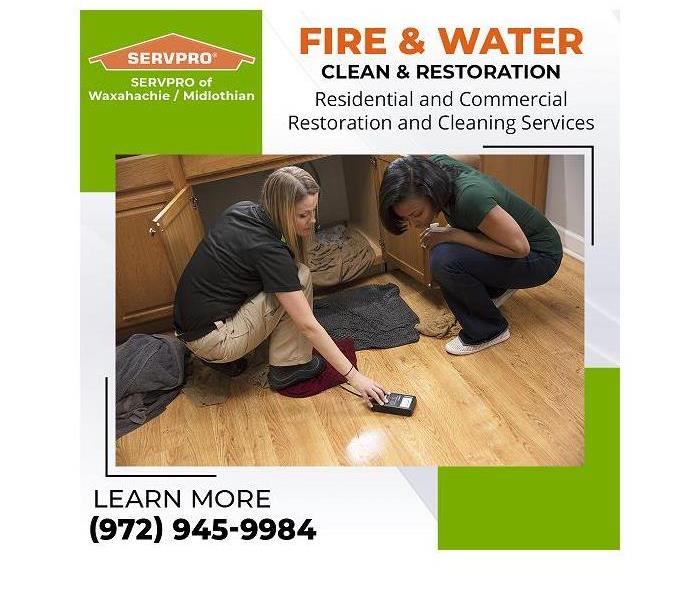 Here to Help
Here to Help
Blog Summary: SERVPRO of Waxahachie/Midlothian provides advice on dealing with water damage in the garage.
Water damage, fire damage, or other property damage disaster can strike at any time, causing stress and worry. SERVPRO of Waxahachie/Midlothian is the best choice for cleanup and restoration. The team’s arrival on the scene sends worry and stress packing.
Storage spaces in the home are susceptible to water damage. The damage can be severe because the leak often goes unnoticed for weeks or months. The unaddressed damage can lead to advanced secondary water damage, including mold infestation and structural damage to the affected areas. By the time the problem is discovered, floors, walls, and the stored items themselves have suffered extensive damage. The garage is a case in point.
For most homes in the Dallas area, the garage is the largest storage area found in the home. This space is versatile and can serve as a storage area, a home gym, an office, or a DIY working area. The garage does not receive the careful attention paid to the inside living spaces and is often overlooked when it comes to water intrusion and the damage it can cause. Yet, the cost of water damage in the garage and the impact on people’s health can be serious.
How to Identify a Water Leak in the Garage
Water leaks can cause a wide range of problems in the garage. Locating the source of the water is often complicated and confusing for the homeowner. Water can travel a great distance from its origin point to its final destination. Only a thorough inspection of the garage can turn up the source of the water. Here are some tips on spotting water leaks in the garage.
Search for cracks, crevices, and holes
Water can find its way into the garage through small holes and cracks. Crevices in the concrete function like veins that enable water to flow into the garage. Because concrete is naturally porous, cracks and holes may develop at any time. In some instances, insects can be the origin of these holes. These tiny holes in the garage become the point of entry for water. Homeowners should be aware that garages built below grade have walls that are more vulnerable to water pressure from the ground. Other potential entry points for garage water intrusion include pipes, electrical wiring, and cables that enter the garage through concrete or wood walls.
Pro Tip: Leaks can be prevented or stopped by sealing around pipes, wiring, and cables. Visible holes and cracks can be patched with hydraulic cement from the local hardware store. When water damage occurs in the garage, the professionals at SERVPRO of Waxahachie/Midlothian can restore and repair the areas damaged by water, including the reconstruction and repair needed to prevent further water damage.
Check gutters and downspouts
Gutters and downspouts are designed to capture water and direct it away from the foundation of a structure. If the ground does not adequately slope away from the garage, water can seep in and cause damage. Clogged gutters can overflow and deposit the water very close to the foundation. Even if the ground is well sloped, it can become too saturated, allowing water to seep through the foundation and into the structure, including into the garage.
Pro Tip: Keep gutters and downspouts unclogged. Extend the downspouts at least six feet away from the foundation. Some recommendations are that the slope away from the foundation should be six inches over ten feet.
Check the roof
Damaged shingles and flashing can allow water to leak into a garage. If the intrusion is hidden within a wall, the damage could result in mold infestation, wood rot, and damage to personal belongings. In some garages, the walls are hidden behind layers of stacked boxes, so a water leak and water damage may go undetected for years. The only clue to water damage may be the musty smell of a mold infestation. Finding and stopping the leak is the first step. Reconstructing portions of the damaged garage structure may be the next step after any mold issues have been resolved.
Pro Tip: Periodically inspect the roof for damage, especially after severe weather. Look for any signs of damage. Conduct a visual check of the ceiling and walls in the garage and the attic area above the garage. Wet spots, warping, and a moldy smell may indicate a water leak and some damage. Professional help may be needed to resolve any leaks and to repair the damage.
Inspect other potential leak points
Inspect joint seams. Seams that connect walls to the doors and windows are susceptible to leaks. The sill plate connecting walls to the concrete walls, foundation, and slabs can also invite water leaks.
Assess the humidity and condensation levels of the garage or any rooms or storage areas in the garage. A high level of humidity and condensation is a prime breeding area for mold. Mold thrives in warm, dark, and moist areas. Homeowners who suspect humidity and condensation issues anywhere in the home should contact the professionals at SERVPRO of Waxahachie/Midlothian who have the experience and technology to accurately diagnose any problems.
Pro Tip: Protect against water damage to belongings stored in the garage. Anticipate a worst-case scenario and take preventive measures.
- Employ shelving that keeps belongings from resting directly on the floor.
- Store items in waterproof containers.
- Seal the garage door to prevent flooding during severe weather from entering the storage area.
- Store items as far away from potential water sources as possible, including doors and windows.
Regular inspection and maintenance are the best strategies to prevent water damage in the garage. If water damage is discovered, look for mold damage, too.
SERVPRO of Waxahachie/Midlothian has been serving the Dallas/Fort Worth area since 2000. Being a local company, they are within a thirty-minute drive or less of any location in the community. Their specialties include residential, commercial, and large-scale disaster cleanup and restoration. Whether the disaster involves fire damage, smoke damage, or water damage to a garage, they have the expertise and experience needed to clean up and restore the damaged property.
For more information about water damage restoration in Waxahachie and Midlothian and other services, contact the office by phone at (972) 935-0827 or email acarey@SERVPRO10932.com.
Water Damage Restoration Company Explains How to Spot Hidden Water Damage
10/9/2020 (Permalink)
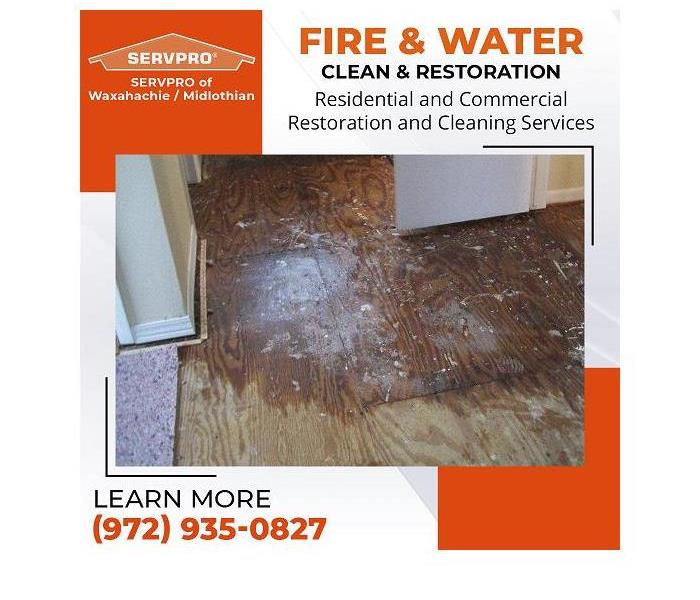 Here to Help
Here to Help
Summary: SERVPRO of Waxahachie/Midlothian offers tips on how to spot hidden water damage in a home or business.
The team of water damage restoration professionals at SERVPRO of Waxahachie/Midlothian understands how hidden water damage can lead to serious health problems and structural and cosmetic damage to a home or business. The consequences result in the need for extensive water damage restoration and, most likely, mold damage remediation. By the time the signs of a leak are noticed, the water damage has already occurred. A trained and vigilant eye, ear, and nose can detect signs of a water leak hopefully before too much damage has been done.
The Many Sources of Water Leaks
Understanding where some of the potential sources of hidden water leaks are will help the homeowner to spot signs of water damage. A typical home may contain dozens of possible leak points. Keeping a vigilant watch on these leak points can save thousands of dollars in water damage restoration and doctors’ bills.
Major Appliances Are Often a Source of Hidden Water Leaks
Five of the most common sources of water damage are:
- Washing machine
- Refrigerator
- Ice maker
- Dishwasher
- Garbage disposal
The Cumulative Effect of a Drop of Water
When a washing machine supply line ruptures, detection is almost instantaneous unless no one is at home to witness the disaster. As much as eight gallons of water a minute can flood into the laundry room. However, when a hot water connection leaks at one drop per second, over six gallons of water a day drip between the wall where the plumbing connections are located. Imagine the cascading impact of a leaking connection to the faucet in the kitchen, to the dishwasher, or to the ice maker. Slowly but surely, the damage compounds over time, rotting out the floor and causing a mold disaster under the sink, between the walls, and in the crawl space under the house.
The Mystery of the Leaking Fridge
The ice maker connection can create a major water damage incident if it bursts. When the line leaks unseen under the flooring is when real havoc can ensue. A partial leak could allow the ice maker to continue to function at a rate that appears to be normal while discharging several gallons a minute into the crawl space. When water is discovered coming from under the refrigerator, check the ice maker connection.
Usually, when a refrigerator leaks, the cause relates to a faulty seal. The faulty seal allows cold air to escape, causing the refrigerator to work overtime and producing more condensation on the coils than the system can eliminate. Fixing or replacing the seal can remedy the overproduction of condensation, which ends the pesky puddle of water on the floor. Adjust the refrigerator so that it tilts backward slightly, and the doors stay closed.
Nightmare in the Bathroom
Like clockwork, the bathroom daily fills with moisture. Condensation covers the floors, walls, mirrors, cabinets, and countertops. After an hour or two, the condensation mostly evaporates. The bathroom is a breeding ground for mold growth, and the battle against mildew is constant.
The tub and shower are prime suspects for hidden water damage. The tub and shower drains can leak for years without discovery, causing the floor to rot and creating a mold nightmare under the tub or shower and in the insulation and crawl space under the tub. One of the only ways to detect the leak is to crawl under the house, inspect the drain connections, test the insulation for moisture, and check for mold growth.
A hidden leak around the toilet can create an unsafe, unsanitary, and moldy mess. A tank that frequently recycles may give some hint of a leak in the system. There are occasional news reports about people falling through their bathroom floor due to water damage.
Five Key Signs of Hidden Water Damage
Hidden water leaks are all but impossible to detect until the damage is evident to the eyes, the nose, or the ears. Evidence of water damage includes the following signs:
- Musty odors
- Stains and discoloration on the ceilings, walls, baseboards, and floors
- Peeling paint and wallpaper
- Warping or buckling ceilings, walls, baseboards, and floors
- Visible mold
Vigilance Made Easy
These tips will help property owners remain vigilant without stressing over hidden water damage disasters.
- Look: Know where leaks are most likely to occur and keep an eye out. Review the five signs of water damage occasionally.
- Listen: In those moments when the house is calm and quiet, listen. Is there a dripping sound behind a wall, under a sink, or under the house?
- Sniff: Do a sniff test when returning home after being away for a while. The nose can become accustomed to persistent smells after extended exposure.
Turn to the Trusted Pros
If a suspicion arises that hidden water damage has occurred, reach out to the water damage specialists at SERVPRO of Waxahachie/Midlothian. They have advanced technology to locate the source of the water damage. Specially trained and certified technicians using the latest equipment can tackle any size water damage incident. Hidden water damage and mold infestation often go hand in hand. The mold mitigation professionals will apply safe, proprietary cleaning solutions, and they will use the latest mold mitigation equipment. SERVPRO of Waxahachie/Midlothian can handle all demolitions, repairs, and rebuilds. They also proactively coordinate with the insurance company so that the water damage restoration project can begin immediately and finish soon.
For more information about the Waxahachie water damage restoration company, contact the SERVPRO of Waxahachie/Midlothian office by phone at (972) 935-0827 or email acarey@SERVPRO10932.com.
How Animals in the Attic Can Cause a House Fire
9/2/2020 (Permalink)
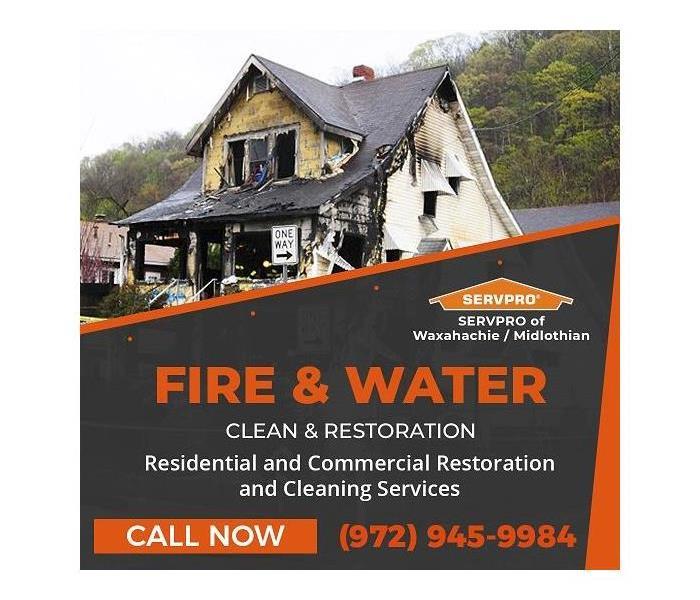 Here to Help
Here to Help
Summary: SERVPRO of Waxahachie/Midlothian cautions homeowners about animals that can cause house fires.
The team at SERVPRO of Waxahachie/Midlothian is highly experienced at providing fire damage restoration for homes and businesses. A commonly overlooked cause of fires is rodents. Squirrels, rats, and other small pests can gnaw at electrical wiring, exposing live wires. Property owners may not realize the unseen structural damage and dangerous conditions that rodents can create in the attic, crawl space, and walls of a home, business, or other structure.
Uninvited Intruders
Rats, mice, and squirrels are the most common uninvited intruders. Generations of squirrels may populate an attic or crawl space. Other “guests” include raccoons, chipmunks, bats, and flying squirrels. Groundhogs, possums, and skunks can present challenges, too. Bird infestations in the attic are not so common, but they do occur.
A Nighttime Nuisance
Rodents and other animals can be a nuisance when they find or make a way into a home. They keep the family awake by scurrying in the walls and in the ceiling and attic during the night. Small children can be disturbed from sleep at night or from an important afternoon nap during the day. Some of the noises, fighting, and gnawing can be frightening to residents.
Unsanitary Guests
Rats and mice raid food stores in the pantry, on shelves, and in cabinets. The food contaminated by their body fluids and feces is ruined and should be immediately discarded. If left to roam and reproduce, the unwanted guests can quickly create more and more inhabitants that contribute to the problem.
Demolition Experts
Rats, mice, squirrels, and chipmunks have teeth that continue to grow throughout their lifespan. Much like fingernails that always need clipping, a rodent’s teeth need to be constantly gnawing and chewing to keep the teeth growth in check. Rodents that are unable to constantly chew or gnaw will grow teeth so long that eating becomes impossible. As a result, the creatures will starve to death.
This constant need to gnaw means that a nest of squirrels, a pack of mice or rats, or a family of raccoons can very quickly damage personal belongings, chew through support beams, gnaw insulation to pieces, pierce pipes and tubing, and even cut through electrical wiring with their razor-sharp incisors. Compared to metal pipes, which rodents sometimes chew, a strand of wire coated with softer insulation is a delicacy.
Shocking Results
Plugging a hole in the eaves of the roof, sealing cracks in the foundation, or repairing the obvious damage to gnawed timbers or shredded insulation is manageable for the homeowner or the critter control specialist.
On the other hand, locating gnawed wiring may be virtually impossible due to the inaccessibility of much of the wire behind walls, under insulation in the attic, or concealed under the home in the crawl space. The observant homeowner may find some evidence of wiring that has been gnawed or chewed. Of course, the wiring issue should be repaired. The larger question relates to wiring throughout the remainder of the home. Without inspecting every inch of wiring, the results could be shocking!
How a Fire Starts
Electrical wiring can become hot when electricity is flowing through it. The plastic insulation prevents the heat in the wire from igniting nearby objects. When a rat or mouse has gnawed away the insulation leaving bare wire, the heat from the wire or a spark from a short circuit can ignite insulation or other debris near the wire. Sometimes, a hot wire resting against a wooden support beam is enough to start a house fire over time.
Solutions That Work
- Eliminate the risk by removing the intruders.
- Identify and seal any actual or potential entry points.
- Contact a certified electrician to inspect the damage and make any electrical repairs.
- Contact a property damage restoration specialist to clean up the mess left by the “guests.”
- Contact the fire and water damage specialists at SERVPRO of Waxahachie/Midlothian in case the worst happens — a fire caused by exposed wires gnawed by a rodent or other uninvited guest. Fire and water damage are traumatic. Securing the services of experienced professionals who know how to handle the incident from initial inspection and assessment to the completion of the restoration project brings much-needed peace of mind.
For more information about biohazard cleanups, fire damage, and water damage, visit the SERVPRO of Waxahachie/Midlothian website at https://www.SERVPROwaxahachiemidlothian.com. The office can be reached by phone at (972) 935-0827.
Damage Restoration Company Shares Grill Safety Tips for Summer Cookouts
8/3/2020 (Permalink)
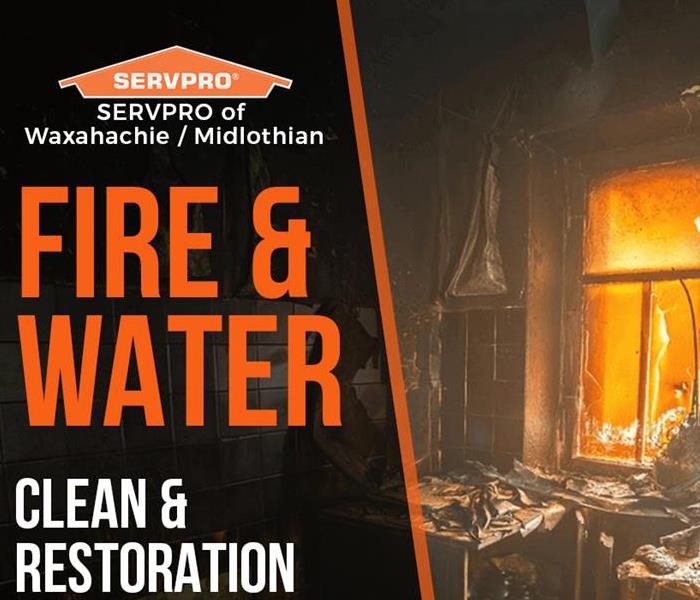 Here to Help
Here to Help
Summary: SERVPRO of Waxahachie/Midlothian offers grill safety tips for the backyard barbecue.
The summer of 2020 is different from other summers. COVID-19 has created somewhat of a meat shortage and higher prices at the grocery store. Restaurants are feeling the brunt of higher prices and limited hours and seating. In their quest for a bite of great Texas beef and BBQ, homeowners are firing up the grill and cooking at home. In pursuit of taste and convenience, backyard grill masters are purchasing both a charcoal grill for flavor and a gas grill for convenience and functionality. According to the Hearth, Patio & Barbecue Association, 64% of households own a gas grill, 44% own a charcoal grill, and 9% own an electric grill.
With more grills and more grilling, the frequency of grill-caused fires increases. From 2013-2017, grills caused an annual average of 10,200 home fires, according to the National Fire Protection Association. Gas grills cause more home fires than charcoal grills.
Outdoor chefs can prevent fire damage this summer and fall by following these grilling safety tips.
- Grill outside in a well-ventilated area away from the house or any other structures.
Gas and charcoal grills are designed for outdoor use only. According to the NFPA, 27% of residential fires caused by outdoor grills began in a terrace, courtyard, or patio, and 29% of residential fires caused by outdoor grills were ignited on an exterior balcony or open porch.
Pay close attention to overhanging tree branches when setting up the grill. Catching a neighbor’s home on fire or starting a wildfire could be very costly.
- Ensure the cleanliness and stability of the grill. A clean grill is a safe grill. Remove grease from both the grill and the tray below the grill. When using a charcoal grill, allow the coals to completely cool before disposing of them in a metal container.
Set up the grill on a flat, stable surface where it cannot be overturned. Protect the grill or patio by using a grill pad or splatter mat underneath the grill to protect the deck or patio.
- Inspect the propane tank hose for leaks on the gas grill. At the first of the season, check the hose for leaks. Apply soapy water to the hose and then turn on the gas. Bubbles indicate a leak. A flame that will not light or gas smells may be indications of a leak.
- If the flame goes out, do not re-light for five minutes. Turn the grill and the gas off. Wait for about five minutes. Re-ignite the grill.
- Be careful, especially close to the grill. A lit grill should always have a watchful eye on it. Children or pets should not play near the grill. Allow a grill time to cool for at least an hour after use, and wait until the grill cools to move it.
- Use caution when applying charcoal starter fluid. Only use charcoal starter fluid since it resists flare-ups. If the flame begins to die down, do not apply more starter fluid. Flammable liquids such as gasoline are hazardous and should never be used to start charcoal on a grill. Do not use an aerosol spray as a torch to start or restart the pile of briquettes. A charcoal chimney starter is very safe and uses newspaper to start the fire instead of starter fluid.
- Wear fire-safe clothing when around a grill or other source of an open fire.
Clothing can readily ignite. Make sure sleeves, shirttails, and apron strings are not exposed to the open flame of the grill.
Conclusion
Backyard grilling creates culinary memories with friends and family that are not soon forgotten. Always have the means to extinguish the grill or a fire caused by the grill. A bucket of sand, a water hose, and a fire extinguisher are recommended to have nearby in case of fire. Remember, a grease fire is neutralized by baking soda, not water. Never use water on a grease fire.
These easy-to-follow tips will keep everyone safe when grilling out. SERVPRO of Waxahachie/Midlothian encourages everyone to enjoy the summer barbecuing season. Stay safe and stay healthy!
For more information about property damage restoration near Waxahachie and Midlothian, TX, visit the SERVPRO of Waxahachie/Midlothian website at https://www.SERVPROwaxahachiemidlothian.com. Contact the office by phone at (972) 935-0827.
Waxahachie/Midlothian Damage Restoration Company Offers Fireworks Safety Tips
6/30/2020 (Permalink)
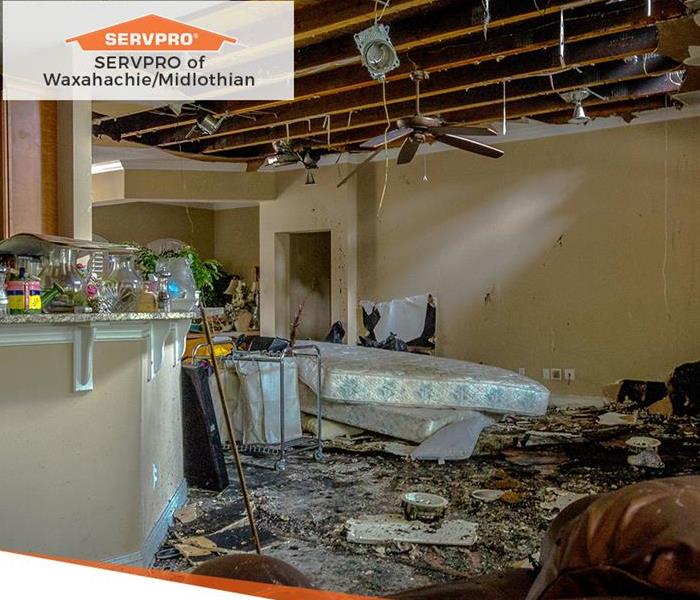 Here to Help
Here to Help
Summary: SERVPRO of Waxahachie/Midlothian urges people to use caution when setting off fireworks for the Fourth of July.
Fourth of July celebrations that include fireworks is an enduring American tradition. SERVPRO of Waxahachie/Midlothian, a fire damage restoration company, urges caution for residents of Waxahachie, Texas, and the surrounding communities of Midlothian, Venus, Maypearl, Mountain Peak, and Ward when enjoying this tradition.
Fireworks Can Be Dangerous
The National Fire Protection Association provides the following fireworks fire and injury statistics to drive home the potential danger that can arise from improperly handling fireworks.
“Fireworks started an estimated 19,500 fires in 2018, including 1,900 structure fires, 500 vehicle fires, and 17,100 outside and other fires. These fires caused five deaths, 46 civilian injuries, and $105 million in direct property damage. In 2018, U.S. hospital emergency rooms treated an estimated 9,100 people for fireworks-related injuries; half of those injuries were to the extremities and 34% were to the eye or other parts of the head. Children younger than 15 years of age accounted for more than one-third (36%) of the estimated 2018 injuries. These injury estimates were obtained or derived from the U.S. Consumer Product Safety Commission’s 2018 Fireworks Annual Report by Yongling Tu and Jason Ng.”
How to Stay Safe When Using Fireworks
The Texas Department of Insurance offers these fireworks safety tips to know to have fun with fireworks and stay safe.
- Follow local laws.
Some places allow only certain types of fireworks, and most areas do not allow fireworks within city limits or during burn bans. Contact the local fire officials if there are any questions.
- Find out if a permit is required.
Organizers will need a permit from the local fire department if they are putting on a fireworks show for a group of fifty people or larger.
- Hire licensed professionals.
If someone is hired to put on a display for a group, they must have a Texas pyrotechnic operator’s license. To find out if someone has a Texas license, contact the State Fire Marshal’s Office, which can be reached at 1-800-578-4677 or Fire.Marshal@tdi.texas.gov.
- Confirm that fireworks are legal.
Fireworks can be sold only at certain times of the year, typically during a week or so leading up to an important holiday. Besides the Fourth of July and New Year’s, Texas counties have the option to include Texas Independence Day (March 2nd), San Jacinto Day (April 21st), Cinco de Mayo (May 5th), and Memorial Day. Anyone can use fireworks any day of the year as long as they are not banned in the area where they are being used.
- Stay safe!
- Children should not use fireworks, and an adult should always be present when children are near a fireworks display.
- Alcohol and fireworks are a recipe for an emergency room trip.
- Always follow the firework instructions exactly.
- Never shoot fireworks around dry grass, brush, or other flammable materials.
- Never aim fireworks at a home, animal, or person.
- Keep a bucket of water, garden hose, or other water sources nearby for emergencies.
SERVPRO of Waxahachie/Midlothian provides these fireworks safety tips as a public service to the residents of West Fort Worth in the hopes that everyone will have an enjoyable, safe, and patriotic July 4th.
Fire and Water Damage Restoration Process
When a home or business is dealing with the aftermath of a fire, the damage that it can cause to the property structure and valuable possessions can be extremely devastating. Here at SERVPRO, the team understands the stress, confusion, and emotions that are present when dealing with this kind of ordeal. The SERVPRO technicians are highly skilled and certified, as well as equipped with fire damage restoration equipment to take special care of the client’s property and possessions. The SERVPRO team will be there with the customer every step along the way to explain the process to help get them through this stressful time.
After the fire trucks leave, the home or business likely suffers from fire and smoke damage and extensive water damage from firefighting efforts. SERVPRO has the specialized fire restoration training needed to restore a home to its pre-fire conditions.
Every fire damage event requires an individualized solution, but the general process stays the same. The steps listed below illustrate the process for the typical fire damage emergency.
Step 1: Emergency contact
Step 2: Inspection and fire damage assessment
Step 3: Immediate board-up and roof-tarp service
Step 4: Water removal and drying (if water damage is present)
Step 5: Removal of smoke and soot from all surfaces
Step 6: Cleaning and sanitizing
Step 7: Restoration
Conclusion
SERVPRO of Waxahachie/Midlothian hopes that everyone has a July 4th celebration that is safe, enjoyable, and fire-free. The team of fire and water damage experts is proud to serve the local communities of Waxahachie, Midlothian, Venus, Maypearl, Mountain Peak, and Ward.
To learn more about fire and water damage restoration, visit the SERVPRO of Waxahachie/Midlothian website at https://www.SERVPROwaxahachiemidlothian.com. Contact a SERVPRO representative by phone at (972) 935-0827.
Waxahachie Company Restores Water-Damaged Property
6/1/2020 (Permalink)
 Here to Help
Here to Help
Summary: SERVPRO of Waxahachie/Midlothian restores water-damaged property with advanced technology.
According to Water University, a resource of Texas A&M University, “Healthy landscapes offer a variety of advantages for the home. They not only add aesthetic value but can also provide erosion protection, temperature control and serve as usable outdoor space for relaxing and entertaining. Oftentimes however, North Texas landscapes can be overwatered, over-fertilized or over-saturated with pesticides, which can be detrimental to water resources and your landscape. The EPA estimates that in dry climates like that of North Texas, a household’s outdoor water use can exceed the amount of water used for all other residential purposes! In some households, during summer, as much as 60% of a total water budget could be spent on landscape irrigation. By incorporating irrigation best management practices and by selecting the right plant material for your specific needs, you have the potential to drastically reduce water and chemical use in your landscape.”
After Jen read this article from Water University, she determined to capture the water from the HVAC system in a barrel and use it to irrigate her culinary herb garden. The water was perfect for the herbs because it would be pure. The twenty-plus gallons per day produced by a central HVAC system would be more than enough to water the thirsty herbs.
Meanwhile, Jen’s husband David had been wondering how to manage the water from the new HVAC system that was going to be installed next week. Most new systems tap into the existing drain system, but this additional water would increase the water and sewer bill. Besides, during the winter, when the condensate drainpipe was empty, noxious gases could enter the home from the sewer or septic tank. The float switch or the condensate pump could malfunction, causing severe water damage and mold if not caught very quickly. David had read of homeowners being on vacation for weeks only to return to ceilings, walls, floors, and carpets damaged by the HVAC drip pan leaking or overflowing.
When David heard about Jen’s idea, he was thrilled. He would install a float switch on the drain pan to turn off the unit in case of a clogged pipe, and the couple could enjoy the water from the HVAC system every time herbs and spices were harvested from the garden.
Why Choose SERVPRO of Waxahachie/Midlothian?
By the time that water damage from an overflowing HVAC drip pan is discovered, hundreds of gallons of water may have leaked all through the home, causing thousands of dollars in damage to the ceilings, walls, and flooring. Mold and mildew are likely involved.
When a Waxahachie home has water damage from flooding or leaks, homeowners need a water damage restoration company that can respond immediately and has the expertise and equipment to properly restore the property. SERVPRO of Waxahachie/Midlothian uses advanced water damage inspection and extraction equipment to help locate the moisture and remove it as quickly as possible. Cutting-edge drying equipment and proven techniques help restore a home more quickly and minimize cost. SERVPRO uses equipment that helps detect hidden moisture and extract standing water quickly and efficiently. Utilizing professional-strength cleaning, sanitizing, and deodorizing products brings comfort and safety to homeowners. The highly-trained technicians monitor and document the drying process so that homeowners can be certain the property is back to normal. Following the Water Damage Tips provided by SERVPRO protects both property and the property owner and family.
The Water Damage Restoration Process
Since every flood and water damage scenario is a little different, each one requires a unique solution tailored to the specific situation. However, the overall water restoration process remains the same. The steps below detail the restoration process for the typical water-damaged property.
Step 1: Emergency Contact
Step 2: Inspection and Damage Assessment
Step 3: Water Removal/Water Extraction
Step 4: Drying and Dehumidification
Step 5: Cleaning and Repair
Step 6: Restoration
Conclusion
With emergency 24-hour service, highly trained staff, and advanced inspection, extraction, removal, and drying technology and equipment, SERVPRO of Waxahachie/Midlothian is the best choice. The company is proud to serve local communities, including Waxahachie, Midlothian, Venus, Maypearl, Mountain Peak, Ward, and Ellis County.
To learn more about water damage restoration resulting from an HVAC leak or any other source, visit the SERVPRO Waxahachie/Midlothian website at https://www.SERVPROwaxahachiemidlothian.com. To speak with a SERVPRO representative, call (972) 935-0827.
Faster to your Ellis County Water Damage Event
4/16/2020 (Permalink)
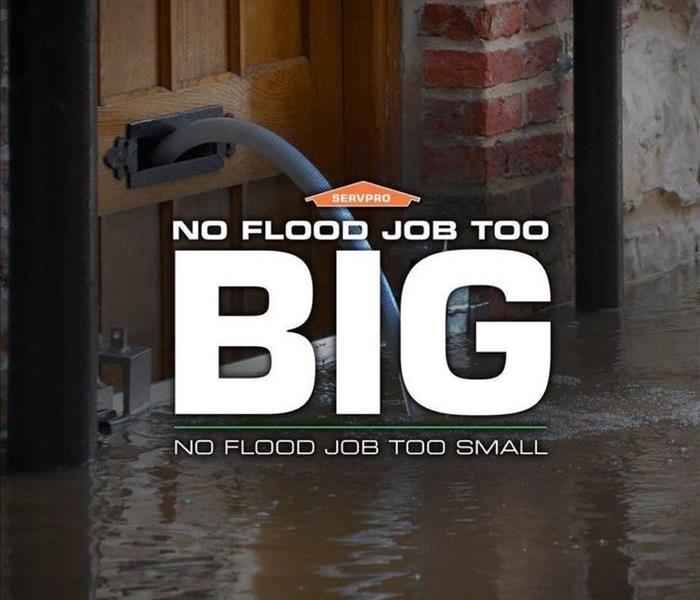 SERVPRO of Waxahachie/Midlothian provides 24 hour fire and water damage restoration service in Ellis County.
SERVPRO of Waxahachie/Midlothian provides 24 hour fire and water damage restoration service in Ellis County.
Flooding and water emergencies can happen at any time -- they don’t wait for regular business hours and neither do we. SERVPRO of Waxahachie/Midlothian is ready to respond to your water emergency 24 hours a day, 7 days a week—including all holidays.
Faster To Any Size Disaster
When you have a flood or water leak, water quickly spreads throughout your home and gets absorbed into floors, walls, furniture, and more. It is imperative to have a water mitigation specialist, such as SERVPRO of Waxahachie/Midlothian, arrive quickly and start the water extraction process almost immediately. This immediate response helps to minimize damage and cleaning and restoration costs.
Need Emergency Service? Call Us 24/7 – SERVPRO of Waxahachie/Midlothian 972-935-0827
Water Damage Timeline
Within Minutes
- Water quickly spreads throughout your property, saturating everything in its path.
- Water is absorbed into walls, floors, upholstery, and belongings.
- Furniture finishes may bleed, causing permanent staining on carpets.
- Photographs, books, and other paper goods start to swell and warp.
Hours 1 - 24:
- Drywall begins to swell and break down.
- Metal surfaces begin to tarnish.
- Furniture begins to swell and crack.
- Dyes and inks from cloth and paper goods spread and stain.
- A musty odor appears.
48 Hours to 1 Week:
- Mold and mildew may grow and spread.
- Doors, windows, and studs swell and warp.
- Metal begins to rust and corrode.
- Furniture warps and shows signs of mold.
- Paint begins to blister.
- Wood flooring swells and warps.
- Serious biohazard contamination is possible.
More Than 1 Week:
- Restoration time and cost increase dramatically; replacing contaminated materials and structural rebuilding may be extensive.
- Structural safety, mold growth, and biohazard contaminants pose serious risks to occupants.
About SERVPRO of Waxahachie/Midlothian
SERVPRO of Waxahachie/Midlothian specializes in the cleanup and restoration of residential and commercial property after a fire, smoke or water damage event. We are located in the heart of Ellis County, where we can reach your emergency in Waxahachie, Midlothian, Red Oak, Glenn Heights, Ennis, Corsicana, or any other Ellis County city within an hour. Our staff is highly trained in property damage restoration. From initial and ongoing training at SERVPRO’s corporate training facility to regular IICRC-industry certification, rest assured our staff is equipped with the knowledge to restore your property.
Certifications
ASD - Applied Structural Drying Technician
ECTP - Employee Certification Training Program
IICRC Certified Firm
RRRP - Lead-Based Paint Activities and Renovation
WRT - Water Damage Restoration Technician
Does Your Waxahachie Home Have A Mold Problem?
4/3/2020 (Permalink)
Microscopic mold spores naturally occur almost everywhere, both outdoors and indoors. This makes it impossible to remove all mold from a home or business. Therefore, mold remediation reduces the mold spore count back to its natural or baseline level. Some restoration businesses advertise “mold removal” and even guarantee to remove all mold, which is a fallacy. Consider the following mold facts:
- Mold is present almost everywhere, indoors and outdoors.
- Mold spores are microscopic and float along in the air and may enter your home through windows, doors, or AC/heating systems or even hitch a ride indoors on your clothing or a pet.
- Mold spores thrive on moisture. Mold spores can quickly grow into colonies when exposed to water. These colonies may produce allergens and irritants.
- Before mold remediation can begin, any sources of water or moisture must be addressed. Otherwise, the mold may return.
- Mold often produces a strong, musty odor and can lead you to possible mold problem areas.
- Even higher-than-normal indoor humidity can support mold growth. Keep indoor humidity below 45 percent.
If your home or business has a mold problem, we can inspect and assess your property and use our specialized training, equipment, and expertise to remediate your mold infestation.
If You See Signs of Mold, Call Us Today – 972-935-0827
We Are Cleaning Professionals
4/3/2020 (Permalink)
 We appreciate the opportunity to provide complementary vehicle disinfection to our First Responders
We appreciate the opportunity to provide complementary vehicle disinfection to our First Responders
SERVPRO of Waxahachie/Midlothian is Here to Help during this time of need
During this unprecedented time caused by the global coronavirus pandemic, be assured that we are specialists in cleaning services, and we adhere to the highest cleaning and sanitation standards.
We are receiving calls daily from concerned business owners who want to make sure they are providing a safe environment for their workers and their customers. We are ready to respond quickly.
Specialized Training
We clean and disinfect your home or business, according to protocols set forth by the Centers for Disease Control and Prevention. We have years of experience in dealing with biological contaminants, and we go beyond the scope of daily work performed by regular janitorial staff.
The CDC encourages cleaning of high-touch surfaces. These may include counters, tabletops, doorknobs, light switches, bathroom fixtures, toilets, phones, keyboards, tablets and tables. Other spaces mentioned in the CDC’s guidance for commercial spaces include:
- Kitchen/Food Areas
- Bathrooms
- Schools/Classrooms
- Offices
- Retail Spaces
- Water Fountains
- Shelving/Racks
- Sales Counters
- Carpets and Rugs
- Stair Handrails
- Elevator Cars
- Playground Equipment
- Fitness Equipment
Specialized Products
The CDC recommends the use of a labeled hospital-grade disinfectant with claims against similar pathogens to the coronavirus. Multiple products in the SERVPRO product line carry the EPA-approved emerging pathogens claims. While there is currently no product tested against this particular strain of the coronavirus, we are following all guidelines as provided by the CDC and local authorities.
Call Today for a Proactive Cleaning
If your home or business needs deep cleaning services, call the experts today – SERVPRO of Waxahachie/Midlothian, 972-935-0827.
Sources:
https://www.cdc.gov/coronavirus/2019-ncov/hcp/guidance-prevent-spread.html?CDC_AA_refVal=https%3A%2F%2Fwww.cdc.gov%2Fcoronavirus%2F2019-ncov%2Fguidance-prevent-spread.html
https://www.cdc.gov/coronavirus/2019-ncov/specific-groups/guidance-business-response.html
IICRC Certified Firm
4/2/2020 (Permalink)
SERVPRO of Waxahachie/Midlothian is an IICRC firm. The Institute of Inspection, Cleaning and Restoration Certification (IICRC) creates the standards for the restoration industry and provides training and certification to restoration companies. IICRC Certified Firms have the right to display the IICRC Certified Logo.
IICRC Certified Firms must
• Present accurate information to consumers and conduct business with honesty and integrity.
• Require a technician on all jobs who has been formally trained and passed all required tests.
• Require a continuing education program to keep technicians up-to-date on the latest changes in the industry.
• Maintain liability insurance to protect all parties in the event of an accident.
• Maintain a written complaint policy and agree to Better Business Bureau or similar arbitration to resolve disputes, and accept the conclusions and recommendations of arbitration.
The IICRC Develops The Standards For The Restoration Industry
The IICRC has been the driving force in establishing the main industry standards and reference guides for professional carpet cleaning, water damage restoration and mold remediation. These IICRC standards take years to develop and require the coordination of experts in the field: manufacturers, industry organizations, insurance professionals, training schools, contractors, and public health professionals.
Every five years, the standards are reviewed and updated. The water damage restoration field changes rapidly with advancements in technology and science, and therefore the standards must evolve to keep pace.
About SERVPRO of Waxahachie/Midlothian
SERVPRO of Waxahachie/Midlothian specializes in the cleanup and restoration of residential and commercial property after a fire, smoke or water damage event. Our staff is highly trained in property damage restoration and we are an IICRC Certified Firm. We believe in continuous training: from initial and ongoing training at SERVPRO’s corporate training facility to regular IICRC-industry certification, rest assured our staff is equipped with the knowledge to restore your property.
Call us for your next cleanup and restoration project. 972-935-0827
Can I Dry My Home Flood Myself?
4/1/2020 (Permalink)
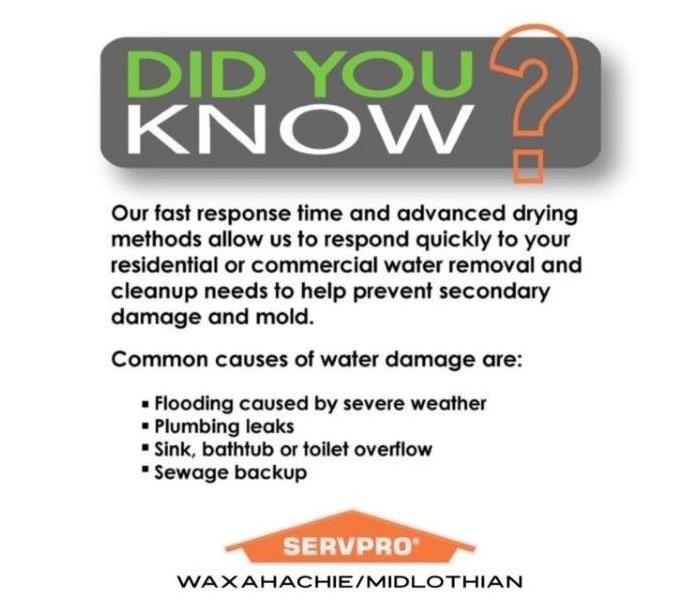 Our fast response time can save our customers from unneeded worry and potential secondary damage.
Our fast response time can save our customers from unneeded worry and potential secondary damage.
My bathroom has flooded! Can I clean it up myself?
Flood waters in the home often originate from plumbing in bathrooms (a broken pipe, clogged toilet, leaky shower enclosure) or kitchen areas (leak under sinks, dishwasher overflows, drain backup). When this happens, It might be tempting to mop the water up and put a fan or two on the wet area until it appears to be dry. No big deal, right? No - this approach can lead to more problems down the road.
You should always contact a professional, such as those at SERVPRO of Waxahachie/Midlothian and SERVPRO of Ennis/Red Oak to assist in the cleanup of a residential flood - to protect your family's health and to prevent further damage to your home. The professional will assess the quality of the water that flooded your home and the class of the water loss.
There are several questions to ask when a flood has occurred. First, what is the source of the water and what contaminants have been introduced into the flood waters? This will determine the quality of the water and affect many decisions in the drying process. Next, how long has water stood in the area and to what extent have structures and contents become saturated? This will determine the class of the water loss and influence decisions about what can be dried and what will be disposed of. And finally, how will you know when the area is truly dry, not just visibly, but inside walls, under carpets and pads, and throughout materials in the area? This is imperative in preventing further damage through subsequent deterioration and possible mold growth.
This article is limited to the first question above. It explains the importance of understanding the three quality of flood waters and how that determination affects decisions about the drying and cleanup process.
Understanding Quality of Water
There are three categories of water that can result in a residential flood - for example, from a toilet.
Category 1 (clean water) originates from a sanitary source. It poses no health risk when it comes into contact with skin, is ingested, or is inhaled. In the toilet leak example, if the water comes from the pipe behind the toilet, before the water has entered the toilet tank, it is originally Category 1 water. It is important to note the cleanliness of Category 1 water can deteriorate to Category 2 or 3 when coming into contact with other materials in the environment.
Category 2 (grey water) contains significant contamination and has the potential to cause discomfort or sickness if contacted or consumed by humans.
Category 3 ( black water) is grossly contaminated and can contain pathogenic, toxigenic, or other harmful agents. Such water may carry silt, organic matter, pesticides, heavy metals, regulated materials, or toxic organic substances. In the toilet example, toilet backflows that originate from beyond the toilet trap, regardless of the visible content or color, is considered category three water.
The category determination will greatly impact the way in which you or a professional team will approach the drying and cleanup process.
Class of Water Loss
There are 4 classes of water loss, depending on the magnitude of damage.
Class 1 is when only low-porosity and low-permeability materials in the area are affected. This means materials like linoleum, wood floors and fixtures, and tile.
Class 2 is when the water has affected an entire room or area, or multiple rooms in the house. This includes structures and up to two feet of water seepage up any walls.
Class 3 is when virtually all of the area has been saturated with the overflowing water. Ceilings, insulation, structures, furniture, cushions, carpeting, and more are affected.
Class 4 is when low-porosity, low-permeability materials like concrete, stone, and hardwood are saturated. Since the water can get caught in hard-to-reach pockets, they evaporate more slowly and require special techniques to dry.
Category 1 Cleanup Process
If the water is Category 1, then the focus becomes on extracting the water from the flooded area and placing equipment (fans and dehumidifiers) in the area, and monitoring the moisture in the area, until it can be deemed completely dry. Little emphasis needs to be placed on placing barriers between the wet areas/objects and the persons doing the work of drying things out. However, it should be noted that even the cleanest flood waters should be approached with minimal protective wear, such as rubber gloves. Materials that were affected in the flood, such as wooden trim, drywall, cabinets, carpet or other flooring, and furniture, can be dried out and left in the home for continued use. As long as the items were not structurally damaged to a point which would deem them unsalvageable, there is no need to remove them from the home. That is, they do not pose a health risk.
Category 2 Cleanup Process
When a home flood involves Category 2 water, the persons entering the flooded area must first take precautions to protect themselves from contaminants while working in the area and handling affected materials. Protective equipment such as rubber boots that can be disinfected and rubber gloves will be worn at all times. They might also choose to wear a face mask and googles if the cleanup process is to the extent that moving contents and other actions might cause splashing of flood waters. In this case decisions will be made about materials and items in the affected area based on how porous they are, whether they were saturated with the flooded water, and whether they can be effectively disinfected and left in place after the drying process. For example, where a carpeted area is affected with category 2 water, the carpet can be cleaned, dried, and disinfected; however, the carpet pad beneath must be removed and disposed of. Other hard surfaces can be cleaned, dried, and disinfected, as well.
Category 3 Cleanup Process
Category 3 flood waters pose a high risk of causing illness in persons, so this type of flood requires extreme measures during the cleanup process. This type of flood can be caused by something as common as a clogged toilet over-flowing or a clogged shower drain allowing sewer water to backup into a home. In this case, professional will wear full personal protective equipment. Not only rubber boots that can be disinfected and rubber gloves, but a full disposable body suit that protects skin and clothing from contaminated waters and materials must be worn, as well as a respirator and protective eye googles. They will set up a decontamination area to be used when moving from the contaminated area into the uncontaminated areas of the home. I addition, any porous materials in the area must be removed and disposed of as they will have absorbed pollutants from the contaminated water. That means baseboards and drywall that were saturated with flood waters must be cut out and removed. Carpet and carpet pad must be removed and disposed of. Upholstered furniture that was affected must be disposed of. In other words, an item by item determination will be made as to whether household items can be effectively cleaned and disinfected or if they will be disposed of. Leaving Category 3 contaminated materials or items in the home can pose dangerous health risks to residents.
Leave the Cleanup to the Professionals
You can see why it is best practice to leave the cleanup process after a flood to the professionals, such as those at SERVPRO of Waxahachie, Midlothian, Ennis, Red Oak - serving all of Ellis County. Call us at 972-935-0827. We have the training and experience to determine the level of risk involved with flood waters. We have the trained personnel and professional equipment to quickly extract waters and get the drying process complete in the shortest amount of time, saving you money and reducing the risk of complications from an improperly dried home. We strive to truly make it "Like it never even happened."
Ellis County Smoke and Soot Cleanup
4/1/2020 (Permalink)
Smoke and soot is very invasive and can penetrate various cavities within your home, causing hidden damage and odor. Our smoke damage expertise and experience allows us to inspect and accurately assess the extent of the damage to develop a comprehensive plan of action.
Smoke and soot facts:
- Hot smoke migrates to cooler areas and upper levels of a structure.
- Smoke flows around plumbing systems, seeping through the holes used by pipes to go from floor to floor.
- The type of smoke may greatly affect the restoration process.
Different Types of Smoke
There are two different types of smoke–wet and dry. As a result, there are different types of soot residue after a fire. Before restoration begins, SERVPRO of Waxahachie/Midlothian-Ennis/Red Oak will test the soot to determine which type of smoke damage occurred. The cleaning procedures will then be based on the information identified during pretesting. Here is some additional information:
Wet Smoke – Plastic and Rubber
- Low heat, smoldering, pungent odor, sticky, smeary. Smoke webs are more difficult to clean.
Dry Smoke – Paper and Wood
- Fast burning, high temperatures, heat rises therefore smoke rises.
Protein Fire Residue – Produced by evaporation of material rather than from a fire
- Virtually invisible, discolors paints and varnishes, extreme pungent odor.
Our Fire Damage Restoration Services
Since each smoke and fire damage situation is a little different, each one requires a unique solution tailored for the specific conditions. We have the equipment, expertise, and experience to restore your fire and smoke damage. We will also treat your family with empathy and respect and your property with care.
Have Questions about Fire, Smoke, or Soot Damage?
Call Us Today – 972-935-0827
There's a New Hero in Town
1/9/2020 (Permalink)
 Our newest "Hero."
Our newest "Hero."
We are excited to welcome Erika Preciado, our new Administrative Assistant, to the family of heroes here at SERVPRO of Waxahachie/Midlothian. Erika’s main focus will be on project work flow, from First Notice of Loss to Job Completion.
Erika comes to us with eight years experience in the Restoration industry. She has completed SERVPRO’s Hero-Ready training program. She took and passed SERVPRO’s Crew Training Course; acquired her Water Certification, Fire Certification, and Carpet & Upholstery Certification; and is recognized as a Trained Professional Restorer.
Additionally, she has the Water Damage Restoration Certification from the Institute of Inspection Cleaning and Restoration Certification (IICRC), Subrogation Certification, and Level I Xactimate Certification.
Erika also brings a vast wealth of experience and knowledge in office procedures and policies that help to keep everyday processes running smoothly. Erica's is the first voice of concern our customers hear when they call in need of restoration services. Erika knows how to reassure the customer and get the assessment process started quickly so that we can begin cleanup and restoration as soon as possible. Her experience helps to make sure safety and quality regulations are up to date and adhered to. Erika’s expertise in these areas and with Office Management tools are invaluable in supporting our efforts to serve the Ellis County community with all of its water damage, fire and smoke damage, and other emergency restoration needs.
When Erika isn't busy being a hero at work she loves spending time with her three beautiful children, ages 3, 6, and 11. Helping them with their homework, reading to them, teaching them writing, or just playing games — quality time with her children is her priority.
Ask Erika why she likes working for SERVPRO, and she will tell you, “I love what I do. Every day I learn something new. I get to talk to new people and experience new things when a customer calls with water damage, fire damage, or some other emergency. At the end of the journey, I am satisfied that my company and the brand I represent helped this customer out.”
We are blessed to have such a talented and accomplished member joining our team of professional restoration specialists. We will be even more Hero-Ready to meet your restoration needs and to make your property "Like it never even happened."
Preventing fires in your home
3/10/2019 (Permalink)
SERVPRO of Ellis County is here to assist your rebuild and restoration needs in the event of a fire. We understand that the best course of action for you is to avoid the fire in the first place. It's appropriate to end this string of fire-related blogs with one that you can act upon now, to make your home a safer place and hopefully avoid any fire damage in the future.
If you have any questions or there is a topic not discussed, your local fire department will also have plenty of resources to use to ensure your home is protected.
To talk about what can be done to prevent fires to your house or residence, it’s, of course, important to get a grasp on what the main causes of fires are. Once we know what might be the source of potential fire, we can then delve into the steps you can take to make these sources safer in your everyday life.
Our experience at SERVPRO of Ellis County definitely echos this source that discusses the common causes of house fires. The ones we run into most often include kitchen/cooking fires, electrical fires, and smoking-related. These are things that we use every day, meaning that many times people become complacent with them. Having a general idea of the common causes of house fires, let’s now take a look at the steps to be taken to avoid them.
Kitchen fires, cooking fires, and grease fires are all frequent culprits of fire damage. There are some basic things you can do to minimize the risks when cooking. First and foremost, never leave your food cooking when unattended. It is tempting to go do something else for 5-10 minutes while you let food cook, but this can have unintended consequences when one stray flame causes a fire that you could have extinguished easily, but how now turned into a full-blown kitchen fire.
Similarly, leaving rags, oven mitts, or anything flammable near the stove or oven only serves as fuel for a potential fire. Be sure to always store these items a safe distance from the heat sources in your kitchen.
Finally, all kitchen appliances that rely on electricity should be unplugged when not in use. While it may be a hassle to plug your coffee machine in first thing every morning, this is much preferable to a fire caused by faulty wiring.
In fact, faulty wiring can cause a fire in every room of your house, not just your kitchen. Electricity is an ingrained part of modern life, and it is not realistic to request you unplug every single device in every room when you leave.
However, there are still some useful tips to help minimize the risk your electrical devices have in your home.
First and foremost, those power cords and surge protectors you use to expand the electrical outlet capacity in your home are a large fire hazard. These should be avoided or used sparingly. Ensure that all electrical wires do not run underneath carpet or rugs, are kept away from water, and any possible heat source. Keep an eye on your electrical devices and their associated cords, if anything seems hotter than is typical unplug the device immediately.
Smoking is the other cause of fires that we see often. Not only does this cause fire, but we frequently have customers wanting us to help them remove the smoke smell from a residence. The easiest way to avoid both of these is to simply smoke outside. The weather may not be the best, but temporary discomfort is much preferable to the long and arduous process of dealing with fire damage.
Your home has a plethora of flammable items that a stray cigarette can quickly ignite. Whether or not you are inside when you choose to smoke, ensure that the cigarette is completely out before disposing of it.
This is a huge cause of smoke-related fires, someone thinking the cigarette is out when there are still embers to ignite other materials. The way to prevent this is to always use an ashtray, and be thorough when putting your cigarette out, to the extent that you can pour water on the cigarette after you are done to make sure that it cannot cause a fire. If you do choose to smoke inside, you should never smoke in your bed, or when you are under blankets of any kind, or near any sources of medical oxygen.
Some of this may seem like common sense, and most of it is not hard to adhere to. The mere fact of the matter is complacency can be a huge determining factor in whether a house is safe from fire damage or not.
The key is to remain diligent, follow this advice and the advice of your local fire department, and have your smoke detector and smoke alarms checked routinely to ensure they are functioning properly.
With all of this in mind, proper preventative techniques can do a lot to prevent a fire that can harm you, your family, and your property.
Written by: Brendan Gillette
Fire Damage Process
3/7/2019 (Permalink)
Fires are some of the most sudden and destructive occurrences that can happen to your home or property. It is an unfortunate and stressful time for you and your family, so it is important to discuss the necessary steps to remediating your fire damage and getting your life back on track in the fastest and most convenient manner for you.
A fire damage in your home, much like a water damage, could be from a number of causes. There could be an electrical fire caused by faulty outlets, a kitchen or grease fire caused by accidents when cooking, or could be the result of lightning striking your home.
As there are a number of causes, there could potentially be a number of ways we go about your remediation.
First it is important to outline how the fire process differs from the water mitigation process. When you have a fire in your home, please do not call us first! Call 911 and have your local fire department come to take care of the problem. When that is complete is when we can begin our mitigation work.
The fire department, depending on the severity of the fire, will be the ones who determine when a mitigation company can enter the property. It is fine to call us and give us your information so we can prepare, but we cannot come out to begin your scope until the fire department clears the area as safe.
Now that we have been given permission to enter the building, our work operates a little differently than water mitigation jobs. Whereas we can usually get moisture readings and begin mitigation the same day, fire damages are typically a slightly slower process.
It is assumed in a water damage that your house is fine, and whatever work we do inside will be restoring that house. Fire damages aren’t quite so simple.
Adjusters may need to come inspect the property to deem whether or not the structure is salvageable or not. Similarly, a lot of items that were affected by the fire will be either deemed salvageable or unsalvageable, and your adjuster may want us to come up with that list before we continue work. This process of doing inventory and inspecting every one of your possessions is to determine what we can clean and what we cannot clean is the first important step to getting your restored to pre-accident condition.
Once we understand what can be cleaned, and what will need to be replaced, the next step of the process is called a pack out. This is essentially moving your items that will be cleaned to our safe storage facility so that we can best clean them. This happens for two reasons.
First, we oftentimes need to use an ozone machine to get the entirety of the smoke odor out of your items.
Second, the floors, walls, and ceilings of your house are more than likely also affected by smoke odor. This means if we can your dresser and leave it in your room, the smoke odor will permeate back into the item leaving you in the same situation. It is also easiest to do all of the surface cleanings; your walls and ceilings, as well as carpet and duct cleaning while the areas are completely empty of other items.
After our extensive and exhaustive cleaning is finished, ensuring all of your items are restored to pre-fire condition, the final step before we can put everything back in your house is repairing or replacing any damaged parts of your home.
Whether drywall and ceiling have been burnt during the fire, or your vent hood in the kitchen needs replaced, we are here to help and have a number of professional contractors who specialize in restoration work that can make your home "Like it never even happened."
The final step, once all of this is complete, is to do a pack back. We return your items, clothing, furniture, and place everything back in your home like it was prior to the fire.
We understand this is a trying time. We will work in conjunction with your insurance to ensure that the fire that uplifted your life is in the past and you can move forward in your newly restored home.
Written by: Brendan Gillette
Categories of Fire Damages
3/7/2019 (Permalink)
When we talk about the different categories of fire damages, we aren’t necessarily looking at the cause of the fire. While there are differences and nuances in regards to the cause of fires on the methods we use to properly clean afterward`, the bigger concern lies in what happens to stop the fire from spreading, and how far the fire spreads.
We generally categorize fire damages as fire, fire/water, or smoke losses.
We will investigate each of these to explain what that means for you, the homeowner, when one of these occurs.
Fire damage is extensive damage to the property itself and your items and furniture. The extent will vary, depending on the source of the fire and the time it took to extinguish. However these jobs will, generally, involve the removal of your items (packout), cleaning of items and of surfaces inside your home, then the return of your items (packback) after any rebuild is complete. This is a lengthy process, but we here at SERVPRO of Ellis County will do everything in our power to expedite the job to get you back in your home as soon as possible.
A fire/water damage is very similar to fire damage, with the caveat that the fire department had to use water or another liquid agent to extinguish the fire.
While the fire department does the heroic work saving lives and property every single day, the addition of water to your home in such large, unmanageable amounts causes more work to be done.
What we are looking at in this case is everything involving fire damage, but also all of the water damage requirements as well. We will have to include a water remediation portion of the job on top of the rest of the fire damage.
You can go back to view water damages in detail in our previous posts.
The biggest thing to realize, however, is that the non-salvageable list will continue to grow as the areas affected by water or whatever liquid agent extinguished the flames most likely soaked your items such as dressers and furniture and while some may be cleaned and repaired, others may have to be replaced.
This is an unfortunate situation to find yourself in, but the first and most important priority is the safety of you and your family and thus the use of liquid-based extinguisher was deemed required. These jobs are more complicated but are nothing new to the professional team at SERVPRO of Ellis County. We will be able to handle your water/fire situation just as well as any other fire jobs.
One other category worth mentioning is smoke. If you have a grease fire, leave the oven on, or have a fire situation that is relatively small and contained, you may very well still have smoke damage throughout your house. This is because smoke often times can travel through duct systems and affect rooms that were nowhere near the original source of the fire.
When this happens, your clothes, bedding, furniture, and sometimes even walls and carpet can begin to smell like smoke. The remediation process for this is very similar to your regular fire job, however, the additional application of an air scrubber or ozone machine on-site to help clean the air of the smoke odor may be necessary.
Often times, repainting is required as the smoke embeds itself in the walls. These types of damages are best cleaned as soon as possible as the longer it takes to clean the more difficult the smell will be to eradicate from the substance.
This is one of the most trying times in your life when you have fire damage your home. This is something that we are here to help with.
Understanding the differences between fire damage, a fire/water damage, and smoke damage will help you better understand the steps you need to take and the steps we will be performing to best remediate your fire damage.
Written by: Brendan Gillette
Packouts and Packbacks
3/7/2019 (Permalink)
The vast majority of fire damages will result in a partial or complete packout. You can view this as SERVPRO of Ellis County personally moving all the contents of your home to our secure facility, where, depending on damages, your items will be cleaned and restored or simply stored until the home back to pristine condition for us to move everything back.
Because fire and smoke jobs are so closely associated with packouts, I felt this the perfect time to go over the details of packouts and what you need to know.
Packouts happen so frequently because fire tends to leave your items smelling like smoke. Without proper and thorough cleaning, this smell becomes worse and worse and can not only be a nuisance but also can cause health hazards to you and your family in the future. As such, we oftentimes recommend packouts and cleaning of items during most fire damages.
When you have been affected by fire damage, you want to get things taken care of right away. We will work with your insurance for approval to do your packout and packback, and this often means submitting a salvageable/non-salvageable list before we begin the process. We try our best to get approval for all work necessary and get started right away.
Once we are prepared to begin, we bring teams of trained crew members who have performed this task hundreds of times. Packouts and Packbacks are a common occurrence in the SERVPRO of Ellis County family, which means you are in good hands!
Our crews hand wrap and protect every large item such as furniture, tables, chairs, and artwork. Smaller things are sorted and put into boxes. For inventory purposes, we are required to take pictures of each item that is packed out, label each item that is taken, and organize these pictures and labels in our proprietary software to better keep track of your items during the entire process. This means we aren’t just a moving company that comes and takes your items, but we are entering item information and pictures for record-keeping and to ensure that everything comes back and is placed in the right place.
Nothing is worse than moving just to realize you can’t find that one kitchen appliance you really need, or discover you’ve lost half of your sock collection. Our process is more thorough than your typical movers. Everything we do is to ensure nothing goes missing during your packout.
After we have loaded up and moved all of your items to our secure location, we unload and store your items in an air-conditioned environment.
Over the course of the next few days, depending on the extent of the damages, we will hand clean each item that we bring before we pack them back to you. We even have an ozone room, a room dedicated to use with an ozone machine that helps eliminate all pesky odors that attempt to cling to porous items and surfaces. All of this means you get your items returned in the cleanest state they’ve been in since you bought them!
Now that cleaning is complete, we reverse the process. We pack items into our trucks, return them to your location, and even unpack the items if you’d like.
This process, similar to the packout, may take a couple of days or more depending on the number of items we have. We like to do things correctly the first time, every time. So while the process does take some time, it is much preferable to the risks that are associated with a rushed, unattentive job.
The end of your packback marks the moment that your home is restored to a condition "Like it never even happened."
SERVPRO of Ellis County is here every step of the way during your fire damage, and the packout/packback process is one of the largest and most important steps that we take.
Written by: Brendan Gillette
Understanding Salvageable and Unsalvageable
3/7/2019 (Permalink)
We have mentioned a salvageable and unsalvageable list in previous blogs. This is a precursor to any packout and cleaning we do. We need to make sure everyone involved, including your insurance and yourself, are aware of what is deemed salvageable and what is going to have to be replaced.
At times, the restoration of the item is possible, but cost prohibitive and it makes more sense for your insurance to pay you to get the item replaced. This is a difficult time for you, the insured, and we are going to do everything in our power to assist you when it comes to this list of salvageable items.
The general process includes taking pictures of each and every item and recording their condition. That is something we are here to help you with. Either during the packout process or when we have all items in our warehouse, we are able to record what is unsalvageable and with proper documentation to send to your insurance to ensure you get properly reimbursed for these items.
As a valued customer, we promise to do everything we can to benefit you and ensure your life is restored, starting with advocating for your unsalvageable items to your insurance.
What deems an item unsalvageable hinges on a number of factors. The age, prior condition, any damage that was done to the item, and the relative restoration cost all play a part in what will be included in the unsalvageable list.
Naturally, the rest of the items are considered salvageable and will be cleaned and returned to you during the packback phase of your job.
The factors that go into creating the unsalvageable list and recording all documentation can be found here. This is obviously a lot of work, and we are here to make sure you don’t have to struggle through these steps and help do them for you.
That being said, there are some things you can do to help expedite the process of creating this list. One thing mentioned in the linked article is keeping receipts. This is the biggest and most helpful thing you can do when we are negotiating salvageability and pricing with your insurance.
Receipts that show the original price of your items, as well as pictures from before your fire damage to prove that the damage sustained was related to the fire. These help immensely when it comes to creating and validating this unsalvageable list with your insurance.
If you do not already, it may be best to make a list of all your items and their associated costs and put them together in a file with pictures of all of these items. This is a lengthy process but could help save valuable time in the future in the unfortunate event of fire damage.
One last thing that needs to be clarified is the fate of your unsalvageable items. When insurances agree that an item cannot be saved, and determines payment to you for that item, we are required not to give the item back.
Oftentimes customers will ask for one or more of their unsalvageable items. We fully understand that some items may have sentimental value to you and your family. If this is the case, we need to know as soon as possible what items you want to be returned when we give you our list of unsalvageable items, so that the item can be taken off the list and your insurance can adjust payment.
Nearing the end of your job is too late to return any unsalvageable as the insurance has paid you for those items, and we are obligated to dispose of the unsalvageable items.
Knowledge of what types of factors play into an unsalvageable list will be immensely helpful in the case of fire damage.
Remember, you can do your part now by inventorying all of your possessions with pictures of them in their current state. This can help us, your insurance, and yourself if you do find yourself in the midst of fire damage in your home.
Written by: Brendan Gillette
Fire Damages and Insurance
3/7/2019 (Permalink)
There are many different types of coverage you may have related to your fire damage, and understanding this now and selecting the right insurance plan could save you time and money in the future.
Often people are unaware of their insurance plan, coverage, details, and are mistakenly convinced that the entirety of their fire damage will be covered. What this results in is a large bill to you, and quite the headache if you don’t understand the inclusions and limits of your policy.
This needs to be prefaced with the following: we do not benefit from you increasing/decreasing insurance coverage at all. We are not here to sell you more insurance coverage or scare you into thinking you will not be covered. Every insurance and every policy is different. We are just going to be covering the basics to give you a better understanding of where you may fall, and from there you can determine if your coverage is enough, too much, or too little.
First, we have renters insurance. This insurance is for apartments or rental homes where your items may be affected but you are not the owner or insured for the actual residence itself. Your renter's insurance policy ought to cover fires under the “covered perils” section. There will be a few different coverages in rental insurance with limits and deductibles, so it is important to understand what these are.
Personal property coverage will cover all of your items damaged/destroyed during a fire, up to a certain limit. These may include a deductible that means you have a responsibility for a certain portion of the costs before the policy begins paying for damages.
Loss-of-use coverage is something that will cover any additional expenses that result because you can no longer live in the property you were renting. Not every policy includes loss-of-use coverage, so it is important to check if yours does. This covers hotel costs if necessary.
Another common form of insurance that covers fire damages is homeowners insurance. Fire is one of the named perils that is covered. Generally, this will include dwelling coverage and personal property coverage. Dwelling coverage will pay for the cost of repairing or rebuilding your home. This, along with similar personal property coverage from rental insurance, usually have a limit that is the maximum amount the insurance will pay.
You can look for other fire specific insurance coverages if you are worried that your limit is not high enough to completely cover the cost of fire damages.
Another type of coverage that may or may not appear on your homeowner's insurance is Additional Living Expenses. This, similar to loss-of-use, is for any food, hotel costs, and other expenses that are incurred when you cannot stay in your home.
Other things that often do not appear in your homeowners insurance include coverage if the home was vacant for more than 30 days prior to the fire, arson, when a fire is deliberately started by a person, is not covered by general homeowners insurance, and fires that damage things such as your car, detached sheds, and other property located outside your home would also not be covered. You can look into additional coverage for these items as needed.
There is never a good time for a fire to strike. We at SERVPRO of Ellis County understand that when you are dealing with fire damage, there are seemingly hundreds of pertinent things that must be done to get your house back to pre-fire condition.
One thing you can do is read up on your homeowner's or renter’s insurance, look for a section specifically covering fire, and learn what your policy details are. You are looking for limits, deductibles, possible exceptions, and anything else that may be pertinent. Knowing how your insurance will be handling your fire claim can save a lot of time and confusion in the future.
If you want to read more about homeowners insurance, you can do so here or for more information on fire coverage beyond homeowners insurance.
Written by: Brendan Gillette
Advice During your Water Damage
2/19/2019 (Permalink)
There are some small steps you can take to ensure that your water damage dries as quickly and hassle-free as possible. We will be coming every day to monitor the equipment and check on the drying, but in between those visits are 24 hours where the actual drying occurs.
First, our technicians place our equipment in strategic locations for your benefit. We will try to create a cylinder of airflow that leads back to the dehumidifier to maximize the effectiveness of our drying equipment. Therefore, we ask that you do not move or reorient the machines if at all possible. We understand that at times the optimal placement is in a location that is inconvenient. If machines do need to be moved, please place them as close to their original position as possible to maintain the airflow we were hoping to accomplish.
Next, it is important that if the water damage is in a single room and our technicians close the door to that room it is because it will help the drying process immensely if the room is contained and the air in that room is constantly cycling through the dehumidifier. For this reason, we ask that any rooms with equipment remain shut if possible. These rooms will probably be slightly warmer than the rest of the house, which is a good thing. Warmer temperatures allow for more condensation to transfer into the air, and makes it easier to remove via our dehumidifiers. While we don’t expect you to live in persistent heat, it would be beneficial if the temperature in your home were raised a few degrees to promote quick drying.
However, the number one thing that you can do to ensure a quicker drying time is to let the machines continue running. While there are a couple of things that you could do to help the drying of your floors and walls, there is one thing that many customers do that will harm our drying attempts. That is, of course, turning our machines off. Some customers, depending on the amount and location of our equipment, find them to be too loud and a nuisance during their daily lives. While we strive to be as minimally invasive as possible during our water mitigation, sometimes with equipment placed in living rooms and kitchens, there is no way around it. The worst thing someone can do it to turn off our equipment.
Keeping in mind that these air movers and dehumidifiers are being rented by you, the customer, it is simply a waste of time and money to turn off the machines. These were designed for and work best when they are allowed to run continuously until the affected material is dry.
Our biggest advice to you is to let the machines do their intended work, and hopefully, we can dry your home and have everything picked up and back to new before you know it!
Written by: Brendan Gillette
Different Types of Water Damages
2/19/2019 (Permalink)
Not all water damages are created equal. In fact, beyond the various sizes and severity of water damage you have, there are 3 distinct categories that we use to differentiate water damage based on the source of the water. It is important to understand the different categories because this has a direct effect on the work we perform in your home or property.
Category 1
Category 1 water damages, shortened to Cat 1, are water damages that involve completely clean water. A rule of thumb for this water damage is water that is perfectly fine to drink. This could come from a busted pipe underneath the sink, a failed supply line, or any other source of water that is free of contaminants. This water is the easiest and fastest to clean, however, expediency is still necessary for this category can turn to category 2 as quickly as 24 hours after the damage occurs if not properly handled.
Category 2
Category 2 water damages have what we consider a small number of contaminants. These are the result of washing machine leaks, dishwasher leaks or overflows, sump pump failure, and many more. This water is generally grey in color, can contain chemicals as well as bio-contaminants, and while it should not be consumed by any means (no water that is on your floors should be!), it poses a small health risk to those exposed to the water for a short time. These contaminants will require that we properly sanitize the affected areas to prevent the situation from getting worse. Similar to category 1 turning to category 2, if left untreated this category can escalate rapidly into a much more hazardous situation.
Category 3
Category 3 water damages are classified as the worst type of water. These are completely unsafe to be near and contain many contaminants that you will want to be cleaned properly and quickly. Examples of this include, but are not limited to, toilet backups that include waste and flood waters bringing contaminants from outside your home. These are serious health risks, and often they require what we call a ‘flood cut’. This includes removing floors and drywall up to 2 feet up to ensure no contaminated materials remain. The nature of the source requires the use of Proper Protective Equipment to clean, and multiple applications of sanitization.
Knowing about these categories is important should you have water damage so you understand the different steps we are taking, and why they must be taken. We do not expect you to become an expert at recognizing the intricacies of each category, but basic understanding can go a long way when you are explaining your water damage to our dispatcher.
SERVPRO of Ellis County is here to help no matter the category, no matter the time, and no matter how large.
We are ready to make your property like it never happened!
Written by: Brendan Gillette
Insurances and Water Damages
2/19/2019 (Permalink)
If SERVPRO of Ellis County isn’t your first call when you come home to discover the water heater has burst, then it is probably to your home insurance.
We work with various insurance companies, and in doing so have experience working with all types of adjusters and requirements to complete your job in a satisfactory manner.
It is important to be aware of a few things regarding insurance companies so you can efficiently navigate the often confusing world of water damages.
Forms and Paperwork
There are a few forms that need to be signed prior to beginning your water damage. These outline the expectations and protect all parties involved during the process.
Our forms include Authorization to Perform Services and Direction of Payment which is an agreement to perform water mitigation and also an agreeing upon who will be the paying party.
There is the Equipment Rental Agreement simply outlining that you will take care of (you can simply not touch it and be fine) the equipment that is rented and left on your property.
Finally, we have a Customer Information form that is simply gathering the best contact information and information regarding your house so we here in the office can contact you.
Your insurance, however, depending on who you are insured with, may have their own version of these forms and may have further forms that are required before we can start the job.
We understand you are anxious to begin mitigation services, and understanding these necessary forms is a huge step in expediting the process so we may begin.
Estimates and Pricing
When we are doing your water damage, you or your insurance may want an update on what the total costs are going to be. This is especially true if demolition is required and there will be a rebuild in the future.
A lot of factors go into the estimate and approval process when your job is going through an insurance agent/adjuster. At the end of the day, almost all demo and rebuilds have to first be approved by your insurance adjuster before we can begin this work. We do our best to get this all done in a timely manner by the ever-helpful administrators here in the office, but at times this may cause a slight delay in your job until we manage to get approved.
Sometimes the adjuster requires they be onsite to do measurements and observe the damages themselves before work can be approved. Sometimes adjusters need time to look over our estimates before they approve them. All of these are facts of life that we work with in order to complete your water job as soon as we can.
In regards to pricing and payment, insurance companies handle these in different ways. Some will send the agreed upon amount minus your deductible to you, the homeowner, and we will collect the payment from you directly. Others will mail us the check and require us to collect just your deductible. Even others will mail us the entirety of the payment and collect the deductible from you themselves.
Whatever the situation is, we will remain in contact with you and the adjuster to make sure we are all in agreement about the final bill.
Should you have a question regarding payment status after your job, the best person to contact is your insurance adjuster and ask them for that status.
Written by: Brendan Gillette
What you need to know about water damage
2/10/2019 (Permalink)
Let’s discuss the basics of a water damage. This information is useful for anyone who rents or owns property, seeing as a water damage could happen at any time. We’ve written other more specific blogs about different types of damage and different scenarios that you may face. For now, we are going to go over just the basics.
What is Water Damage?
Water damage is a term used to describe damages to your floors, walls, ceiling, and contents caused by an unintended intrusion of water. There can be many causes of water damages, which we will go over, but first, we must establish exactly what is and is not considered water damage.
You do NOT have damage if:
- Your daughter gets the floor in the bathroom wet after a shower.
- You spill a glass of water on the carpet in your living room.
- You accidentally splash water on the kitchen cabinets and floor while doing the dishes.
In these instances, you can simply clean the affected area and wipe up all moisture that is spilled. This doesn’t require a professional. Simply get a towel and you are good to go!
You DO have damage if:
- Your bathtub was left running, leaving an inch of water standing in your bathroom.
- A pipe underneath your sink broke, and you didn’t notice for hours.
- Your hot water heater leaked or burst, emptying its water inside your home.
- Water is accumulating somewhere in your house but you are not sure of the cause.
There are many more potential causes, but the point here is that you cannot simply use a towel to soak up these problems. If you do find yourself in a situation where your hot water heater burst, you might be presented with more water than you thought was inside your house now spilling across your living room, kitchen, or any room in your house.
This is, understandably, a frantic and alarming thing to happen, but our team at SERVPRO of Ellis County sees these cases and much worse on a daily basis and we are ready to help!
A good rule of thumb: if you are not sure whether your water emergency requires the assistance of professionals is it is better to be safe than sorry.
Give us a call at (972) 935-0827 and we can come to do a moisture check for you and find out if the extent of moisture is enough to require professional assistance.
Read our next topic:
Why do you need to have your water damage addressed?
Why You Need Water Mitigation Services
2/10/2019 (Permalink)
After getting a clear understanding of what constitutes water damage, your next thought may be, “Okay, but why do I need to hire someone to do water mitigation?”
This is an understandable line of thought, and we’ll shed some light onto the necessity of the services we provide here at SERVPRO of Ellis County.
We Perform Water Mitigation Services
When we dissect what it is we do, the purpose and need for water mitigation become clear. We mitigate further damages, further problems, and as a result, mitigate further costs.
Being a liquid, water has a tendency to spread and seep into more items, walls, and floors the longer it is left unattended in your home. What might have started out as a small water heater closet getting soaked can, unheeded, travel through walls, into other areas of your home damaging floorboards, drywall, and insulation in the process.
It goes without saying, there is a need to stop the spread of water and mitigate the potential damages when you are faced with water damage. Left unchecked, water damages can buckle floorboards, soak carpet, and require complete removal and replacement of flooring and walls.
Luckily, SERVPRO of Ellis County is available 24/7 with crews ready to respond to your emergency in a timely fashion and begin mitigation work before a small water damage becomes a large one.
Growth: An Unwanted Visitor
Another key reason we strongly recommend water mitigation is because of the potential of growth.
Cold, wet, damp locations, such as those found beneath your floorboards, and inside of your drywall when you leave areas wet, are the perfect scenario for the growth of mold and other potentially harmful substances.
We see unmitigated water damages turn into a completely avoidable amount of growth very quickly. Unfortunately, the protocol for safe removal of growth can be much more costly than the initial water mitigation, and the price of not doing so is a potential health hazard to you and your family.
Our goal for your water damage is to mitigate the spread of water and dry all affected material to a suitable level without doing any demolition, but if the problem is allowed to turn into a growth remediation, there is little hope to fully remediate the growth without having to cut into drywall and dispose of affected material.
These are two of the largest reasons you need to have your water damage properly mitigated through the services of professionals like SERVPRO of Ellis County.
For your own safety, cutting corners is not an option when dealing with water damages inside your home or business.
Next, we will be discussing the specific work we perform when we are called out to handle your water damage.
What SERVPRO does during your water damage
2/10/2019 (Permalink)
Now that we have established what water damage is, and why it is necessary to have SERVPRO of Ellis County come to do the water mitigation, it is important to take a look into what work we will be performing to better familiarize yourself with the world of water mitigation.
First thing is first
The first thing we do is get an accurate picture of the affected areas. After extracting any standing water, we use moisture readers to measure the moisture content in your floors, walls, ceiling, and whatever else might be affected by water damage.
Our trained technicians have seen a myriad of different damages ranging in size and source and can get a basic understanding of your damages after a short time reading the moisture inside your affected and non-affected areas.
Keep in mind, you may not be able to see or feel that any surface is wet, but inside your floorboards or behind your drywall, there may be moisture trapped there that can cause more problems down the line.
Once we have a clear picture of the water damage at hand, we plug our readings and measurements into proprietary software to accurately gauge the drying requirements. This allows us to easily and automatically know how much equipment we will need to place.
Drying equipment
Now that we understand how much equipment needs to be placed for proper and expedient drying, the next step is to unload all required equipment from our trucks and place them in your house.
Water damages require the use of dehumidifiers and air movers. A dehumidifier is self-explanatory; we use industrial grade dehumidifiers to suck the moisture content out of the air, the very same air that comes into contact with the affected surface and attempts to reach an equilibrium between the wet material and dry air, removing some of the moisture that then gets fed back into the dehumidifier.
Our air movers are placed strategically around the room to create a circular vortex of air flow. The natural air flow combined with intentionally feeding air into dehumidifiers works in tandem to greatly assist the drying process.
Once our equipment has been placed, we must leave it running around the clock for the best results.
Then, the next step to do is monitor our equipment and the drying process. Our technician will ask when you will be available for an equipment check the following day, and we will arrive within a 30-minute window in order to take new moisture readings and assess how the floors, walls, and any affected area is drying.
Our typical jobs require 3-5 days of drying to reach acceptable levels of moisture.
When equipment doesn’t quite do the job
I wish it were as simple as place equipment and wait a few days, however certain circumstances may not allow us that luxury. If, for example, the affected drywall remains wet and doesn’t show an indication that it will dry, we might have to pull the baseboards off and drill holes in the wall to allow proper ventilation.
If wooden floors are buckling from water damage when we arrive on site, or if they are so saturated with water that our best efforts will not sufficiently dry them, they will have to be removed.
Certain material, such as sewage, is categorized as a Cat 3 water damage, and any affected areas must be replaced.
All of this falls under the term ‘demo’ and is sometimes a necessity. Do not worry, however. Whatever wall or flooring we have to remove, we will be able to rebuild for you and make it, “Like it never even happened!”
With the general water damage proceedings understood, the next thing to do is take a look at the different types of water damages and explain what they mean for you.
Keep a lookout for our next blog about the different water damage categories!


 24/7 Emergency Service
24/7 Emergency Service
